
Italians are renowned for their obsessive attention to the aesthetics of pretty much everything. As a result, the country enjoys a reputation for style and flair that the marketing teams of brands like Alfa Romeo or Maserati waste no opportunity to exploit to their advantage.
Yet, few would argue that, when it comes to car design, that reputation was mainly established between the 1950s and the 1980s, the golden era of the Italian “Carrozzieri.” These were a handful of small firms located around Turin that, at the height of their creative powers, managed to exert an outsize influence on the aesthetic development of the automobile worldwide.
But it’s plain to see that those days are gone. Bertone is no more, ItalDesign is an outpost of VW, and if you want your new car to come with a Pininfarina badge, your only choice is the Battista hypercar.
So, what went wrong?

The question may be simple, yet the answer is anything but. The downfall of Italy’s famed design houses wasn’t triggered by a single event or circumstance. Instead, it was a gradual process characterized by multiple contributing factors. But to understand what knocked the likes of Pininfarina and Bertone off their perches, we first need to look at how they got there in the first place.
The postwar years weren’t kind to the European coachbuilding industry. The sector’s traditional client pool was dwindling, and as the continent’s automobile industry embraced unibody construction, so was the supply of suitable donor chassis to work on.
By 1955, many prestigious Italian names from the pre-war era, such as Castagna and Stabilimenti Farina, were gone. The few coachbuilding firms that survived this tumultuous period were those with closer ties to the local automakers. These were the strongest, most resourceful outfits that could work with unibody structures and take care of small production runs—all while serving as actual design partners, too. Genuine one-stop shops that, on short notice, could ease the pressure from an automaker’s factory and design office.
That’s because while the switch to chassis-less construction made for lighter, more efficient cars, it also made tooling up for low-volume derivatives like coupès or convertibles significantly more expensive. And that’s where companies like Pininfarina and Bertone entered the picture. Outsourcing their design and production allowed Fiat, Lancia, and Alfa Romeo to offer sporting derivatives of their regular models without investing in additional production capacity. This became even more critical by the second half of the 1950s, as a booming Italian economy sent the demand for new cars through the roof.



By the mid-’60s, these lucrative contract manufacturing arrangements had transformed Pininfarina and Bertone into small industrial empires. Both companies built car bodies by the thousands, yet their fortunes depended as much on ideas as they did on sheet metal. Being perceived as the cutting edge of automobile design was crucial to keep commissions coming in, so wowing the crowds at the Turin, Paris, or Geneva motor shows with sensational show cars was an integral part of these firms’ business. And the results were as spectacular as the cars themselves: Design commissions came pouring in from France to Japan and everywhere in between. It seemed the Turinese masters could do no wrong, but their success was due in no small part to favorable circumstances.

As we intend it today, car design was practically invented in Detroit in the late 1920s when GM established its “Art & Colour” section. It didn’t take long for each of the Big Three to have a well-funded and fully-staffed design department. But, strange as it may sound to our modern ears, during the ’50s and ’60s, most European automakers had yet to realize the essential role design played in market success. If they had an in-house design team, it was often understaffed and placed under the engineering department’s thumb. Management frequently had little understanding or appreciation for design matters and, lured by their flashy dream cars, didn’t think twice about handing the job to the Italians.
Of course, that’s not to say these people weren’t good. Unencumbered by the internal pressures the home teams were subjected to, the Italian studios repeatedly delivered the freshest, most original proposals. Sometimes, when one particular automaker was stuck in a dangerous creative rut, that outside input—think Giugiaro’s work for VW in the 1970s, for example—could even prove vital. But nothing lasts forever, and as the 1980s gave way to the 1990s, dark storm clouds were already looming on the horizon.

The first cracks began appearing right in the contract manufacturing business that had served Bertone and Pininfarina so well. Quality standards across the industry increased, while more advanced, flexible production methods allowed different cars to be made on the same line. As a result, automakers lost the incentive to outsource the production of lower-volume models. Moreover, if an international customer faltered, falling back on Fiat’s shoulders was no longer possible. Italy’s former industrial giant was all but broke heading into the turn of the new millennium and could no longer offer the support that had been so crucial four decades earlier. Few things can dig a larger hole in a company’s finances quicker than an idle factory, but the problems didn’t stop there.

By the time the last 747 full of Cadillac Allantés left Turin’s airport, design culture was much more widespread worldwide. Automotive executives were now acutely aware of design’s importance, and wanted to keep tighter control over it. Consequently, manufacturers invested heavily in their own design studios and often had multiple ones on different continents. With that, any incentive to involve third parties in the process was gone.
Especially when said third party counted most of your competitors among its customers. In an excellent biography published a few years ago, the legendary designer Ercole Spada shared a poignant anecdote from his time at BMW. He recalled how the company routinely asked each of Turin’s most prominent studios for proposals despite not intending to pursue any. But, since Pininfarina, Bertone, and ItalDesign all worked with BMW’s rivals, having these companies “compete” against its own design studio was, for the Bavarian firm, an indirect way to get a glimpse of its rivals’ general direction.
Last but certainly not least, complacency set in. There may still have been a space for Turin’s storied design firms in the modern era if they had kept their foot hard on the accelerator and their gaze locked on the horizon. Perhaps even more than in their 1960s heyday, being at the forefront of automobile design was a matter of life or death. Yet, one look at Bertone’s post-2000 output is enough to see why their phone stopped ringing.

Of course, Pininfarina is still around. Its latest work, the lovely Morgan Midsummer, shows that the company hasn’t lost its touch. But the days in which every Ferrari and every Peugeot on sale was a Pininfarina design are gone, never to return.
Nevertheless, it can be argued that what was created all those years ago in Turin continues to wield a certain influence on automobile design today. As a part of our shared cultural heritage, it’s in the back of every car designer’s mind, providing inspiration and being reinterpreted in novel ways. There are many examples out there, but the best one may be Hyundai’s brilliant Ioniq 5. It’s a resolutely contemporary and highly distinctive design, yet its design language’s roots are in Giugiaro’s “folded paper” cars from the 1970s.
Ultimately, the tale of Turin’s fallen design giants is as much about their amazing cars as it is about the fleeting nature of success. Left behind by the industry they once ruled, what’s left of the Italian “Carrozzieri” currently faces an uncertain future. What is certain, however, is that their massive legacy will stay with us for a very, very long time.

***
Check out the Hagerty Media homepage so you don’t miss a single story, or better yet, bookmark it. To get our best stories delivered right to your inbox, subscribe to our newsletters.
The post The Rise and Fall of Turin’s Design Firms appeared first on Hagerty Media.
]]>
Most of the 20th-century Italian cars you’ll find in North American car graveyards today will be Fiat 124 Sport Spiders and X1/9s, with the occasional Alfa Romeo 164 thrown in for variety. For the first Italian machine in the Final Parking Space series, however, we’ve got a much rarer find: a genuine Maserati Biturbo Spyder, found in a boneyard located between Denver and Cheyenne.

1989 was an interesting year for the Maserati brand, because that was when the longtime friendship between Maserati owner Alejandro de Tomaso and Chrysler president Lee Iacocca resulted in a collaboration between the two companies that produced a car called, awkwardly, Chrysler’s TC by Maserati.

The TC by Maserati was based on a variation of Chrysler’s company-reviving K platform and assembled in Milan. I’ve documented five discarded TCs during the past decade, and those articles have never failed to spur heated debate over the TC’s genuine Maserati-ness.

In fact, I’ve managed to find even more examples of the Biturbo than the TC during my adventures in junkyard history, and even the most devoted trident-heads must accept those cars as true Maseratis.

The Biturbo was Maserati’s first attempt to build a mass-production car, and it went on sale in the United States as a 1984 model. It was available here through 1990, at various times as a four-door sedan (known as the 425 or 430), a two-door coupe, and as a convertible (known as the Spyder). This car is the first Spyder I’ve found in a car graveyard.

The heart of the Biturbo, and the origin of its name, is a screaming overhead-cam V-6 with twin turbochargers.

Unfortunately, the 1984-1986 Biturbos sold on our side of the Atlantic used a blow-through fuel-delivery system featuring a Weber carburetor inside a pressurized box, with no intercoolers. Forced induction systems with carburetors never did prove very reliable for daily street use, and the carbureted/non-intercooled Biturbo proved to be a legend of costly mechanical misery in the real world.

This car came from the factory with both Weber-Marelli electronic fuel injection and an intercooler, rated at 225 horsepower and 246 pound-feet in U.S.-market configuration. This more modern fuel-delivery rig didn’t solve all of the Biturbo’s reliability problems, but it didn’t hurt.

A three-speed automatic was available in the American Biturbo, but this car has the five-speed manual that its engine deserved.

When everything worked correctly, the 1989 Biturbo was fast and decadent, with nearly as much power as a new 1989 BMW M6 for about ten grand cheaper. The Spyder for that year had an MSRP of $44,995, or about $116,500 in 2024 dollars. Sure, a Peugeot 505 Turbo had an MSRP of $26,335 ($68,186 after inflation) and just 45 fewer horses, but was it Italian? Well, was it?

Soon after the time the first Biturbos hit American roads, I was a broke college student delivering pizzas with my Competition Orange 1968 Mercury Cyclone in Newport Beach, California. At that time and place, bent bankers and their henchmen were busily looting Orange County S&Ls, and the free-flowing cash resulted in Biturbos appearing everywhere for a couple of years. Then, like a switch had been flipped, they disappeared.

This car appears to have been sold all the way across the country from Lincoln Savings & Loan, so it doesn’t benefit from that Late 1980s Robber Baron bad-boy mystique.

If you had one of these cars, you had to display one of these distinctive mobile phone antennas on your ride. A lot of them were fake, though.

This car appears to have been parked for at least a couple of decades, so I believe the 28,280 miles showing on the odometer represent the real final figure.

There’s some rust-through and the harsh High Plains Colorado climate has ruined most of the leather and wood inside. These cars are worth pretty decent money in good condition, but I suspect that it would take $50,000 to turn one like this into a $25,000 car.

Still, it has plenty of good parts available for local Biturbo enthusiasts. I bought the decklid badge for my garage wall, of course.












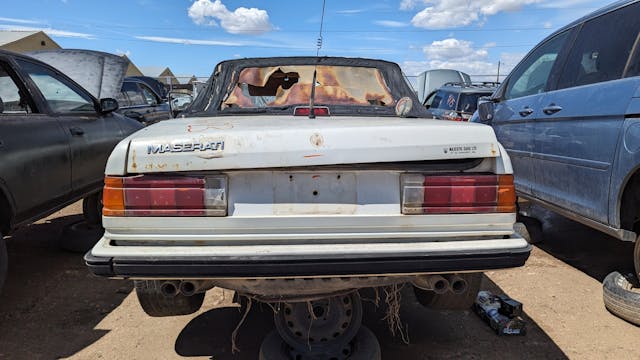


































***
Check out the Hagerty Media homepage so you don’t miss a single story, or better yet, bookmark it. To get our best stories delivered right to your inbox, subscribe to our newsletters.
The post Final Parking Space: 1989 Maserati Biturbo Spyder appeared first on Hagerty Media.
]]>
The Type 1 Volkswagen first went on sale in the United States in 1949, and two were sold. After that, VW dealers here did increasingly well with the Type 1—eventually known as der Käfer or the Beetle— with each passing year, with the American Beetle sales pinnacle reached in 1968. These cars have become uncommon in car graveyards in recent years, but I found this fairly solid ’70 in Colorado last winter.

For the 1970 model year, Volkswagen of America offered five models, all built in West Germany: the Beetle, the Karmann Ghia, the Fastback, the Squareback, and the Transporter (which was pitched as the Volkswagen Station Wagon at the time).

The 1970 Beetle was available as a convertible, as a two-door sedan, and as a two-door sedan with sunroof. Today’s FPS car is the latter type, which had a list price of $1929 when new (about $16,001 in 2024 dollars). The non-sunroof sedan cost just $1839 that year ($15,254 after inflation).

The Beetle wasn’t the cheapest new car Americans could buy in 1970, but it was a lot of car for the money. The 1970 Austin America (known as the Austin 1100/1300 in its homeland) had an MSRP of $1815, while American Renault dealers offered a new 10 for a mere $1775. The 1970 Toyota Corolla two-door sedan had an astonishing list price of $1686, which helped it become the second-best-selling import (after the Beetle) in the United States that year, while Mazda offered the $1798 1200 two-door. For the adventurous, there was the motorcycle-engine-powered Honda 600, priced to sell at $1398, and Malcolm Bricklin was eager to sell you a new Subaru 360 for only $1297. How about a 1970 Fiat 850 sedan for $1504? The Ford Pinto and Chevrolet Vega debuted as 1971 models, so the most affordable new American-built 1970 car was the $1879 AMC Gremlin.

The first factory-installed Beetle sunroofs opened up most of the roof with a big sliding fabric cover, but a more modern metal sunroof operated by a crank handle replaced that type for 1964.

The final U.S.-market air-cooled Beetles were sold as 1979 models, which meant that Beetles were very easy to find in American junkyards until fairly deep into the 1990s. You’ll still run across discarded Beetles today, though most of them will be in rough shape and they tend to get picked clean in a hurry.

Volkswagen introduced the Super Beetle, which received a futuristic MacPherson strut front suspension and lengthened snout, as a 1971 model in the United States. Most of the Beetles you’ll find in the boneyards today will be of the Super variety, which makes today’s non-Super an especially good find for the junkyard connoisseur.

I’ve owned a few Beetles over the years, including a genuinely terrifying ’58 Sunroof Sedan with hot-rodded Type 3 engine that I purchased at age 17 for $50 at an Oakland junkyard. It acquired the name “Hubert the Hatred Bug” due to being the least Herbie-like Beetle imaginable. Later, I acquired a 1973 Super Beetle and thought it neither handled nor rode better than the regular Beetle; your opinion of the Super may differ.

The Type 1 Beetle was obsolete very early on, being a 1930s design optimized for ease of manufacture, but it was so cheap to build and simple to maintain that customers were willing to buy it for decade after decade. Beetle production blew past that of the seemingly unbeatable Model T Ford in 1972, when the 15,007,034th example rolled off the line, and the final Vocho was assembled in Mexico in 2003. That means a last-year Beetle will be legal to import to the United States in just four years!

The first water-cooled Volkswagen offered in the United States was the 1974 Dasher, which was really an Audi 80. It was the introduction of the Rabbit a year later (plus increasingly strict safety and emissions standards) that finally doomed the Type 1 Beetle here; Beetle sales dropped from 226,098 in 1974 to 78,412 in 1975 and then fell off an even steeper cliff after that. For the 1978 and 1979 model years, the only new Beetles available here were Super convertibles.

The original engine in this car was a 1585cc boxer-four rated at 57 horsepower, although there’s plenty of debate on the subject of air-cooled VW power numbers to this day. These engines are hilariously easy to swap and were once cheap and plentiful, though, so the chances that we are looking at this car’s original plant aren’t very good.

This is a single-port carbureted engine with a generator, so it could be the original 1600… or maybe it’s the ninth engine to power this car. Generally, junkyard Type 1 engines get grabbed right away these days, but this car had just been placed in the yard when I arrived.

The hateful Automatic Stickshift three-speed transmission was available as an option in the 1970 Beetle, but this car has the regular four-on-the-floor manual.

To get into reverse, you push down on the gearshift and then into the second-gear position (this can be a frustrating process in a VW with worn-out shifter linkage components).

By air-cooled Volkswagen standards, this car isn’t especially rusty. I’m surprised that it ended up at a Pick Your Part yard, to be honest… and now here’s the bad news for you VW fanatics itching to go buy parts from it: I shot these photos last December and the car got crushed months ago. I shoot so many vehicles in their final parking spaces that I can’t write about every one of them while they’re still around.

It even had the original factory Sapphire XI AM radio.





















***
Check out the Hagerty Media homepage so you don’t miss a single story, or better yet, bookmark it. To get our best stories delivered right to your inbox, subscribe to our newsletters.
The post Final Parking Space: 1970 Volkswagen Beetle Sunroof Sedan appeared first on Hagerty Media.
]]>
The American Motors Corporation did good business selling small, sensible cars bearing the Rambler brand during the late 1950s through early 1960s. Rambler sales peaked in the 1962 model year, after which competition from new compact and midsize offerings from the Detroit Big Three made life tougher for the not-so-big Kenosha outfit. During the middle 1960s, AMC battled for midsize sales against the likes of the Chevrolet Chevelle and Plymouth Belvedere with its Rambler Classic. Today we’ll admire the first AMC product in this series with a Classic 660 found in a yard located between Denver and Cheyenne.

The Classic began life as a 1961 model during George Romney’s reign at AMC, then got a complete redesign for 1963 and became bigger and more modern-looking. Unfortunately for AMC, Ford introduced the Fairlane as a 1962 model, while Chrysler was right there with brand-new B-Body midsize machinery at the same time. As if that wasn’t enough, GM stepped up with the Chevelle and its A-Body siblings for the 1964 model year.

AMC, by then without Romney (who had gone on to become governor of Michigan), completely redesigned the Classic for 1965 and it looked just as slick as its many rivals. The following year, the Rambler name entered a phase-out period that was completed when the final AMC Ramblers were sold as 1969 models (the last year for Rambler as a separate marque was 1968).

The 1965 Classic was a bit smaller than the Fairlane, Chevelle, and Belvedere, though somewhat bigger than the Commander from soon-to-be-gone Studebaker.

The ’65 Classic offered plenty of value per dollar; the list price for this car would have been $2287 (about $22,894 in 2024 dollars). Its most menacing sales rival was the Chevelle Malibu, which had an MSRP of $2299 ($23,105 in today’s money) with roughly similar equipment.

This car is a 660, which was the mid-priced trim level slotted between the 550 and 770. Rambler shoppers who wanted to pinch a penny until it screamed could get a zero-frills Rambler 550 two-door sedan for just $2142 ($21,443 after inflation), which just barely undercut the cheapest Ford Fairlane Six ($2183) and Chevelle 300 ($2156) two-door sedans. Studebaker would sell you a new Commander two-door for a mere $2125 that year, but found few takers for that deal.

The 1965 Classic’s light weight (curb weight of 2882 pounds for the 660 four-door) made it respectably quick even with a six-cylinder engine. This car was built with an AMC 232-cubic-incher rated at 145 horsepower. If you wanted a genuine factory hot rod Classic for ’65, a 327-cubic-inch V-8 (not related to Chevrolet’s 327) with 270 horses was available.

But back to the straight six: This incredibly successful engine family went on to serve American Motors and then Chrysler all the way through 2006, when the final 4.0-liter versions were bolted into Jeep Wranglers. The 232 was used in new AMC cars through 1979.

Automatic transmissions were very costly during the middle 1960s and the Classic didn’t get a four-on-the-floor manual transmission until 1966, so the thrifty original buyer of this car went with the base three-speed column-shift manual.

At least it has a factory AM radio, a $58.50 option ($586 now).

You had to pay extra to get a heater in the cheapest 1965 Studebakers, but a genuine Weather Eye heater/ventilation system was standard equipment in every 1965 Rambler Classic.

AMC sold more than 200,000 Classics for 1965, and the most popular version was the 660 sedan. I still find Classics regularly in car graveyards, so these cars aren’t particularly rare even today.

This one is just too rough and too common to be worth restoring, but some of its parts should live on in other Ramblers.

Its final parking space has it right next to another affordable American machine that deserved a better fate: A 1979 Dodge Aspen station wagon.






































***
Check out the Hagerty Media homepage so you don’t miss a single story, or better yet, bookmark it. To get our best stories delivered right to your inbox, subscribe to our newsletters.
The post Final Parking Space: 1965 Rambler Classic 660 4-Door Sedan appeared first on Hagerty Media.
]]>
Four decades on from its launch, Harley-Davidson’s original FXST Softail is not a bike that would stand out in most crowds. It’s a simply styled cruiser with raised handlebars, a thick dual seat, and an air-cooled V-twin engine with cylinders set at the Milwaukee marque’s traditional 45-degree angle.
But that first Softail more than justified the swirling dry-ice drama of Harley’s publicity photo. In fact, this relatively restrained 1338cc model is among the most significant in the company’s 121-year history.
Back in 1984, the Softail was one of the five models fitted with Harley’s Evolution V-twin engine. With its aluminum cylinder barrels and heads, and more importantly its increased performance, cooler running, and much improved reliability over the previous Shovelhead unit, the Evolution brought the ailing firm rumbling out of the dark ages and into the light.
The FXST offered an additional attraction with its chassis. Its Softail name highlighted the new steel frame whose hidden suspension units cleverly allowed a comfortable ride while giving the impression of an old-style “hardtail” rear end. Before long, there would be a whole family of Softails.
Most importantly of all, the Evo-engined models appeared at a pivotal time, like a cavalry division charging over the horizon just as the surrounded soldiers with their antiquated rifles were facing slaughter.
Harley-Davidson’s situation in 1984 was dire. The firm has had well-documented worries in recent years, what with an aging customer base and production falling below 200,000 units from a 2006 peak of almost 350,000. To put that into context, however, things were rough for the company at the dawn of the 1980s, too. While Harley engineers had been finalizing development of the Evolution engine in 1982, production had been less than 25,000. This was below the threshold set by its financial backers, who were entitled to foreclose at any time. The financially strapped company had recently laid off 40 percent of its workforce and cut the salaries of those who remained.

The U.S. motorcycle market had plunged in the late 1970s, unheeded by both Harley and the Japanese manufacturers, who had continued to increase production until they had warehouses full of bikes that could not be sold, even at a discount. Worse still for Harley, its owners AMF (American Machine and Foundry) had boosted production by compromising on quality. By 1984, the result was unreliable bikes, dissatisfied customers, and unhappy dealers faced with increasing warranty work. The firm’s reputation was arguably at an all-time low.
At least there were some positives. Back in 1976, Harley executives had drawn up a long-term plan based on two powertrains: an updated aircooled V-twin, which they called Evolution; and a liquid-cooled family of V-configuration engines, named Nova.

Development of both began the following year, with the Evo project in-house, and Nova contracted out to Porsche Design because Milwaukee lacked the resources to do both simultaneously. In 1981, financial constraints meant that only one project could continue, and the Evolution was chosen.
By this time, however, Harley-Davidson was a very different company. A management buyout earlier that year had seen a group of 13 senior executives, led by Vaughn Beals and including styling chief Willie G. Davidson, raise over $80 million to take control from AMF. “The Eagle Soars Alone,” ran the celebratory advertising, but the company remained in a desperate position.

The Evolution engine had been slated for introduction with the 1983 model year, but there was a distinct possibility that Harley’s banks would pull the plug first. That this didn’t happen was partly due to Beals’ successful petitioning of the International Trade Commission to put tariffs of 45 percent on Japanese motorcycles of over 700cc.
President Ronald Reagan signed the tariffs into law in April 1983, but that was far from the end of Harley’s problems. Beals and engineering chief Jeff Bleustein regarded restoring the brand’s former reputation for reliability as so vital that the Evo motor’s introduction was delayed by a year to allow further development.
“I don’t think we ever made a tougher decision,” Beals later said. “The market was terrible, which meant we needed the engine sooner rather than later… But the one vow we took, because of the reputation we had, was that when the Evolution engine came out it would be durable, oil-tight, and bulletproof. We finally decided that the 1983 introduction was too risky, because we weren’t yet confident that it was bulletproof.”

The extra time was well spent. Harley’s engineers continued their more than 5000 hours of dyno testing, redesigned some parts, and refined manufacturing processes. Development riders added to a reported total of 750,000 miles of endurance road work and high-speed laps at the Talladega Superspeedway in Alabama.
The result justified that cautious approach. The Evo engine retained its Shovelhead predecessor’s 1340cc (80-cubic inch) capacity, its cylinder dimensions, crankshaft, and basic bottom-end layout. But almost everything else was new, including the aluminum head and barrels, smaller valves, narrower valve angle, camshaft profile, stronger connecting rods, flat instead of domed pistons, reshaped combustion chambers, and higher compression ratio.
Performance was significantly improved in every respect. Peak power output was up by ten percent, to 71.5 hp at 5000rpm. Torque improved by 15 percent and moved lower down the rev range. Fuel economy was improved, and weight was reduced by 20 pounds. A comprehensively redesigned lubrication system cured the Shovelhead’s habit of leaking as well as burning oil.

The new engine was nicknamed the Blockhead, extending the line that had begun with Flathead, Knucklehead, and Panhead, but it was more commonly called the Evolution. Either way, it came with a 12-month, unlimited-mileage warranty and was an instant success.
Some U.S. motorcycle magazines had previously been reluctant to test Shovelheads due to their many issues, but response to the Evo models was much more positive. “By now you’ve heard all the rumors and read all the speculation. Stop the presses, it’s true,” reported Cycle World about the Electra Glide Classic, which it described as a “thoughtfully conceived, carefully executed major overhaul that manages to blend the tradition of the past with the ideas of the present, to come up with something that’s both modern yet familiar.”
After riding the Electra Glide in the States, British freelancer Alan Cathcart described the Evo engine in Bike as “a quantum leap forward from the days of the iron jug Shovelhead… a successful amalgamation of traditional values and modern technology, of simple pushrod design and refined execution.”

Cycle magazine was positive about another model, the half-faired FXRT Sport Glide, describing it as a “contemporary motorcycle, albeit a very expensive one, rather than a curious alien from another era… The Evolution indicates that Harley-Davidson is making progress, and at an increasing rate.”
Motorcyclist was similarly impressed by the Sport Glide. “For those who wanted to see if Harley could build a real, honest-to-Davidson 1984 motorcycle, feast your eyes. The ’84 season is here—and Harley is right here with it.”
If the models that gained Evolution engines instead of Shovelhead units all contributed to the fight, it was the all-new FXST Softail that would make the biggest impact. Its hardtail-look rear end had originated with an independent engineer from Missouri named Bill Davis, whose modified Super Glide had caught the eye of chairman Vaughn Beals at a Harley rally.
Beals negotiated to buy the rights, and Willie G. Davidson fashioned a relatively lean and simple cruiser whose rigid-look rear end incorporated a hidden pair of shock units sitting horizontally beneath the engine. The Softail engine was held solidly rather than rubber-mounted as with the other Evo units, and for its first year only it had a four- instead of five-speed gearbox.
The Softail wasn’t the most comfortable or practical of Harley’s 1984 models, and it wasn’t the least expensive, either. But its blend of more up-to-date engineering and determinedly old-fashioned style hit the spot, and it quickly became not only very popular but—even more importantly—very profitable too.
Harley-Davidson wasn’t out of financial trouble just yet, even though the year ended with U.S. sales up by 31 percent to over 38,000 in a market that continued to fall. Domestic sales were up again in 1985, putting Harley second behind only Honda in the 850cc-plus category, but that was the year in which the company came closer than ever, before or since, to going bust.
The problem was that Citycorp, which had previously backstopped the company through the difficult times, had new people in important positions. They decided that another recession was looming—and that Harley, despite the upturn in its fortunes, would not survive it, so Citycorp’s best option was to liquidate the firm.
In March 1985, Harley was given an extended deadline of December 31 to find a new backer or file for Chapter 11 bankruptcy. Beals later spoke of “hawking begging bowls round Wall Street” that summer as he and chief financial officer Richard Teerlink struggled to convince potential investors that Citycorp’s pessimism was unjustified.
Finally, with time fast running out and all alternatives exhausted, Beals, Teerlink, and colleague Tom Gelb were introduced to a Harley-riding banker named Bob Koe, of Chicago-based Heller Financial, who set up a meeting with his boss, Norm Blake, on the morning of December 23. Blake listened to their pitch… and turned them down.
Somehow, with the bankruptcy seeming almost inevitable, the Harley trio persuaded Koe to arrange another meeting with Blake that afternoon. They finally agreed a deal, more generous to Heller, which gave Citycorp $49M, and Harley $49.5M of working capital. Even then, holiday season delays meant the final transaction was completed with minutes to spare on December 31.

Harley was saved, and Heller’s confidence would be rewarded as the Milwaukee firm defied the general downturn to begin an astonishing period of growth. In 1986, it matched Honda for big-bike sales. The following year Harley was listed on the New York Stock Exchange, and also petitioned the IRC to end the tariff on Japanese bikes ahead of time. President Reagan visited the factory in York, Pennsylvania, to offer congratulations.
A succession of Evolution-engined models powered the recovery. The FLST Heritage Softail of 1986 featured a fat front end inspired by the Hydra-Glide of the 1950s. The Low Rider Custom had a skinny 21-inch front wheel, high bars, and lots of laid-back attitude. In 1988, the FXSTS Springer Softail went further back through time with its updated version of an old-style springer front suspension system.
The Sportster family was also updated with Evolution engines, starting in 1986 with an entry-level model in traditional 883cc capacity, followed soon after by a similarly styled 1100cc variant. Both were popular, the smaller model boosted by Harley’s innovative offer to repay the full $3995 price if its rider traded up to a big twin within two years.

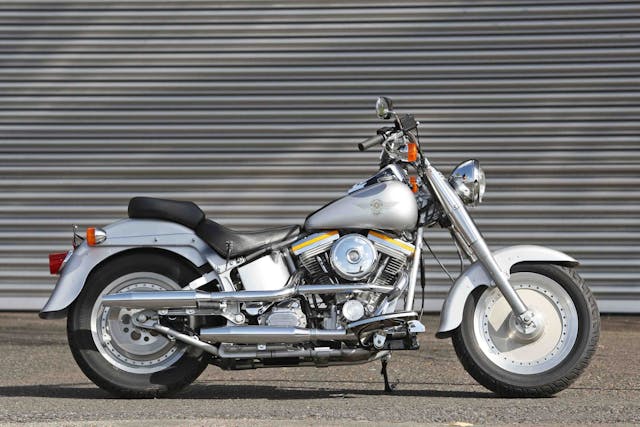

In 1990 came the unmistakable FLSTF Fat Boy, with disc wheels, industrial look, and silver finish with yellow detailing. A year later it was followed by the Dyna Glide Sturgis, named after the South Dakota rally that had become an August fixture for a growing legion of Harley riders.
Willie G’s final Evolution-powered project was one of his finest: The FLTR Road Glide of 1998 featured a frame-mounted fairing and a long, low look that would remain popular for more than two decades. A year later, the Glide and most other Big Twins were fitted with the new Twin Cam 88 engine, a bigger, more powerful V-twin that was another step forward.
The Evo unit continued to power some Softail models for a couple more years, along with the hotted-up, limited-edition FXR Super Glide variants that began the Custom Vehicle Operations line in 1999 and 2000. By this time, Harley’s total production was nudging 200,000. Revenue was close to $3 billion, and profit almost $350 million, the company having set new records for 15 consecutive years.
The Evolution engine, it’s fair to say, had proved a considerable success.
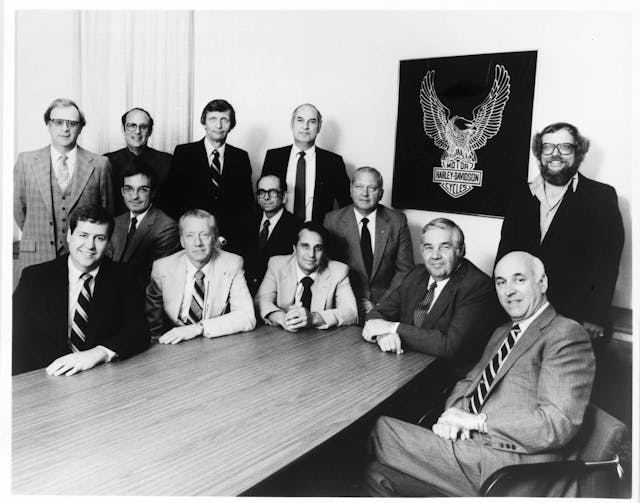

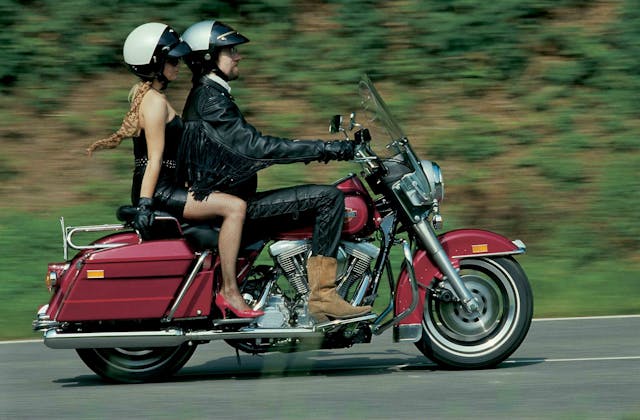

***
Check out the Hagerty Media homepage so you don’t miss a single story, or better yet, bookmark it. To get our best stories delivered right to your inbox, subscribe to our newsletters.
The post How the Evolution Saved Harley-Davidson appeared first on Hagerty Media.
]]>
Last week, we admired a majestic 1984 Mercedes-Benz S-Class in a Colorado car graveyard, adding to a collection of Final Parking Space machines from (West) Germany that includes BMW, Volkswagen, and Ford-Werke. Plenty of lesser-known German manufacturers have sold cars in the United States, of course, and today we’ve got a discarded example of one of the best-looking cars to come out of Bremen: a Borgward Isabella Coupé, photographed in a self-service yard just south of Denver, Colorado.

Carl Borgward came up in the Bremen car industry, rising through the ranks at Hansa-Lloyd and selling cars badged with his own name starting in 1924. After World War II, he began building Lloyds, Goliaths, and Borgwards, with the Borgward Hansa his first postwar model.

In 1954, the Isabella replaced the Hansa, though Hansa Isabella badging was used for a while.

The Isabella sedan came first, followed by convertible and wagon versions in 1955. The Isabella Coupé appeared in 1957, and production continued in West Germany until the company went (controversially) broke in 1961. Borgward production using the old tooling from the Bremen plant resumed in Monterrey, Mexico, in 1967 and continued through 1970.

The Isabella sold reasonably well in the United States, considering the obscurity of the Borgward brand here. For the 1959 model year, just over 7500 cars were sold out of American Borgward dealerships.
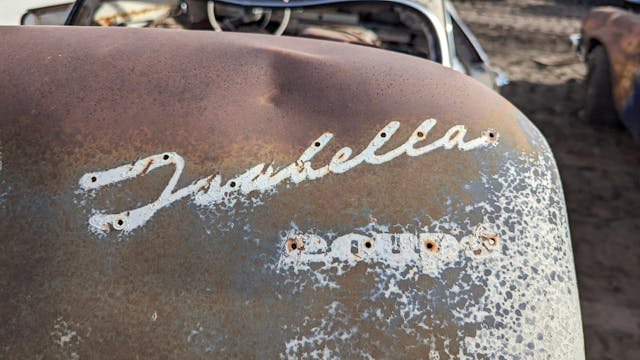
The U.S.-market MSRP for a 1959 Isabella Coupé was $3750, or about $40,388 in 2024 dollars. The base 1959 Porsche 356 coupe listed at $3665 ($39,472 after inflation), while a new 1959 Jaguar XK150 coupe cost $4500 ($48,465 in today’s money).

Meanwhile, GM’s Chevrolet division offered a new 1959 Corvette for just $3,875 ($41,734). The Isabella Coupé faced some serious competition in its price range.

These cars haven’t held their value quite as well as the 356 or Corvette (though nice ones do change hands for real money) and restoration parts are tougher to source, so there are affordable project Isabella Coupés out there for the adventurous. A 24 Hours of Lemons team found this ’59 and raced it several times with the original drivetrain, winning the coveted Index of Effluency award in the process.

Not bad for a race car with 66 horsepower under the hood… 60 years earlier.

The Fistful of Cotter Pins team members were kind enough to give me the MotoMeter dash clock out of their race Borgward. The mechanism is bad but the face still looks good when illuminated in my garage.

The clock in this car has experienced too many decades outdoors in the harsh climate of High Plains Colorado to be worth harvesting for my collection.

The engine in this car is a 1.5-liter overhead-valve straight-four with a distinctive carburetor location atop the valve cover.

The transmission is a four-speed column-shift manual.
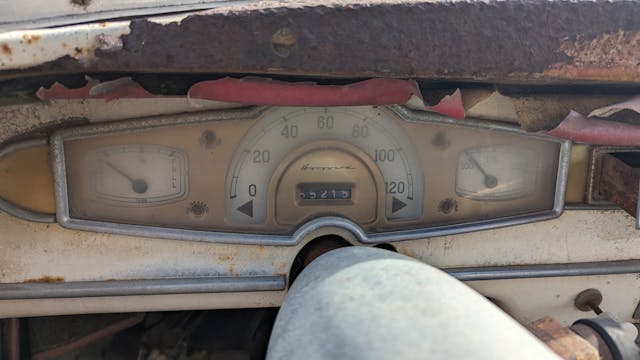
The odometer shows 55,215 miles, and that may well be the actual final total.

This car was in the Colorado Auto & Parts “private reserve” yard, off-limits to customers for many years. Then that lot was sold, and many of its former inhabitants were moved to the regular U-Pull section. We’ve seen some of those cars in earlier episodes of this series, including a 1958 Edsel Citation, a 1963 Chevrolet Corvair Monza, and a 1963 Chrysler Newport sedan.

The good news about this car is that CAP will sell you the whole thing, being a non-corporate yard owned by the Corns family since the late 1950s. You’ll be able to check out the famous radial-engine-powered 1939 Plymouth, built on the premises, in the office when you visit.

This car appears to be a bit too rough to be economically viable as a restoration, but there are still plenty of good parts to help fix up nicer Isabellas. Or you could make a race car out of it, which we recommend.

I like to use ancient film cameras to shoot junkyard vehicles, and I took a few photographs of this car (and many others) with a 1920s Ansco Memo.

This double exposure (always a hazard with century-old cameras) came out looking interesting, and the Isabella was an appropriate subject.





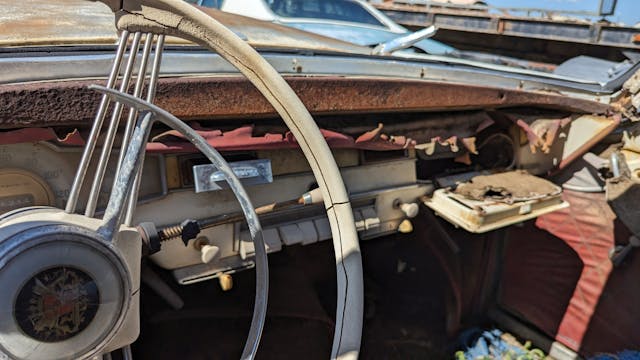





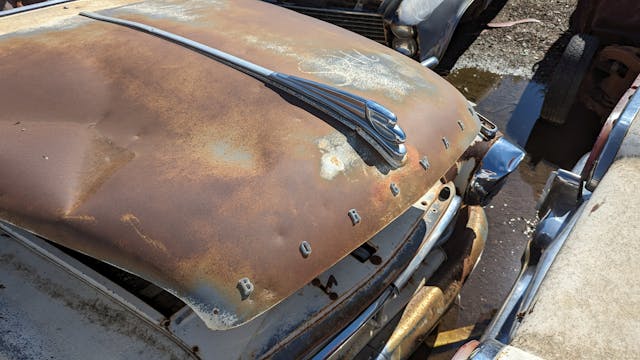


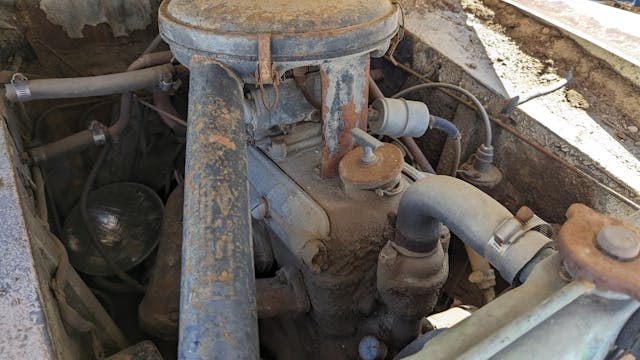


















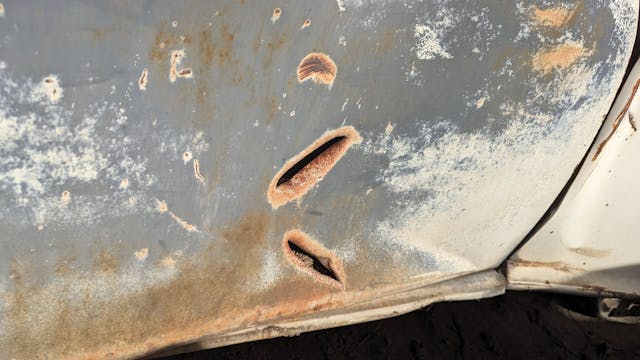
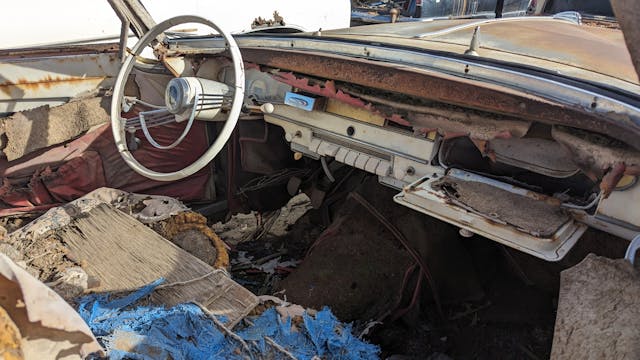

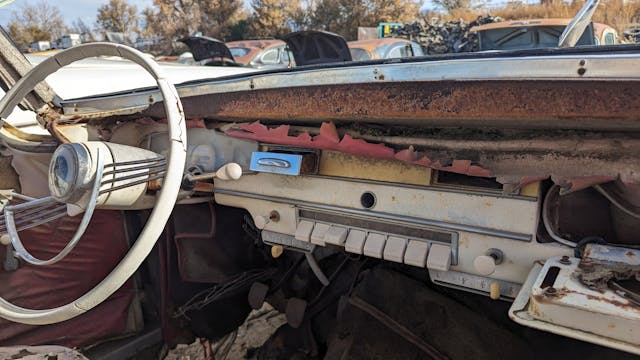



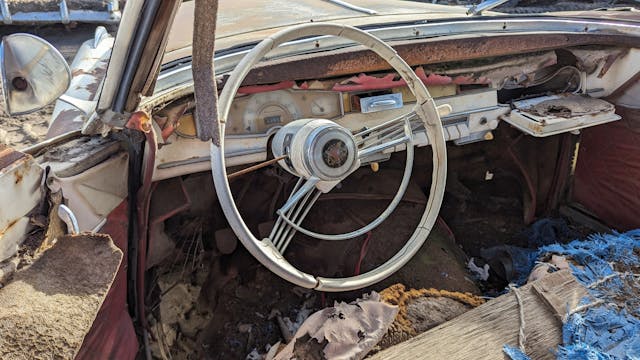
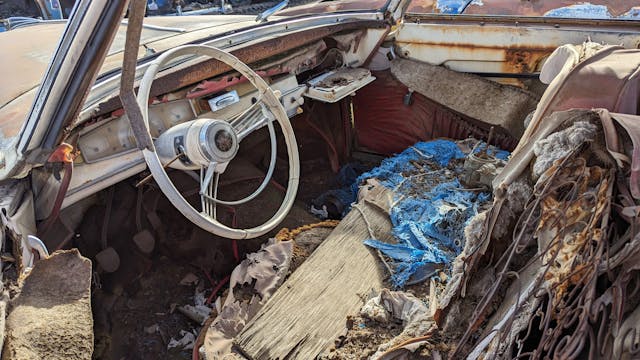












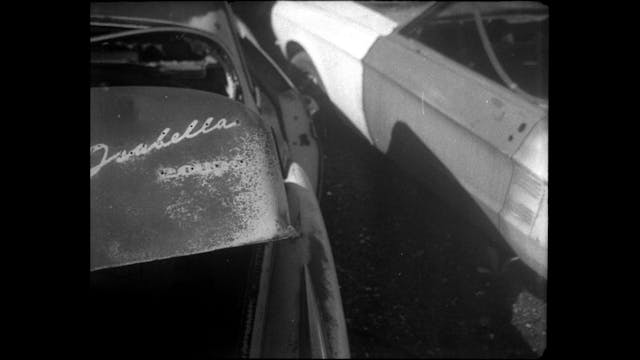
***
Check out the Hagerty Media homepage so you don’t miss a single story, or better yet, bookmark it. To get our best stories delivered right to your inbox, subscribe to our newsletters.
The post Final Parking Space: 1959 Borgward Isabella Coupé appeared first on Hagerty Media.
]]>
April 17 marks sixty years since the Ford Mustang’s public debut at the 1964 New York World’s Fair. The original pony car immediately became a pop-culture and automotive phenom, and it remains one of the most impactful cars in history. We’re celebrating with stories of the events surrounding the Mustang’s launch, the history of the early cars, and tales from owners. Click here to follow along with our multi-week 60 Years of Mustang coverage. —Ed.
The beauty of celebrating an automotive icon like the Ford Mustang is there are more historic moments to commemorate and significant places to visit than there are candles on the pony car’s birthday cake. As the Mustang turns 60 on April 17, enthusiasts have plenty of opportunities to pay proper homage.
Of course, there are many impressive museums out there to whet your Mustang appetite—including The Henry Ford, the Gilmore Car Museum, the Mustang Owners Museum, and the Mustang Museum of America. And the Flat Rock Assembly Plant, which manufactures current Mustangs, offers a potential photo op with your ride (although the last time we checked there were no tours).
If you’re looking for something a little different, however, here are some suggested destinations where Mustang history was made. Some of them don’t look like they used to, so keep an eye out for ghosts of Mustangs past.
1964–65 New York World’s Fair site


Although the public unveiling of the Mustang was held on April 17, 1964—which is considered the official birthdate of the car—members of the press were given a sneak peek three days earlier. Both showings were held in front of the Ford Pavilion at the New York World’s Fair. Although the Fair featured 140 pavilions and 110 restaurants during its two summers at Flushing Meadows Corona Park in Queens, few of the original structures remain. Skeletons include the New York State Pavilion, a pair of towers topped with circular observation platforms (they are no longer operational); the roofless Tent of Tomorrow pavilion; and the iconic Unisphere, a 120-foot-tall stainless-steel globe. (If you’re in the Detroit area, you can get a taste of the ’64–65 World’s Fair by checking out the giant Uniroyal tire that was originally a Ferris Wheel.)
Dearborn Mustang Plant

Mustang production began at Ford’s Dearborn Assembly Plant on Miller Road, and although Ford also built Mustangs at facilities in Edison, New Jersey, and San Jose, California, only D.A.P. (as it was often called) was active for four decades. After more than 6.7 million ponies rolled off the line in Dearborn, the final Mustang produced there was completed at 1:07 p.m. on Monday, May 10, 2004.
Riverside International Raceway

Mustangs and motorsports are forever linked, and Mustangs often made history at California’s Riverside Raceway, not only for racing but for vehicle development. Carroll Shelby tested his original Cobras at Riverside, and the 1967 and ’68 Shelby Mustang models were revealed there. In 1970, with Riverside serving as the Trans-American Sedan Series championship finale, Parnelli Jones came back to win in a Bud Moore Ford Mustang, giving Jones the unofficial driver championship by one point. It was the first and only year that every Detroit pony car manufacturer had a factory-backed team in Trans-Am.
Alas, Riverside closed on July 2, 1989 and was bulldozed to make room for a shopping mall that opened in 1992. Riverside’s old administration building remained until 2005, when it was torn down to make way for townhouses. If you’re moved to pay a visit to the former location of the southern California track, the Moreno Valley mall is located at 22500 Town Circle in Moreno Valley, about a half-hour south of San Bernardino.
Bullitt movie locations, San Francisco
There may be no more famous Mustang than the 1968 GT390 fastback driven by Steve McQueen in the legendary movie Bullitt. Certainly there’s no Mustang that’s worth more; in 2020, the Highland Green Bullitt car sold for $3.74 million. Many consider the movie’s chase scene the best in film history, and although we don’t encourage any Mustang enthusiasts to recreate that iconic chase, you could—if you really, really wanted to—on the hilly section of San Francisco’s Fillmore Street.
Shelby American at LAX



Carroll Shelby started Shelby American in 1962 and completed the 260 Roadster—later known as the Cobra—soon after. Within a couple of months, Shelby set up shop in Venice, California, and by June 1963 he was being courted by Ford, which was hellbent on beating Ferrari at Le Mans. Shelby succeeded, winning the GT Class at the storied French endurance race the following year, thanks to the Daytona Coupe.
After outgrowing the Venice location, Shelby American moved to a hangar on the south end of Los Angeles International Airport in 1965, and it became the birthplace of the famous Shelby Mustang GT350. Shelby moved his operations again in 1967 after losing his lease at LAX, and today the hangar is home to the Japanese aviation firm Nippon Cargo Airlines.
The Empire State Building

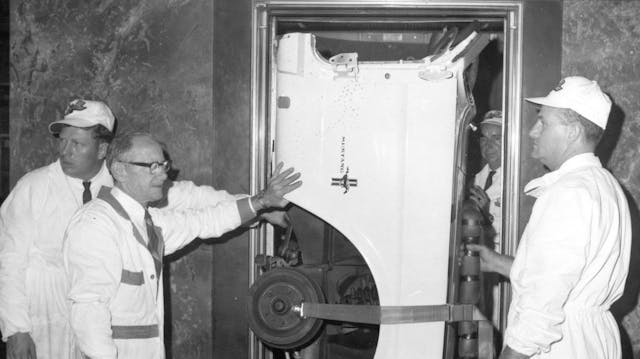

Yes, we’re back in New York, but this is the one site that hasn’t changed much in the last six decades (even if the view has). And the story is so incredible that we had to end with it. In 1965, with the Mustang selling at a record-setting pace in the U.S., the general manager of the Empire State Building—then the tallest building in the world—came up with a big idea. Robert L. Leury wondered if Ford might be interested in displaying a Mustang on the 86th-floor observation deck. As crazy as it sounds, Ford was all in … except its technicians had to figure out how to get a car up there.
A crew of engineers took meticulous measurements (or so they thought) and decided that by disassembling a Mustang into four sections, they could fit everything inside the Empire State Building’s seven-foot tall elevations, then reassemble the car up top. On the night of October 20, 1965, after taking the Mustang apart as planned, the crew discovered that the steering column was a quarter-inch too tall for the elevator. Undeterred, they improvised and made it fit, and the car was completed by the next morning. The Mustang was displayed for five months before it was taken apart and removed. The stunt was recreated with a 2015 Mustang GT to celebrate the Mustang’s 50th anniversary.
Did we miss something cool? Do you know of some historic sites that your fellow Mustang enthusiasts might enjoy visiting? Please let us know in the comments section below.
***
Check out the Hagerty Media homepage so you don’t miss a single story, or better yet, bookmark it. To get our best stories delivered right to your inbox, subscribe to our newsletters.
The post 6 Historic Mustang Sites That Are Worth a Visit (Just Beware of Ghosts) appeared first on Hagerty Media.
]]>
April 17 marks sixty years since the Ford Mustang’s public debut at the 1964 New York World’s Fair. The original pony car immediately became a pop-culture and automotive phenom, and it remains one of the most impactful cars in history. We’re celebrating with stories of the events surrounding the Mustang’s launch, the history of the early cars, and tales from owners. Click here to follow along with our multi-week 60 Years of Mustang coverage. -Ed.
Car people over a certain age certainly remember the April 1964 debut of Ford’s first Mustang. Enthusiasts yawned at first due to the car’s lowly Falcon-based platform and powertrains, but most were eventually charmed by its sporty looks, multiple appealing options, and affordable pricing.
U.S. auto executives outside the Blue Oval wondered whether to take it seriously. Bob Lutz (who would later rise to top leadership levels at Ford, Chrysler, and General Motors) had been working at GM Overseas Operations (GMOO) for a bit more than a year when Mustang was launched. “The clan of car guys l hung out with agreed it was a genius marketing move,” he tells Hagerty. “We didn’t admire it as a car because of its down-and-nasty Falcon architecture, but we agreed it would be a hit. We underestimated how big of a hit, but so did everyone else. Its appeal was NOT to car guys but to average, low-to-middle-income Americans who saw it as glamorous and aspirational.”
Reaction from GM leadership was initially dismissive. According to Lutz, they calculated the entire U.S. auto sales market at the time at 100,000 units. “Let’s say it’s a smash hit and gets 50 percent of that segment. ‘That’s 50,000 units. Why bother?’ They failed to realize that Ford did not intend [the Mustang to be] part of the ‘sports car’ segment but as cheap, sporty, aspirational family transportation. Once they fully grasped what Ford had pulled off, it was all-hands-on-deck, full speed ahead.”


GM and its Chevrolet Division didn’t see that initial ’65 Mustang as a serious threat, but few outside (or even inside) the company knew that Chevy designers had been quietly exploring the same idea of a youthful, sporty compact coupe since soon after the Chevy II debuted for 1962. The project was inspired by the elegant 1963 Buick Riviera “personal coupe” that was launched to take on Ford’s four-seat Thunderbird. Chevrolet styling chief Irv Rybicki wondered whether something similar to the Chevy II in concept but smaller and much more affordable—which could share the Chevy II’s unibody platform and mechanicals—might make sense for Chevrolet. When Rybicki suggested exploring such a car to GM Design Vice President William L. “Bill” Mitchell, Mitchell was intrigued. “By God, that’s not a bad idea!” he reportedly said, “But let’s do it outside the building where no one in the corporation can see what we’re up to.”
“So, we went across the street to our warehouse, created a little room there and started a program,” Rybicki later told us. “And in five months, they had a Chevy II-based clay model dimensionally very close to the future Mustang that no one outside of Ford knew was being developed. But when Rybicki showed it to then-Chevrolet general manager S. E. “Bunkie” Knudsen, Knudsen liked it but decided not to pursue it: “I’ll tell you, fellows,” he said, “one thing we don’t need right now is another car.”

Aside from its popular full-size line, Chevy’s stable at the time included the rear-engine Corvair, the compact Chevy II, the mid-size Malibu, and the Corvette sports car. Rybicki’s proposed sporty compact coupe would add a sixth separate car, and Knudsen didn’t see the need to invest the substantial money, time, and human resources it would take to make that happen.
Rybicki didn’t give up on the idea. Like Ford’s Iacocca, he could see America’s emerging youth market coming. In late 1963, Rybicki had Henry “Hank” Haga’s Chevrolet #2 Studio design a sleek Chevy II-based sporty coupe concept car called “Super Nova.” Mitchell liked it so much that he had it developed into a fiberglass-bodied running car and dispatched it to the April 4, 1964 New York Auto Show, where its appearance two weeks before the Mustang’s April 17 debut at the New York World’s Fair made some Ford folks nervous.

“I recall some of the Ford people coming over while I was standing there and asking whether we were going to build that car,” Knudsen said. “I remarked, ‘If they’ll let us, we’ll build it.’” But when he tried selling it to GM leadership, then-GM president Jack Gordon turned him down.
Camaro/Firebird


When the Mustang bowed to thundering media and public applause, then-Pontiac general manager Elliot M. “Pete” Estes was one GM leader who took it seriously: “I happened to be at Styling when the first Mustang rolled into the garage,” he later recalled. “Everybody was standing around saying what a disaster it was and how market research showed there was no market for it. I didn’t say anything but had a feeling that this thing was going to backfire on us.”
Jerry Palmer, who joined GM Design in 1966 and rose to executive director over all cars and trucks before his 2002 retirement, recalls seeing that first Mustang in its Ford Design studio while still in school at Detroit’s Society of Arts and Crafts (now the College of Creative Studies). “Homer LaGasse, who was on the Mustang design team, arranged a trip for our seniors to go through the studio,” Palmer relates. “The concept was a hot little car, but we were a little disappointed by the actual car.”

Retired GM designer Dick Ruzzin, who had been there for about a year and a half when Mustang was launched, says, on the contrary, that everyone there was surprised. “The design to me was very good as it had some of the character of the recent Lincoln, the sheer slab side and peaked fenders,” he recalls today. “I thought it was a great-looking car, but it was not seen as a performance car in any way. The muscle car era was just beginning, and Mustang responded to that and was part of that movement as it evolved through the years.”


Because the rear-engine compact Corvair was getting a Corvette-look redesign for 1965, GM brass believed that its new style, its bucket-seat Monza coupe and convertible models, and its optional turbocharged engine would help it compete quite well with Ford’s new sporty car. Even Mitchell was telling everyone that the ’65 Corvair was Chevy’s answer to the Mustang.
After Mustang sales topped 100,000 in its first four months alone, with no sign of slowing on its way to the biggest first-year sales success of any new car in history, GM leaders found instant enlightenment. They suddenly decided to hurry up and counter Mustang with the small, sporty coupe and convertible that would become the 1967 Camaro and—partly to appease John DeLorean, who had succeeded Estes as Pontiac general manager and was lobbying hard for a two-seat sports car—a Pontiac variant to be known as the Firebird.
Barracuda/Challenger
Chrysler Corporation actually beat Mustang to market by a couple of weeks with its first Plymouth Barracuda. Believing rumors that Ford was developing a new sporty compact based on its inexpensive Falcon chassis and running gear, Chrysler execs saw an important new market segment and wanted an entry. “Chrysler predicted the ‘specialty compact’ segment would grow to 1.5 million sales by 1970,” Motor Trend reported, “of which it could easily claim 200,000 or more.” With a limited budget, stylist Irv Ritchie sketched the fastback coupe that debuted as a Barracuda option package on the compact Valiant on April 1, 1964.


“The 1964 Plymouth Barracuda was essentially a fastback version of the Plymouth Valiant,” wrote Chandler Stark for musclecarclub.com in 2015, “and it was actually marketed as the Plymouth Valiant Barracuda initially. It used the same wheelbase dimensions and Chrysler A-body platform but with a massive wraparound rear window and taillight … At this stage, the Barracuda was more of a budget car …built for convenience and reliability, not performance.”
That hurry-up car was badly outsold by the Mustang, and it took three years to design and develop the much more competitive second-generation Barracuda for ‘67, which (like the Mustang) offered coupe, convertible, and fastback body styles. Three more years later, Chrysler’s Dodge brand jumped in with its slightly larger, more upscale ‘70 Challenger on an all-new shared platform.



Retired Chrysler Design (and Engineering) vice-president Tom Gale explains that the Mustang arrived a few years before his time there began. “But I was very aware of its impact. For me, the lesson was getting the proportions right, which the Mustang did with its long hood and short deck. The 64-1/2 Mustang, albeit derived from the Falcon, really nailed the proportion with great style and gutsy leadership from Hal Sperlich and Lee Iacocca. Contrast that with the Plymouth Barracuda of the time, where it took until 1967 to make the improved design, which was still based on the A-body Valiant/Dart. But it wasn’t until 1970 with the E-body Barracuda/Challenger that competitors’ cars hit their stride and, in many ways, went beyond Mustang.”
One other Chrysler effort was the original 1966-67 Dodge Charger: a bucket-seat, fastback variant of the mid-size Coronet. Positioned as an upscale “personal luxury” coupe, its targets were much more the Thunderbird, Toronado, and Riviera than the Mustang, and it suffered the same slow-sales fate as AMC’s similar Rambler Marlin.
AMC and the Javelin

Over at the much smaller American Motors, design chief Dick Teague was challenged to design a viable Mustang competitor. A few months before Mustang’s debut, AMC had shown a concept fastback coupe, based on the compact Rambler American, called the Tarpon. Teague wanted to build that car as an answer to Mustang, but then-CEO Roy Abernethy ordered him to upsize that design on the mid-size Rambler Classic platform; that effort became the unlovely Rambler Marlin “personal luxury” coupe. But by mid-1965, Abernethy agreed that the Marlin was a loser, so Tarpon designer Bob Nixon (by then head of small-car exterior design) started work on a replacement initially known as the Rogue, a name AMC was using for its Rambler American hardtop coupe.
Even as the Rogue was taking shape, Chuck Mashigan’s advanced styling studio in October 1965 developed a design study for a Rambler American-based sporty fastback two-seat coupe that Teague named “AMX,” for American Motors Experimental. Teague proposed publicly exhibiting the AMX (which inspired the 1968 two-seat production AMX) and other advanced styling studies to demonstrate that AMC—under new Board chairman Robert Evans—was moving in a new, more youthful direction.
That idea evolved into an impressive “Project IV” traveling show that toured 10 North American cities in 1966, showcasing four concept cars that included the AMX and a longer “AMX II” 2+2 coupe designed by freelance stylist Vince Gardner.
Meanwhile, the production “pony car” project, with styling strongly influenced by the AMX and AMX II, was already under development and would debut (under new Board chairman Roy D. Chapin) as the AMC Javelin for 1968.
The landscape was truly abuzz when the first Mustang hit, an indicator that conditions were ripe for just this type of car. While GM could have fielded a sport-compact Chevy almost immediately after Mustang’s debut but chose to wait and see, Ford had the youthful new market segment practically all to itself (except for that first Valiant Barracuda) from spring ’64 to autumn ’66. By then, GM offered up its ’67 Camaro and Firebird, Chrysler fielded its ’67 Gen 2 Barracuda, and corporate cousin Mercury launched its Mustang-based upscale Cougar. It took another year for AMC to launch its nicely designed ’68 Javelin, and by the time the greatly improved Gen II Camaro, Firebird, Barracuda, and Dodge Challenger arrived for 1970, America’s youthful “pony” and “muscle” car segments were already starting to fade due to safety, emissions, fuel economy, and other government-imposed mandates. It was fun while it lasted.
***
Check out the Hagerty Media homepage so you don’t miss a single story, or better yet, bookmark it. To get our best stories delivered right to your inbox, subscribe to our newsletters.
The post How GM, Chrysler, and AMC Reacted to the Original Ford Mustang appeared first on Hagerty Media.
]]>
This article first appeared in Hagerty Drivers Club magazine. Click here to subscribe and join the club.
Little Nash Motors up in Kenosha, Wisconsin, came roaring out of World War II with some pretty far-out ideas. Its cars became sleeker and more interstellar, the wheels all but disappearing within wind-smoothed bodywork. The company defied convention by building a premium car that was actually small. The Rambler of 1950 was America’s first legitimate attempt at a compact alternative to the road-conquering Goliaths then in fashion. And Helene Rother, a pioneering female designer whose own story reads like an impossibly dramatic screenplay, played a key role in making it happen.
Rother’s might not be a name with which you’re familiar, but at a time when men universally ruled the auto industry, she was part of a small female vanguard that was destined to quietly put its fingerprints on American car design in the 1940s and ’50s. Notwithstanding her recent induction into the Automotive Hall of Fame, Rother’s achievements are mostly forgotten today. But in an era when small cars were not popular, her interior design for the Rambler was incredibly forward-looking and helped make this car fashionable—and, for a time, successful.

Which is why we took the opportunity to borrow an early Rambler from owner Scott Keesling in Beverly Hills, California, and, er, ramble around the city’s leafy canopied streets for a day. This joyful little car wasn’t made for speedy 0–60 times, nor did it perform aggressively around corners. Its name, Rambler, certainly doesn’t suggest quickness. Instead, it feels genial and easygoing, like spending time on a warm, sun-filled afternoon with an old friend.
***
An unlikely automotive designer, Helene Rother spent her early life a million miles away from Beverly Hills, in Leipzig, Germany, surrounded by books and art. After receiving the equivalent of a master’s degree in 1930 from the Kunstgewerbeschule, an arts and crafts school, in Hamburg, the newly married Rother began a career in visual arts and graphic design. After her daughter was born in 1932, Rother’s husband, a known Trotskyist and a member of various anti-Nazi organizations, soon became persona non grata in Hitler’s Germany and fled to France, leaving Rother and their daughter, Ina, behind.
Rother continued working in design and art, even finding some success in jewelry design before the situation in Germany became untenable. Her connection to her husband put her in danger, and she decided to take her daughter and flee. A group of Americans who had formed the Emergency Rescue Committee shortly after France fell to the Germans sent Rother an alias, counterfeit identification, and $400 to get her to Marseilles. With travel from France to the United States severely restricted, Rother and Ina made their way to Casablanca, just as the refugees did in the famous film of the same name, to await safe passage to New York.
As the war raged on, Rother never quite settled into living in New York City. Still, she found a job as an artist and started designing geometric-patterned textiles in the style of Le Corbusier and Bauhaus, a school of European minimalism that produced architecture and objects that were practical and devoid of traditional baroque flourishes. She wrote and illustrated many children’s books that were never published and drew illustrations for Marvel Comics.

During the war, everyone did their best to get by, including car companies. With a former refrigerator salesman and car man by the name of George W. Mason running the show at Nash-Kelvinator, the company did its American duty. Instead of building powertrains for its moderately successful Ambassador Eight and Ambassador 600, it got to producing supercharged radial engines for naval aircraft. While automotive production was put on hold, in anticipation of the inevitable return to normal, Mason—a known risk-taker—never stopped new car development during those war years, including a $20 million project for a compact sedan that eventually became the Rambler.
In 1942, Rother heard about an opportunity in Michigan to work for Harley Earl, the first vice president of styling at General Motors. Though the General had never hired a female designer before, much less one with radical ideas, Earl was a visionary who was seeking out like-minded creatives, regardless of their gender. According to MaryEllen Green, another of Earl’s so-called Damsels in Design—a group of female designers whom he hired after bringing Rother on board—some GM suits wanted to keep secret the hiring of any women above the secretarial level, fearing that bringing them into such a masculine industry would be a failure and an embarrassment for GM. Regardless, Rother got the job and moved to Detroit with her daughter.
“I earned less than the men I supervised,” Rother is remembered as once saying to a group of stained-glass artists. Despite her dissenters, Rother put her artistic mark on the interiors of Cadillacs, Buicks, and Pontiacs, to name a few.


Rother turned contemporary interiors once dreary shades of black, gray, or tan into explosions of color, elegance, and convenience. “I have a long list of gadgets for use in cars beginning with outlets for heating baby bottles and canned soup, cigarette lighters on springs, umbrella holders, and so on,” Rother once wrote. Collectively, the Damsels, the pioneering women of car design, incorporated intuitive innovations, everything from improved gauge positioning to tissue dispensers. They spiced up cabins with flashy finishes and textured fabrics in the kaleidoscopic colors of an Elizabeth Arden cosmetics portfolio. As more women worked, drove, and were involved in the buying of cars, the Damsels helped GM move with the changing times.
In 1947, while still at GM, Rother started her own design studio, opening the door to her consulting for other automakers including Nash, who went on to become her main client. Rother designed seats, molding, garnish, trim pieces, and fabrics. She did extensive work on all the interiors of the revolutionary Airflyte models. The Statesman was her triumph, as she used artistic design elements incorporating color, fabrics, and texture throughout.

Statesman buyers could choose from 21 color combinations with well-considered trims and finishes. The Statesman’s interior drew particular interest for its revolutionary seating configurations. The right front seat reclined into a comfortable daybed. Fully reclined, it became a twin bed. With the addition of the driver’s seat fully reclined, the cabin became a private sleeping car. Sales skyrocketed.
***
As her work gained more recognition, Rother’s prominence in the automotive industry grew. In November 1948, she became the first woman to address the Society of Automotive Engineers with a paper titled, “Are we doing a good job in our car interiors?” She inherently knew that part of the pleasure of driving a car was a driver’s interaction with the cockpit. “The instrument board of a car,” she wrote, “shows above anything else how well-styled the car is. Here the driver is in real contact with the mechanics, and here is the greatest test of good coordination between the engineer and stylist.”
Always on the hunt for what came next, Mason had been captivated by the stylish but practical designs of Italian coachbuilder Pinin Farina, as seen on the likes of Lancias, Alfa Romeos, and Maseratis, as well as the compact Cisitalia 202. This small, unfussy, yet elegant sedan likely piqued Mason’s attention, reinvigorating his $20 million wartime development idea. The time was finally right for a smaller car in the Airflyte’s lineup.

When it came time to design the body of the Rambler, there was no exterior team to speak of, as a proposed deal with Pinin Farina had not yet borne fruit. So, the company’s longtime engineers—including Nils Erik Wahlberg, who didn’t even believe in the compact car project, plus Ted Ulrich, and Meade Moore—were put to the task with only some loose design studies to work from, submitted by an independent design firm. These engineers put together a workable exterior that cribbed elements from the opulent Ambassador only in a scaled-down and more utilitarian way. At the same time, they improved mechanical issues with novel design solutions, including side air scoops to cover the connection between the fenders and the cowl. In testing, they found that the battery was 3 percent cooler than it had been previously, as it sits on the driver’s side just below the new air vent.
The Rambler, which was strongly supported by both Georges—George W. Mason and his newly hired protégé, George Romney—finally came along in 1950. As America’s postwar economy boomed, Mason and Romney saw an opportunity to put a second car in every garage. Smaller than the traditional family car but no less stylish, the Rambler was brilliantly marketed as a luxurious purchase. Certainly, there was nothing compact about its official name, the Nash Rambler Custom Convertible Landau.

Although it was smaller, the $1800 Rambler was priced several hundred dollars higher than its nearest competitors at Ford or Chevrolet. This strategy was put in place to make buyers feel as though they weren’t simply settling for a cheap, small car. Customers got a good deal for their money. In addition to Rother’s stylish interiors—which Nash promoted heavily as the work of “Madame Helene Rother of Paris” to make her sound more European—the all-new Rambler was initially only offered as a convertible and featured many standard amenities, including a radio, a heater, and whitewall tires.
The two-toned, brightly colored orange and white of the example I drove—not original—made an excellent effort of recreating what might have been an available Rother colorway. But Rother’s design was not merely stylish. The glass over the center gauge, for example, was concave, a shape that redirects light to a center focal point, which makes the driver’s information easier to see while at the same time reducing glare—rather important for a convertible. The Rambler’s interior not only looked pleasing, there was inventive purpose in every detail.

Passersby stopped to ogle the delightful Rambler as we took photos, some calling out the small charmer by name. Men and women alike beamed at what for the time would have been a diminutive pipsqueak on highways packed with rolling automotive giants. Nash’s largest car at the time the Rambler went into production, the Ambassador, is a prime example, stretching 210 inches with a 121-inch wheelbase. That’s the size of the current Cadillac Escalade. Beside modern cars, the Rambler doesn’t feel so compact as it scoots about town. It stretches longer than a modern Toyota Corolla by 3 inches, and its bulging fenders, upright greenhouse, and squared-off roofline give it the visual illusion of a more substantive car.

The Rambler’s interior asserts its Teutonic design aesthetic with clean lines and spartan ornamentation. What does exist subtly marries function and beauty. A singular, unembellished gauge using a crisp midcentury typeface displays only crucial information. (The car’s current owner added two additional gauges for vitals important to those who drive classics.) Chrome doesn’t overwhelm but rather underscores the boldly colored dash. The Rambler’s small clock sits atop a centerpiece speaker grille that could only be described as the interior’s statement jewelry. No fluffery exists, but there is art to the simplicity of it.

The bench seats are broad and comfortable, something I imagine Rother would have insisted upon. Though a small car, it can fit three abreast on the front bench and two comfortably in the rear. However, I wouldn’t want to be sandwiched between two people up front for any length of time.
The Rambler sports an inventive front suspension, one that helps explain the car’s unusual styling. The coil spring is mounted above the upper control arm to sit on top of the knuckle, attaching to the inner fender instead of a pad on the frame. This spring-above-knuckle configuration, made possible only by a high fender line, small wheels, and a casual disregard for keeping weight low, means that the springs take direct impacts from the wheel load and additionally help mitigate body roll. Also, “The lower control arms in particular are no longer subjected to vertical bending loads and hence can be made lighter, with less unsprung weight,” said Meade Moore, chief engineer at Nash at the time of the Rambler’s launch. Because this configuration stands quite tall, it limited exterior styling and design choices, helping give the Rambler a face rather like a chipmunk with its cheeks full of acorns.

Mason and Romney wisely leaned into the lifestyle of their targeted customers (mainly women) for the Rambler. One wonders if this were influenced by Rother and her belief that style meant a great deal to buyers and that women of the time liked gadgets. Images of women driving the car using its additional standard features, including the glove drawer, filled the pages of glossy magazines of the era. Marketing brochures featured the varied interior colors and textiles customers could purchase with the tagline, “There’s much of tomorrow in all Nash does today.” Ads assured potential buyers that despite its convertible top, it was just as safe as a sedan.
Initial sales of this petite econo-luxe oddball were impressive, spawning iterations of the nameplate in the form of a wagon and a hardtop. In 1950, its first production year, Nash sold over 11,000 cars. That climbed to 57,000 for 1951 with the addition of the hardtop. Although the gross national product had ballooned from about $200 billion in 1940 to $300 billion by 1950, it was accompanied by rampant inflation, housing shortages, and a scarcity of raw materials caused in part by the Korean War (one reason the Rambler was launched as a convertible was that it used less steel than a hardtop).

Rother’s growing frustration at the wholesale dismissal of women as both automotive designers and customers became apparent during a speaking engagement in Detroit in May 1952 commemorating “Get the Dents out of Your Fenders” month, which was a nationwide campaign to promote car repair in the face of dwindling new-car inventory. Barbara Tuger, a reporter with the Detroit Free Press, quoted Rother as lamenting, “Once a car is sold, little is said about how (the female buyer) should care for it.” In fact, she declared, “Less is done in this country to attract the woman buyer than in Europe.” But even Tuger seemed to belittle and even mock Rother’s accent with her article’s headline, “Oo, la, la, Zose Dents by Women Drivers.”
Rother went on to describe new cars being presented as fashion in France. “They are used as a background for a style-conscious life, and more than half the visitors at an automobile exhibition are women. Here, it is mostly the teenaged boys who come,” Rother said.
As sales started to decline in 1953, the Rambler got the long-awaited Pinin Farina magic touch. The chubby hood and fenders were stretched and slimmed by the Italians, becoming more graceful and elegant in the European mien. But neither the new looks, the launch of a less expensive two-door sedan version, nor using both Rother and Pinin Farina in advertising campaigns could help the decline in sales. Nash merged with Hudson in 1954 to form American Motors, providing Nash with a massive dealer network. Nevertheless, not even that nor the subcompact Metropolitan, now highly collectible, could save the company from its inevitable downward slide.
After leaving Nash, Rother went on to work with clients including Goodyear Tire, BFGoodrich, Magnavox, and International Harvester. Some of her stained glass still graces cathedrals around Detroit. Later in life, she dedicated herself to her own work and her horses, but her legacy quietly continued, even if it was temporarily unrecognized.

The automotive community has not showered either that first Rambler or Rother with accolades or credit where it was due. But all you have to do is look to American interior styling of the 1960s and ’70s in the Chevrolet Corvette, the Lincoln Continental, or the Pontiac Trans Am, with their flashy colorways and innovative features and design, to see the influences. The modern compact Cadillac CT4 and electric Chevrolet Bolt come with luxuries and conveniences that include smartphone connectivity and heated leather gravity seats—modern gadgets like those Rother knew drivers craved. Some full-size trucks even have optional center-console coolers. On some levels, all these vehicles can look back to the Nash Rambler and Rother’s interiors and find their DNA.
As more women entered the contemporary automotive arena, Rother’s name, among others, was resurrected. In February 2020, a well-overdue 21 years after her death at the age of 91, Rother’s significant contribution was duly acknowledged, and she was inducted posthumously into the Automotive Hall of Fame (in the same class as our own Jay Leno). No doubt it was thanks in part to the stylish collision of a freethinking designer and an innovative automaker, both a bit ahead of their time.
***
Check out the Hagerty Media homepage so you don’t miss a single story, or better yet, bookmark it. To get our best stories delivered right to your inbox, subscribe to our newsletters.
The post The Free-Thinking Genius of Helene Rother and Nash Motors appeared first on Hagerty Media.
]]>
Call it a cyclecar or a microcar, the Suminoe Engineering Works Flying Feather was the right car at the right time for war-ravaged Japan of the 1940s. The driving force behind the car was Yutaka Katayama, now known as the father of the Datsun 240Z and the man who brought Nissan to the United States. However, his imaginative design met with a quick demise after only 200 examples were ever produced. The Flying Feather has become a forgotten car that should be held to much loftier status.
“Mr. K” was a Nissan man. Since 1935, he had worked for the auto manufacturer doing advertising and promotional work. After Nissan restarted production following WWII with its prewar Austin 7 DA and DB variants, plans were afoot to dive deeper into the Austin portfolio to bring more up-market sedans to Japan. Nissan was eyeing Austin’s A40 and A50, both larger cars than the ancient Austin 7.
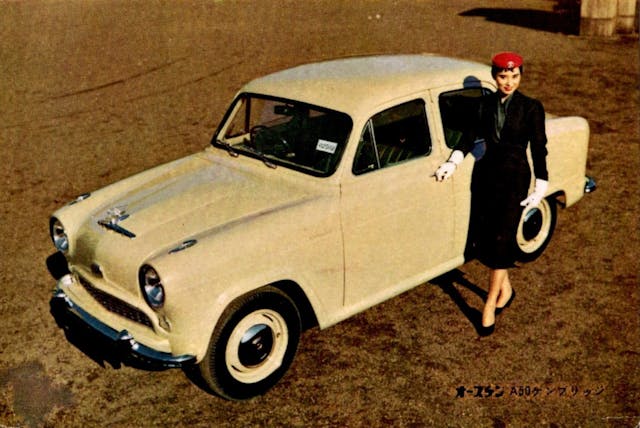
But in 1947, Japan was struggling with ramping up production of even the most basic products. Raw materials, supply chain issues, a collapsed economy, and generally dismal working and living conditions didn’t translate to eager buyers of large English sedans. Katayama knew this, and felt that a bare-bones economy car was the way to kick off not only the rebirth of Nissan but also that of Japan. It was the same rationale that produced Germany’s Beetle and France’s 2CV. Both vehicles would begin production in 1947, the same year in which Katayama began envisioning their Japanese counterpart.
Nissan designer Ryuichi Tomiya was of a like mind with Katayama. Well-known throughout Japan for his various automotive and industrial designs, the future director of the Tomiya Research Institute would go on to design several important cars including the Fuji Cabin three-wheeler. Back in the 1940s, he was not up for rehashing Austins even though Nissan was dead set on going upmarket with the larger Austin A40 sedan.


Tomiya and Katayama hatched a plan to break from Nissan and start their own automobile company, focusing on affordable but sprightly commuter cars. They settled on a design they called the Flying Feather: An extremely simple, lightweight, two-seater with the presence of a peculiar yet sporting coupe. Yes, it would run motorcycle wheels and tires. And, yes, power would come from a puny one-cylinder air-cooled Nissan engine, located in the rear of the car, no less. But since the vehicle would not be much more than two motorcycles stitched together, it would be simple to repair, easy to build, and peppy enough to satisfy those who needed basic transportation.
By 1950 Katayama was able to produce his first prototype, a doorless convertible somewhat like a stylized Jeep on motorcycle wheels. His first problem was getting the prototype out of the second-story shop it was built in, but once Nissan saw the elegant little doorless convertible, executives were impressed, and they agreed to produce the Flying Feather. Nissan was ready to produce its own version of Austin’s A40, and the Flying Feather would broaden the company’s portfolio by providing a smaller, cheaper option.
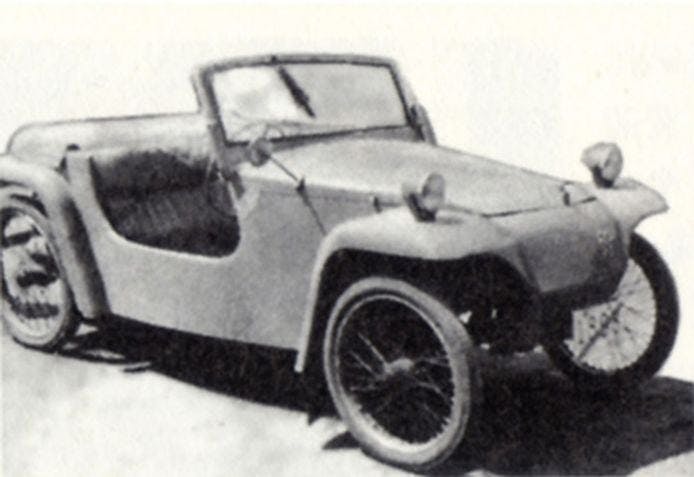


What appeared to be a solid production plan quickly fell apart after Katayama brought food to workers who were striking at a Nissan assembly plant to protest poor working conditions and constant interruptions for lack of materials. Nissan quickly parted ways with Mr. K—and his Flying Feather.
Undeterred, Katayama and Tomiya struck out on their own. A second, more stylish prototype would be the basis for the production-spec Flying Feather. Bug-eye headlights blended nicely into the hood, or frunk. A tapering body incorporated flares covering the front tires, with the body moving out as it flowed to the rear. The design ended with tall air vents chopped off at an angle. With large wheel openings for those big motorcycle wheels, it presented impressive overall proportions, adding to its diminutive though sporting look.

The refined prototype now had doors, independent front and rear suspension, and an air-cooled 350cc V-twin engine offering 12.5 hp. In this final form, the Flying Feather weighed 935 pounds. It was light as a proverbial feather, with better performance than the first design.
The windows swung up on hinges, rather than rolling up and down, and no radio or heater was offered. There were friction shocks to suppress jounce, and brakes only at the rear. The interior was spartan: The frames of the seats were exposed—from the side, you can see the springs—and covered with a fabric pad that served as upholstery.




After shopping the car around to suppliers, Katayama landed at Suminoe Engineering Works. It produced interiors and small bits to Nissan and agreed to produce the Flying Feather. Adding additional air beneath the wings of Katayama’s project, the Japan Ministry of International Trade and Industry (MITI) agreed to help nurture Japan’s own “people’s car.”
A production version of the Flying Feather—the “smallest, cheapest, and most economical practical car in the world”—was the highlight of the 1954 Tokyo Auto Show. Unfortunately, things quickly fell apart.

The MITI support never materialized. Then, Suminoe lost its contract to supply interiors to Nissan, which bankrupted the supplier and pretty much ended any possibility of producing more Flying Feathers. In the end, only around 200 were made. Very few have survived, and only a handful of restored examples exist today.


Though Katayama’s dream of an affordable car for Japan was gone, he wasn’t done with ambitious projects. He mended fences with Nissan, starting as team manager for Datsun’s two 210 entries in the 1958 Mobilgas trials in Australia. In 1960, Nissan sent him to America to oversee the launch of the Datsun brand. Though strained in these early years, Katayama’s efforts as the first president of Nissan of America laid the foundation for the expansion of the company. The Datsun 510, the 1600 and 2000 sports cars, the successful racing alliance with Peter Brock’s BRE Racing in the late 1960s and 1970s, and the development of the 240Z all happened under the stewardship of Mr. K.
In 2009, at 100 years old, Katayama remained immersed in the machinations of the car industry, offering his take on the impact of the Mazda Miata as the 240Z’s successor. He died at the age of 105, his reputation as a leader in the development of the Japanese and American automotive landscape well established. And while the Flying Feather is but a sidenote of his illustrious career, it really was a milestone in the reemergence of Japan and its burgeoning automotive industry.
***
Check out the Hagerty Media homepage so you don’t miss a single story, or better yet, bookmark it. To get our best stories delivered right to your inbox, subscribe to our newsletters.
The post Suminoe Flying Feather: The Postwar People’s Car Japan Never Got appeared first on Hagerty Media.
]]>
This article first appeared in Hagerty Drivers Club magazine. Click here to subscribe and join the club.
The early 1980s were a turbulent time for the U.S. economy. Inflation, high interest rates, and rising concerns about things like imported goods and a shifting job market. Sound familiar?
Frustration about the situation brought out lots of debate, as well as some patriotic thinking from those who thought they might be able to help boost the spirits of America and its ailing auto industry. One elaborate idea actually came close to happening, as far-fetched as it might have seemed: drive an American-built car from Japan to Detroit.
“I started to brainstorm and said, ‘What can we do? Something spectacular,’” remembers Leon Kaplan, thinking back on the events of 40-plus years ago. At the time, he was wearing many hats: repair shop owner, aviator, broadcaster, former racer. Kaplan’s Los Angeles repair shop had him working on the luxury cars of some of the movers and shakers in Hollywood and Beverly Hills going back to the 1960s. His client roster included Lucille Ball, Lloyd Bridges, Dolly Parton, Sammy Davis Jr., Debbie Reynolds, Ricardo Montalban, Shirley Jones, and a young Michael Jackson.
With his weekly Motorman radio show in Los Angeles, which he only recently retired from, as well as regular local and national television appearances, the North Carolina–born mechanic to the stars nearly hatched a scheme to have a domestic car travel under its own power more than 8000 miles from the Port of Tokyo all the way to downtown Detroit.

A red, white, and blue publicity stunt to end all publicity stunts, attempting to show that an American-built automobile was as good as anything arriving from Japan on a cargo ship.
Obviously trekking across a route that was mostly over water would require some kind of gimmick, and Kaplan had come up with one. He would place a car on a custom-built vessel, with the vehicle’s drivetrain providing momentum via rollers and a hydraulic propeller system. The idea got as far as having a sailboat designer draw up plans for the 54-foot tri-hull, a layout that would help ensure stability on the high seas.

“It must have been Petersen who put me in touch with Iacocca,” said Kaplan—Petersen being publishing magnate Robert E. Petersen, a friend as well as a customer at Kaplan’s shop, of course. And yes, Lee Iacocca, the then-CEO of Chrysler who had become a household name, thanks to his side role as television pitchman for the company.
“If you can find a better car, buy it.” That was Iacocca’s stoic tag line as he was beamed into millions of American homes on a regular basis, touting the products of the newly reinvigorated Chrysler. The company seemed an ideal partner for “Leon Kaplan’s All-American Trans-Pacific Automotive Spectacular,” the initial working title for the project. Kaplan’s manager-publicist had earlier come up with a marketing packet that was shopped around to the Big Three.

Ford passed immediately; General Motors expressed mild interest, but it was Iacocca at Chrysler who really saw potential in the elaborate plan. Kaplan flew to Detroit several times to meet with the chief executive, who sought to promote his company’s upcoming flagship, the Chrysler LeBaron convertible. For that vehicle, Kaplan had to modify the design of the propulsion system a bit, as the initial layout was intended for a rear-wheel-drive car. With a LeBaron riding piggyback, the dual dynamometer-type rollers under the front wheels would be on swivels. The driven wheels would be effectively powering the ship, and when the driver turned the steering wheel, the ship’s rudder would move accordingly.
An alternative name for the floating epic was soon proposed: Chrysler Craft. At Iacocca’s insistence, “New Chrysler Corporation” was to be emblazoned on both sides of the vessel, helping highlight that the company he had come to the helm of was on a comeback. Kaplan recalls his multiple visits to Iacocca’s office, remembering that it was “nothing fancy,” located in the old Chrysler Building in Detroit. With Chrysler’s new mission of austerity and getting back on its feet, Kaplan found the visits with the CEO to be very unpretentious.
As the proposal progressed, Kaplan—who had done some off-shore boat racing—consulted with maritime experts about the best route and time of year to make the ocean voyage. Travel across the Pacific would be easiest in late spring and early summer, and a stopover in Hawaii would be a necessary part of the journey. The project was then timed to have the Chrysler Craft’s final destination be the San Francisco Bay, arriving under the Golden Gate Bridge on July 4, 1983. Along with Iacocca, the LeBaron would supposedly be welcomed back to dry land by none other than President Ronald Reagan. Widespread media coverage would pretty much be a given.

Helping with that aspect, Robert Petersen pledged his assistance in the telling of the journey’s story. Among his media company’s numerous titles at the time was a yachting magazine called Sea. That publication would cover the project extensively, and Motor Trend would undoubtedly have splashed the story on its pages as well. Kaplan’s manager had also gotten coverage commitments from Time, People, Playboy, and other outlets.
In the proposal, after landing in San Francisco the fully functional car was to be offloaded, then Kaplan would drive it to Chrysler headquarters in Detroit to finish off the trip. The tricky part would have been completed at that point, so the paved portion would have been smooth sailing, in the figurative sense.
The concept had so much traction in its planning stages that Mattel signed on for rights to build toy versions of the car-ship combo. Its prototype shop built a 1:43 scale model, which Kaplan owns to this day and used during his presentations in Iacocca’s office. “I even had a special case that I used to carry it with me on airplanes,” he remembers.

Kaplan had a California-based shipbuilder lined up to construct the vessel, and he was assured they could meet the time frame laid out. There would be a launch ceremony at the Port of Long Beach, then a 50-mile shakedown run to Santa Catalina Island and back, just to make sure everything worked as designed. Once the watercraft and its attendant Chrysler were signed off as functioning properly, the whole assembly was to be loaded onto a barge for transport to Japan.
Would the car survive the obscure round-the-clock journey, great distances away from a service facility? It’s safe to assume that Chrysler’s engineering team would have prepared the most balanced, blueprinted, micrometer-measured, hand-torqued LeBaron possible. One thing was an absolute certainty: The convertible would have to run the standard 2.2-liter four-cylinder engine, and not the optional Mitsubishi-built 2.6-liter unit, for obvious reasons. Kaplan figured that the car would be most reliable with the engine running at a steady 1500 rpm, and that would yield a water speed of about 5-6 knots.


When asked about what kind of reaction this escapade might have gotten from the Japanese government, Kaplan sort of shrugged, as the proposal hadn’t really included any diplomatic aspect. Presumably, an international shipping company familiar with foreign port protocols would have been brought in for assistance. Still, once the Chrysler Craft was deployed in Japan’s territorial waters, some eyebrows surely would have been raised. Perhaps the philosophy of “It’s easier to beg forgiveness than ask permission” was the game plan.
In the planning, other logistical needs were taken into consideration. For example, while the trimaran was designed to have a working repair pit under the car, along with storage for spare parts, tools, and other necessities (including bunks for sleeping below deck), a support vessel would be needed to tag along on the two-week crossing. For that, a ship from the Pacific tuna fleet out of San Diego was to be hired. The crews of those large fishing boats were used to being at sea for weeks at a time, had maritime knowledge of the waters, and the ship could obviously carry whatever supplies might be needed.

For example, hundreds of gallons of unleaded gasoline to refuel the car along the way. To ferry fuel, supplies, and relief drivers to the Chrysler Craft, Kaplan revised the design to have a slanted ramp at the stern. That way, an inflatable Zodiac boat could land, offload containers of fuel and other things, then easily slide off and make its way back to the nearby support ship. The tuna boat would also provide quarters for sleeping, showers, meals, and so forth.
Kaplan was to be the lead driver, most importantly at the helm of the top-down LeBaron as it made its triumphant arrival under the Golden Gate. He had enlisted some boating and sailing friends as relief drivers, though he told very few people about the project beyond those directly involved.

Everything seemed to be in place, except for a key element: a signed contract—and the ensuing funds—from Chrysler. The cost to pull off everything was calculated to be approximately $1.1 million, chump change for a major auto manufacturer, even in 1982. But perhaps not a manufacturer under the continuing scrutiny of Congress. The U.S. Government had guaranteed $1.5 billion in bank loans a couple of years earlier in order for the company to stave off bankruptcy. Part of the agreement to get the loans was that Chrysler cut the costs that had previously soured its balance sheets. Splashy publicity hijinks were probably not considered a necessary seven-figure expenditure in the eyes of the company’s chief financial officer.
As the clock ticked toward the mid-1983 target for the voyage, Kaplan couldn’t get a final commitment from Iacocca. He did have secondary sponsorship agreements from Hawaiian Punch and Goodyear, but title sponsor Chrysler needed to come through with the bulk of the money.

Time went on, and Kaplan did occasionally hear from Iacocca, who said he was still interested in the idea, “Maybe next year,” as Kaplan recalls. But as Chrysler steamed ahead through the ’80s with a renewed spirit of innovation, early payback of the loans, and new-found profitability, the planned Chrysler Craft got stuck in eternal dry dock.
Today, Kaplan looks back fondly on the project, reflecting on the countless hours he invested trying to bring it to fruition. If it had happened successfully, it truly could have been spectacular and gone into the history books. Who knows, Chrysler might have even created a TV spot about it. Imagine Lee Iacocca standing proudly akimbo atop the ship, with the LeBaron just behind him, and the Golden Gate Bridge off in the distance. “If you can find a better car, drive it across the Pacific Ocean!”
The Chrysler Craft: An Unrealized Dream



To embark on such a voyage, the vessel toting the LeBaron would have to be large and stable enough to handle the deep blue Pacific, but also small and light enough to be propelled by a passenger car with a rather meek engine. Kaplan enlisted Searunner Multihulls of Virginia, run by two experienced ocean sailors and designers, John Marples and Jim Brown. It was Brown who drew up the initial 54-foot trimaran plans, with the center hull shaped to carry the Chrysler. Marples still remembers the project and recently said, “I was sorry that the design was never built.” So is Kaplan.
***
Check out the Hagerty Media homepage so you don’t miss a single story, or better yet, bookmark it. To get our best stories delivered right to your inbox, subscribe to our newsletters.
The post The Audacious PR Stunt to Prove That the Chrysler LeBaron Was a World Beater appeared first on Hagerty Media.
]]>
The Ford Heritage Vault, launched in 2022, is a digital resource where Ford enthusiasts can find thousands of brochures and official photos from the Blue Oval, Mercury, Lincoln, and even more obscure marques like Edsel and Merkur. Best of all, the materials are open to editorial and educational use, so individuals, model-focused clubs, and journalists can better inform people about the automaker’s history with primary source material. While other automakers maintain archives of historic items, only Ford makes them so readily available to the public.
When the Heritage Vault started there were around 5000 materials in the online collection, whose origins ranged from 1903 to 2003. Just two years later, that figure has increased to over 16,000 resources and counting. The original focus was on materials from the United States, but the collection has since broadened its scope. Today, you can also find information about Ford’s European, Australian, and South African models on the site.

We spoke with Ted Ryan, Ford’s Archives and Heritage Brand Manager and leader of the Heritage Vault, to discuss the project’s future. Ryan has assisted Hagerty with several projects, including our visit to Ford’s private, physical archives for a deep dive into Bronco history.
“It’s been a success, even more so than we ever would’ve anticipated,” he said.

Since launching, the site has tallied over 20 million searches and nearly 10 million downloads. “To have that many downloads means that people are coming in, and they’re finding what they want,” Ryan said. “We’ve tried to make it so that a fan of Ford Motor Company, whether they’re media, enthusiasts, [or] a kid writing a paper can find what they’re looking for.”
The next step will be uploading some history even non-Ford fans might find interesting—a general-interest magazine. The automaker published its Ford Times magazine from 1908 through 1917 and then again from 1943 to 1993. In early April 2024, the Heritage Vault will add 320 issues from 1964 through 1982. Ryan said there are plans to add more later.



“Each magazine has sections on outdoor travel, lifestyle, and restaurants that usually would feature recipes,” Ryan said. Usually, there would only be one story a month about Ford vehicles, and the rest would focus on contemporary Americana. These resources could be fascinating for anyone interested in the history of travel across the country.
Ryan and his team of archivists have an eye toward the future, too. Eventually, they’d like to add a curated collection of press releases focusing on important vehicle introductions in the company’s history. The earliest ones the group has access to date back to the 1920s.

With 16,000 cubic feet of paper-based materials and 3 million photo negatives at their fingertips, archivists must prioritize what they add to the online Heritage Vault. “Curatorially, we look at it through the eyes of ‘will a student want it?’” Ryan said. “Will a journalist want it? Will an enthusiast want it? And then, if it’s rights-free, then we work to make it available.
Ryan also wants to expand the Ford Heritage Vault beyond photographs, magazines, and brochures. The next step is to move into video. That development is still a year or more away, but it’s part of the plan. “We could do cutdowns of B-roll type material,” Ryan said.

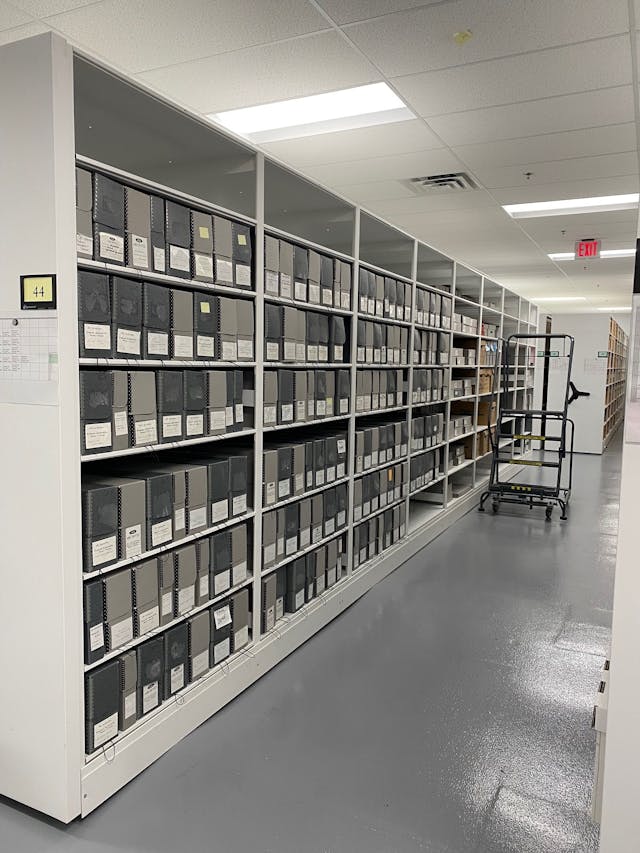
The biggest challenge is to add more motorsport media to the archive. Copyright issues are the major hurdle for including this content because clearance is required for every sponsor decal on a vehicle. Plus, if there are other race cars in the image, permissions are also necessary for them. A solution is on the horizon, though.
“Motorsports is still going be rights-entangled,” Ryan said. “We have discussed different strategies and quite frankly, we think we’ve got a way that’s going to work, but we’re going to make it a 2025 initiative, and we’re going to experiment to see how we can do it.”
If you’re a Ford enthusiast, the Heritage Vault site should be your first stop for fascinating vehicle history and rich research. Between the thousands of images and brochures, plus videos on the horizon, and the Ford Times magazine for a taste of the times, there’s plenty for Blue Oval fans to explore. We wish every automaker had Ford’s commitment to both historical preservation, education, and public access.

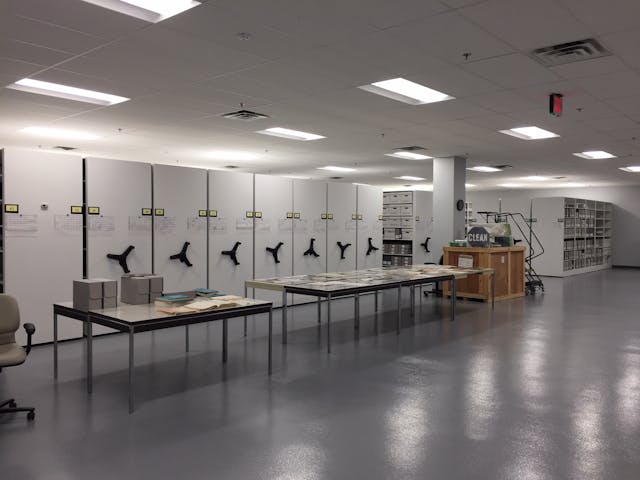

***
Check out the Hagerty Media homepage so you don’t miss a single story, or better yet, bookmark it. To get our best stories delivered right to your inbox, subscribe to our newsletters.
The post What’s Next for the Ford Heritage Vault, a Public Window to Blue Oval History appeared first on Hagerty Media.
]]>
More than a century ago, the largest automobile dealership in the American West was located at the corner of Park and Idaho Streets in uptown Butte, Montana, and it wasn’t affiliated with Ford or Chevrolet. It proudly sold Dodge Brothers motor cars.
Butte, then known as the “Richest Hill on Earth” for its gold, silver, and copper mining operations, was nestled among mountain ranges, rivers, and streams, halfway between Glacier National Park and Yellowstone National Park. By the early 1900s, Butte was a bustling town that offered a wealth of opportunity for those who worked hard and weren’t afraid to get their hands dirty. At one point, Butte had a population of more than 100,000 and was so diverse that “No Smoking” had to be written in 16 different languages. As John and Horace Dodge soon learned, however, there is no language barrier when it comes to automobiles and innovation.

The Dodge Brothers Company, originally formed in 1900, had designed and built components for the original Ford Model A, and later complete drivetrains for the Model T, before leaving the company due to what the brothers perceived as Henry Ford’s lack of innovation. Vowing to build a better automobile, John and Horace Dodge completed their first car in 1914, and their reputation for quality and modernization led to more than 20,000 dealership applications. One of those selected was from Butte, which opened a state-of-the-art showroom, auto parts store, and garage and unveiled Dodge’s new four-cylinder Model 30-35 touring car.


The Dodge was popular, and not just in Montana. In 1915, the automaker’s first full year of production at its Michigan plant, Dodge Brothers became America’s #3 brand, with more than 45,000 sales. Advertising took direct aim at the brothers’ former employer with slogans like “Think of all the Ford owners who would like to own an Automobile.”
Butte’s 20,000-square-foot Dodge Brothers Building maintained its status as the largest dealership in the West as Dodge built hundreds of thousands of cars and trucks, but that began to change in the 1920s. John and Horace Dodge, who were three years apart in age and practically inseparable, both died within months of each other in 1920. Longtime employee Frederick J. Haynes was promoted to manage the business, but the Dodge family heirs had little interest in running a car company. By 1925, with development and innovation practically at a standstill, Dodge tumbled from the third-best-selling automaker in the U.S. to fifth. The family sold Dodge Brothers to a banking firm for $146 million in cash, then the largest cash transaction in American history, and three years later Walter Chrysler took over.

Butte’s Uptown automotive palace eventually folded, but while many historic automotive buildings around the country are being torn down, the historic Dodge Brothers Building still stands and is looking for a new lease on life. Cate Stillman, who co-owns the four-story building with her husband, Winston Welch of ICW Properties, says the site is for sale and is perfect for urban offices, apartments, condos, industrial loft space, and other innovative uses. Stillman and Welch are hoping to find a buyer in the automotive industry or someone related to the Dodge family.
Stillman admits that the building, which broke ground in 1912 before Dodge later took ownership, “needs a lot of work.” It is for sale as-is or can be built to spec. Stillman and Welch already constructed a wine bar and commercial kitchen on the street level, to go along with the parking garage. They hope that the building will play a key role in Butte’s revitalization.

“Butte is going through a bit of a revival,” Stillman says of the city, which has a current population of 35,000. “It’s beautiful—surrounded by wilderness hiking, hunting, skiing, snowmobiling—and it has this crazy historic town experience … We’d really just love to see this building get into the right hands.”
That’s why, despite some interest already, the two want to spread the word before agreeing to a deal.
“We have offers to basically ‘condo out’ and split it up, [but] we want to give people connected to Dodge a shot at getting this building back,” Stillman says. “To me, the building in its integrity has a lot of potential for more of a unified, cohesive experience between all four floors … I really see a lot of potential for this to be returned to people connected to Dodge and to see what they would want to do with it in the spirit of partnership and the spirit of innovation and the spirit of true brothers in proximity.”
***
Check out the Hagerty Media homepage so you don’t miss a single story, or better yet, bookmark it. To get our best stories delivered right to your inbox, subscribe to our newsletters.
The post For Sale: Century-Old Dodge Brothers Building Is a Real Butte appeared first on Hagerty Media.
]]>
Traverse City, Michigan — On April 3, 1984, in the basement of the family home in Traverse City, a small resort town on the shore of Lake Michigan, Frank and Louise Hagerty started a business to sell insurance policies to owners of classic and collector wooden boats.
Insurers at the time considered these elegant, highly polished boats to be too risky and too few to bother with, so the Hagertys—who loved to cruise the local inland lakes in a Chris-Craft named Pipe Dream—did what entrepreneurs have always done when they detect an unfilled niche.
They filled it.
But success with a startup is never certain. After setting up the business, placing a few small ads in wooden boat magazines, and connecting a single phone line to an answering machine, they hoped for the best. Their first stroke of good luck happened on a road trip to Florida. McKeel, the youngest of the three Hagerty children after Kim and Tammy and today the company’s CEO, went into a phone booth to check the answering machine and see if anyone had left a message. He heard nothing. Silence. He worried that no one had called, that no one wanted wooden boat insurance after all. Moments later, he realized the tape wasn’t empty, the silence was the tape rewinding to the beginning. Instead, message after message was of boaters wanting quotes, so the family turned the car around and headed back to Michigan.
They didn’t know it at the time, but that moment would be the start of something big—for the Hagerty family and for car collectors and fans everywhere.
Forty years later, Hagerty has become the hub of a community for millions of classic car lovers, a publicly traded company on the New York Stock Exchange (HGTY), and a leading automotive membership, media, and event company that in 2023 passed a billion dollars in annual revenue for the first time.
Today, Hagerty employs nearly 1,700 people worldwide, including about 500 in the Traverse City region, and insures more than 2.5 million vehicles. The company has an industry-leading Net Promoter Score of 82 (a gauge of customer loyalty for which the industry average is in the mid-40s) and partners with nine of the top 10 U.S. automotive insurers, including State Farm, the nation’s largest insurer of private passenger vehicles.
Let’s flip the calendar back to 1984 and look at some of the company’s milestones along the way.
Down in the Basement


Almost from day one, the business grew quickly, with Frank serving as the charming impresario and Louise as the operational glue that held things together. She was Hagerty’s first CEO.
“Dad had some amazing innovations that were baked into the business early on. He was an absolute visionary, not an operations person, though,” McKeel says today. “That was where my mom came in. She set up all the stuff that made Hagerty efficient and run well.”
But they were beginning to outgrow the basement, especially now that they had five employees in addition to Grandma Helen, who lived in the house at the time, and there was only one bathroom.
“We were just sort of figuring it out as we went,” Tammy Hagerty recalls. “I’m so proud that we’re still using a lot of those early concepts: the service level, the claims, Guaranteed Value, repair shop of choice. To this day, those differentiators are part of what makes Hagerty unique and successful.”


After five years in the basement, the agency made two major changes: First, it moved into a proper office building called Grandview Plaza near downtown Traverse City. Second and most important, Hagerty started offering insurance for classic and collector cars, writing its first auto policy in 1991. Much of this was driven by customer demand. “So many of our wooden boat customers who also had cars kept asking us to cover them,” Tammy recalls. So, the family almost inadvertently started a second business to insure collector cars. This “spin off” makes up the bulk of the business today. The core principles were the same, however. As Louise famously answered when asked why the business worked so well: “People take good care of their toys.”
“She was right—we exist as a company because of that line,” says McKeel. “Where there is passion for something and genuine care, there exists better insurance risk.”
Built for People Who Love Cars
When the business first began, it was a true family partnership. Everyone pitched in. Kim, Tammy, and McKeel all did their part in the early days. But it was a few years on before the second-generation siblings made their way back to Michigan full-time and the business started hiring key people. Tammy was the first to return. She and that initial team learned the core concepts from Frank and started selling, underwriting, and handling claims. It was an “all hands on deck” time. “We all learned so much. And we did it in real time,” Tammy recalls.

In 1995, Kim and McKeel returned home from lives they’d built on the west and east coasts, respectively. Eventually, Kim stepped into the CEO role while McKeel became president. Later on, Kim and McKeel shared the CEO role for a number of years until Kim became the company’s first board chairperson. Kim, who passed away in 2021, was known for her friendly spirit, infectious laugh, sharp legal advice, and 1957 Thunderbird—a head-turner around town due to its pink paint job. She is often credited with keeping the family values at the forefront of the business as it grew.
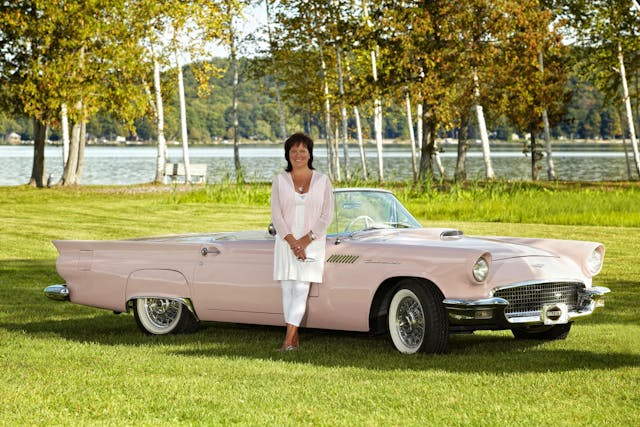
In 1997, the Hagertys realized the company would never grow by advertising insurance. “Insurance is boring,” says McKeel. Instead, Hagerty marketing efforts were imbued with a “twinkle in the eye” approach that focused on cars, not insurance. The response was enormous.
By the early 2000s, the company had grown enough that it started giving back to the collector car industry. Starting with the Hagerty Fund, launched in 2002, Hagerty has to date invested more than $22 million in preserving car culture. This includes the creation of a national nonprofit, the Hagerty Drivers Foundation (HDF), which financially supports institutions teaching the critical skills needed to keep every vehicle on the road. The Foundation also provides driver education grants to young drivers through its License to the Future program. In addition, the HDF has added 34 historic vehicles to the National Historic Vehicle Register, the only federally recognized program that documents and celebrates America’s most significant automobiles, preserving their heritage in perpetuity at the Library of Congress.

In 2018, to continue supporting the automotive community beyond insurance coverage, Hagerty began offering membership in Hagerty Drivers Club (HDC), which is the ultimate community for car lovers, offering exclusive discounts, roadside services, member experiences, and more. The club currently has more than 800,000 members.
Developing a passion-based community was always one of McKeel’s dreams. “Cars have a way of bringing people together,” he says. “Everything we do at Hagerty is to help people get the most out of the passion they have for cars and driving, and HDC is a big part of that.”

One of HDC’s most popular offerings is Hagerty Drivers Club magazine, which has become the nation’s largest print automotive magazine, featuring the work of the industry’s top automotive journalists. Similarly, Hagerty’s YouTube channel has become a massive hit, boasting more than 3 million subscribers.
Events, Auctions, and the New York Stock Exchange
In recent years, Hagerty has stewarded multiple high-profile, national events, such as The Amelia, Greenwich Concours, Motorlux (formerly McCall’s Motorworks Revival), a UK event called Festival of the Unexceptional, and RADwood, an ongoing series of events featuring ‘80s and ‘90s cars, music, and fashions that appeal to younger car collectors.
In December 2021, in perhaps the biggest moment in company history, Hagerty joined the New York Stock Exchange at a pro forma enterprise value of approximately $3.1 billion. At the time, McKeel said: “Today is a milestone for Hagerty and a testament to the talent and dedication of the entire Hagerty team and their commitment to our purpose of saving driving and car culture for future generations.”

In 2022, the company acquired Broad Arrow, which operates live and online collector car auctions. At its most recent two-day live auction at the 2024 Amelia, Broad Arrow sold more than $63 million worth of cars with a 92% sell-through rate. Among the top lots were a 1967 Ford GT40, at $4,405,000; and a 2022 Bugatti Chiron Pur Sport, at $4,047,500. In its first two years of operation, Broad Arrow tallied more than $180 million in transactions across auctions, private sales, and financing, establishing Hagerty as a major player in the live auction space.
To McKeel, auctions are a natural extension of the company’s long-standing efforts to provide in-depth valuation data and analysis of market trends to the collector community through Hagerty Valuation Tools, Hagerty Price Guide, and Hagerty Insider.
“We’ve often said the world didn’t need another auction company, but it did need a better one,” says McKeel. “Buyers and sellers trust Hagerty, and that’s extremely important in the online and live auction worlds.
“Just like with the insurance side of the business,” he continues, “we thrive by taking underserved industries and making them better for car lovers.”

Most recently, the company announced Keepers of the Flame, a year-long creative campaign and an ode to the passion that millions of people share for cars and driving. The campaign kicked off in late March 2024 with an exciting, emotional video, which is available here.
For McKeel, the campaign is one more way of honoring the car community.
“More than 67 million Americans self-describe as car enthusiasts,” said McKeel. “We exist for them. I take pride in knowing their passion for cars is as vibrant as it was 40 years ago, and that Hagerty is playing a vital role in maintaining this community of car lovers for the next 40 years.”
And it all started in a Northern Michigan basement.
***
Check out the Hagerty Media homepage so you don’t miss a single story, or better yet, bookmark it. To get our best stories delivered right to your inbox, subscribe to our newsletters.
The post Hagerty Celebrates 40 Years of Supporting the Collectible Car Community appeared first on Hagerty Media.
]]>
We’ve looked at a couple of controversial General Motors classics in this series so far (the Chevrolet Corvair and the Pontiac Fiero) but just a single Ford product that stirs up heated debate among enthusiasts (the Mustang II). Today we’re going to restore GM/Ford balance by taking a look at a discarded example of the most polarizing Ford Motor Company product ever built: the Edsel!

The Edsel brand was created after exhaustive market research and consultation with focus groups, with plenty of futuristic statistical analysis and—more significantly—office politics stirring the pot. Sadly, the car itself didn’t get put in front of consumer focus groups before its unveiling.

The general idea was that Dearborn needed a mid-priced brand to squeeze in between aspirational Mercury and wealth-flaunting Lincoln, in order for Ford to better compete with GM and its “Ladder of Success” model (in which a customer would get a Chevrolet as his first car, then climb the rungs of increasingly prestigious Pontiac, Oldsmobile, Buick, and Cadillac as he became more successful).

After much heated debate, the new brand was named after Henry Ford’s eldest son. Edsel Ford was a creative visionary with good business sense who spent his life butting heads with his stubborn old man and died young while fighting to save the company from Henry the First’s obsession with building ever-cheaper Model Ts forever.

As we all know, the Edsel Division flopped hard. After much pre-launch hype before the “E-Day” launch in September of 1957, the seven Edsel models went on sale as 1958 models. The final Edsels were built as 1960 models.

Sales for the ’58s were solid at first, though the radical styling put off some potential buyers. A bigger problem was the fact that Edsel pricing had the new division competing directly against Mercury, whose Montclair and Monterey shared their platform with the Edsel Corsair and Citation. Meanwhile, the cheaper Edsel Ranger’s price tag was uncomfortably similar to that of the Ford Fairlane 500. To make matters worse, the very cheapest 1958 Lincoln was still priced well above the most expensive Edsel.

Then, wouldn’t you know, the Eisenhower Recession hit new-car sales hard in 1958 and 1959. American car shoppers began paying increasingly strong attention to list prices and fuel economy, and the flashy, thirsty Edsels sat on dealership lots while American Motors cashed in with Rambler sales and Volkswagen of America moved more Beetles than ever before. Even Renault prospered here with the Dauphine for a couple of years.

The Edsel Division got merged into Lincoln-Mercury (there was never any such thing as a “Ford Edsel”) while resources were poured into the compact car that became the 1960 Ford Falcon. Robert McNamara, future architect of the Vietnam War, became president of Ford in 1960, and Edsel zealots enthusiasts often cast him as the villain who killed the Edsel in favor of the Falcon.
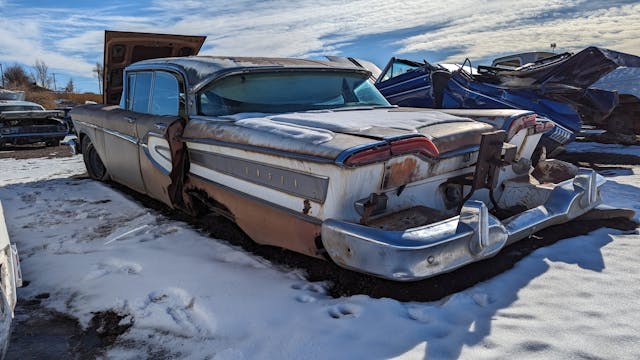
Who or what really killed Edsel? It’s hard to get angry about the Falcon, which was a stunning sales success in its own right and whose chassis design underpinned everything from the 1964–73 Mustang to the 1980 Granada. The recession? Changing consumer tastes? Communist agents? In any case, I’m glad that I was able to find this first-year Citation to write about.

Look, it even has a Continental kit! I found this car at Colorado Auto & Parts, just south of Denver. It’s got more than 100 Detroit vehicles from the ’40s through the ’70s in its inventory right now, including another 1958 Edsel Citation.

The engine is a 410-cubic-inch MEL V-8, rated at 345 gross horsepower.

The base transmission was a column-shift three-speed manual, but this car has the optional automatic with pushbutton shifter on the steering wheel hub.

The Citation was at the top of the Edsel pyramid for 1958, so most buyers wouldn’t have tolerated a lowly manual transmission in one.
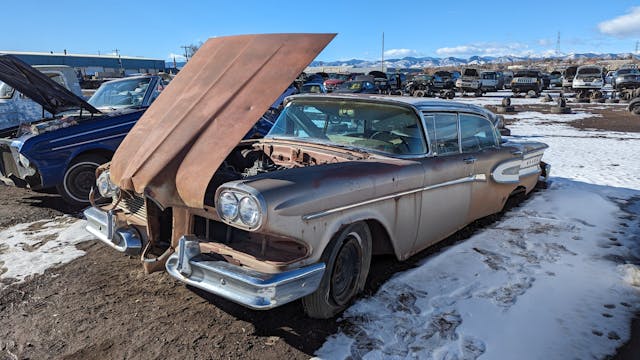


























***
Check out the Hagerty Media homepage so you don’t miss a single story, or better yet, bookmark it. To get our best stories delivered right to your inbox, subscribe to our newsletters.
The post Final Parking Space: 1958 Edsel Citation 4-Door Hardtop appeared first on Hagerty Media.
]]>
The historic Packard plant could be history by the end of the year. Detroit Mayor Mike Duggan announced earlier this month that the mammoth facility, which stopped producing Packard luxury automobiles in 1956 and has been mostly abandoned since the 1990s, will be fully torn down by the end of 2024.
Once the standard-bearer of modern automotive factories, the Packard plant is one of a handful of transportation-related buildings in the Motor City that have become popular “ruin porn” attractions during the last several decades.
“Sixty-eight years,” Duggan told Fox 2 Detroit, referencing the last time a car was produced at the plant, “but it was worth the wait.”

Duggan and city officials, speaking at a press conference on March 4, said they hope to have a new automotive-related plant built on the 42-acre site, located on East Grand Boulevard, northeast of downtown.
“You can see that a lot of it has already been cleared out,” Duggan said. “This is an ideal site for manufacturing. I want to see people making auto parts again here.”
The press conference actually marked the beginning of the third phase of the demolition, which began in 2022. Peruvian developer Fernando Palazuelo had planned a $350 million mixed-use development there, but the project was slowed by the pandemic and eventually came to a halt. When Palazuelo failed to comply with a court order to demolish the dilapidated buildings, the city took ownership and immediately announced demolition plans.
The first portion of the Packard plant opened for business in 1903. The complex would eventually comprise four million square feet of factory space and employ up to 40,000 workers at its peak.

In 1954, Packard merged with Studebaker and two years later, production was moved to a smaller plant on Conner Avenue. The last true Packard rolled off the line on June 25, 1956.
Portions of the Packard site were used by numerous small businesses until the late 1990s, when most of the structures were abandoned, left to scrappers, squatters, and the elements.



According to The Detroit News, Detroit-based contractor Adamo Group began demolition at 5409 Concord Street, comprising about 200,000 square feet, on the southern section of the plant. The teardown work is expected to take five months and cost $1.2 million to complete. Three more portions of the plant will need to come down. All told, about $26 million in pandemic relief funding will be used to demolish the plant.

“This project is monumental for the city’s mission [to eradicate blight],” said LaJuan Counts, director of the Detroit Construction and Demolition Department. “It symbolizes Detroit’s resilience and its commitment to revitalization. As we look to a new era for this site, we honor the history of the old Packard Plant while embracing future possibilities for our city.”
Duggan said that not all of the Packard plant will be razed. “The part of it (that) we are preserving is on Grand Boulevard, because this plant is a big part of Detroit’s history. … There will be a small section of the plant on each side of Grand Boulevard that will be incorporated in any developer’s proposal so we can recognize the history at the same time we’re building the future.”
***
Check out the Hagerty Media homepage so you don’t miss a single story, or better yet, bookmark it. To get our best stories delivered right to your inbox, subscribe to our newsletters.
The post Packard Plant Could Be Fully Torn Down by the End of 2024 appeared first on Hagerty Media.
]]>
In Colorado, where I live, four-wheel-drive Subarus have been beloved ever since the first 4WD Leone-based models appeared in showrooms in the mid-’70s. Because of their popularity in the Centennial State for nearly 50 years, the car graveyards along the I-25 corridor amount to museums of the history of the Pleiades-badged brand in America. Today we’ll take a look at an absolutely loaded Subaru wagon, found in a boneyard just outside of Denver.

When we talk about U.S.-market Subarus of the 1970s and 1980s, we need to first discuss the way that Fuji Heavy Industries named their cars on this side of the Pacific. The Leone, as it was known in Pacific markets, debuted in the United States as a 1972 model, but that name was never used here. At first, they were designated by their engine displacements, but soon each model was pitched as, simply, “the Subaru” with the trim levels (DL and GL were the best-known) used as de facto model names. The exception to this system was the Brat pickup, which first showed up as a 1978 model. Things in the American Subaru naming world became even more confusing when the non-Leone-derived XT appeared as a 1985 model followed by the Justy two years later, and the Leone finally became the Loyale here for its final years (1990-1994).

The Leone began its American career as a seriously cheap economy car, mocked in popular culture for its small size (but still getting a shout-out from Debbie Harry). Sponsorship of the U.S. Olympic Ski Team and gradual addition of size and features allowed Subaru to sell the higher-end Leone models for decent money as the 1980s went on.

In 1987, the absolute cheapest member of the Leone family in the United States was the base front-wheel-drive three-door-hatchback, coming in at an MSRP of $5857 (about $16,345 in 2024 dollars). Known to Subaru dealers as the STD, it was disappointingly never badged as such.

At the very top of the 1987 U.S.-market Leone ziggurat stood today’s Final Parking Space subject: the GL-10 Turbo 4WD Wagon. Its price started at an impressive $14,688, which comes to a cool $40,990 after inflation. A naturally-aspirated 1987 GL 4WD Wagon could be had for $10,767 ($30,047 in today’s money). In fact, the only way to spend more on a new 1987 Subaru (before options) was to forget about the Leone and buy an XT GL-10 Turbo 4WD at $15,648 ($43,669 now).
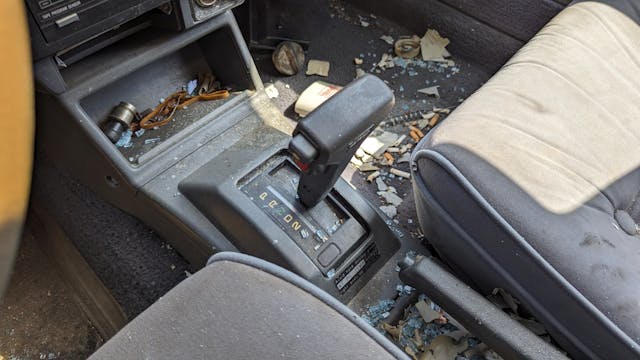
There weren’t many options you’d need on the feature-stuffed GL-10, but this car’s original buyer decided it was worth paying an additional $955 ($2665 in today’s bucks) for the automatic transmission. That pushed its out-the-door cost to within spitting distance of the price of admission for a new Volkswagen Quantum Syncro Wagon and its $17,320 ($48,335 in 2024) price.

Subaru was an early adopter of turbocharging for U.S.-market cars, with the first turbocharged Leone coupes and wagons appearing here in 1983. This car has a 1.8-liter SOHC boxer-four rated at 115 horsepower and 134 pound-feet, pretty good power in its time for a vehicle that scaled in at just 2,530 pounds (that’s about 700 fewer pounds than a new Impreza hatchback, to give you a sense of how much bulkier the current crop of new “small” cars is).

Subaru was just in the process of introducing a true all-wheel-drive system as we understand the term today in its U.S.-market vehicles when this car was built, and both 4WD and AWD systems were installed in Subarus sold here from the 1987 through 1994 model years. (Beginning with the 1996 model year, all new Subarus sold in the United States were equipped with AWD.) Subaru fudged the definition on its badging for a while by using a character that could be read as either a 4 or an A, as seen in the photo above.

I’ve documented a discarded 1987 GL-10 Turbo 4WD Coupe that had genuine AWD (called “full-time four-wheel-drive” by Subaru and some other manufacturers at the time), and it had prominent “FULL-TIME 4WD” badging and a differential-lock switch. This car just has the 4WD switch on the gearshift lever, like earlier 4WD Subarus with automatics, so I am reasonably sure that it has a 4WD system that requires the driver to switch to front-wheel-drive on dry pavement in order to avoid damage to tires or worse. But even as the current owner of two Subarus and a longtime chronicler of junked Fuji Heavy Equipment hardware, I cannot say for certain about the weird 1987 model year. Please help us out in the comments if you know for sure!

This car has the sort of science-fiction-grade digital dash that was so popular among manufacturers (particularly Japanese ones) during the middle 1980s.

It also has what a 1987 car shopper would have considered a serious factory audio system, with cassette track detection and a trip computer thrown in for good measure. This stuff was standard on the GL-10 that year, and you needed that righteous radio to fully appreciate the popular music of the time.

The odometer shows just over 120,000 miles, and the interior wasn’t too thrashed, so why was one of the coolest Subaru wagons of the 1980s residing in this place? First of all, there’s a glut of project Leones available in Colorado’s Front Range at any given moment. Second, all of the most devoted enthusiasts of these cars in this region already have hoards stables of a dozen with no space for more; I let my many friends who love these cars know about this one and they plucked at least a few parts from it before it got crushed (sorry, I shot these photos last summer and this car has already had its date with the crusher).

So, if you’re a vintage Subaru aficionado living where the Rust Monster stands 100 feet tall, head to the region between Cheyenne and Colorado Springs and find yourself a project Leone to bring home. We’ve got plenty here!



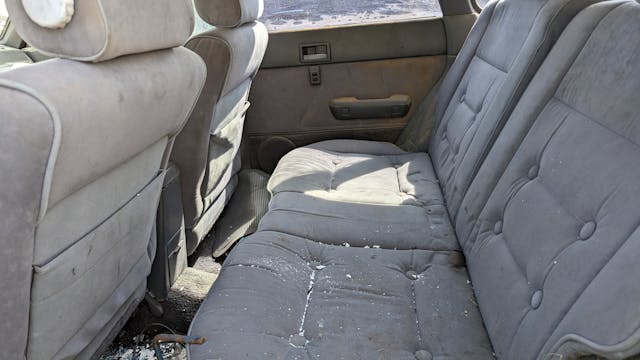






















***
Check out the Hagerty Media homepage so you don’t miss a single story, or better yet, bookmark it. To get our best stories delivered right to your inbox, subscribe to our newsletters.
The post Final Parking Space: 1987 Subaru GL-10 Turbo 4WD Wagon appeared first on Hagerty Media.
]]>
The 1954 Paxton Phoenix was the unfulfilled, steam-powered dream of Robert Paxton McCulloch—the same guy who accomplished the unlikely spiriting of London Bridge out of England into the Arizona desert. Moving a bridge from one continent to another is a tough task, but it proved easier than producing a modern steam-powered automobile.
Steam-powered cars were once a workable transportation solution, based on solid technology. They predated the first internal-combustion-engine (ICE) cars of Daimler and Benz by nearly a century. In operation, a burner, which can be designed to run very clean, heats water in a boiler, converting it to steam, which in turn drives the pistons of an engine. Droplets of oil added to the steam flow provide lubrication. In most automotive applications, the steam powerplant was a reciprocating engine, not unlike a typical internal-combustion engine, but with steam pressure rather than fossil-fuel combustion driving the pistons down in the bores and turning the crankshaft.


And until electric starters made ICE-powered cars convenient, steam-powered machines were in important ways more consumer-friendly than their gas-fueled brethren, since they could be started without hand cranking. Steam engines, like electric motors, have a power curve more in sync with the task of propelling a vehicle, so no transmission was needed. The principal drawback was the time needed after the burner was ignited to preheat the boiler and generate steam.
One of the more advanced steam cars was produced by Abner Doble, an inventor who had devised a means of preheating a small quantity of water for quick startup. His 1925 Doble Model E steam car was powered by a four-cylinder compound engine with both low-compression and high-compression pistons. It was ready to drive in minutes after ignition and developed 1000 lb-ft of torque at the rear axle. A perfectionist, Doble built about 40 cars, each somewhat different. He ran out of money before he could mass-produce a final design.
Enter McCulloch, nearly 25 years later. In the late ’40s, following considerable manufacturing and engineering success in automotive-related fields, McCulloch was determined to build a steam car. But it couldn’t be any old steam car. It had to be a luxurious automobile with a stylish shape and an advanced steam powertrain. He called it the Paxton Phoenix.
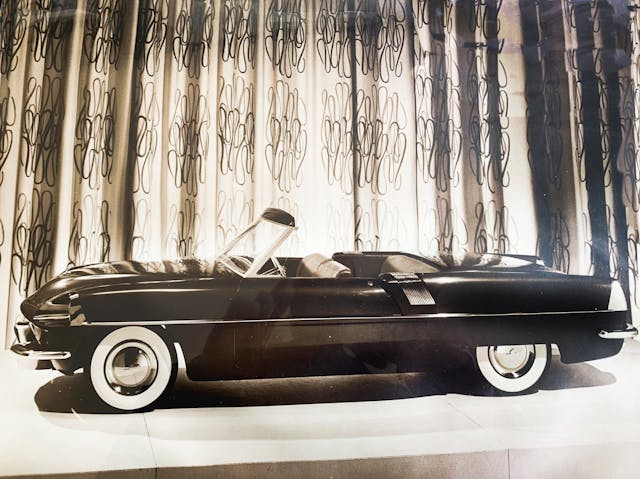
McCulloch was doing well as America entered the fabulous ‘50s. By 1952, he had accumulated considerable resources, largely as the result of his Paxton Supercharger and McCulloch Chainsaw businesses. Paxton was a standard provider to the auto industry, and his chainsaw enterprise had revolutionized the market just a few years earlier. His wealth allowed him to assemble a steam-car dream team: Abner Doble, the steam-engine expert; Roscoe C. Hoffman, a respected automotive engineer who had developed off-the-grid vehicles; and America’s most renowned designer, Brooks Stevens.

Stevens was the star of the show, having already achieved international recognition for his design work. He also had the advantage of having grown up in an automotive household; his father was an inventor of vehicle components. So the younger Stevens was well schooled in the way things worked and had a natural talent for improving the way they looked. Over his career he focused on automobile design but had dabbled as well in the creation of appliances, furniture, toys, boats, trains, tractors, and motorcycles.
The steam car project was based at Paxton Engineering, a research facility near Los Angeles International Airport that served McCulloch’s growing manufacturing enterprises. Like most good automotive creators, the McCulloch team wanted to start with a rough model, so they bought a Porsche 356 in New York and drove it to Los Angeles, where they fully disassembled it and studied its chassis and suspension design. There, Hoffman created a chassis that combined the Porsche design with aircraft “torque box” construction techniques. The suspension used torsion bars for wheel control, much like the Porsche.

The body was made of fiberglass, an emerging automotive technology at the time. Pioneered by Glasspar in 1949, fiberglass was destined to be the material of choice for the Corvette in 1953, and McCulloch seized on it. In many ways, the material lent itself to limited production. Once a female mold had been developed, bodies could easily be pulled from the mold. No stamping, hammering, or welding needed.

The Paxton Phoenix that emerged from years of design and modeling work was a beautiful car, a uniquely styled machine with headlights set deep in chromed scalloped openings. A belt-line chrome strip ran uninterrupted front to rear. Its hood, with a bulging center that suggested power, sloped down to below headlight level, and a wide shiny bumper underlined its low-slung grille. The rear of the car suggested the form of some of Stevens’ speedboat designs. To complement its stylish body, the Paxton Phoenix was equipped with a fully retractable fiberglass top, which mimicked the shape of the deck lid and covered it when retracted.

The steam engine that was meant to power the car was an advanced version of Doble’s earlier efforts. A six-cylinder compound design combining low-pressure and high-pressure cylinders enabled the steam to be used efficiently. The high-pressure cylinders were at the top of the block casting, with the low-pressure cylinders below. Steam was expanded first in the high-pressure cylinder and compressed, then transferred to the low-pressure cylinders, which turned a three-throw crankshaft by means of connecting rods. The result was very smooth power, and the engine was said to equal the thermal efficiency of an advanced overhead-valve gasoline powerplant, with the smoothness of a 12-cylinder engine.
Of course, to use steam power you have to make steam. In the Paxton that would be done in a boiler mounted at the front of the car. Automatic controls would ensure the steam could always be delivered to the engine at optimum pressure and temperature. By heating water inside tubing, operating temperature could be reached quickly, and very high steam pressure could be generated without fear of a violent pressure burst since the pipes were protected by a stout aluminum boiler jacket. It’s said that the car could be ready to drive within 20 seconds after startup. Adding water regularly, as had been necessary with earlier Doble steam cars, was unacceptable in a modern car, so the team devised a system that allowed the exhausted steam to condense back into water that could be reused.

A working prototype of the steam engine was developed and installed in a ’53 Ford. At approximately the same time, according to Jerry Williamson, who was foreman of the Paxton shop in the early ‘50s and was interviewed by this reporter in 2011, the Porsche drivetrain was installed in the Paxton so the vehicle could be tested while the engine development continued. By all accounts the steam engine performed well, but at some point, a catastrophic failure occurred. With funds running dry and little interest from private investors, the project was shelved.

McCulloch kept the car in its final form with the Porsche drivetrain serving as its motive power. He is said to have driven it occasionally. When he died in 1977, Brooks Stevens bought the car and displayed it in his personal museum in Wisconsin. Like McCulloch, Stevens never sold the Paxton. He died in 1998 with the car still in his possession.

Enter Myron Vernis, an automobile lover and collector from Akron, Ohio, who fell in love with all things automotive as a toddler in Greece, where he spent many hours watching cars drive by from the balcony of the Vernis family’s apartment. A fan of both 356 Porsches and Brooks Stevens, Vernis flew to Milwaukee the day after he heard that Stevens had passed. He has now owned the Paxton Phoenix for 26 years, equalling McCulloch’s own time of ownership, and he has no plans to relinquish it. Like the Paxton owners who preceded him, he intends to die with the car in his possession.
Vernis has displayed the car often, including at the Pebble Beach Concours d’Elegance, the former Meadowbrook Concours, and a number of other venues. It has spent time in the Petersen Museum in California and is currently part of a Brooks Stevens display in the Studebaker Museum. You can see it there until April 1, 2024.

***
Check out the Hagerty Media homepage so you don’t miss a single story, or better yet, bookmark it. To get our best stories delivered right to your inbox, subscribe to our newsletters.
The post When the Paxton Phoenix Tried to Take Steam Mainstream appeared first on Hagerty Media.
]]>
It is 1986. Somewhere, on an unrestricted section of German autobahn, the speedometer of a BMW 5-Series clicks upward, hurtling toward maximum. Inside, two young computer programmers chatter excitedly as the revs rise, the top speed modest by European standards, but double the highest limits in their native Japan. There’s no ticking clock, no announcer shouting “Checkpoint!” But at the wheel is a renegade gearhead and Sega employee, and he’s in the process of creating one of the greatest driving games of all time: OutRun.
Note carefully: that’s driving game, not racing game. Released in 1986 to become almost instantly the most popular arcade game in the world, Sega’s OutRun was all about the feel of driving at high speed, rather than competing against rivals. At the wheel of their own convertible Testarossas, thousands of kids poured in quarter after quarter chasing that thrill.

Ferrari’s Testarossa is celebrating its 40th anniversary this year, and it has long been a staple 1980s poster car, rivaled only by the Countach. The most famous example has to be the white 1986 Testarossa that first showed up in the third season of Miami Vice. But the runner up, and arguably more important to a generation, was OutRun’s digitized Testarossa, and its Ferrari roots run deeper than you expect.
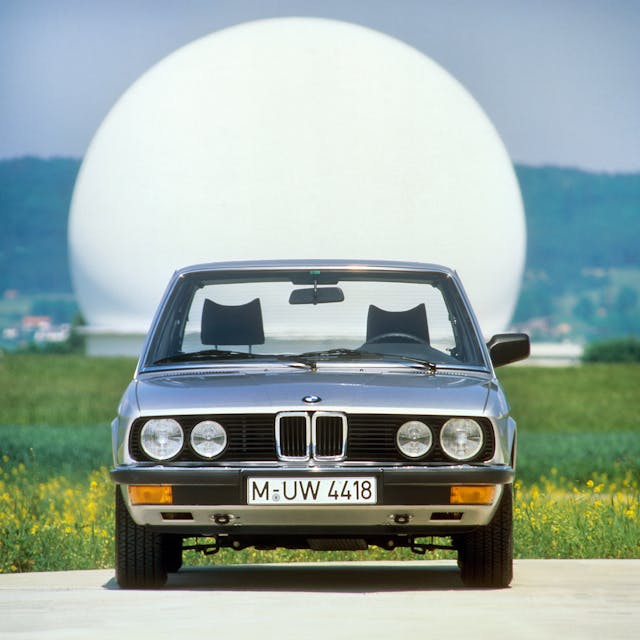
First, an introduction is needed to the Sega employee at the wheel of that BMW 520i. His name is Yu Suzuki, and his influence on video game design over the decades is so vast as to have his Virtua Fighter—one of the first games to use 3D characters—enshrined in the Smithsonian as the only video game on permanent display. But from the very beginning, he never had an interest in playing video games.
“The reason I started making games is I joined a video game company,” Suzuki told Eurogamer in 2015. “That’s it! It’s not like I wanted to be a game designer. I just entered the game company.”
That company was Sega, and Suzuki was about to hand it the first of a series of hit games. After successfully launching a boxing game, he turned his focus on pushing the limits of technology to create a gaming experience faithful to his love of motorcycles. At the time, Suzuki was mostly interested in motocross and Dakar, but he had expanded into watching circuit racing thanks to the success of American racer Freddie Spencer.

Spencer, who was born in Louisiana, started racing for Honda in the late 1970s, and gave the company its first superbike win in 1980. In 1983, he rode a viciously quick two-stroke Honda NS500 to the 500cc Grand Prix world championship, becoming the youngest-ever rider to do so (Marc Márquez would break this record, but not for three decades). The success of a Japanese motorcycle maker on the world stage came with an explosion of growth in new fans of the sport at home in Japan. Suzuki was among them.
His breakthrough arcade cabinet game was called Hang-On, and it was the first of Sega’s “taikan” games. These were a series of games with hydraulically activated controls, where the cabinet would actually move—action not just on-screen, but in real life. In the case of Hang-On, riders sat on a scale-sized motorcycle and leaned into the turns displayed on a screen in front of the handlebars.
Launched in three styles (a rideable bike plus two simplified versions with just handlebars), Hang-On was projected to sell a few thousand units. Instead, it exceeded expectations by four times, and became Sega’s bestseller. Obviously Sega executives wanted Suzuki to make lightning strike twice. He did, and then some.
Originally, the concept behind OutRun was 1976’s Cannonball Run. Suzuki’s plan was to head to the U.S. and drive from California to Florida, noting the terrain he passed through on the way. Instead, Sega sent him to Europe, along with a superior to keep an eye on things, and a video camera to capture the trip.
In that rented BMW, Suzuki and his project manager, Youji Ishi, started out from Frankfurt with no firm directive other than a need to depart from Rome for Japan in three weeks. They drove Germany’s Romantic Road through Bavaria, crossed into France, traveled through Chamonix to Nice and then Monaco.

And it was there, in Monte Carlo, that Suzuki found his hero car. After driving the F1 course, he stumbled across a street-parked Testarossa and instantly knew that this was the perfect fit for his game. On return to Japan, he and a small team of artists tracked down one there and photographed it exhaustively for reference.

All this effort to create a series of pixelated sprites may seem overkill, but game designers were pitting their imagination against the limits of technology at the time. Suzuki wanted the feel of high-speed driving to be as accurate as possible, and the exotic shape of the Testarossa would set things off.
OutRun was released in September 1986. By 1987, it was the highest-grossing arcade game in the world, and Sega’s best-ever performer for the entire decade.
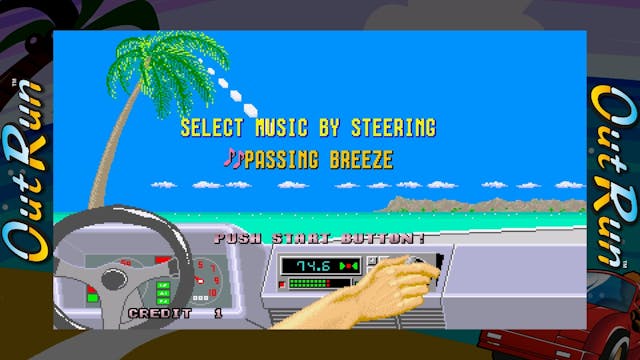
In the game, which features a style influenced by digital artist Hiroshi Nagai, players start off on a California-style stage, just as Suzuki had initially planned for his trip. The terrain then transitions to a more European look, heavily based upon the Romantic Road. Tires screech as the terrain rolls and the scenery blurs past. It’s hardly a simulator, but it’s still a thrill to play even now.



With two knockout hits under his belt, Suzuki was a rockstar at Sega. This was handy, as he was hardly a corporate drone, not the kind to keep to early morning starts and a regimented work week. He formed his own sub-studio, called AM2, away from Sega’s main offices, and he was known for keeping night-owl hours.
Suzuki’s success through the 1980s and 1990s and beyond extended to the point that he was able to buy his own Ferrari, to add to the Ducati and Hayabusa motorcycles he kept in his garage. It wasn’t a Testarossa, but a F355, one of the best-looking cars Maranello ever made.
He would go on to use it to develop another standout automotive arcade game, 1999’s F355 Challenge. This racer was a lot more hardcore simulator than lighthearted OutRun, and it was developed with on-track data collected in Suzuki’s own F355. There are rumors that then-Ferrari F1 racer Rubens Barrichello was so impressed by the game’s accuracy that he even used it to practice a little.

In addition to titles like Daytona and Virtua Racer, F355 Challenge and OutRun cement Yu Suzuki as one of the greatest automotive video game designers of all time, which is to say nothing of the best-selling games in other genres he created. He still says he doesn’t have much time for actually playing games, despite enjoying the work of designing them. He’d rather be riding or driving for real.
But because he tried to make OutRun feel authentic to his genuine passions, Suzuki gave many a kid their first taste of driving freedom. Maybe that kid never grew up to be able to afford a Testarossa, but perhaps an old Alfa Romeo wasn’t entirely out of reach.
So, grab your keys, because that clock never stops ticking. Get out there and hit those checkpoints.
***
Check out the Hagerty Media homepage so you don’t miss a single story, or better yet, bookmark it. To get our best stories delivered right to your inbox, subscribe to our newsletters.
The post A Gearhead Programmer, an Epic European Road Trip, and the Creation of <em>OutRun</em> appeared first on Hagerty Media.
]]>
One of the most notable participants in the 2024 Detroit Autorama is a special Oldsmobile 4-4-2 build packing a rare, experimental V-8 engine. To read about the twin brothers from Detroit responsible for this “Killer” project, click here. What follows is a technical and historical overview of the so-called W-43 prototype.
The mythical Dr. Olds was GM’s self-appointed innovation guru, with mass production, speedometers, front-wheel drive, turbocharging, a diesel V-8, automatic transmissions, anti-lock brakes, and chrome plating to his credit. So it should be no surprise that Olds engineers were pioneers in the movement to cram additional valves into their combustion chambers in pursuit of extra power. Behold, the W-43 prototype engine.
Oldsmobile’s special performance packages were generally coded with the letter W. In the late 1960s, the cause was volumetric efficiency: pumping extra fuel and air into—and exhaust out of—the engine to boost torque and horsepower. Work on the prototype W-43 V-8 shown here—a 455-cubic-inch muscle motor topped with heads sporting four valves per cylinder—began in earnest in the fall of 1967, though some of its technology had been in the engine lab for years.
One-upmanship was clearly at play in the W-43’s genesis. In the mid-1960s, Chrysler’s second-gen Hemi was the scourge of street and oval-track competition. Olds strived to trump Mopar by venturing beyond the Hemi V-8’s two valves per cylinder.


For the four-valve W-43 experiment, of which at least two examples are said to remain, a single chain-driven cam between the cylinder banks activates 16 pushrods. Each rod opens one pair of valves via rocker arms. To optimize this geometry, and to trim the mass of the pushrods in pursuit of super-high-rpm capability, the camshaft is elevated in the block exactly one inch in comparison with the 455 donor V-8.
Instead of Chrysler’s spherical combustion chambers, Oldsmobile used a simpler pent-roof arrangement which tipped valve faces toward the bore’s centerline. Spark plugs are centered to minimize flame travel, a configuration that necessitated sealing tubes in the valve covers. Pistons are domed.

To expedite the development of these new cylinder heads, Olds engineers employed a flow bench that could accurately assess temporary mahogany models. Best results were achieved with 1.75-inch intakes and 1.375-inch exhausts. This yielded a 43 percent increase in valve curtain area—likely the reason that figure was selected for this engine’s code name (curtain area = valve circumference x lift).

The 455-cubic-inch block, which continued 4.125-inch bore and 4.25-inch stroke dimensions, included one notable upgrade: To assure durability, new four-bolt main bearing caps were machined from forged steel.
Test results reported by Hot Rod magazine indicated a peak output of 440 horsepower at 4600 rpm with mild valve timing and a 4×2-barrel induction system. Those figures are modest by today’s standards likely because the engine was measured early in the development process.

The late 1960s were Motown’s horsepower heyday. The Hurst/Olds specials introduced in 1968 are now highly prized collectibles. Olds engineers also built hot marine powerplants and twin-turbo V-8s intended for Can-Am racing. A spinoff design was coded OW-43. Experimental dual-overhead-cam, 32-valve V-8s were also constructed for dyno testing.
Unfortunately, doomsday lurked around the bend. In the early 1970s, the feds tightened emissions standards and OPEC triggered an energy crisis with an oil embargo. Exactly what Olds didn’t need was a V-8 which was heavier, bulkier, more expensive to manufacture, and thirstier than conventional designs.
Thus, the W-43 was shelved and never reached production status.
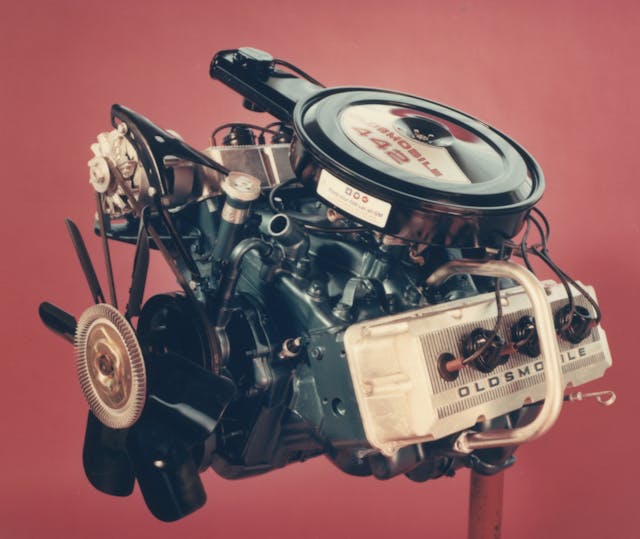
It wasn’t all wasted effort, however, as this fantastic footnote demonstrates: Oldsmobile’s 2.3-liter Quad-Four—produced from 1987 through 2002 and used to power millions of Chevys, Oldsmobiles, Pontiacs, and Buicks—furthered W-43 lessons from the ’60s with the addition of dual overhead cams. The Quad-Four was America’s first four-valve engine as well as the final powerplant wholly developed and manufactured by Oldsmobile.
That legacy also includes an entry in the speed records books. An Olds Aerotech streamliner, powered by a turbocharged Quad Four and driven by A.J. Foyt, topped 267 mph in an epic 1987 measured-mile run at the Fort Stockton Test Center in Texas, seizing the world land-speed record from Mercedes-Benz.
***
Check out the Hagerty Media homepage so you don’t miss a single story, or better yet, bookmark it. To get our best stories delivered right to your inbox, subscribe to our newsletters.
The post Oldsmobile’s W-43 V-8 Engine Was a “Killer” 32-Valve Prototype appeared first on Hagerty Media.
]]>
Back in 1920, an enterprising man out of Statesville, North Carolina named C.H. Turner started a foundry. Being a smart guy in an agrarian place, he punched out a lot of farm implements and milling equipment using a constant supply of scrap metal made available via a rail easement. After World War II, Turner’s foundry focused on making Jeep-ready implements for the budget-conscious farmer. Production later shifted to castings to support the textile industry. And finally, in 2024, some idiot punk started parking strange cars in the foundry, with the adjacent idea of turning it into a clubhouse for his friends.
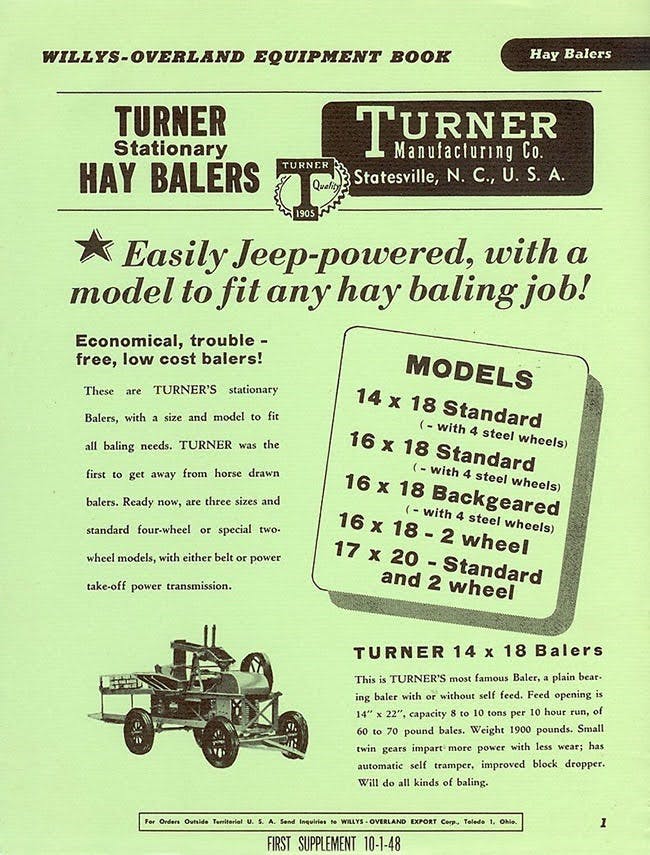
Hi, I’m the idiot. It’s me.
As you may recall, the derelict sock factory that I rent was starting to become somewhat of a headache. I’d put in a ton of work cleaning it up with the hopes it could serve as a suitable storage unit for my many weird cars, but the deeper I got into it, a few things became obvious:
- It would never be mine.
- There was no solid wood in the entire structure.
- The wood floor construction limited vehicle parking significantly.
- It was and always will be a neighborhood hangout for truant teenagers.
My eye was wandering.
While out on a neighborhood stroll, it wandered to a sign in front of the old foundry. My heart started racing like I had, I dunno, just seen an ad for a Lada on eBay Kleinanzeigen or something. I called the agency listed on the ostentatious yellow For Sale sign, fully prepared to hear a completely unobtainable figure. The voice on the other end of the line quoted a price more appropriate for a small bungalow on the shabby side of town. I repeated the number back to her, for clarification. She echoed it back to me, clear as day. Wow.
I looked over at my wife and mouthed the confusingly reasonable sum.
“This is all you,” she said, tugging at the dog.
The TI-83 graphing calculator in my head started summing up the foundry’s indoor and outdoor spaces, and what they could potentially rent for. How cool it would be to have a space where my friends and I could store prospective car projects and work on things in an automotive commune of sorts? This really could work!

While scouting the place out a little more, I noticed that the door of the depression-era brick auto shop across the street was open. I poked my head in. A guy named John came out from behind an old Land Rover Defender 90 and introduced himself.
Good vibes around here, I thought to myself.
John explained all of the recent happenings at the foundry over the past several years, some of them downright odd: inconsistent business flow, pink-painted window frames, and a “Free Hugs” sign zip-tied to the chain link fence. Eventually, the former renters had to be evicted with help from the Sherriff’s Department. The body shop inside the structure ceased to exist. It had since sat empty.
John, a native of Columbia, South Carolina, had been working at his auto shop for 25 years. He and his dog showed us around his various projects. I didn’t really want to waste any more of his valuable wrenching time, so before long we bid adieu and agreed that it would be nice to be neighbors. This, even though he seemed a little confounded about my dreams for the place.
Encouraged by our exchange, I called back the agency and set up a showing ASAP: the next day at 4:00 p.m. The tour started with a walkaround. The facility consists of three-quarters of an acre with a sprawling complex of several conjoined structures. A quick visual inspection showed a new roof and three new roll-up doors. And what’s that out back? Oh yes, a train stop! Back in the foundry days, this place was—and still is—connected to the local scrap yard by rail. Talk about convenience! The rail spur behind the shop floor features an elevated loading platform and a dedicated diversion for the factory. The days of me loading up a hulk and hollering “incoming!” in the direction of the scrap yard are probably far off, but the listing agent encouraged a call to the rail company, Norfolk Southern.

Facing the street is a 1500-square-foot garage area with big casement windows to let in natural light. When the listing agent slid the roller door up, I felt it: this was sh**tbox car heaven.
Well, not yet. A complete furniture set apparently from the lobby of a La Quinta hotel was lining one wall, while dog cages, trash, and a filthy stereo system occupied the rest of the space. On the plus side, the natural light was beautiful, and a wood stove in the corner was sure to work fine. Cozy morning wrenching did not seem far off. Dumpster first, dreams later.

The “garage room” feeds into the main shop floor of the foundry, all 12,000 square feet of it. With some of the panes having been shot out by local vandals, water had pooled in some areas following five inches of recent winter rain. It’s also possible that the open chimney of the smelter was funneling water in. (Bargaining point noted.) On the other hand, a pair of old Chevrolet trucks and heaps of old equipment and tools left in the facility could provide several weekends of quality entertainment. We followed a wobbly staircase up to a relatively nice loft, complete with empty water bottles and broken grow lights. It started to make sense why power had been physically cut to the property and the cops got involved.

Upon analysis of the facts at hand, it was clear to me: It was perfect!
Still, aiming to keep a cool head, I took the weekend to really think it over and crunch numbers. Given the age of the structure, many potential hurdles came to mind: financing, contingencies, inspections, incorporation, environmental baggage, insurance, security, maintenance… it was enough that my sleep suffered tosses and turns. In the morning, my engineering brain pleaded that I create a spreadsheet. Once the numbers made sense, I stopped by a nearby bank; locals were fond of the structure, and the people I met with were more than happy to loan on the property, provided a few conditions were met. (Most of these were already on my list).
I’ll spare you the gory details about weeks of environmental research, report writing, appraisals, and insurance quotes. Suffice to say, it all worked out. As of writing, we’re under contract, and by the time you read this, we’ll be just about closed, provided nothing goes sideways.
As soon as I e-signed the paperwork, I let loose in the group text chat with my car friends. Moments later, someone had volunteered up a Webb 2S mill (a Taiwanese Bridgeport copy) for donation. Many cohorts expressed interest in renting space in exchange for money, help, or both. Soon, my Holden, Studebaker, pair of Citroën Amis, Hobby 600 spaceman/motorhome, Moskvich, and whatever else I end up with will soon have a home. They’ll all soon have roommates, too. My foundry/car commune is imminent!

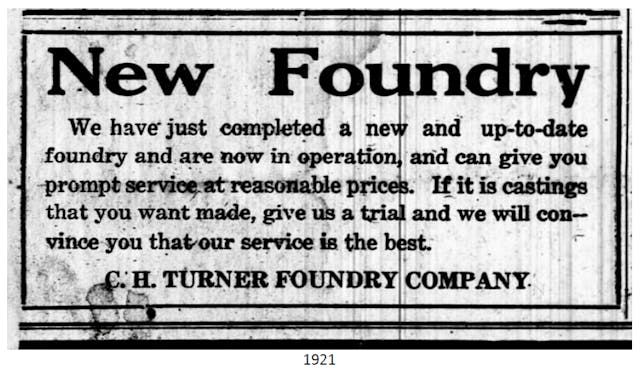












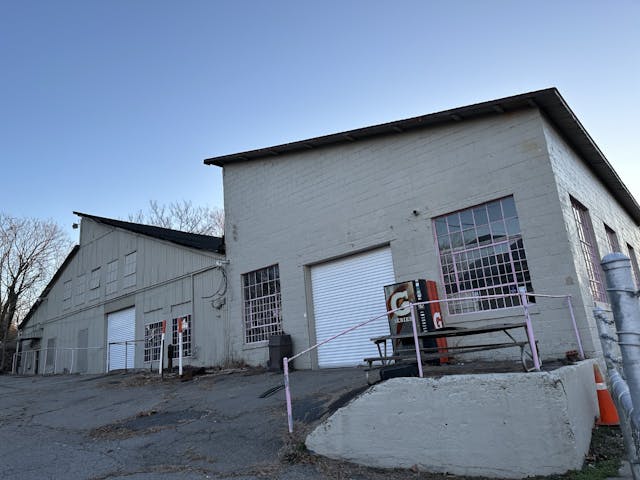








The post Car Storage Part 3: Sh**box Heaven in an Empty Foundry appeared first on Hagerty Media.
]]>
Fifty years ago today, on February 21, 1974, National Hockey League star Tim Horton was killed when he lost control of his DeTomaso Pantera and crashed in St. Catharines, Ontario. His death sent shockwaves through the sports world, particularly in Canada, where he was hockey royalty. Thirty years passed before details of Horton’s autopsy were released and the public learned exactly what happened to Horton. Today, most remember the Hockey Hall of Famer as the namesake of a massive doughnut café empire, which he founded with a business partner 10 years before his death.
***
It was the summer of 1972, and Miles Gilbert “Tim” Horton was considering retirement. Again. After more than two decades in the National Hockey League, mostly with the Toronto Maple Leafs, his 42-year-old body had taken more than its share of abuse. The star defenseman was also so nearsighted that he joked he might not see a puck quickly enough to avoid taking a shot to the head.
Horton had been “quitting” since 1969, and he had once again planned to retire after 1970–71, but thanks to a former teammate, Red Kelly, who was then coaching in Pittsburgh, he was persuaded to join the Penguins for the 1971–72 season. That decision didn’t end well, as a broken ankle and shoulder separation limited him to only 44 games. So Horton was back in a familiar situation, wondering if it was time to hang up his skates and devote all of his time and energy to his budding doughnut business.

Then the Buffalo Sabres came calling. Former Leafs’ general manager Punch Imlach, at that point GM of the Sabres, desperately needed some star power—a grizzled veteran who could help shepherd a young team—and the four-time Stanley Cup champion filled the bill. Buffalo owners Seymour and Northrup Knox made Horton a deal he couldn’t refuse: $100,000 for the 1972–73 season, a nearly unheard-of salary at the time (well over $700K today). It was a successful partnership for both sides; Buffalo made the playoffs for the first time, and Horton was named the team’s MVP.


Horton made it clear afterward, however, that he was done. Imlach would have nothing of it. He offered Horton $150,000. Horton agreed to come back again if he was also given a DeTomaso Pantera—the radically styled, Italian-built coupe powered by a Ford V-8—as a signing bonus. Horton received the Pantera from Gateway Lincoln Mercury (at a cost of about $17,000) and the deal was done. Horton often drove the white Pantera the 100-mile route on Queen Elizabeth Way (the QEW), back and forth from Buffalo to his home in suburban Toronto.
Midway through the 1973–74 season, the Sabres were struggling to find the same success as the previous year. On February 20, 1974, the team traveled to Toronto to play Horton’s former club at the famed Maple Leaf Gardens. Instead of riding on the bus with his Buffalo teammates, Horton drove his Pantera.
Although the 5-foot-9, 210-pound Horton was known for his toughness—Detroit Red Wings superstar Gordie Howe once called him “the strongest guy in hockey”—he was unable to finish playing in the Sabres’ 4-2 loss to the Maple Leafs. During practice the day before, Horton had taken a puck to the jaw (perhaps fulfilling his earlier prediction regarding his eyesight), which left his face swollen and bruised. Regardless, he wanted to play in Toronto, since his friends and family would be in attendance, including his wife Lori and their four children. Early in the third period, however, the pain became too much for Horton to bear.

Afterward, Imlach chatted with the all-star while the rest of the Sabres boarded the bus. Imlach said Horton felt that he’d let the team down.
“He was hurting too bad[ly] to play a regular shift in the third period. We faded without him and lost …,” Imlach said, according to Bleacher Report. “After the game, he and I took a little walk up Church Street and had what was our last talk. He was down in the dumps because he didn’t like to miss a shift, and he felt he had cost us the game. I got on the bus with the team [and] Tim drove the cursed car back to Buffalo. He didn’t make it.”
The “cursed car” was Horton’s 1972 Pantera. As everyone knew, Horton liked to drive it aggressively and fast.

According to the Ottawa Citizen newspaper, Horton left Maple Leaf Gardens and met with his business partner, Ron Joyce, at the Tim Donut company office in Oakville, about 23 miles southwest of Toronto. “Tim was sitting in our office, his coat on, an ice pack wrapped around his jaw, his driver’s gloves on,” Joyce recalled in Open Ice: The Tim Horton Story, a 1994 biography by Douglas Hunter. “He was sitting in the dark with his feet up on the table, with a vodka and soda in his hand.”
Joyce later claimed that his friend didn’t consume enough at the time to get drunk. Others thought differently. At approximately 3:00 a.m. on February 21, Horton called his wife and his brother, Gerry. Lori Horton wrote in her 1997 book, In Loving Memory: A Tribute to Tim Horton, that “Gerry recognized Tim had been drinking, and he tried to convince him to stay where he was.”
The Ottawa Citizen wrote that there were conflicting accounts about whether Horton planned to drive to Joyce’s home in nearby Burlington to spend the night or continue to Buffalo. Ultimately, he chose to drive.
According to Open Ice, Joyce saw Horton take a handful of painkillers before he sped off in the Pantera, reaching an estimated speed of about 175 kilometers per hour (110 mph) on the QEW. The Ottawa Citizen reported that a motorist near Burlington alerted police to “a sports car driving dangerously fast.” When Horton roared into St. Catharines around 4:30 a.m., a police officer was waiting in his cruiser, but Ontario Provincial Police Constable Mike Gula said he couldn’t keep up with the Pantera.

“I saw him go by and took off after him, but I never caught him,” Gula later told the media. “As far as I’m concerned, he didn’t know he was being chased. I was doing over 100, but I lost sight; I never got close. A few minutes later I came [upon] the accident scene.”
Horton, who was not wearing a seatbelt, had been thrown from the vehicle. Gula found him in the grass median of the divided highway. He was still wearing the brown checker top coat, yellow sports coat, yellow shirt, brown pants, and brown boots that he was wearing when he left Maple Leaf Gardens that night.
Horton, 44, was declared dead on arrival at St. Catharines General Hospital at 4:50 a.m. Police found the phone number of his coach, Joe Crozier, inside his wallet, so Crozier was the first to learn the news.
“When they called me to come down and identify the body, I couldn’t believe that this could ever take place,’’ Crozier recalled. “When I lost Tim Horton, damn it, I lost my heart.’’
So did Imlach, who never forgave himself for agreeing to buy Horton the Pantera.

An autopsy, released in 2005 in response to a Freedom of Information request from the Ottawa Citizen, revealed that Horton had died of a broken neck and fractured skull. And although the Citizen wrote that hospital officials claimed at the time that “there were no contributing factors, and that no inquest was required”—perhaps to protect the star’s legacy—documents showed that Horton had a blood-alcohol level well beyond the legal limit and also had prescription drugs in his system.
A broken bottle of Smirnoff vodka was found at the scene, and Horton’s pockets contained five tablets of Dexamyl, a sedative, and two tablets of Dexedrine, a stimulant.
Horton’s Pantera was first transported to Simpson’s Towing Yard in St. Catharine and examined by police (and dozens of curious fans). According to the Ontario Provincial Police report, it was released to Grant Collision in Toronto on March 29, 1974. Salvage price was listed as $500 CAD. Speculation was that the car was destroyed, but the St. Catharines Standard recently reported that the engine, at least, was purchased by race car enthusiast Don Alexander, who converted Horton’s V-8 into a stock car engine and installed it into a 1973 Ford Mach 1 Mustang.
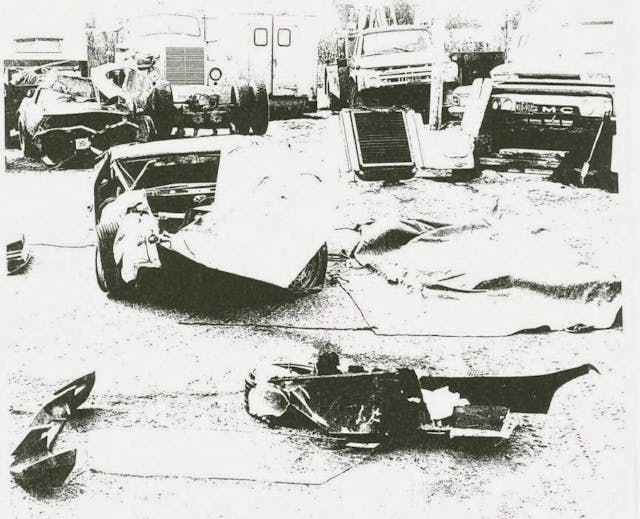
At the time of Horton’s death, there were approximately 40 Tim Hortons restaurants in Canada. Today there are some 5700 locations in 13 countries. According to the CBC, in 1975 Horton’s widow sold her husband’s half of the business to Joyce for $1 million CAD and a Cadillac Eldorado. Lori Horton later sued to get her half back, but her request was denied in court. She died of a heart attack on Christmas Day, 2000.
As for Joyce, in 1996 he sold the business to Wendy’s International in a deal worth $400 million CAD. In 2014, Tim Hortons was purchased by Burger King for $12 billion CAD ($11.5 billion USD). Joyce died in 2019.
Fans of Tim Horton lament the fact that he is better known today for donuts and coffee than for hockey. In the years since his autopsy report was released, however, Horton’s passing has also become an unfortunate, tragic example of the dangers of driving under the influence. Forever beloved as an athlete and businessman, his legacy endures, and his death serves as a “where were you when?” moment, especially for Canadian hockey fans.
***
Check out the Hagerty Media homepage so you don’t miss a single story, or better yet, bookmark it. To get our best stories delivered right to your inbox, subscribe to our newsletters.
The post 50 Years Ago, Tim Horton Lost His Life Driving a Pantera appeared first on Hagerty Media.
]]>
General Motors was one of the most innovative vehicle manufacturers in the world for many decades, giving us the first genuinely successful automatic transmission, powerful and cheap V-8 engines for the masses, leading-edge touchscreen interfaces, head-up displays, and the first production overhead-cam engine with a timing belt. With all that, though, European manufacturers became better-known for their technologically advanced and futuristically styled machinery by the 1980s, and GM needed to catch up. What better way than by designing a gorgeous two-seater to be hand-built by the Buick Division’s most experienced workers? This was the Buick Reatta. I found this well-preserved example in a Northern California car graveyard.

The Buick Division had to work with the platforms it had on hand for the Reatta, and its front-wheel-drive chassis was based on one borrowed from the Buick Riviera/Cadillac Eldorado/Oldsmobile Toronado and then shortened a bit.

The 1988 and 1989 Reattas came with the radical Electronic Control Center touchscreen interface as standard equipment. This system was based on cathode-ray-tube hardware sourced from an ATM manufacturer and required 120VAC power behind the dash. It was decades ahead of its time.

Unfortunately, the traditional Buick-buying demographic at the time wasn’t very enthusiastic about electronic gadgets or two-seaters in general. Meanwhile, prospective buyers of BMWs, Audis, and Mercedes-Benzes who might have been lured into Reatta purchases were put off by the pushrod Buick V-6 under the Reatta’s hood; while a reliable and reasonably powerful engine, its ancestry stretched back to the 1961 Buick 215 V-8 and it was decidedly less sophisticated than the double-overhead-cam engines coming from Europe at the time.

The only transmission available in the Reatta was a four-speed automatic, which probably wasn’t as much of a sales limitation as the old-timey engine.

Still, it was a beautiful and luxurious car and deserved a better sales fate than what it got. This one looks to have been in good shape when it ended up in its Final Parking Space.
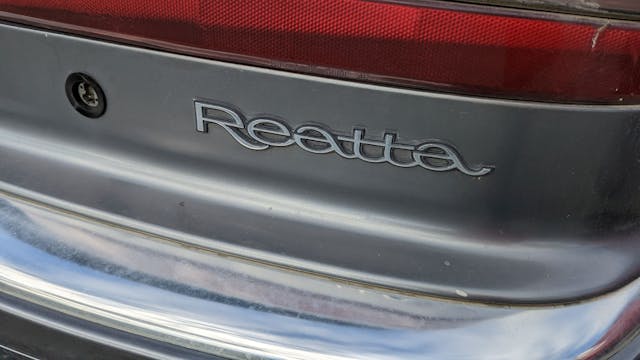
Let’s hope that local Reatta fans harvested all its good parts before it went to the crusher.















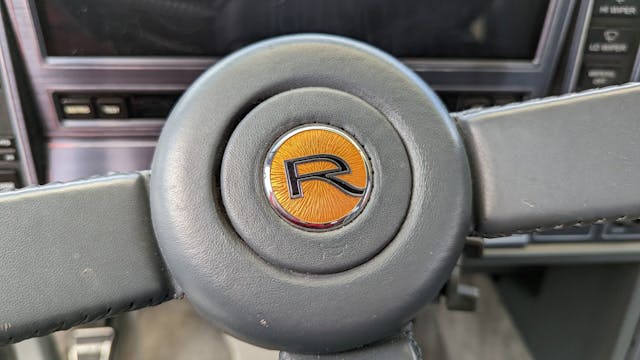

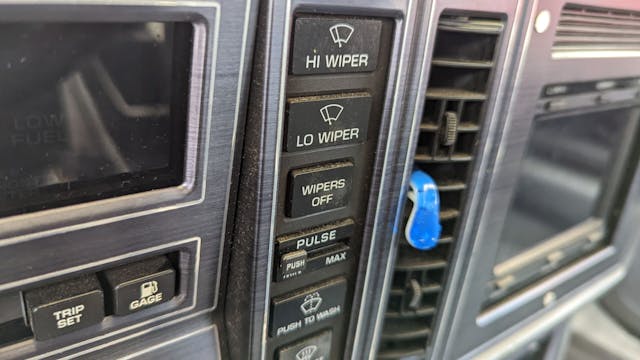


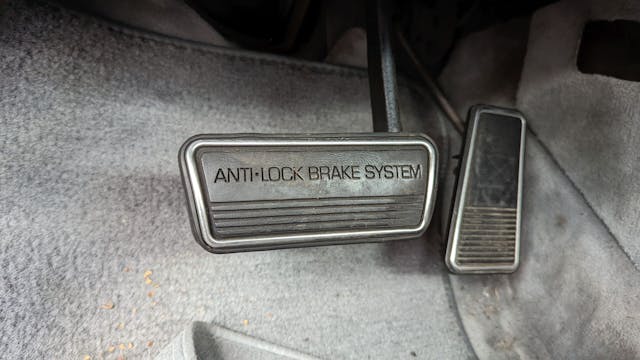

***
Check out the Hagerty Media homepage so you don’t miss a single story, or better yet, bookmark it. To get our best stories delivered right to your inbox, subscribe to our newsletters.
The post Final Parking Space: 1989 Buick Reatta appeared first on Hagerty Media.
]]>
In case you were unsure whether a car can turn into a plane, we refer you to assassin Scaramanga’s escape in a flying 1974 AMC Matador in the classic Bond flick The Man With The Golden Gun. Fans of the 24 Hours of Lemons budget racing series will know about the zany “Spirit of Lemons” build—the body of a Cessna grafted onto the chassis of a 1980s Toyota Space Cruiser van. However, we are aware of only one instance of a plane that was turned into a car, only to then turn back into a plane. For those knowledgeable about both planes and cars, it will come as no surprise that this is a story about Bristols.
Even British car enthusiasts might only be somewhat aware of Bristol as an automotive manufacturer, as it was always a low-volume producer. What was technically the company’s first car arrived between the wars, but the Bristol Monocar was more a motorcycle than a proper automobile. After the war, however, Bristol built relatively quick and luxurious cars aimed at the well-heeled set.
The parent company of Bristol Cars was the Bristol Aeroplane Company and, in aviation circles at least, it is much better known. Bristol’s aviation efforts include some of the most important British aircraft to fight in WWII—fighters and bombers that were arguably as important to the war effort as the Hawker Hurricane and the Spitfire.

Of particular note is the twin-engined Bristol Blenheim, the backbone of the RAF’s bomber force. It was just fast enough to serve as a night fighter above England, protecting her cities and factories from the Luftwaffe’s aerial Blitzkrieg. First flown in 1935 as the type 142, the Blenheim proved faster than any fighter aircraft currently in the RAF at the time. This performance spun the props at the U.K.’s Air Ministry, who promptly ordered 150 of the aircraft. In total, 4400 Blenheims would take to the air. Only one still does.
Before we get to that extant aircraft, first we must witness the service of Bristol Blenheim Mk.1 L6739, which entered the RAF fleet on the second of September 1939, the day after WWII began. It was assigned to No. 23 Squadron: the Night Fighters.
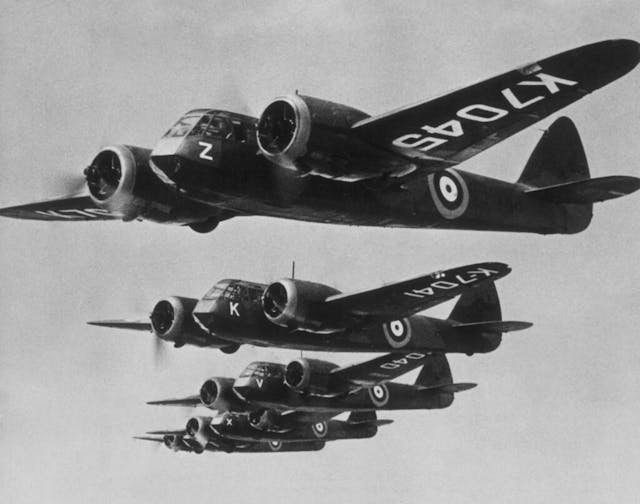
With the fitment of four Browning .303 machine guns in a gun pod, L6739 was upgraded to a Blenheim IF. Despite having the necessary firepower to shred a Heinkel into hamburger, these early Blenheims were not a complete success as night fighters. Twin radial engines produced over 800 hp each, but even this just barely gave the Blenheim the speed to catch the Luftwaffe’s bombers. L6739 fought hard but retired in 1940 after a little over a year’s service as the speedier DeHavilland Mosquito entered the fray.
Sent back to Bristol Aircraft, the airframe sat in the scrapyard as surplus. Nothing had been done to it by the time the war ended, at which point there were, of course, plenty of aircraft lying around all over the place. Seeing as it was just sitting there, a Bristol employee named Ralph Nelson decided he would build something out of it.

Nelson was a Class A example of what can only be described as “British Man With Shed.” This scrappy species (homo shedien) is responsible for everything from the founding of Lotus to the creation of the 27L Merlin-engined Beast that sold recently at auction. Brits can be inveterate tinkerers and inventors, occasionally of the Jurassic Park “so preoccupied with whether or not they could, they didn’t stop to think if they should” variety.
Nelson took the short-nosed front cabin of the Blenheim, notorious for being hard to climb in and out of, and placed it on the chassis of an old Austin 7 he had lying around. He built a rear-hinged driver’s door for it, folded the rest of the sheetmetal into an egg-like profile, and then—to make things even weirder—he fitted an electric motor of his own creation as a motive unit. Then he road registered it as a “Nelson” with the license plate JAD347.
This homemade #car is #quirky even by our standards We know nothing about it but assume from the number plate that it was #UK registered from the #1940s/#1950s The front looks like it’s from an #aircraft pic.twitter.com/QLo55b57kc
— Quirky Rides (@QuirkyRides) October 22, 2020
Nelson drove his eponymous airplane-based EV for around a decade, getting one of the U.K.’s windshield-mounted tax discs each year. However, sometime in the mid-1950s, the car suffered a small fire that fatally damaged its running gear. He never got around to repairing it.
***
This brings us to a second Blenheim or, more properly, the Canadian-made copy known as the Bolingbroke. G-BPIV entered service in 1943, flew for three years, and then was put out to pasture after the war ended.
Canada’s contributions to the allied war effort, particularly as part of the U.K. Commonwealth, extended to more than troops. As previously covered, Canadian factories built many of the Hawker Hurricanes that fought against Messerchmitts diving out of the sun, and the Canucks also built most of the heavy trucks that replaced the materiel lost by the British Army at Dunkirk.

Allied bomber aircrew training was also a huge part of the Canadian effort, and inadvertently led to the rise of many postwar sportscar racing clubs. In many cases, the airfields built for training had to be constructed quickly, so there wasn’t time for proper surveys of wind conditions. Runways were thus often built in overlapping triangles, and when they sat disused after the war, they were the perfect arena for amateur circuit racing. It’s why the Gimli Glider nearly crash-landed on top of an autocross.
(One more piece of Canadian bomber training history that I can’t help sharing: if you visit the Bomber Command Memorial in Alberta, the crew pictured is led by F/L Robert Clothier, DFC. If you’re Canadian, you might know him better as Relic from The Beachcombers.)
The Canadian-made Blenheim was shipped to Scotland in the mid-1980s, where it was put in a museum collection. Later, it was sent to an aircraft restoration company near Cambridge, where it was completed in the style of a later, long-nosed Blenheim Mk. IV. It took its maiden flight in 1993.
However, in 2003, it crashed after a demonstration flight and was damaged well beyond airworthiness. A huge restoration effort was mounted (some 25,000 volunteer hours) and the decision was made to try to show the Blenheim as it was in its earliest fighting days. The only question was where to procure a correct short-nose cockpit.
As it turns out, Ralph Nelson had heard of the original 1990s restoration program and donated his car to the cause. Being an ex-Bristol man, he had taken great pains to preserve all the original control gear during the conversion to car, so the restoration team had very nearly a full set of everything they needed. They set to work.
At the End of the War Bristol Aircraft Factory worker Ralph Nelson used this Mk1 Blenheim cockpit to make an electric car that he drove around the City for 10 years.
It is now the cockpit of the restored and only flying MK1 Blenheimpic.twitter.com/PFa46lluWK
— Tony Brown (@agbdrilling) February 15, 2019
Bristol, as a car company, first brought elements of BMW back to the U.K. as part of postwar reparations, with the 400 even having a twist on the BMW twin-kidney grille. Later came Chrysler-sourced V-8s and luxurious but muscular GTs in the same general vein as the Jensen Interceptor. The Bristol 603 of the late 1970s was called the Blenheim, in a nod to its aviation heritage, and another Bristol Blenheim coupe emerged in the 1990s.
There is also a plan to bring back the Bristol marque as (of course) a manufacturer of luxury EVs. While details are thin, the plan is for a four-seater battery-electric car to be announced in 2025. Given the work of Ralph Nelson, such a vehicle wouldn’t be entirely out of character for the brand.
But for now, should you see L6739 at its home base in Duxford, Cambridgeshire, or perhaps on display at the Goodwood Revival, where it has won several prizes over the years, look closely to see an unusual detail. Not only is this the only airworthy Bristol Blenheim left in the world, but also, in tribute to Ralph Nelson, it is also the only one to display a U.K. road-tax disc in its window.

***
Check out the Hagerty Media homepage so you don’t miss a single story, or better yet, bookmark it. To get our best stories delivered right to your inbox, subscribe to our newsletters.
The post The Plane That Became a Car That Became a Plane Again appeared first on Hagerty Media.
]]>

You may have heard about Fordlândia, Henry Ford’s hubristic attempt to start a prefabricated company town and rubber plantation in the Amazon rainforest of Brazil to supply Ford Motor Company with rubber, getting around a British monopoly on natural rubber. Planned for 10,000 residents, construction on Fordlândia was begun in 1926. The town included American-style houses, a school, hospital, library, and hotel as well as recreational facilities including a swimming pool, a playground for children, and a golf course for the adults. Residents were expected to live their lives the way Henry Ford expected them to live.
The plan began with great fanfare with the Brazilian government granting the automaker approximately 5000 square miles of land for the project, but Mr. Ford abandoned his eponymous Brazilian town less than 10 years later in 1934.
While the notion of a “company town” today seems quaint, archaic, and even exploitative, they were not uncommon in the 19th and early 20th centuries, and Fordlândia was not Henry Ford’s only attempt to create a self-contained Ford community. Interestingly, he also located another Ford company town in another remote forest, far from the nearest city. It was, however, a bit closer to FoMoCo headquarters in Dearborn than Brazil. Alberta, Michigan, located northwest of Marquette in Michigan’s Upper Peninsula, is about 500 miles from Detroit. Unlike Fordlândia, which became a ghost town, Ford’s Alberta operations continued for decades, and the small community that he built there still exists—as does the sawmill that Ford built there to employ the town’s residents.

It was natural for Henry Ford to look north for wood. Michigan is well known as the location of the Motor City, but less well known is the fact that Michigan was the leading U.S. producer of lumber from 1860 to 1910. By the turn of the 20th century, over 160 billion board-feet of lumber was harvested from Michigan forests. That’s a lot of White Pine. (I use the term harvested rather than logged because much of the state’s forest was clear-cut.) While northern Michigan is heavily forested today, with four national forests there is very little *old-growth timber left.
Ford had massive land holdings in the U.P. for his lumbering operations that supplied the wood needed to build Ford cars. It’s estimated that each Model T required about 100 board-feet of lumber in its production, and wood was also needed for “woodie” station wagon bodies, as well as crates for Ford-produced parts. To supply that lumber, Ford Motor Company had large, industrial-scale sawmills in Pequaming and L’Anse in the U.P. as well as a wood processing factory in Iron Mountain that employed as many as 7000 workers. The sawmill at Alberta, in contrast, was a much more modest operation, and the town was only planned for hundreds of people, not thousands, with lots platted out for just 70 homes, only 12 of which were completed. Also more modest than Fordlândia was the fact that Ford named Alberta not after himself but after the daughter of his head of northern Michigan operations.

So why did Henry Ford build Alberta if he didn’t really need it’s lumber output? The answer is in the archives of Michigan Technological University, to which Ford Motor Company donated the mill and town in 1954 when production at the sawmill stopped. MTU continued to operate the sawmill as part of its forestry and lumbering programs and turned the town into a conference center. The archives of the town show that, like Fordlândia, it was as much a social experiment as it was an industrial operation. Alberta was part of Henry Ford’s “Village Industries” program. In the 1920s and ’30s, he set up about 30 small factories for making small parts and tools, mostly at mill and dam sites on rivers in small towns in Michigan (Ford was a fan of hydroelectric power, which he called “white coal”). Ford was a farm boy at heart and part of his idea was to provide seasonal employment for farmers so they would not be in financial risk of losing their farms.

Unlike most of the Village Industries sites, which were often repurposed mills, Ford built Alberta from the ground up. He had the Plumbago Creek dammed to create a 20-acre lake for supplying the sawmill and town with water. A large metal sign with the Ford script logo still sits on the north bank of the lake, a waymark for northbound visitors on their way to the Huron Mountains or “copper country” in the Keweenaw Peninsula . The sawmill, pumphouse, and town were located on the other side of US-41. In addition to the town residents’ need for water, the pumphouse supplied water for the sawmill’s boilers (the mill originally ran on steam power but was later converted to electricity) and for the small, heated holding pond used to convey logs into the mill.

Coincidentally, the sawmill at Fordlândia is one of the few original structures there that still stands, so that’s another commonality between the two sites. Another similarity is that for someone who was raised on a farm, Henry Ford wasn’t very good at picking places to grow things, as you’ll learn below.

Unlike Fordlândia, however, Alberta is not a ghost town. All of the original structures are intact and the little town still has residents. Three-quarters of the homes that Ford built are long-term rentals, while the remaining four domiciles are used to house conference center visitors or lodgers looking for an alternative to hotels or Airbnbs.

The sources agree that Alberta was named after the daughter of the manager of Ford’s Upper Peninsula operations, but it’s not entirely clear if that was Frank Johnson, or his predecessor, Edward Kingsford, who built Ford’s large factory in Iron Mountain.

The sawmill started operations on September 1, 1936. When operating at full capacity, while modest compared to Ford’s other three U.P. sawmills, the Alberta mill could produce 14,000 board-feet-per-day of hardwood and more than 20,000 board-feet-per-day of softwood that was used in the manufacturing of Ford automobiles. However, the first lumber that was milled there didn’t go into making Ford cars but was rather used to build the first houses in Alberta. A small neighborhood was constructed, including sidewalks and streetlamps. Two small schoolhouses were also constructed.
As with Ford’s other northern Michigan lumbering operations, the Alberta sawmill recycled. Bark, trimmings, and scrap wood were used to fire the boilers that heated the holding pond and originally provided steam power, and a clever gravity-fed system collected virtually all of the sawdust that was created, and a conveyor belt carried it from the mill’s basement to the boilers. That system not only kept the mills relatively clean, it also helped prevent fires from the highly flammable saw dust and powder.

Ford wanted Alberta to be a self-contained town, but it could never achieve that goal because it lacked the things that make a town. Oddly, for a company town, there were no stores, not even the kind of company-owned store that contributed to company towns’ exploitative reputation. Though they were likely planned, a church, bank, clinic, or post office never existed in Alberta either. Residents had to leave Alberta to buy basic goods, cash their paychecks, receive treatment from a doctor, or mail a letter.

Ford allocated some of his timberlands to the Alberta project. The idea was that each worker would have access to a 60-acre woodlot that they would log to supply the mill with timber, as well as a smaller two-acre plot for farming food. That way the workers would have the job security of winter logging, summer farming, and working in the mill. Henry also wanted the public to see a working mill and his ideal community. Period signs for the facility adjacent to US-41 say “Visitors Welcome.”

As with many of Henry Ford’s plans (like the backup diesel generators the Village Industries plants used when hydro power wasn’t sufficient) things didn’t work out as planned. It quickly became obvious that the mill workers could not produce enough logs from their woodlots to keep the mill operating all year, and Ford Motor Company started using outside suppliers and its own logging operations to feed the Alberta facility. As for farming, just as Fordlândia’s location wasn’t ideal for growing rubber, the Alberta area’s soil had trouble sustaining food production, and Northern Michigan’s huge deer population feasted on what little could be grown.

By the time domestic automobile production resumed in 1945, after the end of WWII, the use of wood in car production had plummeted. While Ford continued to build “woodie” station wagon bodies at Iron Mountain, the company had little need for the Alberta sawmill’s output. Also, Alberta’s patron, Henry Ford himself, passed away in 1947. As with other Village Industries sites, it was his pet project, and it didn’t really matter if it was profitable for Ford Motor Company or not—at least while he was still alive. By 1954, Alberta had lost both its need and its patron, and Ford closed the mill on June 30th of that year. Five months later, the Ford Motor Company deeded the sawmill, houses, schools, and over 1700 acres of forest to the Michigan College of Mining and Technology in Houghton, now Michigan Technological University. Michigan Tech renamed the site the Ford Forestry Center and built additional structures. Today, Alberta houses the school’s experimental research station, educational laboratory, learning center for MTU’s School of Forestry and Wood Products, and a small conference center. The sawmill continued to operate as a learning laboratory for decades.

In 1997, Ford Motor Company donated $100,000 to be used to restore the mill as a museum and interpretive center for the public, reviving one of Henry Ford’s original plans for the site. A consortium of MTU faculty and staff, retired Ford employees, and local sponsors started the restoration project and prepared exhibits, however because of possible liability and the state of the sawmill’s lighting, walkways, and electrical systems, the facility doesn’t meet current year standards for visitor safety and the museum is closed to the public.
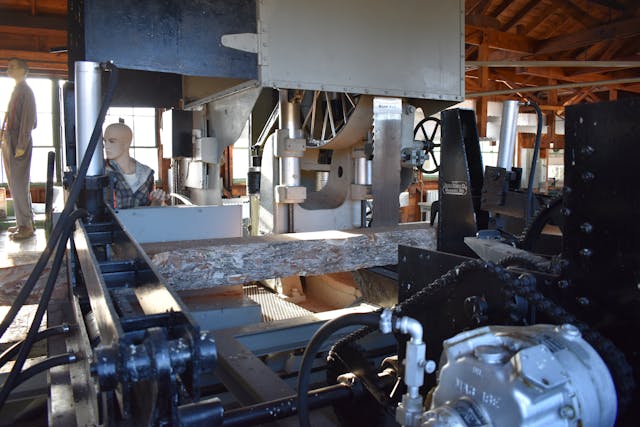
Though Ford stopped operating the mill in 1954, Alberta, unlike Fordlândia, never became a ghost town. All of the original Ford structures are still intact and in use. While the museum is closed to the public, there is a gift shop with memorabilia available for purchase in the adjacent pumphouse.

The sawmill is also closed to the public, but Ford Center operations manager Jim Tolan graciously gave Hagerty access, along with a personal tour, so that we could collect photos and video.

In 2022, MTU announced that it was considering tearing down the old sawmill, as the building is starting to deteriorate from the elements. Though the main building with post-and-beam construction is still structurally sound, “good bones” as they say, there are a couple of leaks in the metal roof and it could use a sensitive restoration. Reopening the museum is probably not practical, as it would require substantial period-incorrect renovations to meet current standards for visitor safety but it would be a loss to history if the facility was demolished. Old industrial sites typically get redeveloped so there are very few still-extant pre-WWII factories whose buildings are in original condition, let alone still being fully functional with all machinery intact. Besides being an important artifact of general industrial history, the Ford Alberta Sawmill sits at the nexus of what have likely been the two most important industries in Michigan’s state history, lumber and automobiles.
The announcement about the possible demolition galvanized a coalition of activists, including students, faculty, and staff at MTU, area residents, and Michigan history buffs that so far has persuaded the university to put off any immediate plans to tear down the mill.
If you’d like to visit Alberta, it’s about 60 miles west of Marquette and about 70 miles north of Iron Mountain.
*If you’re in northern Michigan and you’d like to see some of the remaining old-growth forest that fed mills like Alberta’s, much of what remains has been preserved in state and national parklands and is accessible to visitors.















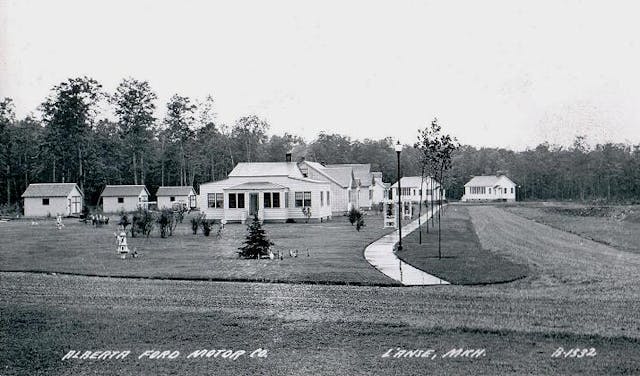


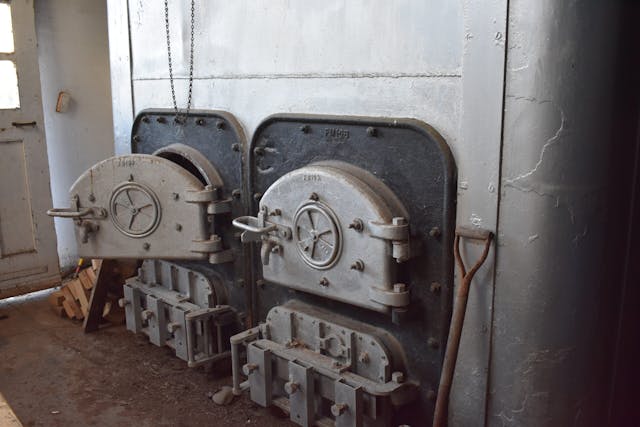





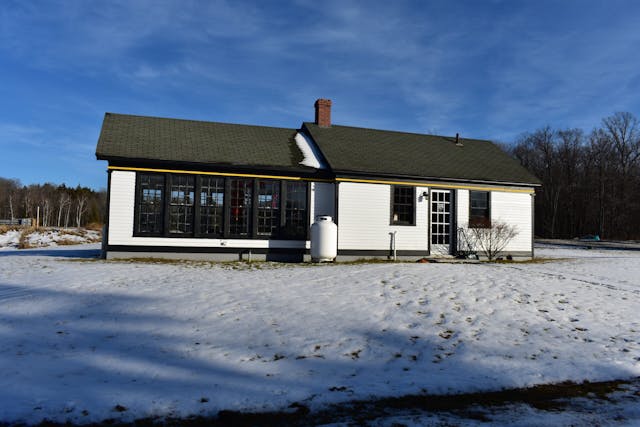



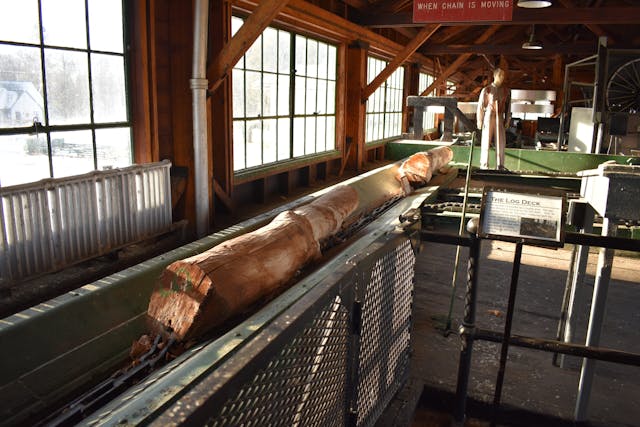














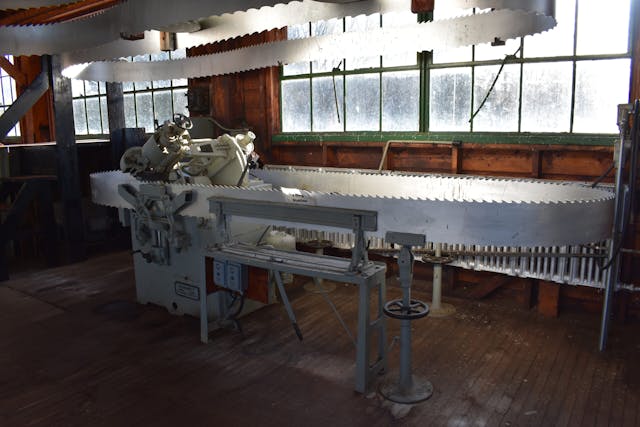
























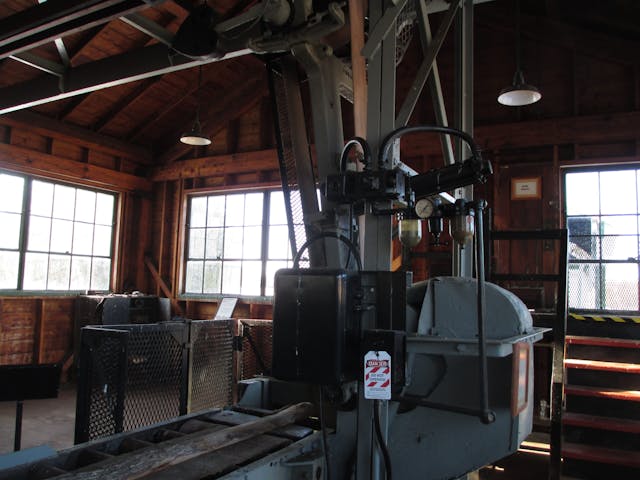






The post Alberta, Michigan: Henry Ford’s Northwoods Fordlândia appeared first on Hagerty Media.
]]>
As the first-generation Mustang got bigger, heavier, and more expensive with each passing year, Lee Iacocca (who became president of Ford in 1970) decreed that a smaller second-generation model would be developed. This car, the Mustang II, first hit showrooms as a 1974 model, which turned out to be absolutely perfect timing after the OPEC oil embargo of October 1973 caused fuel prices to go through the roof. Here’s one of those first-year cars, found in a Denver-area self-service yard recently.

The original Mustang was designed as a sporty-looking commuter based on Ford’s smallest North American–market car of its time, the Falcon. The second-generation Mustang was based on a platform derived from Ford’s smallest North American–market car at that time: the Pinto.

This adaptation made sense from an engineering standpoint, since the Pinto used a modern lightweight design and was set up to use efficient engines from Ford’s European operations. The Mustang II’s chassis differed from the Pinto’s in significant ways—the most important being the wheelbase, which was longer—but the idea of a Mustang that shared ancestry with a tiny economy car originally designed to compete against the likes of the Volkswagen Beetle and Toyota Corolla caused—and still causes—discomfort to some enthusiasts.

None of this really mattered in the American Ford showrooms of 1974, where the Mustang II was an instant success. Sales of the 1974 Mustang were nearly triple those of the 1973 model, and they remained respectable throughout the Mustang II’s production run from 1974 to ’78. Some Mustang II sales may have been cannibalized by Ford’s own Capri, which was badged as a Ford in its European homeland but sold through Mercury dealers (without Mercury badging) in the United States; the Capri was a few hundred pounds lighter and shared the inline-four and V-6 engines used by the Mustang II.

The 1974 Mustang II was available with a choice of two engines: a 2.3-liter, single overhead-cam four-cylinder and a 2.8-liter pushrod V-6, both designed in Europe and both destined for long and successful careers in the global Ford Empire. This car has the 2.3.

This engine was rated at 85 horsepower, while the V-6 made 105 horses. Power numbers were down across the board for new cars sold in the United States when this car was built, due to stricter emissions and fuel-economy standards plus the switch from gross to net power ratings that had been mandated a couple of years earlier. Even so, the 2.3-powered 1974 Mustang II had a better power-to-weight ratio than the 1973 Mustang with the base 250-cubic-inch straight-six engine, and it boasted far superior handling and braking.

A four-speed manual transmission was base equipment in the Mustang II, and that’s the gearbox in this car. A three-speed automatic was available as an option.

1974 was the only model year in which there was no V-8 engine available in the Mustang, which stung. For the 1975 through 1978 model years, a 302-cubic-inch V-8 was available as a Mustang II option.

Another thing that made 1974 unpleasant for owners of Mustang IIs (and owners of all new cars sold in the United States for that model year) was the much-hated seat-belt starter interlock system. If all front-seat occupants (or grocery bags) weren’t wearing their belts, the car wouldn’t start; this sounded sensible in theory, but most Americans refused to wear seat belts at that time and the technology of 1974 made the system maddeningly malfunction-prone.

This car is a Ghia, the most expensive new Mustang II model of 1974. The Ghia package included a padded vinyl roof and a snazzier interior; its MSRP for ’74 was $2866 (about $18,866 in 2024 dollars).

The Ghia name came from Carrozzeria Ghia, an Italian coachbuilder and design house founded in 1916. Ghia was behind such beautiful machines as the Fiat 8V Supersonic, Renault Caravelle, and the Chrysler Turbine. The company ended up in the hands of Alejandro de Tomaso, who sold it to Ford in 1970. After that, Ford used the Ghia name to designate luxury trim levels on its vehicles throughout the world; in the United States, car shoppers could get Granadas and even Fiestas with Ghia badges.

This car has the “Westminster cloth” seat upholstery and shag carpeting that came with the Mustang II Ghia package.

The interior in this one is still in decent enough condition for its age, though junkyard shoppers have purchased the door panels.

The radio is a Philco AM/FM/eight-track stereo unit, likely installed by the dealer but perhaps by an aftermarket shop. It would have been very expensive in 1974, but worth it in order to listen to the Mustang-appropriate hits of that year.

According to the build tag, this car was built at the storied River Rouge plant in Michigan in April of 1974. The paint is Saddle Bronze Metallic, the interior is Tan, and the differential ratio is 3.55:1. Interestingly, the DSO code shows that the car was built for export sale. What stories could it tell of its travels?

The High Plains Colorado sun is murder on vinyl tops, and this one got nuked to oblivion long ago.

For the 1979 model year, the Mustang II was replaced by a third-generation Mustang that lived on the versatile Fox platform. Ford nearly replaced that Mustang with one based on a Mazda-sourced front-wheel-drive platform, but ended up keeping the Fox going through 1993 (or 2004, if you consider the Fox-descended SN95 platform to be a true Fox) and sold its Mazda-based sports coupe as the Probe. For what it’s worth, a stock V-6 Probe will eat up a stock same-year V-8 Fox Mustang on a road-race course; I’ve seen it happen many times in my capacity as Chief Justice of the 24 Hours of Lemons Supreme Court (the Fox Mustang has a pronounced advantage over the Probe on the dragstrip, though).

Worth restoring? You decide! The good news is that this yard will, unusually, sell whole cars. Perhaps someone will rescue this Mustang II from its inevitable date with The Crusher.





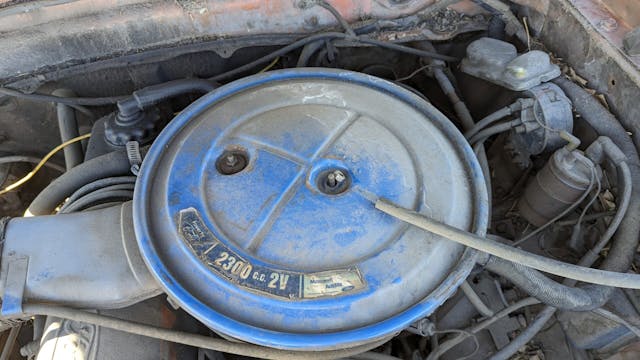


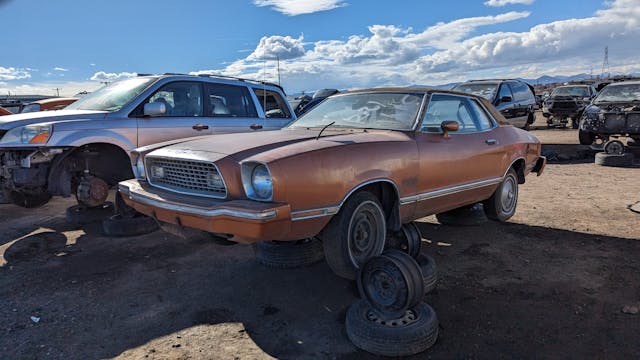














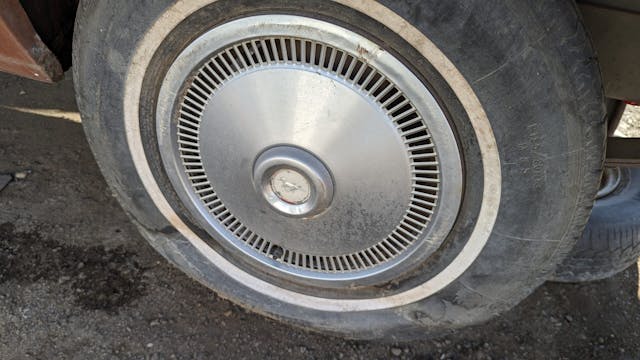






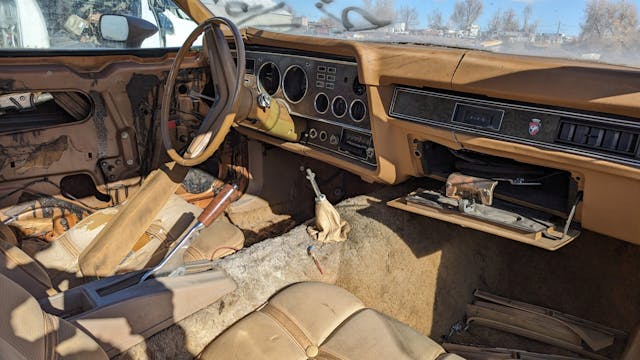


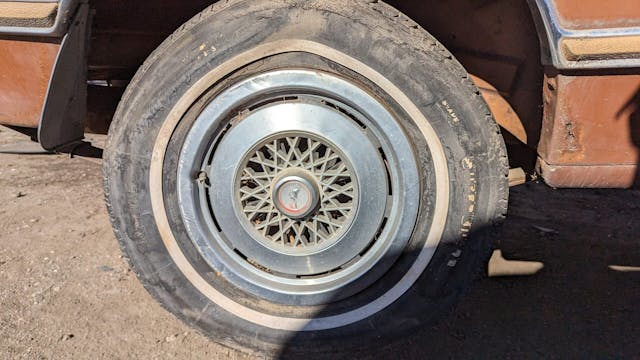

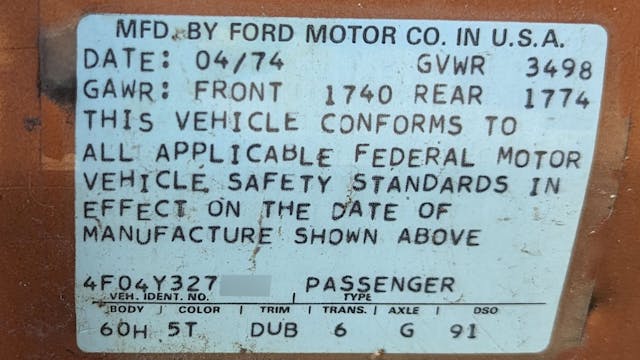
***
Check out the Hagerty Media homepage so you don’t miss a single story, or better yet, bookmark it. To get our best stories delivered right to your inbox, subscribe to our newsletters.
The post Final Parking Space: 1974 Ford Mustang II Ghia Hardtop appeared first on Hagerty Media.
]]>
The Chevrolet Corvair remains by far the most controversial American car ever made. With nearly two million built for the 1960 through 1969 model years, it’s also reasonably plentiful in American car graveyards to this day. Today’s Final Parking Space machine is a ’63 Corvair Monza two-door, now residing in a family-owned yard just south of the Denver city limits.

By the late 1950s, Volkswagen, Renault and other overseas manufacturers were proving that American car shoppers were willing to buy small cars, while American Motors was cleaning up by selling easy-to-maneuver Ramblers. In response, Ford got into the compact game with the Falcon while Chrysler did the same with the Valiant, both of which featured some engineering innovations but didn’t deviate far from traditional Detroit designs. General Motors, meanwhile, went radical with its design for a new compact for the Chevrolet Division to sell.

The Corvair had an air-cooled flat-six engine in the back, much like the later Porsche 911. This allowed GM to lighten the car by using a transaxle instead of separate transmission and drive axle assemblies, while also eliminating the weight and complexity of a liquid cooling system.
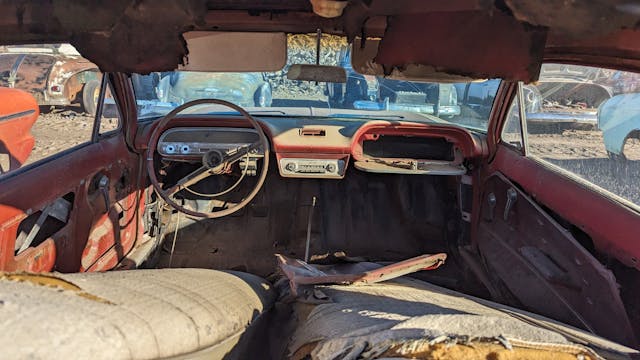
More important, the design permitted the use of a flat floor with no driveshaft tunnel. A bench-seat-equipped Corvair could thus fit six occupants while occupying a very small footprint and boasting a curb weight of about 2300 pounds (hundreds of pounds fewer than a 2024 Nissan Versa). Putting the engine behind the rear wheels also improved traction on snow and ice.

Drawbacks to the design included the difficulty of providing effective passenger heat to an air-cooled car and handling that proved much different than that of the front-engine/rear-wheel-drive cars that most Americans had been piloting since the days of the Ford Model T. Rear-engined cars tend to be prone to oversteering during loss of traction, and the early Corvair’s swing-axle rear suspension (similar to that of the VW Beetle and Mercedes-Benz W120) could cause rear-end jacking in extreme situations.

The 1962 death of comedian Ernie Kovacs in a Corvair crash made headlines, and Chevrolet didn’t help matters by skipping a front anti-sway bar on the early Corvairs (recommending 15 psi of front tire pressure instead). Continuous Corvair suspension improvements were made over the years, with a fully independent rear suspension going into the 1965 and later cars, but the damage to the Corvair’s reputation had been done.

Corvair sales peaked in 1961 and 1962, declined significantly during 1963 through 1965, then fell off a cliff in 1966. Production continued through 1969, but few were paying attention to the Corvair by that point. Ralph Nader gets most of the blame from enthusiasts for the demise of the Corvair, but his “Unsafe at Any Speed” wasn’t published until the end of 1965 and didn’t attract much mainstream attention until the following year. (For a deeper look at whether the Corvair will really kill you, click here -Ed.)

What really killed the Corvair was competition from within the Chevrolet Division itself, taking the form of the Chevy II/Nova compact. That car, which debuted as a 1962 model, wasn’t much bigger than the Corvair and had a traditional water-cooled engine driving the rear wheels (it didn’t hurt that it looked quite a bit like its handsome full-sized Chevrolet brethren). The Corvair barely edged out the Chevy II/Nova in sales for 1962, then fell steadily behind thereafter.

This car is a Corvair 900, also known as a Monza, the top Corvair trim level. The Monza began life in coupe-only form, but it spread to sedans and wagons soon after. GM had envisioned the Corvair sedan as the big seller for the line, but buyers flocked to the coupes and convertibles. Very bad news for Corvair sales arrived at Ford dealerships in 1964 when a certain Falcon-based sporty car hit the scene; every Mustang buyer was a potential Corvair Monza coupe buyer who got away.

From the build tag, we can see that this car was built at Willow Run Assembly in Michigan during the last week of October, 1962, and that the exterior paint was Ermine White. It was equipped with the optional folding rear seats.

It has the base three-speed manual transmission (a two-speed Powerglide was optional, as was a four-speed manual) and the 80-horsepower engine.

The optional AM radio shows the CONELRAD nuclear-attack frequencies at 640 and 1240 kHz. Nineteen-sixty-three was the last year in which these markings were required.
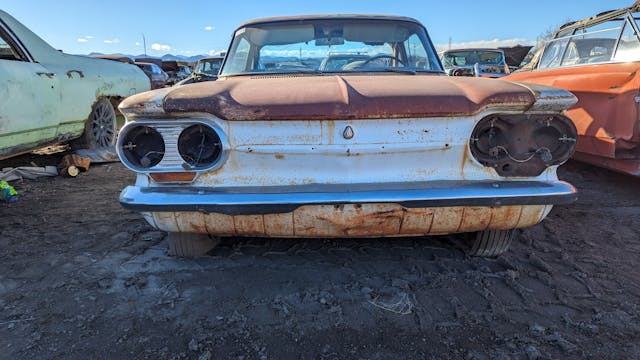
Worth restoring? This one is pretty rough from sitting outdoors in the harsh High Plains Colorado climate for decades, so it makes more economic sense as a parts donor for nicer Corvairs.




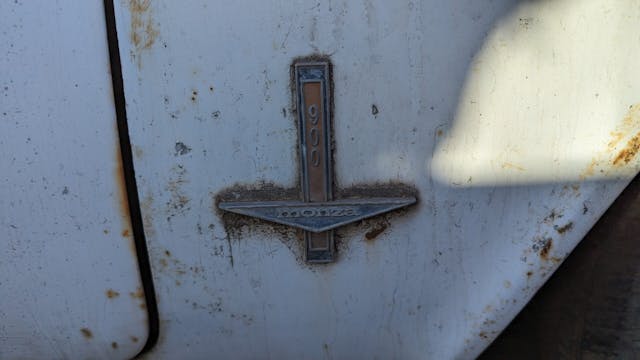










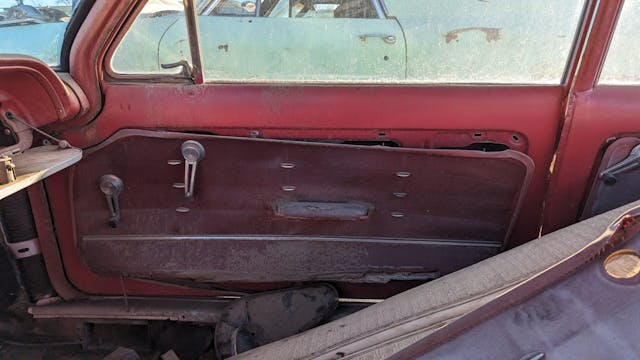




***
Check out the Hagerty Media homepage so you don’t miss a single story, or better yet, bookmark it. To get our best stories delivered right to your inbox, subscribe to our newsletters.
The post Final Parking Space: 1963 Chevrolet Corvair Monza Club Coupe appeared first on Hagerty Media.
]]>
The final new MGs sold in the United States were 1980-model-year MGBs, after many decades of Morris Garage machinery winning hearts on our side of the Atlantic. There were new T-Types, MGAs, MGBs, Midgets, Magnettes, 1100s, and other cars roaring out of American MG dealerships, with MGBs and Midgets remaining common sights on our roads deep into the 1980s.
Back in the United Kingdom, though, vehicles bearing the storied octagon badge continued to be built. Today’s Final Parking Space episode documents one of the very last properly British MGs.

The ZT’s first model year was 2001, so these cars won’t be legal to import to the United States until 2026 at the earliest. I still find discarded MGBs and Midgets on a regular basis in the car graveyards of the United States, but the best means of finding UK-market MGs in their Final Parking Spaces would be to travel to Great Britain and hit one of the two American-style scrapyards over there.
So that’s what I did.

Soon after arriving at London’s Heathrow Airport, I arrived at the rental car lot to acquire wheels (an A-Class saloon) and was presented with vivid evidence that the MG brand still exists. Between a Peugeot and a Fiat (both ancient European manufacturers now owned by Amsterdam-based Stellantis) stood a pair of MG ZSes; indeed, you’ll see new MGs on roads all over Western Europe right now. These machines are built in Asia by Nanjing Automobile, though design and engineering work still takes place in England.
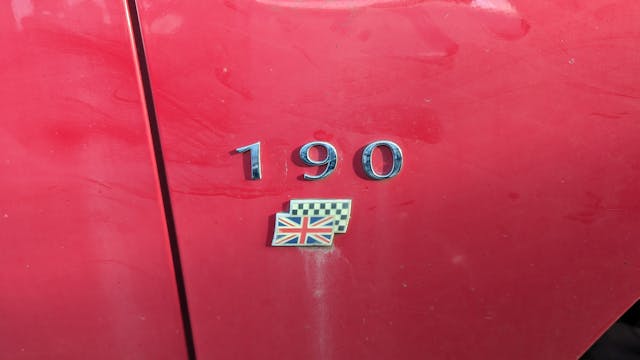
You could make the case that even the ZT doesn’t have full British ancestry, since BMW took over the company very early in the car’s development (you’ll want to read the excellent AROnline article for the full story). However, at the time, the Bavarians were more interested in the car that became the New Mini and so stayed mostly hands-off with the Rover 75 and its ZT descendant, pumping money into the project but leaving the Rover Group engineers and designers to create what turned out to be (arguably) the last of the purely British MGs. In fact, the 75 and ZT were meant to replace the Rover 600/800, which were developed jointly with Honda and contained a great deal of Accord/Legend DNA. I say this car earned its proud Union Jack badges, which now live on my garage wall.

MG had endured a rollercoaster of ownership changes since the Morris Garage built its first cars in 1924. The British Motor Corporation took over in 1952 with the merger of Morris Motors with the Austin Motor Company. In 1966, BMC absorbed Jaguar, then merged with Leyland Motors to become the British Leyland Motor Corporation in 1968. The British government took over in 1975 to create British Leyland, which killed the MG brand (in favor of its deadly intra-corporate rival, Triumph) after 1980 but revived it every so often for badge-engineered cars.
British Leyland begat the Rover Group in 1986, with British Aerospace acquiring the MG brand a couple of years later. BMW bought MG in 1994, then sold it to Phoenix Venture Holdings in 2000; this company built MGs as the MG Rover Group through 2005, at which point Nanjing Automobile gathered up the ruins after a disastrous few months. There’s a lot of history in the junkyard!

The ZT is thus one of very few true MGs from the post-1980 period (again, there’s plenty of room for argument about definitions here, and I’m personally biased, as an American who daily-drove a British Racing Green chrome-bumper MGB-GT while in college). While I’d prefer an MG F to a ZT for myself, the ZT was by most accounts a very good saloon that deserved a much better fate than what it got. Production of ZT-derived cars for the Chinese market continued through the middle-2010s.

U-Pull-It UK is owned by Dallas-based Copart, and their two British facilities are in York and Edinburgh. I visited the York yard, about four hours’ drive north of London and very cold in January. Prices are good and the employees are friendly there. I recommend a visit if you’re in the area.

I shot dozens of interesting vehicles at this yard, as well as at more traditional dismantlers (known as breaker’s yards in England), and I will be writing articles about English scrapyard inmates ranging from a Bentley S3 to an Alfa Romeo Brera S in the near future.

The interior of the MG ZT was comfortable in the traditional British style, with generous helpings of high-quality wood and leather. BMW didn’t want the car to compete too directly with its own 3 Series and 5 Series sedans while the ZT’s Rover 75 ancestor was being developed (hence its size between the two), and MG Rover went all-in on non-German interior design for the ZT.

The engine is a 2.5-liter Rover DOHC V-6, rated at 187 horsepower and 181 pound-feet of torque and giving this car a tested top speed of 140 mph. Versions of this engine came to our side of the Atlantic under the bonnets of Land Rover Freelanders and Kia Sedonas.

The transmission is a five-speed manual, driving the front wheels. A rear-wheel-drive version of the ZT was available as well, made possible by the deep floorpan tunnel, powered by a 4.6-liter Ford Modular V-8.
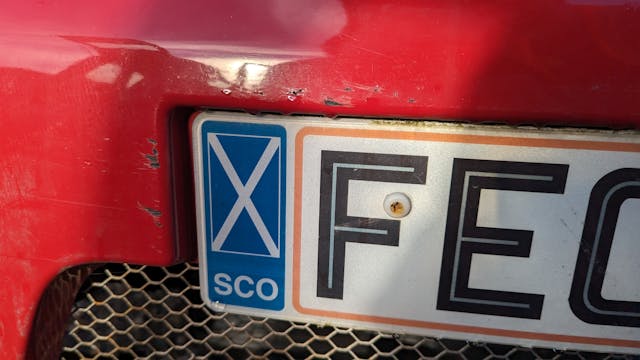
It began its career driving in Scotland but it will be crushed in England.

U-Pull-It was kind enough to shoot a photo of the gauge cluster with the ignition powered on for their inventory site, so we can see that this car had a mere 97,795 miles at the end. That’s fewer than most of our MGBs have today.

It appears that this car was built a few months before the axe fell on the MG Rover Group. Just 1870 ZTs were built for the 2005 model year, so this car is yet another example of the “historically significant and very rare, yet not worth much” category. You’ll see more of that phenomenon in this series, I feel compelled to warn you.



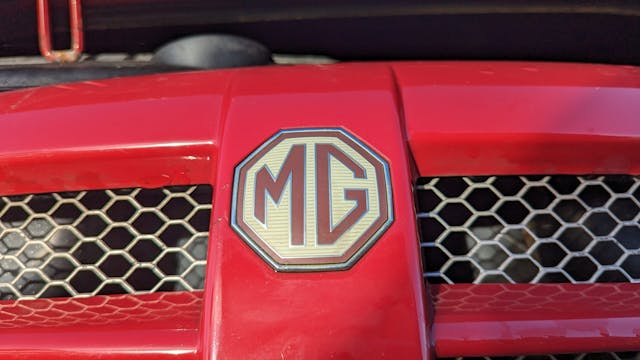
















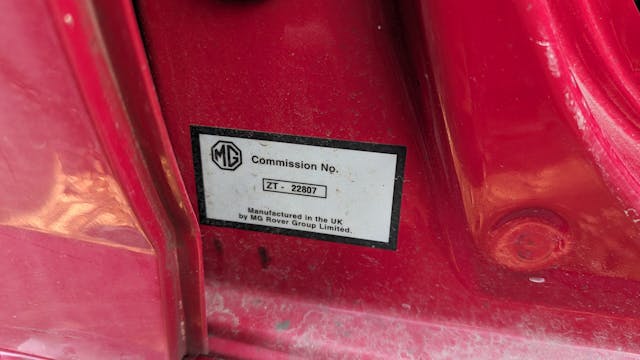







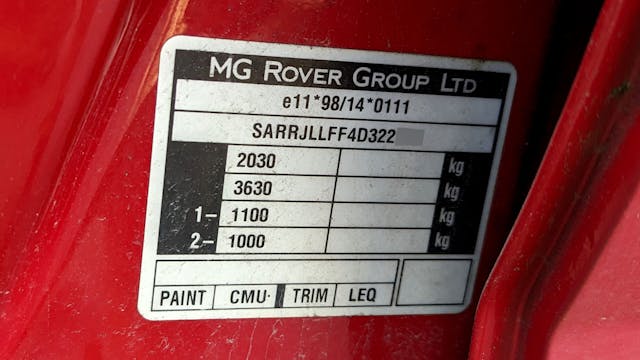
***
Check out the Hagerty Media homepage so you don’t miss a single story, or better yet, bookmark it. To get our best stories delivered right to your inbox, subscribe to our newsletters.
The post Final Parking Space: 2005 MG ZT 190 appeared first on Hagerty Media.
]]>
While there are those of us, like Hank Hill, who prefer “clean burning propane,” there are plenty of backyard barbecuers that would rather do their grilling over hot coals, specifically charcoal briquets. If you’re wondering how that is an appropriate topic for an automotive site, it’s because charcoal briquets were in great part popularized by Henry Ford.
Aha, you may think, so that’s why the brand is called Kingsford. In fact, that’s not the case; there was actually a person named Kingsford for whom the brand is named, though the company that is now known as Kingsford originally did market its products under the Ford brand.
In 1890, 20-year-old Edward G. Kingsford married Mary Flaherty of Iron Mountain, Michigan, a town in the state’s Upper Peninsula on the border with Wisconsin. “Minnie” Flaherty was a first cousin to Henry Ford, who then worked for the Edison Illuminating Company in Detroit. While Ford was working for Thomas Edison during the day while developing his Quadricycle motorcar by night, Kingsford was making a career out of the north woods as a timber “cruiser” and logger and selling timber and real estate across the U.P.
The two men had a camaraderie, both being hardworking and industrious sorts. Over time they became fishing and hunting buddies, as Ford developed a love for northern Michigan. Ford would sometimes use Kingsford as a sounding board or advisor to get opinions outside of Ford Motor Company management in Dearborn.

In 1908, the year that the Ford Model T was introduced, Edward Kingsford was granted distribution rights for Ford automobiles for the entire Upper Peninsula and northern Wisconsin, opening up a number of dealerships. As Model T production soared, selling over a million cars in 1919, Ford Motor Company’s need for wood rose proportionately. While the automobile is seen as a product of the industrial age, something made of iron and steel, early cars used a lot of wood. The body panels may have been steel, but those panels were mounted on wooden frames. Floorboards, dashboards, and spokes for wooden “artillery” style wheels consumed trainloads of wood. It’s estimated that every Model T used about 100 board-feet of lumber in its construction.

Henry Ford believed in vertical integration. In time, he owned iron mines, steel mills, rubber plantations, and just about anything needed to make the components for the Model T. It was natural for him to look north, where he hunted with his cousin by marriage, to source his own wood. Kingsford was appointed Ford’s agent in the U.P. and placed in charge of the Michigan Iron, Land & Lumber Company, which Ford set up to oversee his Northern Michigan operations. That company was absorbed by Ford Motor Company in 1923.

Eventually, Ford owned as much as a half-million acres of mostly hardwood forests, including the entire town of Pequaming, where he and Clara, Mrs. Ford, had a 14-room “cottage” overlooking a bay on Lake Superior. Pequaming was also the location of a large Ford lumber mill, as was L’Anse, located a few miles south. On Ford land adjacent to Iron Mountain, the automaker built an even larger facility for processing the wood from those mills into the aforementioned components, which eventually employed as many as 7000 workers. In time, an assembly line was set up in the Iron Mountain facility for the production of the bodies for “woodie” station wagons. That was converted to manufacturing military gliders during WWII. Near the Ford facility, housing for workers was constructed, and the land and the Ford operations were eventually incorporated as the town of Kingsford, in honor of its founder.

Henry Ford was a personally frugal man and his company reflected that. The millwork operations in Iron Mountain generated an enormous amount of waste wood and sawdust, up to 400 tons per day. While some of that was used to fire boilers operating in the facility, the Michigan Iron, Land & Lumber Co. built a five-story carbonization and distillation factory for extracting usable chemicals from the wood waste. Employing the Stafford-Badger wood distillation process, developed by Orin Stafford, a University of Oregon wood chemist, the plant produced tars, pitches, methyl alcohol antifreeze, ethyl acetate used in making faux leather for rooftops, and other alcohols used in paints.

When everything else was extracted from the wood, what was left was lump charcoal—about 100 tons of it per day. It could be used as a fuel, but there was a limited market. Enter the “charcoal briquette.” First patented in 1895 by W.P. Taggart, it was marketed as a “Lump of Fuel.” It wasn’t for backyard grilling but rather was sold as a safer, hotter, and more easily temperature-controlled alternative for wood stoves. An Ellsworth Zwoyer of Pennsylvania bought Taggart’s patent and set up the Zwoyer Fuel Company, with a couple of factories in upstate New York and Massachusetts, but he never managed to achieve national distribution, though regional and local competitors popularized the concept.

By the time Ford’s Iron Mountain operations were getting going, Orin Stafford had developed his own method for making “lumps of fuel,” joining powdered lump charcoal, tar, and starch under heat and pressure, creating what he called charcoal “briquettes.” Ford licensed the process, shortened the name to briquets and started selling them nationwide through Ford dealers. Though advertised as the “Fuel of a Hundred Uses,” the primary use of the briquets seems to have been what they are used for now, cooking food over a grill. In fact, alongside the bags of briquets, Ford also sold small grills in three sizes—for $1, $2, and $3 each—and complete “Picnic Kits.” Wooden excelsior was sold as fire starter. Ford also sold a “Hunter’s Heater,” essentially a quart can (as was used for motor oil) that was filled with briquet pieces. The idea was that you used a can opener to cut vents into it, lit the charcoal, and heated your general area with it, or cooked over it; no extra charge for the carbon monoxide.

After the end of World War II, American suburbs grew, a company named Weber introduced its own grills, and backyard barbecues became popular. In 1951, a group of investors bought Ford Charcoal and persuaded grocery chains to carry its products. Perhaps to distinguish the new company from Ford, the company was renamed Kingsford Chemical Company, in honor of E.G. Kingsford, although neither he nor his descendants apparently had anything to do with the business.
Both Edward and Minnie Kingsford died in 1943. The Iron Mountain charcoal briquet factory was closed in 1961, attributed to rising labor costs. Today the Kingsford brand is owned by the Clorox corporation and it continues to process about a million tons of scrap wood into charcoal briquets annually.
***
Check out the Hagerty Media homepage so you don’t miss a single story, or better yet, bookmark it. To get our best stories delivered right to your inbox, subscribe to our newsletters.
The post At Your Next BBQ, Tip Your Chef’s Toque to Henry Ford, Who Helped Popularize Charcoal Briquets appeared first on Hagerty Media.
]]>
If Earl Muntz was a madman, as his nickname suggests, then we should all strive to be a little crazy. Muntz, born 110 years ago this week, was no ordinary child—or teenager, or man. Muntz was a creative and technological genius who made, and ultimately lost, several fortunes, most with direct ties to the automotive industry.
Born on January 3, 1914, in Elgin, Illinois, Muntz was always fascinated by how things worked. He built his first radio at age eight, and by 14 he had already created a radio for his parents’ car. Higher education wasn’t meant to be, however. Muntz didn’t even graduate high school; he dropped out during the Great Depression to work in his parents’ hardware store, but he never stopped learning or inventing. Muntz also never stopped striving to make a better life for himself.
At age 20, he started his own dealership selling used cars, but until he turned 21 his mother had to sign all of the required documentation whenever he sold a vehicle. Muntz was earning a decent living when, at 26, he vacationed in California and decided there was even more money to be made on the West Coast. He opened a used car lot in Glendale, then lucked out by purchasing a handful of new cars that were scheduled to be shipped to Asia before World War II broke out and kept the vehicles stateside. Muntz decided to drum up hype in the local newspaper, and the cars quickly sold. He realized that the more attention he got, the more cars he would sell. The “Madman” was born.

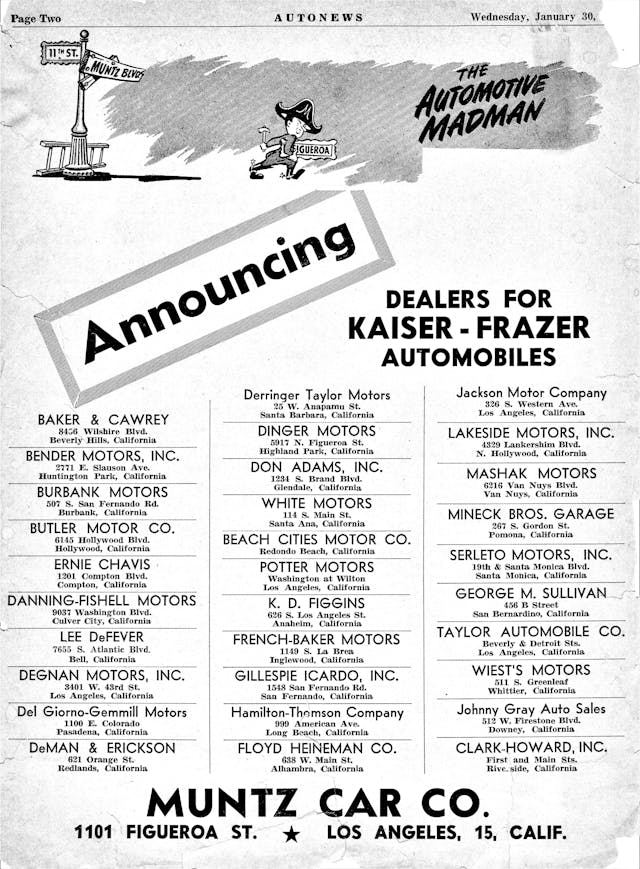
Nothing was too over the top for Muntz, as long as it generated publicity. He would don red full-body underwear and a Napoleon-like hat and boast on billboards and in newspaper ads that “I wanna give ’em away, but Mrs. Muntz won’t let me!” His commercials bombarded the radio airwaves. He would often feature a car, threaten to smash it with a sledgehammer if it didn’t sell by the end of the day, and follow through, which only generated more attention. His dealerships made millions.
Already a Southern California legend, Muntz turned his attention to manufacturing televisions, drawing from his early interest in electronics. He was all about simplification, making intricate TV sets a little less complicated by reducing the number of components required while also reducing the price. The “less is more” philosophy became known as “Muntzing.”

The Madman’s TVs sold for about $100 in 1949, about one-quarter the price of most of his competitors, and he made millions—again. The good times didn’t last, however, as Muntz’s stripped-down televisions required more maintenance than other brands, and he folded his TV venture in 1959.
During the same time, although Muntz had rejected an opportunity to sell Volkswagen Beetles when they rolled into the U.S. market in 1949, he owned Kaiser-Frazer dealerships on both coasts, one in Los Angeles and another in New York. The experience motivated him to create a car of his own, the Muntz Jet, beginning in ’49.



Oddly, while Muntz emphasized simplification when it came to TVs, he went in the other direction when designing his automobile. After purchasing Frank Kurtis’ two-year-old Kurtis Sport Car Company, Muntz transformed the KSC design into the Jet. He offered upgraded V-8s, built by Cadillac and Lincoln, that propelled the car to 125 mph and could be mated with either a General Motors Hydramatic automatic or a three-speed Borg-Warner manual transmission. He also extended the wheelbase by 13 inches to allow room for a backseat, which had a drink cabinet in the armrest. Buyers could order upholstery made of alligator, emu, leopard, or snakeskin. Each hubcap wore an emblem of a Napoleon-like cartoon character wearing red underwear.
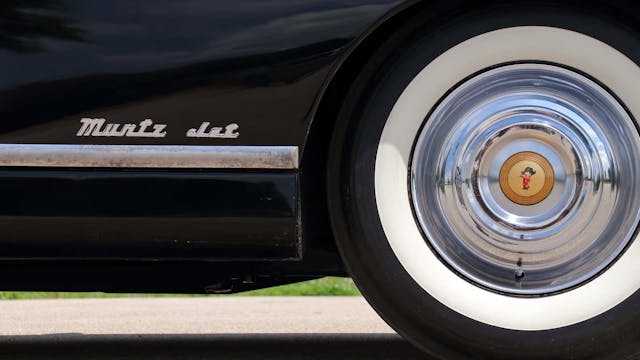
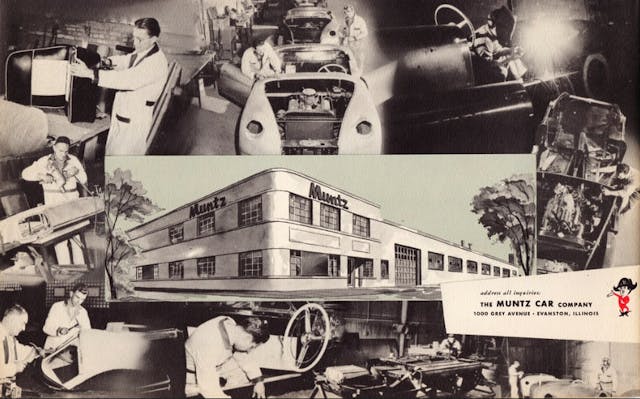
Built both in Glendale and Evanston, Illinois, the aluminum-bodied Jet was fast, luxurious, and innovative, with cutting-edge features like seat belts and a padded dash. Notable buyers included Hollywood stars Grace Kelly and Mickey Rooney. Once again, however, Muntz’s venture was unsustainable. The Jet retailed for $5500 in 1953 (about $63,250 today), but it cost $6500 ($74,750) to build. Only 198 were sold—Muntz claimed the number was twice that—and the Madman lost nearly a half-million dollars before shuttering his car factories.

He wasn’t done, however. Turning his attention to car stereos in the late 1950s, Muntz took great interest in the new Fidelipac audio tape, the first recorded audio tape cartridge. It used an endless quarter-inch tape loop with three tracks, but Muntz added a fourth track so it could play full albums in stereo. Launching Muntz Stereo, in Van Nuys, California, in 1962, the Madman offered pre-recorded albums and Stereo-Pak players for both home and automobile. He made another fortune—and, once again, it didn’t last.

The graphite on Muntz’s tapes didn’t bond well with the tape—a problem that Muntz chose not to correct because the supplier offered him a favorable credit agreement—giving the tapes a short lifespan. Consumers eventually looked elsewhere, namely to Bill Lear’s new 8-track cartridge. Already buried in debt, Muntz Stereo suffered a warehouse fire in 1970, and the company folded.
Muntz trudged on, offering an alternative compact videotape in the 1980s that competed with VHS and Beta (and failed), and he later rented motorhomes (a venture he called Muntz Motor Mansions) and sold Hitachi cell phones and satellite dishes.
Earl “Madman” Muntz died of lung cancer on June 21, 1987, at the age of 73, having won and lost several fortunes and an endless number of fans. He will long be remembered as an ingenious and relentless inventor, entrepreneur, unconventional showman, and—most importantly to auto enthusiasts—the creator of the Muntz Jet. And you can always find him on the hubcaps.






***
Check out the Hagerty Media homepage so you don’t miss a single story, or better yet, bookmark it. To get our best stories delivered right to your inbox, subscribe to our newsletters.
The post Earl “Madman” Muntz, creator of the Jet, was a genius and a showman appeared first on Hagerty Media.
]]>
A red Miata dangles from the arm of a construction crane, suspended several stories in the air. Hooked behind the rear bumper, its round nose points to the pavement below. In an instant, the tiny sports car plummets to the tarmac. It smashes and falls, shiny side down. If that wasn’t cruel enough, a gray 1985 Dodge van with “Blink 182” painted on the side enters stage right and backs into the dead, red convertible.
End scene. Fin.
Said Miata drop is the climax to a Blink 182 music video for the band’s 2001 hit song “The Rock Show.” The whole premise is that the record label gave Blink a check for its latest video. The pop-punk trio rolls up to a bank in the gray Dodge van and then chases the check in order to commit a day of stunts with the windfall: throwing dollar bills off a roof, freeing pet shop doves, and the like. Rapid cuts of this buffoonery are mixed with footage of the band playing at various locations. It’s all the kind of stuff that captivated the minds of young teens and shot Blink 182 to the top of the charts in the early 2000s.
While it’s safe to say the folded Miata was probably written off as a total loss, the van’s whereabouts were always a mystery. “The band rented the Dodge for the shoot,” says 32-year-old superfan Andrew Baldwin. “After the video, it ended up in the hands of a radio station and sat in their lot for a while. Then a station employee purchased the van and owned it for better part of a decade.”
In the 23 years since the video, Blink 182 became one of the biggest rock bands of the 21st century. It’s three central members came and went before finally reuniting last year for a reunion tour. By all accounts the band still rocks and brings the same juvenile humor prevalent in their songwriting, live performances, and music videos. (Look no further than the tour name, The Rock Hard Tour.)
Only one question was left unanswered until recently—no, not “What’s my Age Again?” but rather: Where on Earth is the Blink 182 Dodge van?

“We first found it a few years back, posted online,” says Baldwin. “There were rumors someone was going to buy it. Somebody passed on it. Other people chose not to buy it.” He and his girlfriend Taylor didn’t lose interest. “We thought about it a whole lot. Nobody really said where it was and nobody would give the exact location.” Online chatter was only mildly helpful.
The couple eventually found the van using Google Street View. “We had enough clues to get close.” The faded “Blink 1-8-2” on the side rendered it immediately recognizable to a guy like Baldwin, who remembers watching the music video when it was on the air in ’01. He was able to get in contact with the owner. Still, Baldwin found himself hesitating at the prospect of taking the van home. He contemplated what he might do with an old music video prop that, in his words, “ran, but not well.”
“It was actually my girlfriend that said, ‘Go for it and think about it later.’”


A thousand bucks later, the van was theirs. After shipping it to their house in Texas, they commenced to flushing the gas lines and dropping the tank. According to Baldwin, the Dodge needs a new carburetor, new brakes, and a bit of TLC throughout. “The goal is to get it road-worthy by the time the band tours this summer. We’re going to take it shows and tailgate.” While it might not command the dough that a Bullitt Mustang or a Bandit Firebird will fetch at auction, the van has plenty of historical provenance among the right crowd.
“For me, I love the band and the music and part of it how ridiculous it feels to own a 38-year-old van in the garage that you’re going to restore,” he says. “It means a lot. I get a funny feeling sitting in the driver seat.”


The van’s musty interior appears just as it was when the band piled in for filming of “The Rock Show” video. Even the rear doors, which impacted the Miata during the shoot, remain permanently wedged shut. More two decades later, the giant gray van is a rolling time pop-punk capsule.
“It’s awesome. I smile every time I step in the garage and see it.”
The couple is documenting the entire Blink 182 van saga on their Instagram. Follow along at @therockshowvan.
***
Check out the Hagerty Media homepage so you don’t miss a single story, or better yet, bookmark it. To get our best stories delivered right to your inbox, subscribe to our newsletters.
The post Blink 182’s Dodge “Rock Show” Van Just Got New Owners appeared first on Hagerty Media.
]]>
In the history of automobile design, few periods are more fascinating than the years between the end of World War II and the early 1960s. We can attribute this to the intense creative exchange between the two sides of the Atlantic in that era. To the eyes of people in war-ravaged Europe, the flamboyant automobiles hailing from the United States embodied the promise of a better future. On the other side of the ocean, Americans manufacturers seeking to lend glamour and sophistication to their mass-market products found a font of resources in postwar Italy, a land of rich design heritage and abundant artisan talent. And if there’s one man whose career trajectory rode this wave of “transatlantic style” better than anyone else, it’s Giovanni Savonuzzi.
Savonuzzi was born in 1911 in the small city of Ferrara. Shortly after graduating as a mechanical engineer, he moved to Turin to work for Fiat’s aero division. It was during his time at Fiat that he met Dante Giacosa, and the encounter would lead to a pivotal moment for Savonuzzi’s career.
By the early 1940s, Giacosa had become the head engineer of Fiat’s automobile division. But, with activities on future car projects sidelined by the war effort, he was tempted by entrepreneur Piero Dusio’s venture, Cisitalia. Working over his spare time at Dusio’s Turinese residence between 1944 and ’45, Giacosa designed the D46 single-seater for Cisitalia and laid the technical groundwork for the marque’s famous 202 coupé. Yet when Dusio asked for a full-time commitment from Giacosa, the latter politely declined. He suggested hiring Savonuzzi instead.

In his 1979 autobiography, Giacosa described Savonuzzi as: “Intelligent, brilliant, passionate, and a tireless worker.” Deservedly so: Savonuzzi began working for Cisitalia in August of 1945 and, in the space of a few months, set up Cisitalia’s technical facilities from scratch and took over every aspect of vehicle development. This included styling, an area in which Savonuzzi would go on to show remarkable skill.
The first prototype for Cisitalia’s coupé got the uncharitable nickname “cassone” (the Italian for “large box”) due to its slap-dash, makeshift looks. (Not so in the case of the lovely 202 Coupé Mille Miglia that followed, however.) The Italian engineer’s fascination with aerodynamics is evident in these cars, known today as “Aerodinamiche Savonuzzi,” due to their voluptuous curves and tailfins tall enough to make a Cadillac blush.

Meanwhile, Savonuzzi started work on the production version of the 202. It would become one of the most celebrated designs in all of automotive history. And once again, his creative input went beyond the technical aspects to encompass the car’s aesthetic appearance. Pininfarina usually takes all the credit for the design of the 202 coupé, yet the key elements that made the 1947 Cisitalia such a turning point in car design—like its fully integrated fenders and the bodyside made of a continuous surface across the entire vehicle’s length—stemmed from Savonuzzi’s drawings.


The involvement of Battista “Pinin” Farina was Piero Dusio’s idea. After all, Cisitalia was a new company, and the Pininfarina signature would give the 202 valuable cachet. But that’s not to say his name was the only thing the great master brought to the table—Pinin’s uncanny eye for proportion and detail polished Savonuzzi’s rough gem into a masterpiece that set the design template for the whole “Gran Turismo” genre.
Savonuzzi left Cisitalia in 1948. Various race car projects and collaborations followed, one of which brought him to Ghia in 1953. Conceived to take part in the Mille Miglia road race, the “Supersonic” was as Italian as lasagna but wouldn’t have looked out of place among the dream cars of GM’s Motorama shows.


Displayed at the 1953 Turin Motor Show, the “Supersonic” was based on a bespoke tubular chassis equipped with an Alfa Romeo 1900 Sprint engine and mated to a Lancia Aurelia transmission. What captured everyone’s imagination, however, was the car’s streamlined body, with its long hood, squat roofline, and taillight clusters that looked like jet afterburners. Orders for more Supersonic-looking cars quickly ensued, prompting Savonuzzi to modify the design to fit the newly launched Fiat 8V’s chassis. Over the next two years, Ghia would give the Supersonic treatment to fourteen Fiat 8Vs, three Jaguar XK 120s, and even an Aston Martin DB2/4.

The story of Ghia in the 1950s is inextricably linked to its role as the Chrysler Design Studio’s overseas prototype shop. Having become Ghia’s technical director in 1954, Savonuzzi oversaw the build of Virgil Exner’s “idea cars,” and that inspiration is evident in the fantastic “Gilda” streamliner from 1955.

With its semi-concealed wheels, impossibly long hood, and razor-sharp tailfins, the Gilda resembled a sci-fi movie prop more than an actual vehicle. Yet, there was a method to the madness: The Gilda’s striking design, inspired by watching ink blots blown onto a dart shape, stemmed from Savonuzzi’s experiments with scale models in the Turin Polytechnic University’s wind tunnel. A crowd favorite wherever it went, the Gilda would keep making motor show appearances until as late as 1960, but would also be one of Savonuzzi’s last stylistic feats.

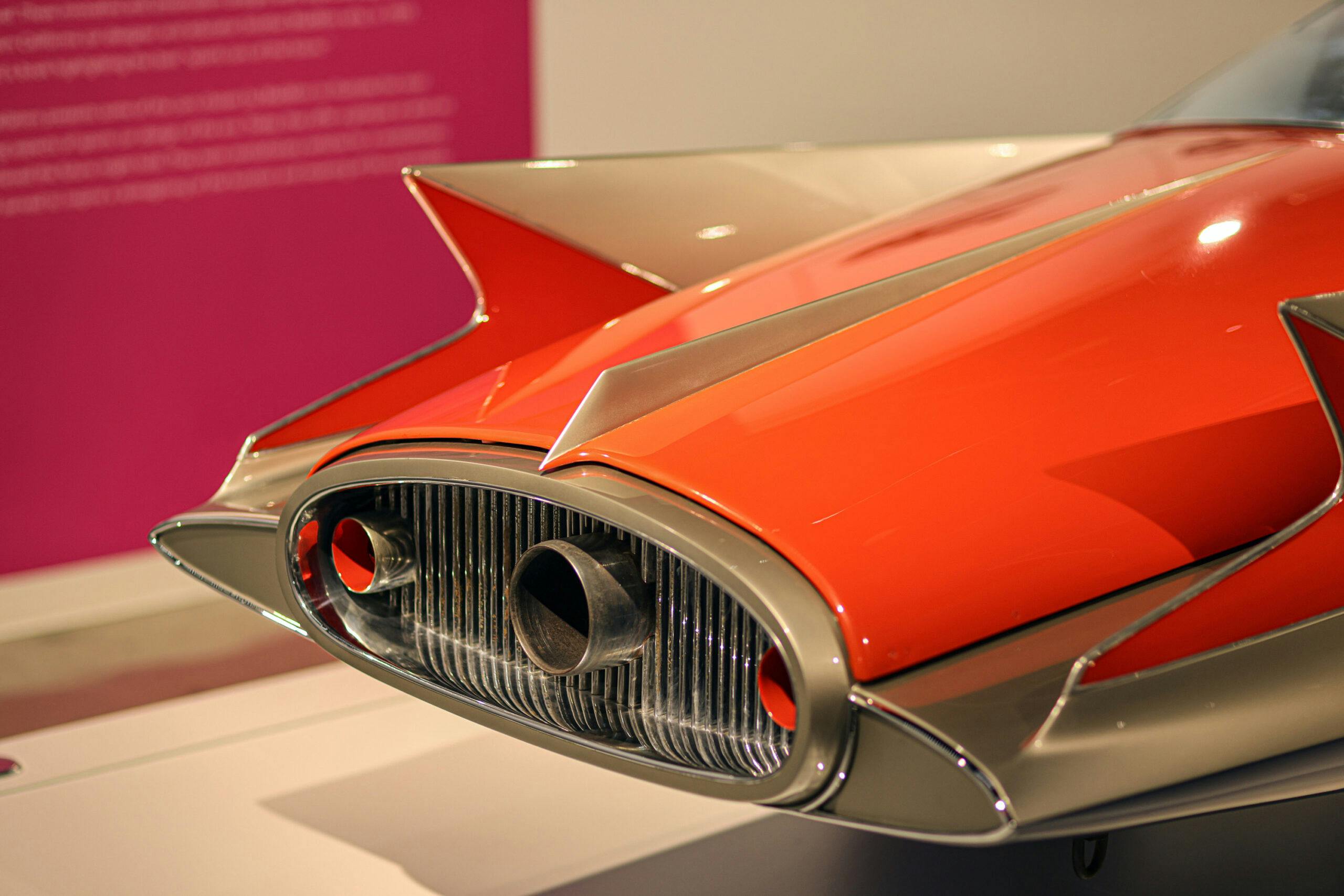
His duties at Ghia meant Savonuzzi dealt with high-ranking Chrysler personnel in America on a regular basis. Due to his background in aircraft engineering, he was interested in Chrysler’s work on space and defense contracts and eventually joined the company in 1957 as a research engineer on the gas turbine project. While his name is listed on several patents related to turbine powertrains, little is known about the extent of his contribution to Chrysler’s turbine program. Nevertheless, Savonuzzi remained at Chrysler until 1969, when Giovanni Agnelli lured him back to Turin. Over the following years, as the Director of Research and Development at Fiat, he kept working on alternative propulsion systems until his retirement in 1977.

Giovanni Savonuzzi passed away in 1987. At this point, an article like this would end with a variation on the classic “gone but not forgotten” cliché. That would be disingenuous, because despite leaving a deep mark on the history of automobile design that any contemporary professional would die for, Giovanni Savonuzzi is not celebrated alongside other Italian masters like Bertone, Pininfarina, Gandini, and Giugiaro. I like to think I’m doing my bit to change that.

***
Matteo Licata received his degree in Transportation Design from Turin’s IED (Istituto Europeo di Design) in 2006. He worked as an automobile designer for about a decade, including a stint in the then-Fiat Group’s Turin design studio, during which his proposal for the interior of the 2010–20 Alfa Romeo Giulietta was selected for production. He next joined Changan’s European design studio in Turin and then EDAG in Barcelona, Spain. Licata currently teaches automobile design history to the Transportation Design bachelor students of IAAD (Istituto di Arte Applicata e Design) in Turin.
Check out the Hagerty Media homepage so you don’t miss a single story, or better yet, bookmark it. To get our best stories delivered right to your inbox, subscribe to our newsletters.
The post Giovanni Savonuzzi: The Italian design master you’ve probably never heard of appeared first on Hagerty Media.
]]>
Today, Enzo Ferrari graces the silver screen in a new biopic, titled Ferrari. The film recounts Enzo’s risky bet on the 1957 Mille Miglia, the 1000-mile sports car race whose outcome could determine the fate of his namesake company. In celebration of the big debut, which features Adam Driver, Penelope Cruz, and Patrick Dempsey (read our exclusive interview with the actor here) we’re resurfacing this October 2022 article. —Ed.
They called him the Old Man, Il Commendatore, or simply Mr. Ferrari. But Enzo is said to have preferred the title of l’ingegnere, the engineer. Few would argue that he deserved the label, though Enzo Ferrari washed out of technical school and only adopted the honorific after the University of Bologna conferred on him a ceremonial degree in 1960. It was just one pantomime in an operatic tale of struggle, cunning, triumph, carnage, and ego warfare that were the pillars of Enzo’s life and empire.
To outsiders, he was an inscrutable, 6-foot-2240-pound golem of stone hiding behind dark glasses. To insiders—at least those who wrote books about or spoke of their days in Ferrari’s orbit—he was an often-exasperating puzzle, a confusion of contradictions and emotions propelled by a bunker-like insecurity informed by a worldview firmly fixed in 19th-century Italian masculinity.
Was he a genius? Well, he knew brilliance when he saw it. In engineers, such as Vittorio Jano, Gioacchino Colombo, Giotto Bizzarrini, and Mauro Forghieri. In designers, from Battista “Pinin” Farina to Sergio Scaglietti. And in drivers, from Tazio Nuvolari to Juan Manuel Fangio to Mike Hawthorn to Phil Hill to John Surtees to Niki Lauda. He turned proud, ambitious, and gifted men into fawning supplicants willing to devote their careers and risk their lives for the splendor of the Scuderia. Then he often drove them out, or mad, or into early graves with relentless pressure tactics applied through endless political intrigues.
People said Enzo Ferrari preferred his cars and his mechanics to his drivers and his customers. According to Ferrari biographer Brock Yates, somebody once asked Luigi Chinetti—who cracked open the hugely lucrative American market for Ferrari—if Enzo deserved the reproach. After considering it for a moment, Chinetti replied, “I don’t think he liked anyone.”

It’s no accident that the history of Italy’s auto industry is largely confined to a crescent on a map defined by the Po River and the broad plain it bisects in Northern Italy. The region has been known for its metalworking since the Middle Ages and for its sophisticated design and engineering since the Renaissance. Enzo’s father was a metalworker, starting with a dirt-floor workshop next to a dirt-floor house in Modena, an ancient gray burg that swelters in summer and is often enveloped by a dismal, greasy fog in winter. When his second son, Enzo Anselmo Giuseppe Maria Ferrari, was born on February 18, 1898 (the exact day is a matter of dispute and speculation), Alfredo Ferrari was busy growing his business into a thriving workshop that supplied the national railway with bridge and canopy iron.
Though Enzo would claim later in life that he came from rags, his father bought the family its first car, a single-cylinder De Dion-Bouton, in 1903, when many Italians still dreamed of a donkey cart to call their own. Young Enzo’s romantic visions of his future drifted, from opera singer to Olympic sprinter to sportswriter. However, Italy, more than any other European nation, had gone mad for the automobile. Every region, practically every town, hosted a hill climb or a trial or a circuit race, and Ferrari was caught up in the fever.
World War I and the untimely death of both Enzo’s father and older brother, Alfredo Jr., or “Dino,” delayed events and decimated the family business. In November 1918, Enzo was rejected for a job at Fiat, sparking a grudge that would endure until 1969, when he extracted millions from the Agnelli family in exchange for Fiat’s half interest in Ferrari. However, rather than head home from Turin, Enzo started to pal around with the drivers and mechanics who infested the backstreet garages and pubs of Italy’s burgeoning motor city.

His results as an amateur racer drew the notice of the Alfa Romeo team, which invited him to join the squad as a journeyman driver in 1920. Despite modest success as a piloto, though, Enzo longed to return to Modena, where he saw more opportunity as an Alfa Romeo dealer and racing-team manager than as a driver, which was a filthy, bare-knuckled profession in those early days that routinely racked up a horrific butcher’s bill. Racing laurels brought fame, money, and women, but Enzo had an innate sense of both his limited driving talent as well as his true calling, which, given the bleak odds back then, probably saved his life. After he founded Scuderia Ferrari and began building his own cars in 1947, he rarely drove himself, preferring to be driven by his former riding mechanic and longtime valet and chauffeur, Peppino Verdelli. His fate was to wear a tie instead of leathers, to sit behind a desk rather than a steering wheel, and to die in bed at the age of 90 rather than against a tree or upside down in a burning wreck.
Seasoned racers say their chosen sport brings the highest of highs and the lowest of lows. Such was true of Enzo’s entire life, a melodrama of glory and bitter personal and professional grief, the latter often coming hard on the heels of the former as chronicled in his aptly titled autobiography, My Terrible Joys. For the most objective reading on Ferrari, see the two best biographies, Enzo Ferrari, the Man and the Machine, an amusingly sardonic take by the late Car and Driver editor and Cannonball Run founder Brock Yates, and Enzo Ferrari: Power, Politics, and the Making of an Automotive Empire, which, at nearly a thousand pages, is a more academic (and less deliberately iconoclastic) undertaking by Luca Dal Monte, a former Ferrari PR man.

One walks away with an impression of a figure who saw himself as a David constantly in battle with one Goliath after another for the honor of his little duchy of dedicated artisans and, by extension, Italy itself. From Nazi-funded Germans before the war to the chastened but still very potent Germans after, followed by his hated crosstown rival, Maserati. They were replaced by a band of British innovators such as Cooper and Lotus—Enzo dismissed them as the garagiste because they operated out of small garages and didn’t build their own engines—followed by the mighty Glass House presided over by a spurned and vengeful Henry Ford II. After Porsche arrived with 917s that could top 220 mph on the Mulsanne Straight at Le Mans, Ferrari retreated from sports car racing to focus its limited resources on Formula 1.
Subterfuge was a tool that never got rusty in Enzo’s box. In September 1953, he summoned the Modena police to the factory, claiming that plans for a new grand prix car had been stolen and sold to a rival. The brouhaha hit the press and suspicion immediately fell on Ferrari’s nemesis, Maserati. Company president Adolfo Orsi called his lawyers, and Enzo was compelled to appear and sign a witnessed statement saying Maserati was not a suspect. As with so many of Ferrari’s little opera buffas, the controversy evaporated as quickly as it erupted.
In response to some perceived slight or to gain some small advantage, Enzo threatened to quit racing entirely so many times that journalists lost count. In 1953, he announced that he was retiring and closing the factory “for delicate personal reasons,” adding that “racing no longer interests me.” That September, Enzo amended his list of unbearable injuries to include the supposed theft of the blueprints. By December, the press reported Ferrari’s plans to continue into 1954. End scene.

And so it went; the Royal Automobile Club of Belgium canceled the 1957 grand prix at Spa because Ferrari refused to come unless the starters’ fees were increased. By then, wrote one reporter, staging a race without Ferrari was like staging Hamlet without the prince. In 1960, Ferrari pulled out of Sebring because of a dispute over the fuel sponsor (the cars were instead sent to Chinetti, who campaigned them under the North American Racing Team—NART—banner). In 1976, having lost an appeal over two contested grands prix, Enzo again said Ferrari was done with Formula 1.
“Withdrawals and threats of withdrawal used to be a regular feature of Ferrari’s end-of-season press conferences,” observed Eric Dymock, for many years the racing correspondent for Britain’s The Guardian newspaper, in a 1976 column. “For some reason or another, the 78-year-old autocrat, who has been connected with motor racing for nearly 60 years, took the huff over something and said his beautiful cars would never run again. Always he changed his mind.”
Experts seem to agree that Enzo sold road cars to pay for his racing mania. And that he scorned his customers, the dandies and poseurs and idle rich who groveled for his attention and threw reckless sums at him for cars. You can just imagine some of the characters who bought a Ferrari in the 1950s, when European cities still showed the scars of war and there were shortages of everything. One had to be a particular sort to want to flash wealth in that environment. In the 1960s and ’70s, their kids came back for their own cars, putting Enzo in a unique position to observe a particular kind of generational human folly.
But the tycoons and the toffs couldn’t help themselves; the exquisite driveway jewelry assembled behind the famous red gate on Via Abetone in Maranello set hearts aflame across all classes and nationalities. With Pininfarina’s growing involvement beginning in the early 1950s, Ferraris developed a more familial look in an expanding product catalog that was slowly becoming more organized, planned, and marketed. The factory’s output rose from dozens in the 1940s to hundreds in the 1950s to thousands in the 1960s. Enzo’s hidebound allegiance to solid axles, drum brakes, wire wheels, and front-engine configurations left him open to competitors, but nobody who ever bought a Ferrari was asked why. It remains a blue-chip purchase to this day.

Enzo surely had his eccentricities, but it’s hard to judge a man whose life was so equally blessed and cursed. He was at his son’s bedside in June 1956 when the 24-year-old, long suffering the slow erosion of muscular dystrophy, said, “Dad, it’s over,” and slipped into a coma and died. “I have lost my son,” Enzo wrote in a journal he kept of Dino’s illness, “and I have found nothing but tears.”
It was a ghastly period for Enzo and the Scuderia. Alberto Ascari had been killed in 1955 while he was taking a few quick practice laps at Monza in teammate Eugenio Castellotti’s 750 Sport. Castellotti himself died at Modena in March 1957. Luigi Musso and Peter Collins were both killed the following year at the French and German grands prix, respectively. And Phil Hill’s 1961 world championship–sealing win at Monza was clouded by the fatal crash of the popular and affable Count Wolfgang von Trips, which also massacred 15 spectators.
But it was the disaster at the 1957 Mille Miglia that was to haunt Ferrari for years. Alfonso de Portago, the handsome, athletic, and fabulously wealthy son of an Irish heiress and a Spanish count, was the sort of aristocratic playboy whom Ferrari derided and distrusted. Enzo always claimed to not have favorites, refusing to rank his drivers as other teams did. But he took the best shine to poor, up-from-their-bootstraps gunners such as John Surtees, whom he affectionately called “Giovanni,” and Gilles Villeneuve.

However, the 11th Marquess of Portago could drive, having earned his chops competing in the Carrera Panamericana and winning the Tour de France Automobile as well as the Nassau Governor’s Cup. Though Portago was infamously hard on his equipment, Ferrari assigned him as a last-minute substitute to one of the factory’s state-of-the-art 335 S roadsters. Enzo then turned the screws. He pointed out to the 28-year-old Portago that the Scuderia’s more experienced drivers, Piero Taruffi and Olivier Gendebien, had been given less powerful cars. Enzo then sniffed to Portago that it didn’t matter, that they would probably beat him anyway. Such were the standard mind games at Ferrari.
Near the end of the Mille, Portago’s 390-hp, 4.0-liter V-12 rocketed him and co-driver Ed Nelson, an American bobsled racer along for the ride as part of Portago’s clique of hangers-on, to 180 mph on the long straights across the Po Plain toward the Mille’s finish in Brescia. At the final rainy fuel stop in Mantua, Portago was running fourth behind both Gendebien and Taruffi, but he was told that the leaders were having mechanical trouble and that he was closing on Gendebien. Portago was offered a fresh set of Englebert tires to replace his badly worn skins, but he refused, taking a swig of orangeade and roaring off in haste toward Brescia.
Some 17 miles up the road, the slimy and battered Ferrari shrieked toward the village of Guidizzolo at around 130 mph. A front tire exploded. The car jinked left, clobbered a stone kilometer marker, and spun violently into a ditch, emerging 15 feet in the air as a pinwheeling, shrapnel-spraying buzz saw of death. It sailed over one line of spectators, hit the road, tumbled, and plunged into the crowd. Portago and his co-driver were killed instantly, as were nine bystanders, five of them children. The mayhem was so grisly that police had trouble identifying the bodies.

Italy erupted in rage. Protesters thronged the crash site and, later, the Ferrari factory, shouting, “Assassins! Criminals!” The conservative newspaper Il Tempo joined a media chorus denouncing the race, labeling it “an absurd fight between defenseless crowds and a small group of irresponsible men.” Enzo was brought up on murder charges, and the Vatican issued a statement calling him “a modernized Saturn devouring his own sons.” The Mille Miglia was finished but the legal wrangling lasted four years, until Enzo was dragged into court, where he broke down in tears after the first question from the prosecutor. He was soon acquitted, as it was estimated that up to a million people had lined a route with zero crowd control. The Scuderia soldiered on.
Italians obviously forgave Ferrari. The armies of tifosi swarmed to the tracks to cheer their nation’s gladiatorial heroes, even as Italian drivers appeared less and less frequently on Ferrari’s roster. It didn’t matter; if you drove for Ferrari, you were an Italian. Niki Lauda, who won two world championships with the Scuderia, wrote in his memoir, My Years With Ferrari, that after he flew his own plane to Italy in 1977 to end his stormy relationship with the team, the control tower at Bologna airport refused him clearance to leave. “You’ve got a delay of two hours,” Lauda recalled the tower radioing him. “No more priorities, no more VIP treatment. You left Ferrari, you bastard.”

As Enzo’s stature grew, so did his isolation. He never attended races, only the Saturday practice at nearby Monza. His sparse office was likened to a tomb, the walls bare except for a giant portrait of Dino looking down above a small shrine of flowers. His desk drawers were stuffed with trinkets to give away to the few visitors granted entry.
One such visitor in May 1963 was Ford Division assistant general manager Donald Frey, who had come to settle the question of Ford’s purchase of Ferrari. Enzo was content to let the road-car operation go for a relatively modest sum, but control of the racing team was a sticking point. Enzo began, “If I wish to enter cars at Indianapolis and you do not wish me to enter cars at Indianapolis, do we go or do we not go?” Frey’s immediate response was: “You do not go.” The meeting ended abruptly, with Enzo presenting Frey as a parting gift an autographed copy of My Terrible Joys.
Enzo regularly held court for his inner circle in the bar of the Hotel Real Fini in Modena, across the street from his house, then conducted his many liaisons in the rooms above. Family life was never simple or easy. His wife, Laura, whom he married in 1923, feuded endlessly with his widowed mother, Adalgisa, who lived with them until she died in 1965 at the age of 93. Laura’s increasing involvement in the factory was said to have contributed to a mass walkout of the top engineers in 1961. After that, she stepped back to a solitary life defined by a lost son and a wandering husband.
Over time, the question of the role of Piero, Enzo’s son by his longtime mistress Lina Lardi, became more pressing. Born in 1945, Piero began working at Ferrari in the early ’70s as Enzo’s personal translator, then moved into an assistant manager role of the F1 team. But it was awkward and not widely discussed until Laura died in 1978. Piero then adopted the Ferrari name and, after Enzo died, inherited his 10 percent share of the company along with a vice-chairman title.

The irony of Enzo Ferrari is that this famously unemotional man, who lived a virtual hermit’s existence in his later years when his dynasty was at its peak, evoked the greatest passion in everyone around him. “He was,” concluded Brock Yates, “exactly what he repeatedly said he was: an agitator of men.” The company bearing his name maintains no resemblance to the one Enzo left behind when he was laid to rest in the family crypt in San Cataldo. Years of modernizing by successors, especially Luca di Montezemolo, under the supervision of Fiat produced a publicly traded and thoroughly advanced engineering and marketing machine that Enzo would not recognize.
But there, on the next F1 grid, will be two blood-red Ferraris bearing the black Cavallino Rampante, the Scuderia showing up as it has for over seven decades to write history one lap at a time. Ferrari the man and Ferrari the company remain as inseparable today as they were when Enzo was alive. And as we all know, you can’t stage Hamlet without the prince.
This article first appeared in Hagerty Drivers Club magazine. Click here to subscribe and join the club.
Check out the Hagerty Media homepage so you don’t miss a single story, or better yet, bookmark it.
The post Enzo Ferrari proved empires aren’t forged by the squeamish appeared first on Hagerty Media.
]]>
Even in the pantheon of superstar Italian designers, Giorgetto Giugiaro, Marcello Gandini, and Paolo Martin loom very large. If you’re a regular reader of this site, chances are you can name dozens of their cars. Most car enthusiasts even know the design firms they worked for or founded. But what if there were a fun, relatively affordable car that bore the imprint of all three maestros? Such a mix of exotic and proletarian does indeed exist: the Bertone-bodied Simca 1200 S Coupé, built from 1967 to 1971.

The power trio of designers didn’t design this car together, so this story isn’t quite like an epic automotive issue of Marvel Team-Up. The common denominator is Bertone: All three designers worked for Nuccio Bertone in the 1960s, with Giugiaro famously departing for Ghia and Gandini taking his place at Bertone in 1965. Martin stayed only a few months before departing to Pininfarina, but in 1967 he and Gandini helped turn Giugiaro’s circa-1962 Simca 1000 Coupé into the faster, meaner-looking 1200 S.

Both cars are rare today, being built in modest numbers and having a predisposition for rust, but you can’t tell the tale of one without the other. Their story spans not only the early careers of all three designers but also the turbulent period of Chrysler’s takeover of Simca. What started as a kind of cast-off Fiat design aimed at the Renault Caravelle ended its days as a Pentastar-badged mini-Porsche built in Rotterdam, but the story began in Italy.
Simca, Fiat, and the 1000

By the late 1950s, Simca’s founder and longtime director Henri Pigozzi had diversified the focus of the company, which had originally built pure Fiat designs for the French market. But Fiat still owned a big chunk of Simca, even after Chrysler bought a 15 percent share in 1958, and the personal and technical relationships between Turin and Poissy ran deep. So deep that when Fiat demurred on a potential 1-liter Fiat 600 successor proposed by Dante Giacosa in 1959, Pigozzi swooped in and grabbed it.
Based on their observations that standards of living across Europe were rising, Pigozzi and Giacosa agreed that cars with 1.0- to 1.5-liter engines would be the largest volume segment in the 1960s—and that Fiat management didn’t care. Pigozzi took one look at Giacosa’s two-door “Project 119,” a scaled-up 600 with a 1-liter engine, and saw that it perfectly fit his plans. He even arranged for Simca’s stylists to be given one of the styling bucks from the related four-door, 850-cc “Project 122.”
As Giacosa would lament in his autobiography, Forty Years of Design with Fiat, Turin’s management just didn’t think long-term. While Pigozzi’s team was developing and putting the boxy 1000 into production, Giacosa wrote, “The ‘122’ was silently shelved and forgotten. The Simca 1000 came out in September 1961 and had the success Pigozzi had foreseen.” Three years later, Fiat recycled the 122 into the 850.

The 1000’s layout and structure and look came from Fiat, but Simca developed its own mechanicals. Future Matra engineer Georges Martin designed the engine, a simple, durable water-cooled 944-cc OHV four with a cross-flow head, the first motor in the long-lived “Poissy” family. The radiator and fuel tank were in the back, which resulted in 35/65 weight distribution front to rear, giving the 1000 light steering and oversteery handling. The 1000 used a transverse leaf spring up front and Corvair-like swing axles in back, and all were four-speed manuals.
Even before the 1000 came online, so to speak, Pigozzi wanted a coupé to answer Renault’s popular, Dauphine-based Caravelle. His first port of call was longtime partner Facel, but while its designers did create a 1000 Coupé proposal, the car’s BMW 700–like lines just weren’t sporty enough for Pigozzi. More importantly, Facel was in financial turmoil. Pigozzi’s nephew, Aldo Nascimbene, suggested that his friend Nuccio Bertone might be a better bet.
Giugiaro and the 1000 Coupé

If Giacosa indirectly helped create the 1000 sedan, he did the same for the coupé. In June of 1955, at an exhibition hosted by his uncle, art professor Eugenio Colmo (popularly known as the cartoonist Golia), Giacosa spied car sketches by one of Colmo’s students, 17-year-old Giorgetto Giugiaro. The encounter led to an internship and a job at Fiat.
It was a momentous opportunity, but Giugiaro’s supervisor rarely presented his work to studio boss Fabio Rapi, and the young designer often felt stifled by the plodding management. In November of 1959, Giugiaro met Nuccio Bertone at the Turin Motor Show. Impressed with his sketches, Bertone proposed a test. Could the 21-year-old design a new Alfa Romeo coupé, to a specific set of dimensions, in three days?
Yes, actually. The car became the Alfa Romeo 2000 Sprint, and by December Giugiaro was working at Bertone.



When Pigozzi approached Bertone for a 1000 Coupé, Giugiaro mined his favorite themes to create one. The airy greenhouse was a riff on his one-off Maserati 5000 GT. The tapering rear deck, pert tail, and tunneled headlights echoed a pair of Ferraris, the latter a 250 GT SWB built for Bertone himself in 1962. The Simca’s dashboard was also lifted from Bertone’s SWB.

The 1000 Coupé first appeared at the Geneva show in March of 1962 alongside Bertone’s SWB, and a production version debuted that fall in Paris. In the months between, Simca and Bertone had agreed that sedan shells would be shipped to the company’s factory in Grugliasco, turned into coupés, and returned, on specially-designed railcars, to Poissy for finishing.
There were also mechanical upgrades like a high-compression head, for 40 hp (later 52) and disc brakes all around. The coupé weighed about 150 pounds more than the sedan, but as its center of gravity was lower and its weight further forward, it handled better. The jaunty 2+2 was a hit in Paris, but it cost 12,000 francs, 1500 more than the Caravelle. It was by far the priciest Simca, other than the 33,000F Simca-Abarth 1300.
Regime change
On January 18, 1963, Chrysler bought 38 percent of Simca from Credit Suisse, upping its total share to 63 percent. Despite the assurances of Chrysler president Lynn Townsend that continuity would be maintained, the move drew criticism from France’s Ministry of Finance. Pigozzi was forced out in May, only to die of a heart attack in 1964. At this point, things could have gone off the rails, but Chrysler brought in ex–SUD Aviation CEO Georges Héreil, who steadied the ship and invested in Simca’s front-drive 1100.
Despite this turbulent atmosphere, the Chrysler connection was good for exports. As early as 1958, Americans could buy and service Simcas at Chrysler-Plymouth dealers. The 1000 sedan sold decently for an economy car and earned plaudits from the automotive press, but the Bertone just cost too much to catch on. In 1964, Road Test sampled one and liked it, but it cost $2800, $300 more than a V-8-powered Plymouth Barracuda.

Even at home, the price-to-performance ratio was a problem. The Coupé handled well and offered a taste of coachbuilt style, but it just wasn’t fast and, in those less enlightened times, was considered too feminine. As newer, cheaper competitors arrived, like the Fiat 850 Coupé, sales flatlined. In early 1967, Héreil decided to give it a style and engineering upgrade. He gave Bertone a simple brief: Make it look meaner without spending too much. However, Turin’s regime had also changed.
Born in 1938 like Giugiaro, Gandini had no formal training but lots of raw talent. He first applied his skills to rebodying a friend’s OSCA in 1959, but his lack of credentials held him back from the professional sphere. He cold-called coachbuilders in Turin for much of the early 1960s, including Nuccio Bertone in 1963. As Gandini would later tell biographer Guatam Sen, “Bertone seemed to like what I had shown him and said that he would get back to me, but he didn’t.”
Some months later, according to Gandini, Bertone apologized. He explained that he wanted to hire Gandini, but that he’d probably lose Giugiaro if he did so. In late 1965, however, Giugiaro abruptly departed for Ghia. Gandini got the call. His first assignment was the legend-making Lamborghini Miura, but Gandini wasn’t Bertone’s only new hire.

Paolo Martin, born in 1944, began apprenticing for Giovanni Michelotti at age 16 in 1960. There he helped shape cars like the Hino Contessa before moving to Bertone in 1967. His very first assignment was reshaping the face of the Simca coupé, on which he used some themes from the Miura, namely the hood vents, which were fully functional. Gandini also worked on the project, but Giugiaro’s center section stayed mostly unchanged.
Martin departed for Pininfarina months later, and his only other major Bertone work was the famous “b” logo. The designers never worked together again, but the 1200 S fit Héreil’s brief exactly.
The Rotterdam Express

The main reason for the big grille opening of the 1200 S is that the radiator was moved up front to properly cool the car’s new engine, a 1204-cc, twin-carb version of the “Poissy” four. The new motor came with a huge jump in power—from 52 hp to 80 and, soon after, 85 hp, with a 112-mph top speed. The 1200 S was slightly heavier than the 1000 Coupé, but still only weighed 1960 pounds. What had been a pretty but pokey car was suddenly a rival for Alpine A110s and Lancia Fulvias.
Accompanied by some wildly chauvinistic advertising emphasizing how much of a “man’s car” it was, the 1200 S debuted to considerable interest in the late summer of 1967. It was still expensive, more than a 1.6 liter Ford Capri in 1969, but the performance helped justify the cost. Wisely, Simca kept updating it, adding rack and pinion steering and dual-circuit brakes in 1969. By the summer of 1970, three years into production, Simca had sold 11,627 of them, compared to 10,600 1000 Coupés from ’62 to ’67.



After Simca launched the front-drive 1100 in 1967, that car took over the company’s priorities. It would end up being France’s best-selling car from 1971 to 1973 and inspired Chrysler’s later front-drivers, in Europe and in the United States. To free up space to build more 1100s, assembly of the 1200 S was moved to an old complete knock-down (CKD) assembly site in Rotterdam in 1970. Since the bodies were shipped by rail, it was an easy switch. Another 3114 were completed there, with new options like a vinyl top.
It was in the Netherlands where Tim Skeel found the red 1968 1200 S you see here. Even there, survivors are rare thanks to rust. Like the Fiat 850 Spider and a whole lot of other bodies built at Grugliasco in those days, corrosion protection was an afterthought, and Bertone didn’t make many spare panels. Skeel’s car was restored in the 1990s and shares his garage with a 1.3-liter Fulvia.

Skeel was drawn in by the looks, but also by the fact that the 1200 S was more affordable, relatively speaking, than earlier Simca coupés. “I like unusual stuff that not everybody has,” Skeel says, “And those Facel-bodied Simca 9 and Oceane coupés are just amazing, but they’re out of my price range. When I bought the Fulvia four years ago, I was actually looking for a 1200 S but couldn’t find one.” Good-condition Bertones, both 1000 and 1200 S, can fetch north of $25,000, but that’s not that much compared to coachbuilt Ferraris or the early Facel Simcas.
While the 1000 Coupé was sold in the United States, its production numbers were so small that the company never bothered with importing the 1200 S, which would have run afoul of emissions regulations anyway. A collector of oddballs since the 1970s, Skeel loves the Fulvia, but he still wanted the 1200 S. He found one and figured out how to import it. “It took five months, but it was worth it.”

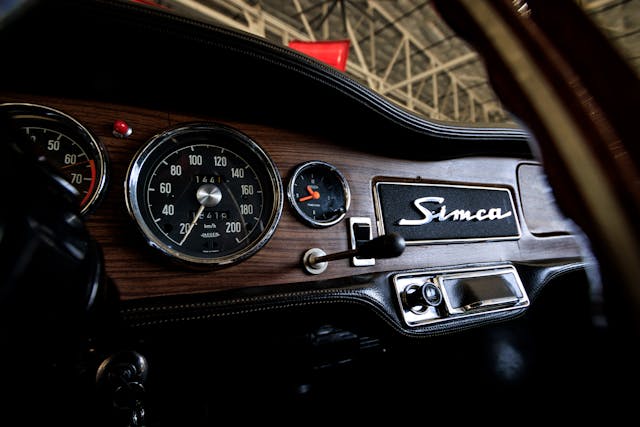

The Fulvia is more civilized around town, but the Simca rides a little more gently. “It’s hard to say how they would have compared new versus now, when they’re full of 50-year-old parts. Also, I haven’t fully wrung the Simca out at high speed yet.”
Skeel put on fatter tires on seven-spoke wheels gifted to him by a friend, added a Nardi wheel and a shift knob, and swapped the poorly running stock carbs for a pair of Weber DCOE 40s and a header. The car also benefits from some upgrades done during the restoration. “You can see a couple of places where they patched metal or used filler, but they also added dual-circuit brakes and the vinyl top, so we’ll call it even.”
He likes the 1000 Coupé as well, but Skeel definitely thinks Héreil’s brief was a good one. “You got a whole lot more performance for the money, plus, it just looks way cooler.”




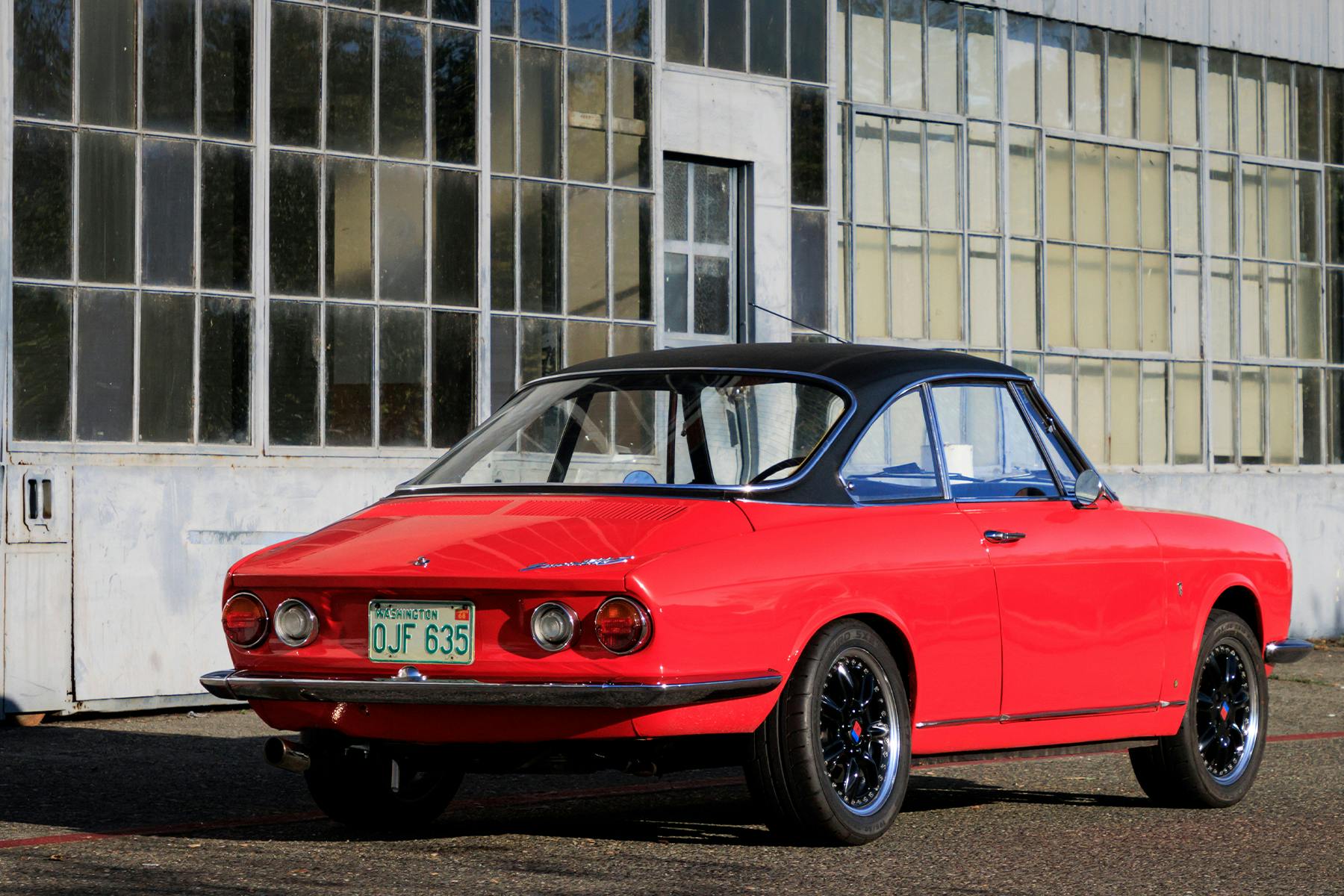
***
Check out the Hagerty Media homepage so you don’t miss a single story, or better yet, bookmark it. To get our best stories delivered right to your inbox, subscribe to our newsletters.
The post How three maestros of Italian car design shaped an oddball we nearly forgot appeared first on Hagerty Media.
]]>
In the summer of 1945, only a few months after Allied bombers stopped punishing Italy for its WWII transgressions, Enzo Ferrari summoned his trusted colleague Gioacchino Colombo to Maranello for consultations. Though postwar racing rules had not yet been announced, Ferrari was anxious to build his own cars to compete. Anticipating a 4.5-liter displacement for naturally aspirated engines and a 1.5-liter limit for supercharged powerplants, Ferrari sought the advice of one of Italy’s foremost engine designers.
Asked how he’d construct a new 1500-cc engine, Colombo mentioned ERA’s promising six-cylinder and eights under development at Alfa Romeo and Maserati before proclaiming, “In my view, you should build a 12-cylinder!”
The usually aloof Ferrari lit up like a Roman candle. Turns out the 47-year-old racing don had admired V-12s for years after hearing primo piloto Antonio Ascari rev the engine in his 1916 Packard racer and seeing WWI American military officers cruise Italy in their majestic Packard Twin Sixes. He and Colombo immediately began conceptualizing the Scuderia’s first V-12, the engine destined to become the Prancing Horse’s heart and soul.
Ferrari’s timing was perfect because Colombo had been laid off by Alfa Romeo due to Italy’s postwar economic turmoil. Though the 42-year-old lacked a formal technical education, he had served a lengthy apprenticeship designing engines, including V-12s, under Alfa Romeo’s brilliant Vittorio Jano. Colombo erected a drafting board in his Milan bedroom and in a few weeks completed sketches of both a new V-12 and the Ferrari 125 S sports-racer it would power. His guiding light was versatility in order to serve wide-ranging racing applications and eventual road use.

Packard’s 1916–23 Twin Six, the world’s first production V-12, made 88–90 horsepower from 6.9 liters. The beauty of a dozen cylinders in a V is perfect balance—freedom from the shake, rattle, and roll resulting from pistons starting and stopping at the ends of their strokes. (The same is true of an inline-six; a V-12 is simply two banks of six cylinders sharing a common crankshaft. A 60-degree angle between cylinder banks yields the even firing intervals necessary for smoothness.)
Before we delve into Colombo’s V-12 design features, it’s essential to understand the operational details within every four-stroke engine. First, there’s an intake stroke when one valve opens to admit air (and usually fuel) to a cylinder while the piston moves top to bottom. Next is compression, with both valves closed and the piston rising in the cylinder, squeezing the mixture. Near the top of the piston’s travel, electricity sent across the spark plug’s gap serves as the match to light the bonfire inside one cylinder. Rising combustion pressure within the cylinder drives the piston back down, spinning the crankshaft and driving the wheels through the transmission. Then comes exhaust, when the piston again reverses direction, forcing burned gases out an open exhaust valve and into a pipe connected to the cylinder head through an exhaust manifold. Simply described, the four-stroke cycle is suck, squeeze, bang, blow.

Given that each power stroke lasts the better part of 180 degrees, in a V-12, there are three overlapping power strokes at any given instance to run through all the cylinders in two turns of the crankshaft. As a result, output feels more like a continuous twist than discrete pulses. A V-12’s exhaust note can be whatever the designer desires, between a gentle purr and a coyote’s shriek.
V-12s do have several less sanguine design issues—added friction, heavier weight, higher cost, and their overall length. It goes without saying that when value and mpg are top priorities, carmakers steer clear of V-12s.

To minimize mass, Colombo chose aluminum over iron for the block and head castings. Italy had become an epicenter for bronze casting during the Renaissance back in the 14th century, specializing in statuary, equestrian monuments, cathedral doors, crucifixes, and even dishes.
Combining a 55.0-millimeter bore with a 52.5-millimeter stroke yielded the target 1.5-liter (1497-cc) piston displacement. Cast-iron cylinders wet by coolant were plugged securely into the bottom of the block with a shrink fit (achieved by heating the aluminum block to expand openings before inserting cold iron cylinders. Once the cylinders and block reach the same temperature, they’re securely locked together).
Bolts securing both the heads and the cylinders screwed into the block’s upper decks. Since the block’s side skirts ended at the crank centerline, the cast aluminum oil sump had ribs to radiate heat and to increase the engine’s overall stiffness. The crankshaft was machined from a single billet of alloy steel with seven main bearings and six throws spaced 60 degrees apart to provide even firing intervals. Connecting rods were forged steel.
One chain-driven overhead cam per bank opened two valves per cylinder through rocker arms. Locking screws touching the valve stems facilitated lash adjustment. (Lash is the small space in the valvetrain that allows each valve to seal tightly against its seat in the closed position.) The valves were splayed 60 degrees apart to straighten and streamline ports for maximum flow of air and fuel into each cylinder. A domed (aka hemispherical) combustion chamber topped each cylinder. Colombo screwed the spark plugs in from the intake side of the heads because the bore-center areas were blocked by the single overhead camshafts.

Three downdraft two-barrel Weber carburetors prepared ample amounts of fuel-and-air mixture. Twin Marelli magnetos driven off the tail end of each camshaft supplied the ignition energy. Initial output with a 7.5:1 compression ratio was 118 horsepower at 6800 rpm.
To provide a path to more power, Colombo gave his seminal V-12 three innovative features. The first was what’s known as an over-square bore/stroke ratio (a figure greater than one). The unusually short stroke diminished the pistons’ reciprocating motion, minimized the height of the block, and lowered the engine’s center of gravity. The relatively large bore in turn allowed larger valves (see end-view illustration), a boon to volumetric efficiency (fluid flow in and out of the cylinder head). The net result of Colombo’s over-square design was a rousing 7000 rpm available at the beginning of this V-12’s life. His second fundamental inspiration was 90-millimeter cylinder spacing to facilitate significantly larger bores and additional piston displacement with minimal changes to the overall design.

Colombo’s third special feature was the type of valve springs he incorporated. Instead of the spiral-wound coil springs that are now common practice, he used what was called a “hairpin” design (despite the fact they more closely resembled springs found in clothespins). He was inspired by air-cooled motorcycle engines, which used such a configuration for three key reasons:
The first is that the hairpin design was less susceptible to fatigue failure that, in the worst case, would destroy the engine when an out-of-control valve struck the top of a piston. Second, the hairpin design was a better means of exposing the valves to cooling air swirling over the top of the engine. Third, this design allowed shorter and lighter valve stems. Lighter valves are less susceptible to the fatigue failures common with racing cam lobes. In summary, the hairpin spring design was instrumental in helping Colombo’s V-12 withstand the rigors of racing. Two such springs were fitted to each intake and exhaust valve.

A paucity of intake ports was the most notable shortcoming in Colombo’s V-12. Since Ferrari hoped to add a Roots-type (twin interlocking lobes) supercharger, there were but three intake ports feeding six cylinders per bank. This arrangement made it more difficult to ram-tune naturally aspirated versions of the engine for competitive power at high rpm. (Ram tuning uses fluid-flow momentum to pack the maximum amount of air and fuel into each cylinder.)
With the ink barely dry on blueprints, Ferrari attacked the 1947 racing season with a two-seater dubbed 125 Spyder Corsa. The 125 code referred to the number of ccs per cylinder, spyder is Italian for roadster, and corsa is the boot country’s word for racing. Nine entries yielded two victories by Franco Cortese, two class wins by Tazio Nuvolari, one third, one fifth, and three DNFs. Adding a supercharger for its 125 Formula 1 single-seater yielded 230 horsepower and the Scuderia’s first grand prix victory. By October of ’47, Ferrari was ready to move up with a 1903-cc V-12 dubbed 159, followed by a 1995-cc 166 for the 1948 season.
The rising costs of fielding competitive cars in road races, endurance competitions, and F1 are what moved Ferrari to offer his cars to wealthy customers bent on enjoying them on the road.

In a 1984 test of the first 1947 Ferrari 166 Spyder Corsa delivered to a private owner, Car and Driver clocked 0–60 in 13.1 seconds and estimated top speed at 121 mph. Weighing less than 1500 pounds, this red roadster rode on skinny 15-inch Michelin X radial tires. Respecting the vintage Ferrari’s rarity and fragility, C/D’s test driver used only 6000 rpm, so a run to 60 in under 10 seconds is probably within the Spyder Corsa’s reach.
Bolting on a two-stage supercharger in 1949 raised output to 280 horsepower, earning Ferrari five grand prix wins. In spite of the Scuderia’s early successes, Ferrari demanded more; Colombo fell out of favor and returned to Alfa Romeo in 1951. His successors? First Aurelio Lampredi, a former aircraft-engine designer, then four years later Colombo’s mentor Vittorio Jano, who continued development of Ferrari’s first V-12 another decade.

Colombo’s masterpiece grew from its original 1498 cc to a maximum 4943 cc in its final Ferrari 412i form. The 1957 250 Testa Rossa brought conventional coil-type valve springs, spark plugs relocated to the outer side of the heads, and one intake port per cylinder. These changes yielded 300 horsepower from 3.0 liters, enough prancing horsepower to win 10 World Sportscar races, including three Le Mans 24-hour events between 1958 and 1961. Ferrari 250 GTO sports cars that followed won the FIA’s over-2-liter championship from 1962 through 1964. In 1964, a 4.0-inch stretch of the block increased bore-center spacing from 90 millimeters to 94, allowing 4.0-liter and larger displacements.
Features proved on the track rapidly trickled down to Ferrari’s road cars. Dual overhead cams, still operating but two valves per cylinder, appeared on the 1967 Ferrari 275 GTB/4. The illustrious 1968 365 GTB/4 Daytona came with dry-sump lubrication. (Keeping oil well away from a frantically spinning crankshaft eliminates what’s known as “windage,” frothing of the lubricant, which saps power output.)
In 1979, carburetors went the way of the buggy whip with the introduction of Ferrari’s 400i equipped with Bosch K-Jetronic fuel injection. This added power by diminishing the flow restriction that is imposed by carburetor venturis.
Ferrari’s 1985 catalog listed an amazing 75 60-degree naturally aspirated (no super- or turbocharger) V-12 engines designed over the previous four decades. The venerable Colombo stallion wasn’t dispatched to the glue factory until 1989, by which time Ferrari had shifted its focus to 180-degree (flat) 12s for the 365 GT4 BB (Berlinetta Boxer) and its successors. (They’re called that because the horizontal motion of the pistons resembles boxing gloves smacked together.) Even so, these new engines inherited their pistons and connecting rods from Colombo’s outgoing design.
The V-12 today


Fast forward to the March 2017 Geneva motor show. Although most makers follow new trends like a puppy locked on to a rabbit’s scent, Ferrari used this European gala to toast its 70th birthday with what it excels at building and selling: a fresh V-12 to power its new aptly named 812 Superfast sports car.
The first number in the 812 code refers to this engine’s peak power (in hundreds); the next two indicate the number of cylinders. Translating the 800 metric horsepower to imperial units yields 789 horsepower at a canvas-shredding 8500 rpm. A slightly revised version introduced in May 2021 tops 800 imperial horsepower.
What Ferrari achieved with its F140 V-12 was the most power ever packed into a production engine unaided by a turbocharger, supercharger, or electric motor. Add to that more than adequate torque: a peak 530 lb-ft at 7000 rpm. Those in the audience who favor the lower end of the tachometer will be happy to hear that a stout 425 lb-ft of twist is available at only 3500 rpm.
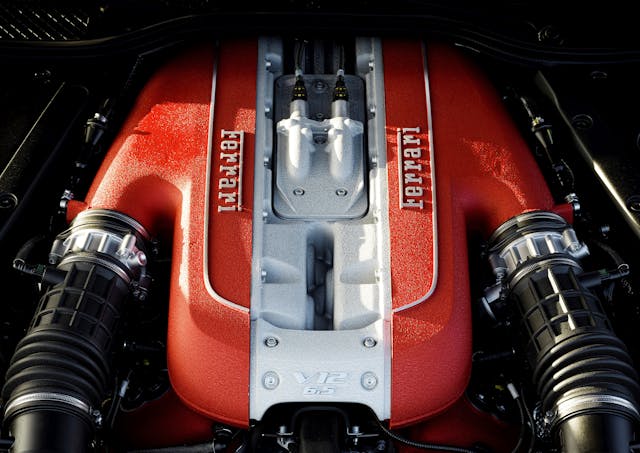
In keeping with longstanding Ferrari tradition, this is a Testa Rossa engine adorned with striking red valve covers and intake plenums. Naturally the bore/stroke ratio is markedly over-square, with a 94-millimeter bore collaborating with a 78-millimeter stroke to yield 6496 cc (6.5 liters). That 78-millimeter dimension ironically matches the longest stroke ever found in a Colombo V-12.
In contrast to the Colombo V-12s, the 812’s cylinder banks are spread 65 degrees apart. After Ferrari began using this angle in its 1989 Formula 1 V-12s, it trickled down to the 456 sports car in 1992. A 65-degree V-angle provides additional space for larger bores (more clearance at the bottom of each piston’s stroke), room between the cylinder banks for more voluminous intake manifolds, and a slight reduction in overall engine height. While it’s possible to maintain even firing with split-pin crank throws, Ferrari wisely avoided that potentially fragile complication. The result, with six straight crank throws, each carrying two connecting rods, is slightly syncopated firing intervals that alternate between 55 and 65 degrees of crank rotation. This subtle ticktock isn’t detectable from the driver’s seat thanks to Ferrari’s judicious powertrain isolation and intelligent acoustic measures.
Car and Driver’s 2018 test of a $465,509 Ferrari 812 Superfast reported a 3851-pound curb weight with a slight rear bias, 0–60 mph in a remarkable 2.8 seconds, and a quarter-mile clocking of 10.5 seconds at 138 mph. No one has verified the factory’s 211-mph top-speed claim, but that figure is certainly credible.
While all versions of the 812—GTS, Superfast, Competizione—cease and desist after existing orders are filled, Ferrari’s F140IA 65-degree V-12 will continue in the 2024 model year under the hood of the new five-door, four-seat Purosangue SUV.

Though Ferrari has boldly experimented with and/or produced engines with two, three, four, six, eight, and 10 cylinders, it’s most associated with V-12s thanks to its loyalty to that configuration for three-quarters of a century. There’s little doubt that 12-cylinder engines have been instrumental to Ferrari winning respect as a hypercar producer. Last year, the brand built and sold 13,221 cars worldwide, reporting 19 percent increases in both volume and revenue.
Count yourself fortunate if you’ve owned, driven, or even heard more than your share of prancing horsepower!
***
Check out the Hagerty Media homepage so you don’t miss a single story, or better yet, bookmark it. To get our best stories delivered right to your inbox, subscribe to our newsletters.
The post Epic Engines: How the V-12 became Ferrari’s heart and soul appeared first on Hagerty Media.
]]>

We hear it all the time: Getting kids involved in the classic car hobby is tougher than ever. How do you battle the high price of entry, especially when cost of upkeep, registration, insurance, and fuel incur their own demands?
Years ago, you’d have pointed your young classic vehicle fans to vehicles that existed on the margins: Four-door sedans and hardtops, station wagons, off-brand or weird stuff. But even these corners of the hobby have found an audience now, and the quality of collector car you can easily find for under a couple grand is pretty bleak.
There’s hope! Consider a fun, interesting, and darned useful wing of the collector vehicle marketplace that comparatively few people have explored: Garden tractors.
Look no further than your local Facebook Marketplace ads and you’ll find a garden tractor for sale that afford with returnable can money. Larger tractors like the Ford 8N have a passionate audience, but they do take up a lot of space, and they’re not cheap any longer. So, as Volkswagen used to say, think small.
Garden tractor enthusiasts prize their workhorses for their utility, but there are also contingents of fans that are using them for pulling competitions and for racing.

Lawn tractor or garden tractor?
You may not think so, but there is a difference between a lawn tractor and a garden tractor. Lawn tractors are more or less lawn mowers with a deck. They might have a bagger attachment on later versions, but their primary purpose is cutting the grass.
A garden tractor may indeed have a cutting deck, but it is also suitable for a range of attachments, from snowplows to snowblowers, and some might even have hydraulic buckets, three-point hitches, or PTO (power take-off) provisions for a wide range of light implements.
David Bradley and the garden tractor in America
You can’t talk about garden tractors—or any other kind of home implement from this period—without discussing David Bradley. Bradley was a manufacturing powerhouse at the turn of the 20th century, in the brick, lumber, and farm machine trades. In 1884 he purchased a plow manufacturing company, bought out his partner, and launched the David Bradley Manufacturing Company. In 1895 Bradley relocated the outfit to North Kankakee, Illinois, which was renamed Bradley City (shortened to Bradley by 1896) in his honor.
The bigtime hit in 1910, when he sold his manufacturing company to Sears, Roebuck and Company. For decades after, all of the home improvement equipment that Sears, Roebuck and Company sold was under the aegis of David Bradley: Lawnmowers, saws, utility trailers, rototillers, everything. Before there was Craftsman, there was David Bradley.

The David Bradley line of products included a garden tractor in 1958, and the company quickly became the world’s largest manufacturer of these little dynamos. In 1962, the David Bradley Manufacturing Company and the Newark Ohio Company merged under the latter’s name. Two years later, the Newark Ohio Company merged with the Geo. D. Roper Corporation, which went off producing its own brand of products, as well as those for Sears.
The Golden Era of garden tractors
Garden tractors really hit their stride as Americans pushed out from the cities into the suburbs and beyond. Wheel Horse began offering its small Ride-Away garden tractor as early as 1947, hitting its stride in the mid-1950s.
Based on the success of Wheel Horse and David Bradley, manufacturers like John Deere and Cub Cadet hit the scene in the early 1960s as the true golden era of the garden tractor really took off. From there, the list of garden tractor brands exploded, with entries from Colt, Economy, Ingersoll, Case, Oliver, Snapper, Simplicity and an endless array of other brands selling from bespoke agencies all the way to your local hardware store.
Gear drive or hydrostatic?
Outside of which brand of garden tractor you’re interested in, the big variable you’ll run into is the type of transmission.
Early garden tractors almost always had a conventional gear-driven transmission with a clutch and three or four speeds, sometimes with a low range for crawling and plowing. They’re simple and, with basic fluid changes, almost bulletproof.
A hydrostatic transmission uses hydraulic fluid in a variable displacement pump. While they operate on a completely different principle, you can think of a hydrostatic transmission like a continuously variable transmission; the engine turns at a constant speed while the operator sets the ground speed with a lever. Lacking a clutch pedal, they’re easy to operate and their ability to set a constant speed in small increments is suitable for lawn mowing, in particular.

A hydrostatic transmission, however, is less serviceable in the hands of a home enthusiast. And while they can operate a power take-off (PTO), they don’t transfer horsepower from the engine with the same efficiency.
So who are the big players? It’s impractical to cover all the brands in the mix here, but we’ll hit a few of the most popular with active club support and parts suppliers:
John Deere

Deere was kind of a Johnny-come-lately in the garden tractor market, but today it’s recognized as the leader—and for good reason. Its 1960s- and 1970s-era garden tractors are prized by collectors and still working hard in yards and small farms all over the country.
There are over 400 different models of John Deere garden tractors. The most iconic was the 300 Series. Built between 1977 and 1992, the 300 series began with the 312 with a 12-hp single, all the way up to the 332 with a 16-hp Yanmar three-cylinder diesel.
A running and operating 300 series today can range from around $400 for a running project 312 up to somewhere around $3000 for a nicely restored or original 322 with the Yanmar diesel.
Cub Cadet

International Harvester entered the garden tractor market in 1961 with a model that’s now come to be known as the Original, a small tractor powered by a Kohler 7-hp single. Since then, there have been hundreds of Cub Cadet models, but many collectors are interested in the pre-1981 garden tractors, built when Cub Cadet was still under the International Harvester brand, before the company’s sale to MTD.
Cub Cadet’s 100 Series was produced between 1963 and 1984 and featured engines from 10hp all the way up to 16 hp. The 149— built between 1971 and 1974—is relatively plentiful, has good parts availability and has the look of a peak period garden tractor. Attachments like plows, tillers, and buckets are available. You can find a running 149 in the $500 range. Fully restored tractors would set you back $1500–$2000.
Wheel Horse

Wheel Horse arrived early in garden tractor history when Elmer Pond began building small tractors in a barn in 1946. The brand made hundreds of models over the years, but enthusiasts are particularly interested in those built before 1986, when Toro purchased the company.
Most plentiful are the C-Series tractors built between 1971 and 1984. A good example is the C-160 featuring a giant cast iron Kohler 16-hp single and a four-speed (including reverse) gear drive transmission with a low range.

The pictured C-160 was recently purchased running and fully operating for $800 including the manual angle plow and tire chains for snow plowing. A nicely restored C-160 could run into the $1500–$2000 range, especially with attachments like snowblowers and tillers. There’s even a rare hydraulic bucket attachment that could easily double the price of a good tractor.
Ford

We mention Ford here mostly because the brand obviously crosses over with vintage car people and culture. Anyone with a first-gen Mustang would be proud to have a Ford LGT garden tractor in the collection. In fact, in Ford advertising the LGT 120 was referred to as the home improvement implement for “Mustang people with lawns.”
Mind you, Ford wasn’t a manufacturer of garden tractors. It contracted production out to a range of conventional garden tractor companies like Jacobsen and Toro before the brand was entirely replaced by New Holland in 1988.
Peak years for the LGT were between 1972 and 1983, with models ranging from the 12-hp LGT-12 to the 19-hp LGT-195. Depending on size and condition, you can find an LGT in the $500 range for a running and operating LGT-12, into the $1250 range for a nicely restored LGT-145.
Sears

After its initial lineup of David Bradley tractors, Sears, Roebuck and Company began offering the Sears ST line of tractors in the early 1970s, before it unleashed the GT series in 1985.
Like Ford, Sears wasn’t a manufacturer of tractors, but contracted with builders of some of the best equipment available at the time. The GT series in 1985 was produced by Roper and was—at the time—a pricey $2500, featuring an 18-hp Briggs & Stratton twin and a six-speed gear-drive transmission.
At one point, these tractors were known as the Craftsman II, and they came in a variety of sizes. They’re generally regarded as tough, solid tractors with a wide range of attachments.

If you’re on the hunt for a Craftsman tractor, you can find a GT 18 just about anywhere in the $1000 neighborhood, depending on the condition and the attachments it comes with.
For much more detailed information on vintage garden tractors, Tractor Data has tons of information on production history. Forums and Facebook groups for every brand and variety of garden tractor are a great resource for parts, tractors for sale and DIY information. Happy riding (and wrenching)!
***
Check out the Hagerty Media homepage so you don’t miss a single story, or better yet, bookmark it. To get our best stories delivered right to your inbox, subscribe to our newsletters.
The post Garden tractors are cheap, fun pathways to the vintage-vehicle hobby appeared first on Hagerty Media.
]]>
Car enthusiasts constantly daydream about owning this car or that car. But what about owning a car factory? If a full-service plant, from production line to paint booth, has been your wish list, today is your lucky day. Strange as it sounds, Stellantis will actually sell you one.
And not just any car factory either: a Maserati factory.


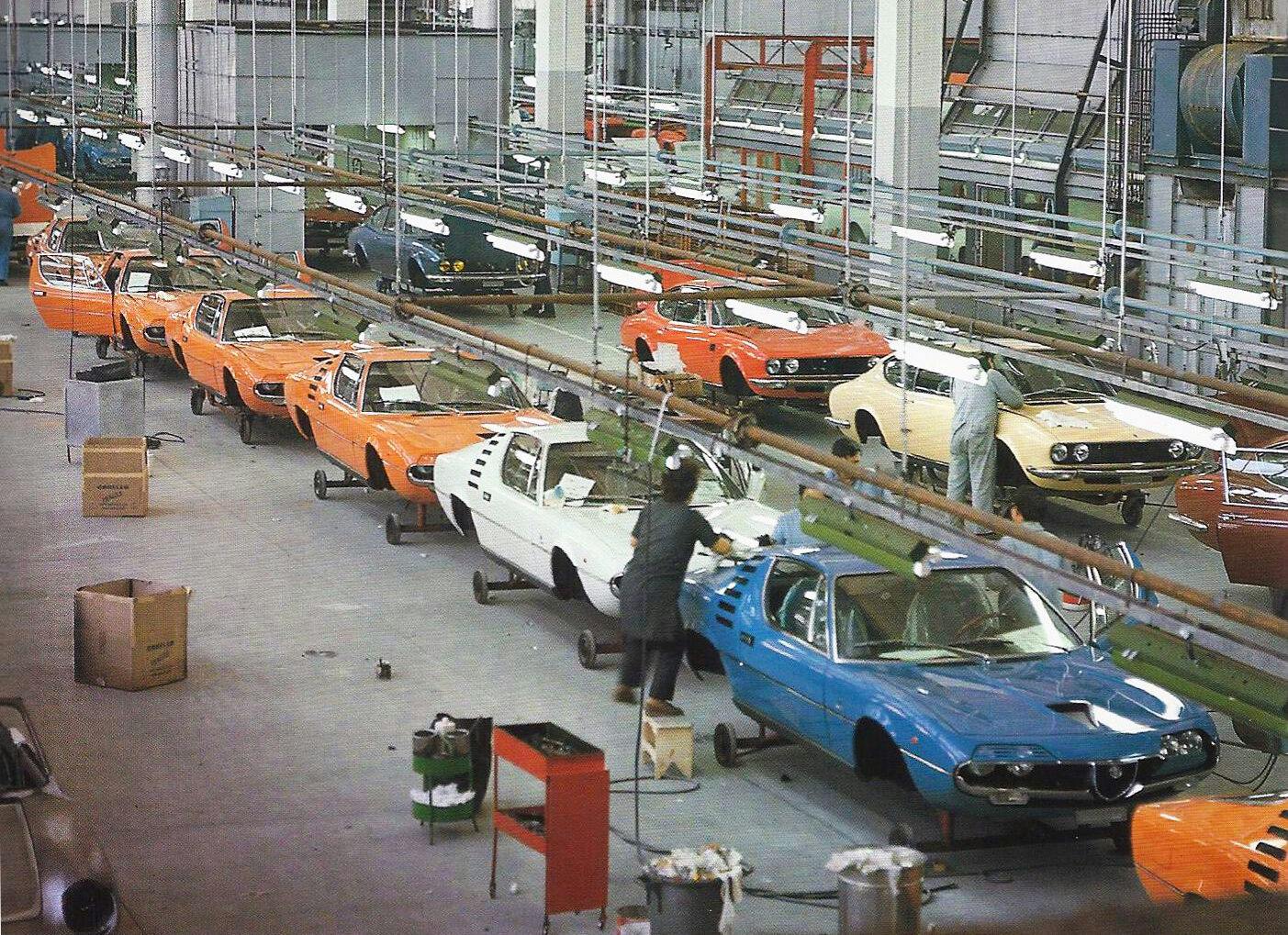
Currently listed on a popular online Italian real estate portal, the 1.2-million square-foot complex on the outskirts of Turin was the production site for the Ghibli and Quattroporte between 2013 and 2021. After that, assembly of these slow-selling sedans was moved elsewhere, leaving only a few residual operations onsite. But now, with both models heading to the great scrapyard in the sky by this year’s end, it means lights out for a factory complex whose history stretches back to the golden age of the Italian coachbuilding industry.
The story of the former Maserati factory actually begins 100 miles away, at Alfa Romeo’s Milan headquarters, in 1953. Alfa’s engineers were busy working on the new Giulietta sedan, whose launch was scheduled for the spring of 1954. However, due to some resonance issues within the car’s steel unibody that were proving tricky to solve, it looked like the Giulietta’s debut would have to be delayed.
That simply would not do, for one critical reason: The Giulietta’s development had been partly funded through bonds issued by Alfa’s parent company—the state-owned conglomerate Finmeccanica. Said bonds were marketed to small investors with the promise that a few lucky subscribers, drawn by lot, would be gifted a brand-new Giulietta. The government had no intention of backing out of its obligations.
To get out of this tight spot, Alfa greenlit the creation of a small batch of coupés whose bodywork—conveniently—demanded styling and construction by an outside supplier. In this case, the Turinese coachbuilder Nuccio Bertone.
The result was the beautiful Giulietta Sprint, penned by Franco Scaglione and presented at the Turin Motor Show in the spring of 1954. The public immediately fell head over heels for Alfa’s sweet little coupé, leading to an influx of orders that subverted Alfa Romeo’s small-batch plans and put Bertone under severe pressure.

Remember—the Sprint was meant to be a short-lived stopgap. No investment existed for tooling to manufacture such a car at scale. Each Sprint bodyshell was created by Bertone’s workers the traditional way, using hand-beaten panels, as it was customary for low-volume production. But with Alfa Romeo now demanding over 30 Sprint bodies per day to keep up with demand, Nuccio Bertone had to do the impossible. So he did.
By outsourcing Sprint body panels to craftsmen scattered all around Turin, while also hiring hundreds of additional workers, Bertone pulled off a miracle that could only happen in 1950s Turin: genuine human craftsmanship on an industrial scale. Around 6000 Giulietta Sprint had already been produced by the spring of 1958, turning Bertone from a simple coachbuilding atelier into a proper industrial complex. The company could now invest in tooling and transition from hand-made panels to pressed ones, all while building a new factory on a large plot of land in Grugliasco, a suburb on the outskirts of Turin.
Bertone shifted all its operations to the new facility between 1959 and 1960, and the move marked the definitive transition to spot-welded and pressed panels for all Sprint bodies. These moves led to a sharp increase in productivity, and by June 1961, the Grugliasco factory celebrated the production of the 20,000th Giulietta Sprint bodyshell for Alfa Romeo.

The success cut two ways. Such contract manufacturing arrangements, while lucrative, also placed Bertone at the mercy of the automakers it served. The Turinese firm styled the Giulietta Sprint’s replacement, but Alfa’s decision to build the new Giulia GT in-house sent Nuccio Bertone scrambling to avert the loss in production. He managed it, and then some, by smooth-talking Fiat’s management into a spider based on the small 850 sedan.

Penned by Giorgetto Giugiaro and presented at the 1965 Geneva Motor Show, the 850 Spider was a smash hit for Bertone. Despite the car’s diminutive size, demand for the 850 Spider from the U.S. pushed the Grugliasco factory’s output to over 100 car bodies per day. By the time production ended in 1972, over 130,000 850 Spiders had been made, of which about 92.000 went Stateside.


The little Fiat’s has a big claim to fame nowadays, in that it shared its headlights and taillights with the Lamborghini Miura. Again, the Miura bodies were built, painted, and fully trimmed at Bertone’s factory before going to Sant’Agata Bolognese to receive their engine and running gear. But perhaps the product most strongly associated with Bertone and its Grugliasco factory is another pioneering mid-engined car: the X1/9.
Much like the 850 Spider it replaced on Bertone’s production line, the X1/9 proved much more popular in America than in its native country. So much so, in fact, that once Fiat left the States in 1982, Bertone brought the model’s entire production process in-house and sold it under its own brand until the end of the decade.
Fortunes changed, however, and the subsequent 1990s and early 2000s marked a steep downturn for the Italian automobile industry. This, along with the emergence of more flexible production methods that enabled automakers to produce different models on the same assembly line, made it increasingly difficult for Bertone’s factory to secure work.

In fact, the Grugliasco plant stayed in business mainly because of General Motors’ largesse; three generations of Opel convertibles were produced in Turin between 1987 and 2005. Once the last Opel rolled off the line, the fate of Bertone’s manufacturing business was sealed. Few things burn cash quicker than a large factory with nothing to make.
In 2009, the late Fiat CEO Sergio Marchionne took over the idle, bankrupt Bertone factory to turn it into the launchpad for Maserati’s bold, if ultimately fruitless, assault on the luxury sedan segment. With the Grecale and Levante SUVs representing the brand’s near-term strategy, the Quattroporte and Ghibli are no more.

If it’s bought and turned into some clothing or food factory, I’d rather not see it. I choose to remember these soon-to-be-empty walls for what they are: a monument to one man’s vision in an unrepeatable era of Italian motoring history.
__
Matteo Licata received his degree in Transportation Design from Turin’s IED (Istituto Europeo di Design) in 2006. He worked as an automobile designer for about a decade, including a stint in the then-Fiat Group’s Turin design studio, during which his proposal for the interior of the 2010–20 Alfa Romeo Giulietta was selected for production. He next joined Changan’s European design studio in Turin and then EDAG in Barcelona, Spain. Licata currently teaches automobile design history to the Transportation Design bachelor students of IAAD (Istituto di Arte Applicata e Design) in Turin.
***
Check out the Hagerty Media homepage so you don’t miss a single story, or better yet, bookmark it. To get our best stories delivered right to your inbox, subscribe to our newsletters.
The post Historic Maserati factory, home of Bertone’s brilliance, is listed for sale appeared first on Hagerty Media.
]]>
A hundred years ago, in the sun-baked and forbidding loneliness of the Syrian desert, the bandits watched for prey. There, in the distance, a column of dust rising up from the dry and gravelly soil. Camel trains were easy pickings, and they sometimes carried smuggled gold. The men fussed with their ancient rifles and prepared to intercept. But something was off. The would-be quarry was approaching far too fast, there and gone again before the raiders had a chance. A convoy of Cadillacs, running hard at 70 mph, headed for Baghdad and too quick to catch.
In those early days of the twentieth century, motorized transportation revolutionized the world, and nowhere did the change come more quickly than in desert warfare. Lawrence of Arabia had his Rolls-Royce Ghosts—“More valuable than rubies in the desert,” he wrote of them—raiding the Ottoman Empire’s supply lines and then vanishing back into the desert. But when the war was done and the League of Nations had carved up that empire, there was further work to be done.
In Damascus, the French controlled Syria, linked via Beirut to the Mediterranean Sea. To the east, a British mandate held Iraq (then spelled Irak) and its capital, Baghdad. These were two of the most important cities in the Middle East, and there were no roads connecting them.

Baghdad in particular was a far-flung and lonely outpost for any fledgling British diplomat. Mail home to the UK was sent to a port on the Persian Gulf, then to Bombay in India, and up through the Suez Canal. It took an average of six weeks, meaning that it might be three months between writing a letter to your sweetheart and receiving the reply that she’d jilted you for Tim, who came from lots of money and only had to go over to Paris once a month.
Armored Rolls-Royce Ghosts had crossed deserts before, notably in the lightning raid carried out by the Duke of Westminster in WWI. Crossing 120 miles of what is now Libya, the Duke’s raiding force of nine armored cars destroyed a superior force and rescued two crews of British sailors that had been marooned and captured after a German U-boat attack.
Similarly, Field Marshal Edmund Allenby of the British Egyptian Expeditionary Force had used armored Rollses to explore east of Beirut in 1919. However, he never went further than the ancient city of Palmyra, scarcely a quarter of the way to Baghdad.

However, at this point in the story, two New Zealand-born brothers enter the picture. Both had served under Allenby in his motorized forces during WWI. They were experienced mechanics and entrepreneurs, and they even had the distinction of being the sons of the first person to own a car in New Zealand (for the historical trivia: it was a American REO).
Gerald and Norman Nairn stayed behind in the Middle East after being discharged from the British Army and set up a dealership. They knew that the automobile was going to change the way that the world worked, and there was a clear gap in the market in this part of the world. Besides which, owing to their connections at the army motor pool, they had a direct line on acquiring surplus military transportation as it was sold off.
Over the next two years, the brothers got rich quick, then lost it all. A depression in cotton prices saw the market for expensive luxuries like automobiles dry up. In late 1920, Norman and Gerry Nairn sold off what they could and briefly established a coastal taxi route running up to Beirut.

This effort was not a huge success but did get the attention of local officials. At the same time, a gold-smuggling sheik named Mohammad Ibn Bassam had contacted the British consul in Damascus with an idea. The sheik ran a surreptitious camel train between Damascus and Baghdad, paying off the bandits for protection along the way. But he thought cars could take that same route, including the entirely empty 500-mile stretch from Damascus to Ramadi, and cover it at great speed.
In 1923, the Nairn brothers assembled three cars—a six-cylinder Buick, an eight-cylinder Oldsmobile, and a Lancia—and outfitted them for a desert expedition. All three were loaded to the gills with tools and replacement parts, and a 10-day supply of food and water. Despite a late-night crash involving the Lancia, the trio covered the full 603-mile distance in just three days.
The next hurdle was convincing the very stubborn British High Commissioner of Irak that the crossing would be safe as a mail route. Eventually, with some assistance from Mohammad Ibn Bassam in bribing various bandits to leave the convoys alone, the Nairns had a contract for British mail from Baghdad to Haifa via Damascus. They began looking for the ideal desert-crossing machine, and that summer ordered a half-dozen seven-passenger Cadillac Type V-63 touring cars.
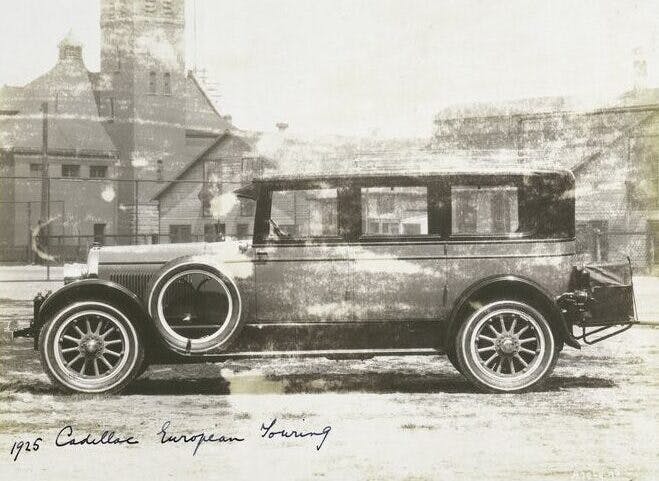
The V-63 may be thought of as the Escalade of its day, in that it was both luxurious and supremely capable. The 83-hp V-8 offered nearly triple the power of the expedition’s Buick, and the spacious body and long wheelbase provided plenty of room for necessary modifications.
Not that there were many. The middle seats were removed, to be replaced by a 16-gallon water tank (there was no water for hundreds of miles along the route). Auxiliary fuel tanks were also mounted to each running board, linked with the main tank via a revolutionary-for-the-time electric fuel pump. Some of the cars carried onboard refrigerators and were equipped with spotlights to pierce the desert night during the overnight trips required in the scorching summer months.
Right out of the gate, the Nairns’ mail service was a runaway success. Possibly due to the suspicions of the High Commissioner, the mail contract carried built-in consequences. Any mail arriving in more than 60 hours after setting out would result in the Nairn brothers being fined. But it never happened; the Cadillacs ran like clockwork, to the point that years later the Swiss watchmaker Felca advertised a wristwatch as the Nairn company’s official timepiece.

Which is not to say the crossings were boring. Despite the bribes, bandits did still sometimes give chase, though the convoys were armed and in at least once case chased down and captured the would-be robbers. The drivers were a collection of wild ex-pats, frequently having odd habits. One was a notorious drunk, hiding water bottles throughout the car, each one filled with Arak, the local anise-based liquor. Another had only one eye but used his Cadillac to chase down and shoot an Asiatic cheetah.
About 250 miles outside of Baghdad, vast mud flats were baked hard and smooth in the summer. Given even a light rain, however, they would become as slick as ice, and any driver swerving to avoid a suicidal impala would spin the car multiple times. Nairn drivers became so skilled and easy-going about the phenomenon that they would let the cars pirouette for a prolonged time, much to the chagrin of shocked passengers.
By 1927, the Nairn Transport Company had crossed the Syrian desert some 4000 times, without the loss of a single passenger. The Cadillacs had been sniped at from time to time, and even held up at least once, but every one of them survived, occasionally limping in with plugged bullet holes in their radiators.

The route had shifted and continued to shift based on rebellions and changing political alliances, but Nairn Transport persisted right up until the 1950s. By that time, transportation was done by truck and bus, with huge articulated machines incorporating air-conditioning. The Nairns finally sold off their business in 1959.
But it was the Cadillacs on which the Nairn brothers had built a reputation and changed the nature of desert transportation. Speaking to Veteran and Vintage magazine more than 50 years ago, Gerald Nairn described selling off the last of the Cadillacs in the 1930s.
“When we finally sold them they had clocked about 200,000 miles each, with only two major overhauls,” he said. “The Cadillac’s ability to take punishment was just amazing, and nothing I have seen since surpasses them for that. It was the Cadillacs that made us. They were the toughest cars I have ever seen, and for overland conditions they were without question the finest car in the world.”
***
Check out the Hagerty Media homepage so you don’t miss a single story, or better yet, bookmark it. To get our best stories delivered right to your inbox, subscribe to our newsletters.
The post When the Cadillac replaced the camel—the desert runners of the Nairn Transport Company appeared first on Hagerty Media.
]]>
The story of Ford getting close to buying Ferrari in 1963, only for Enzo to back out from the deal at the last moment and send the Americans back home empty-handed, is so widely known it even made it into a Hollywood movie. But what most people don’t know is that two decades later, Ford executives once again went on an Italian shopping trip. And this time, their target was Alfa Romeo.
By the mid-1980s, the increasing success of high-end European imports on the U.S. market sent Detroit automakers scrambling to capture some of that elusive Old World allure. GM famously established “the longest assembly line in the world” for the Cadillac Allanté, while Ford began marketing the German-made XR4Ti under the Merkur brand.
However, a more straightforward approach was possible. The Germans were going from strength to strength, but elsewhere in Europe there was plenty of fallen automotive nobility rich in cachet but starved for cash. Perhaps none more so than Alfa Romeo.


Founded in Milan in 1910, Alfa Romeo spent the first three decades of its existence gaining sporting success and international prestige while burning through prodigious amounts of money. In fact, by the time the Italian government nationalized it in 1933, Alfa had already flirted with bankruptcy at least twice. But even though there wasn’t much left of Alfa Romeo once the Allied bombers were done with it, the postwar years saw the Milanese company mount a phenomenal comeback, thanks to enlightened leadership and favorable circumstances.

Facing little direct competition in their home market, cars like the Giulietta and the later Giulia allowed Alfa Romeo to ride the wave of new wealth generated by the booming Italian economy. But the optimism of the 1960s led Alfa Romeo to embark on an overambitious expansion plan for the 1970s that backfired amidst socioeconomic turmoil, tanking productivity, and political meddling. As a result, by the end of that decade, the company’s financial situation had become untenable, and that’s when prestigious international consultancy firms were brought in to help draw up a strategy to get Alfa Romeo back in the black by 1985.
That year marked the 75th anniversary of Alfa’s founding. By then, the product range had been refreshed, and significant progress was made in terms of quality and productivity. Nevertheless, there was very little to celebrate about the company’s prospects, because it all proved to be too little, too late. Instead of breaking even by selling 307,000 cars as planned, Alfa Romeo in 1985 sold fewer than 165,000 cars and lost yet more money. But this time, its paymasters were running out of patience.
By the mid 1980s, even the byzantine realm of Italian politics wasn’t immune to the powerful winds of neoliberalist economic ideas blowing from across the Atlantic. In a moment when the state’s role in the economy was increasingly under discussion, Alfa Romeo’s endless plight led many to question whether the state had any business owning it in the first place.

Alfa’s management explored various possible industrial collaborations as an alternative strategy to the outright sale of the company. Still, the latter idea gained momentum following the explicit interest expressed by Ford in the spring of 1986. High-level meetings were held in Great Britain and Germany between April and June of ’86 to discuss the possible synergies between Alfa Romeo and Ford Europe’s future projects. Among the attendees was Domenico Chirico, the engineer then in charge of Alfa’s product development, who shared the story in his 2007 memoir L’Alfa e le sue auto (Alfa and its cars).
Alfa Romeo’s 164 sedan, designed on a front-wheel-drive platform shared with Fiat and then in the final stages of development, was not only to spawn a station wagon and a coupe but also a restyled Ford-badged derivative slated to begin production in Alfa’s Milan factory by 1990. The smaller Alfa 75 sedan (known to U.S. enthusiasts as the Milano) was expected to soldier on until 1992, to be replaced with an all-new model sharing Ford’s new FWD platform under development for the ’94 Mondeo/Contour sedan.

Alfa’s twin-cam four-cylinder engines, whose basic design was 30 years old and which were manufactured using obsolete tooling, were to be replaced by Ford units from the new “Zeta” family then under development. Interestingly, though, Alfa Romeo’s lusty V-6 engines were not only to remain in production but also would power several Ford models. Last but not least, Alfa’s long-serving Spider was to be replaced by an all-new model for 1993, developed in both Alfa and Ford versions.

But the sorry state of Alfa’s finances was no secret to anyone, and that’s probably the reason why in its takeover offer, formalized in September 1986, Ford committed to purchase only a 20 percent stake in Alfa Romeo, with the option of building up to a majority holding over the following three years and complete takeover five more years later. This meant that Italy’s state-owned conglomerate, IRI, would have had to remain invested in Alfa Romeo well into the 1990s, which would prove a decisive factor once Fiat entered the fray.
Keen to block such a large competitor from gaining a manufacturing stronghold on Italian soil, in October 1986 Fiat presented its offer for the complete and immediate takeover of Alfa Romeo. With a catch, though: Fiat would pay in five installments starting in 1993 and would only be liable for around 70 percent of Alfa’s considerable debt burden. Nevertheless, Fiat’s offer was formally accepted in November 1986, and Alfa Romeo ceased to exist as a corporate entity by the 1st of January, 1987. The rest, as they say, is history.

It’s impossible to say whether car enthusiasts would have been better served by an Alfa Romeo under Ford’s control. Although it’s fair to imagine that with access to Ford’s dealer network, Alfa Romeo never would have left the U.S. market, the rest is anyone’s guess. Still, it makes for an intriguing “alternate history” scenario as well as a piece of Alfa Romeo lore that’s all but forgotten, even in its home country.
***
Matteo Licata received his degree in Transportation Design from Turin’s IED (Istituto Europeo di Design) in 2006. He worked as an automobile designer for about a decade, including a stint in the then-Fiat Group’s Turin design studio, during which his proposal for the interior of the 2010–20 Alfa Romeo Giulietta was selected for production. He next joined Changan’s European design studio in Turin and then EDAG in Barcelona, Spain. Licata currently teaches automobile design history to the Transportation Design bachelor students of IAAD (Istituto di Arte Applicata e Design) in Turin.
Check out the Hagerty Media homepage so you don’t miss a single story, or better yet, bookmark it. To get our best stories delivered right to your inbox, subscribe to our newsletters.
The post Ford’s failed takeover of Alfa Romeo appeared first on Hagerty Media.
]]>
In England, we called it the Tin Snail. The Dutch likened it to an Ugly Duckling. At home in France, it was known as an Umbrella on Wheels.
We’re talking of course about the Citroën 2CV, which celebrates its 75th anniversary this month. While hardly flattering, these tongue-in-cheek monikers do give an idea of the fondness that the car cultivated around the world during its incredible 42-year run.
The 2CV mobilized a postwar population in France and beyond, spawned numerous versions, both practical and peculiar, and cemented Citroën’s reputation for innovation.
Today, the Deux Cheveux is an affordable collectible that can only continue to appreciate. But how did it all begin?

Citroën officially unveiled the 2CV—named for the French tax classification it met—in 1948 at the Mondial de l’Automobile in Paris, but the car was already almost a decade old by the time it finally made it to market. Design boss Pierre-Jules Boulanger had built several working prototypes of his TPV Très Petite Voiture (Very Little Car) before Germany invaded France in 1940. Determined that the Nazis wouldn’t get their hands on them, he hid them behind fake walls in the factory or in local haylofts where they remained until the end of the war.
The brief for what would become the 2CV was extremely simple. It had to be able to transport four passengers and up to 50 kg (110 lbs) of produce at up to 60 km/h (37 mph) across the worst roads and use only three liters of fuel every 100 km – an equivalent of 80 mpg US. Essentially, its directive was to be more reliable and cheaper to run than a horse and cart.
Meeting Boulanger’s expectations was no mean feat and required some very creative thinking.
Citroën engineers had been working with exotic materials such as magnesium and aluminum in their prototypes, but post-war reality meant that cheaper steel would take their place for the car’s simple ladder chassis and thin “upside down pram” bodywork. A water-cooled two-cylinder engine was also replaced with a Walter Becchia-designed 375-cc air cooled unit mated to a four-speed transmission. Boulanger was in favor of a three-speed for simplicity, but an extra overdrive gear would deliver the necessary fuel efficiency.
Boulanger had also specified that the car should be able to drive across a freshly-plowed field with a basket of eggs on the back seat without cracking any of them. That required some serious suspension ingenuity.

A torsion bar system linked front to rear provided a form of self-levelling, and also effectively lengthened the wheelbase on one side as the car negotiated a corner. There’s body roll aplenty, but the tires’ tiny contact patch remains in touch with the road.
A cost-saving effort meant the windscreen wipers were driven from the same cable as the speedometer and as a result, they only worked when the car was moving. Only the front windows opened, and they did so on a hinge rather than rolling down. The canvas roof could roll all the way back to aid cabin cooling, though. The rear bench seat could be removed to carry larger loads or serve as a picnic bench for a long lunch of baguettes, fromage and vin rouge.

Driving a 2CV is also an experience not to be hurried (despite what you may have seen in For Your Eyes Only), as even the most potent 602 cc versions produce just 33 hp. It’s wonderfully immersive, however, with the car’s eccentric simplicity fostering a joyful physical connection with the driver.
Firing up the twin cylinder engine immediately sends a lively chatter through the chassis, up the seat posts and into your derrière. The whole car thrums.
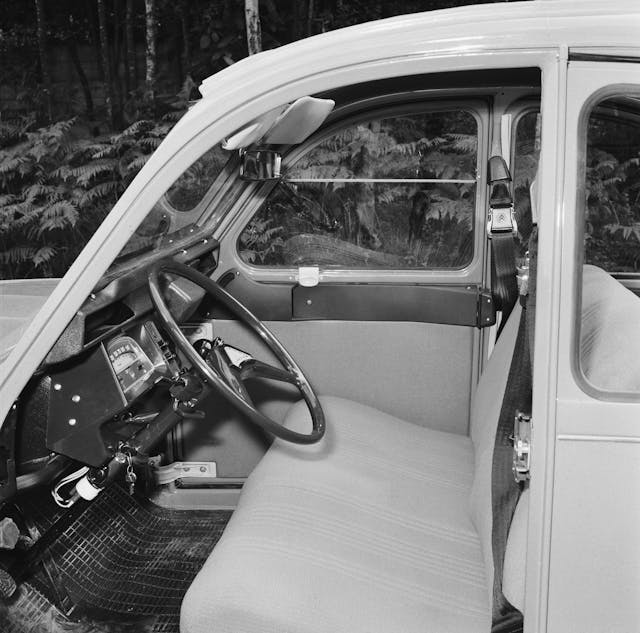

The dash-mounted umbrella-handle gear selector is far easier than it looks to get used to, with a dog-leg, low-ratio first gear and the remaining three forward gears in a standard H pattern. There’s quite a long throw to it, but also a mechanical satisfaction to gear selection that could almost be compared to an open-gated Italian ‘box.
The large, thin steering wheel requires a bit more effort than you might expect given the skinny tires, but once you’re rolling it lightens up to the point of being rather vague at higher speeds. Going downhill with a stiff breeze following, I’ve done an indicated 80 mph in a 2CV, but it’s much happier at the 40-50mph mark.
Although accompanied by an assortment squeaks, the suspension does a fine job of cushioning the ride, albeit with alarming roll angles through corners. Think of it as the opposite of a motorcycle—embrace the lean and a 2CV can actually take bends at considerable speed—much to the surprise of the drivers that were glued to your back bumper on the preceding straights.
A 2CV is best enjoyed on a sunny day or starlit night, with the roof folded back and the side windows open as you soak up its Gallic charm.

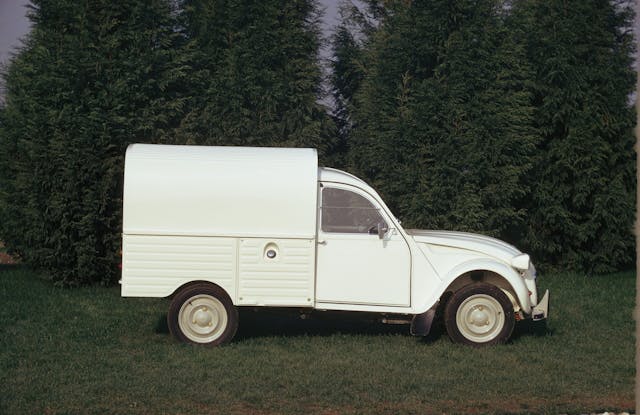
But which 2CV, or 2CV derivative is for you? In total more than nine million were made between 1948 and 1990, so you do have a few options. Almost four million of those were sedans, but 1.3 million Fourgenette vans, 1.8 million Amis and 1.4 million of the more upmarket Dyanes were also built. Then there were a quarter million Acadiane vans, a further 145,000 Meharis and nearly 700 twin-engined Sahara 4x4s. The 2CV and its assorted spin-offs were assembled as far afield as Argentina, Uruguay, Chile, Yugoslavia, Germany, Ivory Coast, Senegal, Indonesia and Iran.
This quirky car of the world has been gradually appreciating, but yet to really rocket in value. A #1 concours edition car from 1949 is worth $51,800 according to Hagerty Valuations, while you might find a still driveable car from the same year for as little as $11,000– less for later models. Even the rare Sahara, which would set you back $157,000 for a Condition 1 example has only seen a single-digit rise in the last year.
As it passes 75 years, now might just be the time to go for a little escargot.
***
Check out the Hagerty Media homepage so you don’t miss a single story, or better yet, bookmark it. To get our best stories delivered right to your inbox, subscribe to our newsletters.
The post After 75 years, is now the time to buy a Citroën 2CV? appeared first on Hagerty Media.
]]>
Search for “all-wheel-drive Corvette” and you’ll get pages and pages of results pointing to the new, hybrid C8 Corvette E-Ray, which has an electric motor powering the front wheels in addition to the V-8 combustion engine driving the rears. You might also find any one of a number of C3 Vette bodies mounted, monster truck–style, on 4WD SUV or truck chassis. If you dig deeper, though, you’ll discover that more than 30 years ago, General Motors made a pair of nearly production-ready Corvette concepts with all-wheel drive baked into their designs, and just like the AWD E-Ray, they were also mid-engine cars. Those vehicles would be the 1986 Corvette Indy and 1990 CERV III concepts.

If you’re pedantic, as I am, though, you might quibble with calling them the first all-wheel-drive, mid-engine Corvettes, because another predates them. The CERV III concept was the last of a trio of experimental mid-engine performance cars developed under the direction of Corvette chief engineer Zora Arkus-Duntov. CERV originally stood for Chevrolet Experimental Research Vehicles and was the appellation used for the Corvette team’s forays into mid-engine design, starting with the CERV I in 1962, which was GM’s version of the mid-engine open-wheel racers then starting to dominate Formula One and soon to win at Indianapolis with a Ford-powered Lotus.

CERV I had a conventional rear-wheel-drive layout, but CERV II was not just the first mid-engine car out of the Corvette program with four-wheel drive, it may well have been the first car in general with that layout and drive configuration. The U.S. Patent and Trademark Office certainly thought it was novel, granting Duntov a patent. Perhaps it was too novel. With a torque converter and two-speed Powerglide transmissions at both ends of the longitudinally mounted V-8, I don’t believe any other car, concept or production, has ever had a similar drivetrain.

If the CERV II may look a bit like it could have competed with the Ford GT40, there’s good reason, because that’s exactly what Duntov and Chevrolet general manager Semon “Bunkie” Knudsen had in mind: taking it endurance racing at Sebring and Le Mans. Whether or not Knudsen and Duntov had gotten word of the GT40, the project started in 1962 and was completed in 1964. Larry Shinoda, who drew the 1963 Corvette, and Tony Lapine, later head of styling for Porsche, were responsible for the styling of the body wrapped around the aluminum monocoque. The original plan was to build six of them for a team of three cars, but then the word came down from GM brass to get out of racing, at least publicly.

Some of that technology, though, made it out the back door of GM’s Tech Center. If the work of Shinoda and Lapine also makes you think of Jim Hall’s Chaparral racers, the resemblance may not be a mere coincidence. Hall had a close relationship with GM’s skunkworks, which got around corporate rules by testing cars at Hall’s Rattlesnake Raceway near Midland. Midland, Texas, that is, not Midland, Michigan—far from Detroit’s prying eyes. The Chaparral 2A was pretty much a reskinned Grand Sport II, which was developed at the same time as the CERV II, and shared much of its technology. Besides the Chaparral’s aerodynamic wizardry, they were revolutionary for using automatic transmissions, just like the CERV II, only just one per vehicle. Hall is reported to have had seat time in the CERV II during its development.

It would be more than two decades before another mid-engine, all-wheel-drive Corvette would make an appearance.

By the mid 1980s, General Motors owned Lotus, and working with Lotus Engineering it developed a 2.6-liter twin-turbo V-8 capable of 600 horsepower. It’s not clear if GM ever intended to go racing with that engine, but 1986 was the same year the production Corvette was chosen to be the pace car at the Indianapolis 500, and that engine was theoretically the basis of a sensual concept called the Corvette Indy. The Indy had all the bells and whistles: a composite monocoque; a long and lean but muscular carbon fiber and Kevlar body designed by Chuck Jordan and Tom Peters; four wheel steering-by-wire; ABS and traction control (remember, this was almost 40 years ago); electronic throttle control; and active suspension. That last was supplied by Lotus in addition to the engine work.
It’s not clear exactly how engineers effected all-wheel drive in a car with a transverse V-8 mounted midship and a transmission aft of the engine. They would have had to route power around the engine or have a second drive off of the flywheel. Remember, though, this is a company that used a chain drive and an oil sump with a hole through it for an axle shaft in the original FWD Cadillac Eldorado. I’m sure they figured out a way to get motive force to the front wheels.

HVAC and infotainment controls were mounted on the scissor doors, which when closed formed the Indy’s panoramic roof. Inside was a center-mounted CRT display with an early navigation system. It took just six weeks for Peters and Jordan to go from drawings to a full-size clay made by Cecomp in Turin. That was a pure show car, which may explain why there were no functional side windows, or much interior space. Reaction to the show car was, however, strong enough that the Corvette team made two more Indys, a fiberglass pushmobile for the show circuit and a functional one used for testing. Instead of a screaming, small-displacement twin-turbo proposed for the concept, the engineering car had the Lotus-designed 32-valve DOHC 5.7-liter V-8 later used in the C4 ZR1, with 380 horsepower. Said to be capable of 180 mph, the working Corvette Indy is in GM’s corporate collection, while the clay mockup is at the National Corvette Museum in Bowling Green, Kentucky.

Although the Corvette Indy was not a practical vehicle, GM seems to have given actual thought to producing its offspring, the CERV III, revealed at the 1990 Detroit auto show. It spiffed up the Indy with a more exotic mix of composite materials, this time including Nomex, and suspension pieces made of titanium. A CRT display was controlled by something that could probably operate a gamepad and there was a cassette-based moving-map nav system, again years before GPS was available for civilian use. Mechanical improvements were two Garret T3 turbos that upped engine output to 650 hp, a three-speed Hydramatic turned into a six-speed, and dual brake discs at each wheel.
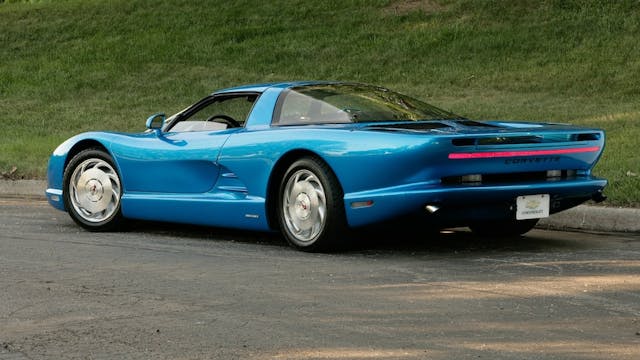
Styling changes also indicate at least some consideration for production. The nose was shorter than the Indy’s and higher off of the ground, to comply with federal bumper height requirements. Side glass was shaped so it could go down and wheel arches provided enough clearance for real world suspension travel. Like the Indy, the CERV III had scissor doors, only with with a conventional roof, whose profile was shared with the production C5 Corvette. Capable of 225 mph, 0–60 mph in under 4 seconds, and able to pull 1.1 g on the skidpad, the CERV III had supercar performance for its day. Two things kept it from production, though. GM executive Mark Reuss said that the early, 1990-era computer-controlled active suspension had too much latency, and GM bean counters said they’d have to charge between $300,000 and $400,000 at a time when a base Corvette coupe was $32K and a ZR1 was $59K. Like CERV I and CERV II, CERV III is in GM’s corporate collection.
It’s conceivable that GM could have made a simpler, less expensive version without all the gizmos, the steering by wire, four-wheel steering, trick brakes, expensive four-cam aluminum engine, etc. And the world would have seen a mid-engine corvette decades before the C8. By then, however, GM managers decided to go with the legacy front-engine layout and instead make incremental improvements in the C5 Corvette.
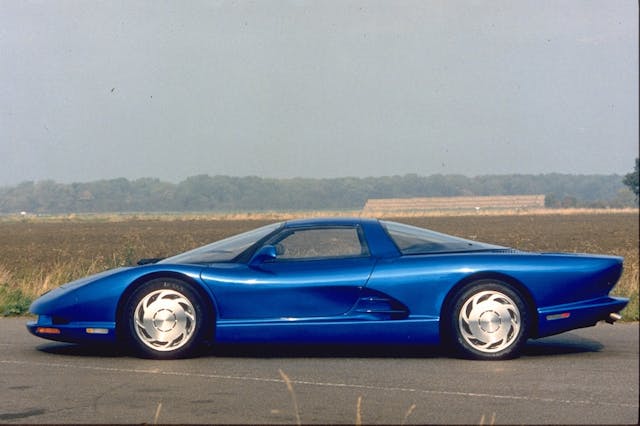
















***
Check out the Hagerty Media homepage so you don’t miss a single story, or better yet, bookmark it. To get our best stories delivered right to your inbox, subscribe to our newsletters.
The post No, the E-Ray isn’t the first Corvette with all-wheel drive appeared first on Hagerty Media.
]]>
Imagine, if you will, a week-long drive of 6320 miles—L.A. to New York and back again—on the move all the way without so much as a gas stop or a pause for a traffic light. Would such a journey require supernatural intervention? Is it technically impossible? Or could the imagination, determination, and technical skill of an inventor and gregarious character named Louie Mattar be sufficient to pull it off?
Louie Mattar grew up in Detroit, of course. Anyone who would attempt a bizarre automotive stunt like the one he accomplished in September 1952 had to have some Motor City brew in his veins. A respected engineer and inventor, Mattar developed numerous devices for automakers and the U.S. military, including a mine sweeper for the Navy. But his greatest achievement was undoubtedly the extensively modified 1947 Cadillac Fleetwood that he designed and built over a period of years, constantly altering it to make it ever more capable, self-sufficient, and complex. That was the car in which he and two pals made their epic two-way cross country journey. As if L.A. to New York and back without stopping wasn’t adequate proof of the Caddy’s capability and the team’s endurance, they followed up two years later with a continent-bisecting non-stop drive from Anchorage, Alaska, to Mexico City.
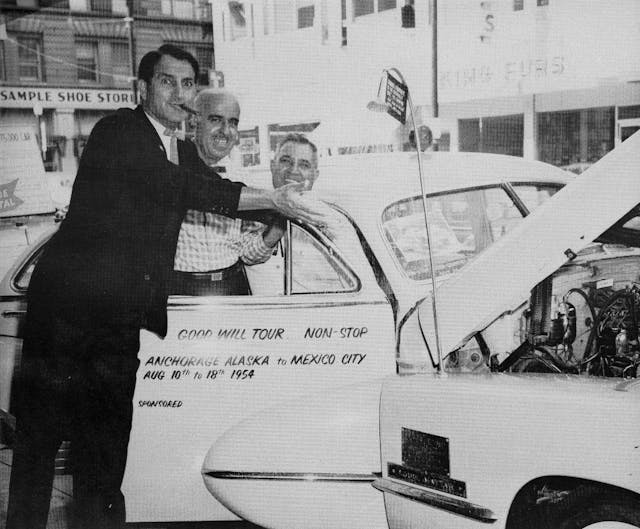
Now, Mattar didn’t spend the entire 6320-mile trip behind the wheel, since he shared driving duties with his two fellow travelers, but the journey had to be debilitating as the Cadillac never came to a halt, with the three men changing positions while on the move. Escorted through traffic lights and stop signs by local authorities, the adventurers and their big Caddy never stopped rolling down the road. That’s not exactly perpetual motion, but it’s about as close to it as a car can come.
The Cadillac’s original purpose wasn’t mileage marathons. Mattar built it for camping, with on-board systems that would make a week or two in the wild enjoyable without other support. So, some of the first accessories he created for the Cadillac were geared toward living in the car. Of course, there was a chemical toilet and a shower. But Louie believed in camping in style, so the car boasted a television, a refrigerator, a kitchen sink, and a bar. Also installed was a mobile telephone capable of communicating nationwide when conditions were right via base stations located strategically throughout the country. A tank in the car held 50 gallons of water. Mattar installed an ironing board, iron, and washing machine, despite Mrs. Mattar’s contention that laundering while on a camping trip wasn’t necessary. But it might be necessary on a non-stop cross country trip, and that goal soon became Mattar’s obsession.






To stay on the move for more than 6000 miles, Mattar had to invent ways to maintain the car and refuel it on the go. Retractable platforms attached to the sides of the car enabled two of the three travelers to work under the hood while the third member of the team drove. Windows in the hood meant the driver could see the road ahead even when the hood was raised. A trailer towed behind the Caddy sported a patio of sorts at its rear for relaxation and for entertaining the journalists who hopped on board when Mattar drove slowly through towns. An intercom system enabled communication between the car and the patio.

The trailer wasn’t meant solely for entertainment. It carried spare tires and parts, another 30 gallons of water, 15 gallons of motor oil, and 230 gallons of gasoline. That wasn’t enough gas for the entire journey, but it was enough to ensure the car would only have to be refueled three times. Those refueling stops weren’t stops, either. They were executed on the move at airfields along the way, much like jet fighters are refueled in the air. Power for the Caddy’s many accessories and tools was provided by specially built batteries with a total capacity of 1500 ampere hours. An engine-driven 90-amp generator charged the batteries.
Frequent oil changes were standard maintenance in the ’50s, with a generally recommended interval of 2000 miles. Mattar went one better and developed a system that would automatically change the oil every 1000 miles—while the car was moving, of course. Another system automatically topped off the radiator when necessary.

On a 6000-mile journey in those pre-interstate days, given the frequent road hazards and the tire composition of the time, flat tires were inevitable, so a system had to be developed that enabled changing a tire without stopping. Because both car and trailer were equipped with side-mounted platforms, the travelers could move from car to trailer when a replacement tire or other gear was needed. To enable removal of a tire while on the go, a hydraulic jack with a wheel on its shaft raised the offending tire while the car was moving. A wider platform was attached to the car next to the wheel, and the tire’s lug nuts were spun off with an electric impact wrench. Squatting precariously on the platform with the car rolling along at about 15 mph, one of the men would lift the tire off the hub and hand it off to another member of the team, who would in turn pass along the new tire. Once installed, the tire would be fully inflated by an engine driven compressor that delivered air via a conduit in the axle and wheel. A regulator at each wheel controlled tire air pressure. In a YouTube video, a somewhat rotund and balding Mattar can be seen easily handling the heavy tire and wheel as he demonstrates how to swap out a tire on the go.
Mattar spent seven years and $35,000 creating this one-of-a-kind machine in the garage that housed his San Diego auto repair business. He funded the project himself—quite an achievement since that figure equates to more than $400,000 today.



The mechanics of the vehicle weren’t the only obstacles to completing a non-stop cross-country journey. Non-stop meant non-stop, and Mattar had no intention of pausing for red lights or stop signs on the roads he travelled, so he had to make advance arrangements for police escorts through the towns that dotted the U.S. highway system of 70 years ago.
Louie Mattar died in 1999 at the age of 89, and his “Fabulous Cadillac,” as he appropriately called it, is now the property of his grandson, Dan Mattar. The car has been on loan to the San Diego Automotive Museum for the past 24 years and is on display. If your next road trip takes you to Southern California, plan a visit to the museum where you can see the ultimate road trip vehicle of 70 years ago. Louie Mattar would have liked that.


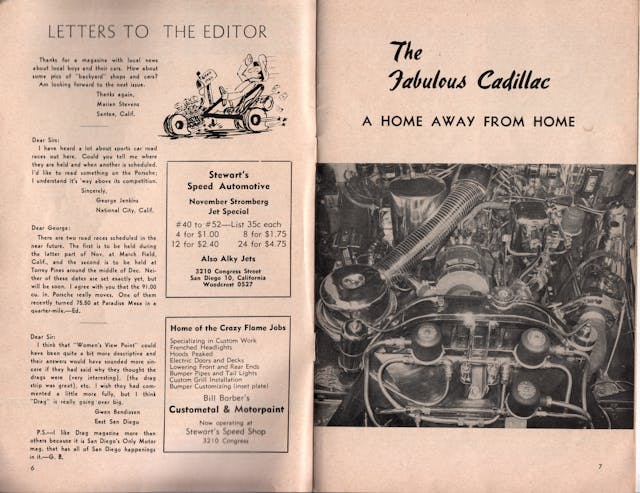
***
Check out the Hagerty Media homepage so you don’t miss a single story, or better yet, bookmark it. To get our best stories delivered right to your inbox, subscribe to our newsletters.
The post More than 70 years ago, Louie Mattar drove 6320 miles non-stop in his fantastic perpetual motion machine appeared first on Hagerty Media.
]]>
“First,” when it comes to automobiles, is tricky to define. Who should we credit with the first front-wheel-drive (FWD) automobile: the inventor, the person (or company) who first conceived of the technology? The first person or company to build a functioning FWD vehicle? The first to bring a practical vehicle to market, regardless of sales volume, or the first to find market success with the idea? As with many inventions, each of those questions may have a different answer.
Here is your primer to America’s first front-wheel-drive automobiles, focusing on the two vehicles that lay claim to the title: The Cord L-29 and the Ruxton.
Front-wheel drive, est. 1770

For a feature that’s been sold as a modern advancement since Saabs and the original Mini came on the market, front-wheel drive is quite old. You might be surprised to find out that it dates to what is considered the earliest self-propelled vehicle, the steam-powered, three-wheeled carriage made by Frenchman Nicolas Cugnot in 1770 for hauling freight. (He devised a scaled-down prototype a year earlier.)
In 1894, a fellow countryman named Lepape introduced a front-driven, rear steering vehicle that could either carry passengers or pull trailers and carriages. George Selden, who tried to monopolize automobile manufacturing under a patent that was successfully fought by Henry Ford, introduced a car with a gasoline engine, mounted on the front axle, that drove the wheels through spur gears. Electric front-drivers were made by Barrows and Morris-Salem before the turn of the 20th century. Other brass-era FWD cars were the 1900 Auto Fore-Carriage, the 1901 Phelps Steam Carriage, the 1901 Tractomobile Steam Carriage, 1904 Healey & Co. electrics, and the 1905 Cantono Electric.
Refining FWD on the race track
Perhaps the most notable early FWD pioneers were J. Walter Christie and Harry Miller, who both proved their designs in racing. Christie, who is perhaps better known for designing military equipment like gun turrets and a tank track drive and suspension that was used by many of the combatants in WWII, first patented his front-drive design in 1904. His actually predicted how many FWD cars are laid out today, with a transversely mounted four-cylinder engine, and the transmission and final drive behind the engine driving the front wheels via short drive shafts.
Christie used universal joints because that was about the only way, in his day, to allow the suspension and steering to work. However, U-joints are not ideal in a front-wheel-drive application because the speed of the output side varies as the joint operates. Not for decades after Christie’s patent would constant velocity joints be developed.
Christie founded the Christie Direct Action Motor Car Company, ostensibly to go into the taxi-building business. He only built three taxi cabs, however, before turning to competition. He built seven racers, all with front-wheel-drive systems of his own design and powered by two-, four-, and eight-cylinder engines, including V-4s and V-8s. With almost three-quarters of the cars’ weight on the front wheels, they had plenty of traction but were rather difficult to drive.

That didn’t stop people from wrestling the cars to speed records, though. In 1907 a Christie race car claimed the dirt track mile record of 69.2 mph, and on the Indianapolis Motor Speedway’s newly brick paved track, a Christie vehicle set the record for the flying mile at 97.6 mph. Years after Christie’s company had given up on making taxis and turned to military gear, in 1915 racing hero and daredevil Barney Oldfield (“My only life insurance — Firestone Tires”) went 113.9 mph on the board track at Tacoma, Washington, in one of Christie’s front-drive racers. A year later he set a new lap record at the IMS at 102.6 mph.
Harry Miller’s name is truly legendary in American racing, though ironically he may be best known for an engine that bears another man’s name: Offenhauser. In the early 1930s, when the American Power Boat Association tried to control Depression-era racing costs with a new 151-cubic-inch displacement class, Miller chopped his DOHC inline-eight in half. Though the resulting four-cylinder was not lightweight, the engine’s advanced valvetrain made it popular with auto racers. When Miller’s company became insolvent, his employees Fred Offenhauser and Leo Goossen continued its development, turning it into a mainstay of American open-wheel racing into the 1970s.
Not as well known as the “Offy” engine is the fact that Miller raced front-wheel-drive cars at Indy for 25 years. In 1924, driver Jimmy Murphy came to Miller with the idea that by using front-wheel-drive and eliminating the driveshaft to the rear axle, he could mount the heavy engine and transmission lower and build a race car that would corner better due to a much lower center of gravity. Following the lead of FWD pioneer Ben Gregory (most notable for his design of the aluminum-intensive Mighty Mite mini-jeep for the U.S. Marines), Miller used a de Dion front axle and then designed a novel, compact transverse transaxle incorporating the transmission and final drive in one unit. The resulting vehicle did not have the weight balance problem of Christie’s earlier racers, was just 36 inches tall (4 inches shorter than a Ford GT40), and weighed just 1500 pounds. A second Miller FWD car placed second at the 1925 Indy 500, averaging just over 100 mph.

The design was so sound that one of Miller’s FWD cars raced actively for more than two decades and his FWD cars raced fairly successfully at Indy for 25 consecutive years. In 1928, Leon Duray set a world’s closed-course record of 148.17 mph in a Miller FWD at the Packard Proving Grounds (a 2.5-mile track very similar to the Indianapolis Motor Speedway) outside of Detroit , a record that held for 24 years.
Harry Miller was also behind one of the most beautiful racers ever, the FWD Ford V-8 race cars that Miller teamed up with Preston Tucker and Henry Ford to build. Unfortunately, schedules didn’t allow sufficient development. The unfettled cars all DNF’d, greatly embarrassing Ford, which permanently killed the project.

Traction Avante-Garde
Meanwhile, back in France, Jean-Albert Gregoire and Pierre Fenaille developed the Tracta constant velocity joint and introduced it in 1926. Instead of the rather primitive universal joint, which has two yokes joined by a gimbal, a CV joint has inner and outer faces, like a ball bearing, only instead of smooth surfaces, the races have grooves across their faces with balls that lock the races rotationally but allow the joint to flex. As the name implies, that keeps the rotational speed of both parts the same. European makers Bucciali, DKW, Adler, Imperia, and Rosengart adopted it for their own FWD cars. Of course, the most successful early FWD to use CV joints car was the Citroën Traction Avant, first introduced in 1934, which went on to sell over three-quarters of a million units.
The first American car to use constant-velocity joints, the Cord L-29, wasn’t as big of a sales success as the Traction Avant: Cord sold a little over 5000 examples. Introduced, as the name suggests, in 1929, the L-29 beat the front-wheel-drive Ruxton to production by a matter of months. The Ruxton barely made it to market, with less than one hundred estimated to have been built. Fewer than 20 remain today.
At this year’s Eyes On Design at Ford House, one of the premier auto events in Detroit, the theme was Design Revolution. With their unconventional drive layouts and low-slung bodies, the L-29 and Ruxton were logical entrants. While the Cord is one of the mainstays of the pre-war classic-car scene, at least on this side of the Atlantic, a Ruxton is a rare sight. Seeing the two front-wheel-drive pioneers side-by-side is an even rarer opportunity.

More details on the lesser-known Ruxton to follow. First, let’s get a brief synopsis of the first Cord-branded car, America’s first production front-wheel-drive automobile.
Cord L-29: A case of bad timing

While front-wheel-drive was seen as an advancement in technology, the first makers of those vehicles harkened back to the horse-drawn era in their advertisements. The Cord L-29 owner’s manual exclaims, “This car is not an experiment. In drawing the burden instead of pushing it, it simply reverts to the natural method of moving a wheeled conveyance.” Putting the horse before the cart, so to speak.
Advertisements listed the advantages of FWD—some of them practical, some of them at least a bit hypothetical, including reduced steering effort and strain on the springs, chassis, and body; reduced thrust on front wheel bearings; reduced likelihood of skidding; improved tire wear; and better body stability with reduced pitching.

In any case, with all the genuine technological advancements needed to make FWD vehicles, it seems that the primary motivation of automakers to build FWD passenger cars was styling freedom and user convenience. The lack of a driveshaft and rear differential means that the body of a FWD car can sit lower on the chassis, giving the vehicle sleeker styling and making it easier to enter and exit. In the case of our Cord, the fact that the drivetrain would incorporate a straight-eight engine from Lycoming (part of E.L. Cord’s industrial empire) behind the transmission and final drive at the front of the car meant the hood and cowl would be stretched out, making the L-29 look even sleeker.

Errett Lobban Cord was a very smart and successful businessman, a pioneer in many industries. He was smart enough to know who to hire. When he wanted the Auburn company, which he controlled, to have a luxury brand, he brought the Duesenberg brothers under his corporate umbrella. He hired notable designers like Alan Leamy and Gordon Buehrig to design Auburns, Cords, and Duesenbergs. Likewise, when he wanted to make FWD cars, he turned to the person in America with the most experience with that drive layout: Harry Miller.
Cord bought the rights to adapt Miller’s race car design to road-going automobiles. However, he soon discovered a couple of things that are still true today: Racing technology doesn’t always work on the streets, and function doesn’t always follow form. Leon Duray, one of the era’s leading race car drivers, suggested to Cord that he contact one of Miller’s competitors, Cornelius W. Van Ranst, because Van Ranst’s FWD Detroit Special racer was considered easier to drive. Cord hired Van Ranst to design a FWD passenger car. To give some indication of his power as an industrialist, he sent Van Ranst out to California to supervise the prototype’s construction, a process supervised by none other than Harry Miller and Leo Goossen. The L-29 still ended up using Miller’s basic layout, with a de Dion axle and inboard drum brakes.

Despite VanRanst’s contributions, the first prototype of the L-29 was difficult to drive. The turns at Indianapolis Motor Speedway are wide and sweeping, and they do not expose the limits of U-joints: Streets with acute corners and tight parking spots do. After switching to the newly available constant velocity joints and fixing other problems with the initial design, VanRanst was made chief engineer of Cord. Though it’s celebrated today as a pioneer, the L-29 was, VanRanst felt, a bit cobbled together. Using an engine designed for rear-wheel-drive and mounting it longitudinally in a FWD layout means putting the flywheel and output shaft on the front of the engine, thus making access to the timing gears and chain difficult—not a big deal today, but a huge inconvenience in an era when things needed frequent adjustment and replacement. Putting the transmission and final drive in front of the engine also created issues with weight distribution. Conventional parts were adapted to reduce costs, but there were still many bespoke components for the L-29.

The 298-cubic-inch engine produced 125 horsepower. Period publications gave the L-29 a top speed of anywhere between 77 and 90 mph, I suppose depending on the testing conditions. Despite Cord’s claims that it produced better traction, the long drivetrain resulted in too much rear-weight bias and the car struggled to climb hills.
Still, the long hood, and rakish stance made a good canvas for in-house body engineer John Oswald, with Alan Leamy adding touches like the radiator grille. Factory bodies included a six-window sedan, a four-door brougham, a convertible sedan, and a convertible coupe. Coachbuilders like LeGrande, Murphy, LeBaron, Hayes, Weymann, and others made L-29 bodies for the carriage trade.

E.L. Cord hoped to sell 5000 L-29s a year but unfortunately, he introduced the car with a price of $3095 to $3295 … in September, 1929. That works out to about $56,000 in 2023 dollars—well out of economy-car territory, but not prohibitively expensive. The problem was that the new Cord was introduced just a month before the stock market crash that brought on the Great Depression. Fewer than 800 were sold in the first year, and just over 5000 were produced during the three years that the L-29 was in production. To give you some perspective, slightly fewer than 3000 Bricklins and about 9000 DeLoreans were made. While not a sales success, the Cord L-29 was certainly a historically notable car.
Ruxton: A shaky foundation
While the Cord L-29 was the result of an automaker trying to expand his product line, the idea for Ruxton didn’t originate at a car company, but rather at a supplier hoping to sell components to automakers. That explains the Ruxton’s convoluted history, which includes being named for someone who ended up having nothing to do with the vehicle.
The father of the Ruxton was William J. Muller, who worked in the experimental department of the Edward G. Budd Company. In the early days of the automobile, most car companies did not make their own bodies; they bought them from suppliers like Budd (now part of Germany’s ThyssenKrupp group), Murray, Briggs, or Fisher Body. The Budd company was founded by its namesake along with engineer Joseph Ledwinka, a distant relative of the better-known Hans Ledwinka, of Tatra renown. Budd and Ledwinka met while working at Hale & Kilburn company where they pioneered the method of pressing body panels out of steel. In 1912 they set up their own company in Philadelphia, adding power hammering, drawing, and stretching to the body-building process. When the Dodge brothers started making their own cars in 1914, it was Budd who supplied the body panels.

By 1920, the Budd company was well established enough to have an experimental department, which Muller joined that year, after spending some time in motorsports. Aware of Harry Miller’s racers, Muller thought that the FWD concept would work for road cars, and in 1926 he suggested to Edward Budd that the company develop a front-wheel-drive system that it could then sell to one of the larger car companies. Budd was so enthusiastic about the idea he directed Muller to do more than develop a drivetrain: He wanted Muller to build a completely functional prototype that could be used as a demonstrator.

Joe Ledwinka was brought into the project to design and engineer the bodywork of the prototype. Starting with a set of sedan body stampings supplied by the Hupp automobile company, Ledwinka channeled the body, much as hot rodders and customizers would do decades later. The new body was almost a foot lower than that of a typical sedan, meaning the team could get rid of the running boards as well. The result was a sleek, modern-looking car whose novelty was emphasized by custom Woodlite headlamps, which were offered as an option. Sometimes described as “cat-eye” headlights, the Woodlite’s elliptical design was supposed to reflect more light forward but in fact they worked worse than conventional round headlamps.
The Budd prototype was powered by a six-cylinder Studebaker engine driving through a Warner three-speed transmission (though Muller was working on an in-house design for the production gearbox). Revealed in 1928, the prototype received considerable praise—enough for Budd board member Archie Andrews to take notice.
A Wall Street trader, Andrews was one of the Budd firm’s major shareholders and a man with a seemingly deserved notorious reputation. While Edward Budd was out of town in early 1929, Andrews got Muller to transport the prototype from Philadelphia to New York City, where Andrews hoped to use it to raise money to start a car company to put an entire FWD car into production. Andrews didn’t have a factory, so he made a deal with Hupp to develop and produce the car.

To improve traction by shortening the drivetrain, Muller devised a novel transmission that located first and reverse gears in front of the differential and second and third gears between the final drive and the engine. Unfortunately, the deal with Hupp lasted only one month: Not only did Andrews have to find another manufacturing partner, but he also needed investors, so he incorporated a new company called New Era Motors. While publicizing the new company, Andrews took pains to note that the new car would not be branded New Era—it would be named after a potential new investor. The mystery created even more publicity.

The investor that Andrews had in mind was William V.C. Ruxton, a Wall Street banker with what today we would call name recognition. Andrews and Muller showed Ruxton the prototype vehicle. Ruxton expressed enough interest that some kind of deal was agreed between Andrews and Ruxton. To Ruxton’s chagrin, however, Andrews immediately announced that the new car would be named after the investor, who was apparently unaware of Andrews’ branding plans. Ruxton not only withdrew from the agreement but he also sued Andrews, unsuccessfully, over the car’s name.
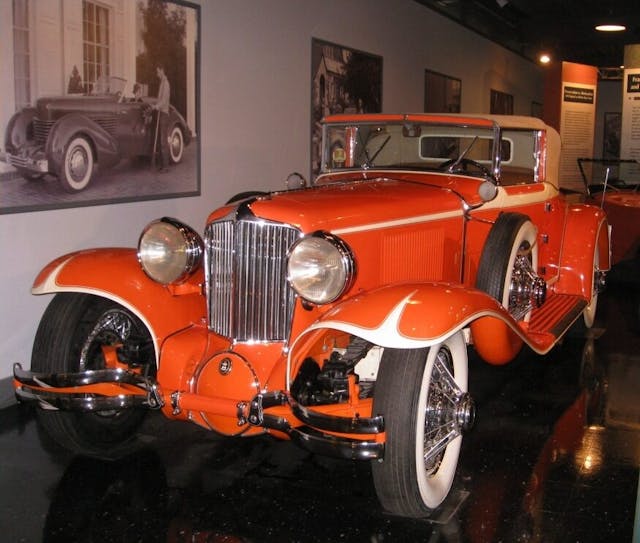
With a respected, but not quite authorized, brand name in hand, Andrews started a widespread publicity campaign, with a four-page advertisement reading, “Utterly Different is the Ruxton and Ten Inches Lower than Any Other Motor Car.” The timing of the campaign was entirely coincidental: Andrews had no idea the Cord L-29 was going to be launched just a month later, or that he differences between the use of Muller’s design and Harry Miller’s patents meant that the Cord wouldn’t be quite as low as the Ruxton. While Archie Andrews may have beaten E.L. Cord to the market, it was the L-29 that started production first. In fact, the Ruxton was lucky to start production at all.

Production of the Ruxton was delayed because Andrews still had trouble finding a company to make the car. Deals with both the Gardner Motor Company and the better-established Marmon firm fell through. Relations with the Moon Motor Car Company of St. Louis were cordial until a dispute led to Andrews manipulating Moon stock, buying it, dumping it to drive down the price, and then buying it back. The dispute eventually resulted in a standoff between Pinkerton security men hired by Moon and the St. Louis police backing Andrews. The dispute was somehow settled in Andrews’ favor and he took control of Moon.
Andrews was obviously a better promoter than manufacturer. He asked designer Joseph Urban, famous for his Broadway set designs, to come up with bright, multicolored schemes for the exterior paint, and Schumacher of New York City was commissioned to supply the interior fabric and upholstery.

A second prototype with a Baker-Rauling roadster body was shown at the New York Grand Central Palace auto show at the end of 1920, followed by three additional Ruxtons displayed at the Chicago Auto Show in early 1930 and an Urban-liveried model at the 1930 New York Auto Show.
While Andrews’ advertisements claimed an initial production run of 12,000 cars by the end of 1929, series production had still not started by New Year’s Day 1930. Production was further delayed because parts ordered earlier were rendered obsolete by Muller’s continued development of the drivetrain.
In finalized production spec, the Ruxton was powered by a straight-eight made by Continental, displacing 4.4 liters and making 100 horsepower—nothing to sneeze at in the early 1930s. Standard bodies included the Baker-Raulang roadster and a sedan sourced, a bit ironically, from Budd. The price of both models was $3195, comparable to that of the Cord.
As he was promoting the as-yet-unnamed automobile, Andrews tried to drum up publicity by using a big question mark as the hood ornament on the original prototype. Once it was named Ruxton, the car got a proper mascot: a griffon radiator cap, and a griffon badge on the radiator cowling. Even the Woodlite headlights were customized with subtle griffon wings. The mythological griffon, which combined a lion with an eagle, was said to guard treasures and priceless possessions.
Moon Motor Company did not have the capability to take the Ruxton to series production, but that didn’t matter, in hindsight: The stock market crash of October 1929 would soon arrive. Andrews, true to character, sought to exploit the financial collapse.
Andrews’ latest, and last, partner would be Kissel, who originally was contracted to make the Ruxton drivetrain components. Soon after agreeing with Andrews to produce the Ruxton for Moon Motors, the Kissel brothers (George and Will) discovered that Andrews was up to his old schemes: He wanted to take control of the Kissel company. The brothers snookered Andrews by placing their company into voluntary receivership, forcing Moon Motor into bankruptcy. New Era Motors filed for insolvency less than a week later.
Despite financial shenanigans and a shaky foundation, the few automobiles produced by Ruxton were pretty good cars. While the Ruxton brand pretty much killed their company, George and Will Kissel kept their personal Ruxtons, which they continually praised.
Based on period publications it was originally thought that perhaps as many as five hundred Ruxtons had been built, but brand specialist and historian Jim Fasnacht says that no more than 96 were produced and even some of these were completed after the bankruptcy of Moon and New Era Motors. It is now thought that no more than 40 Ruxtons were actually sold to customers. Nineteen Ruxtons are known to have survived.











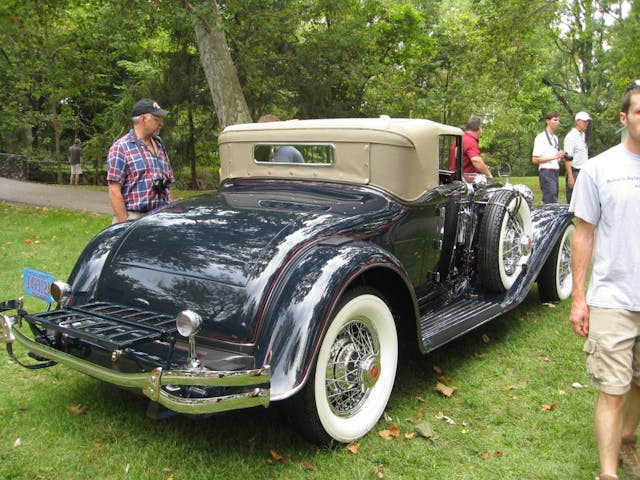












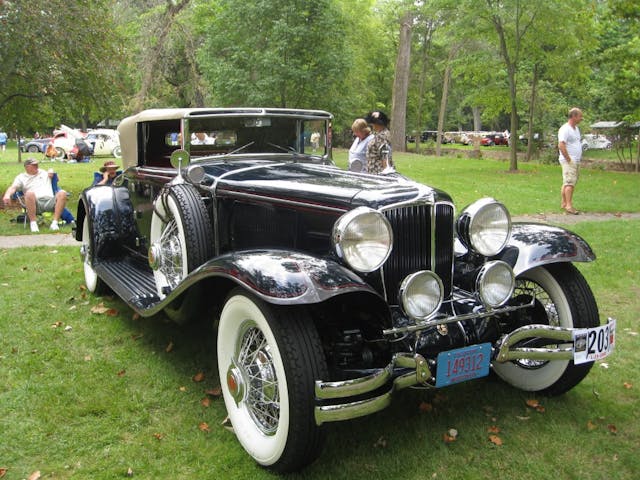

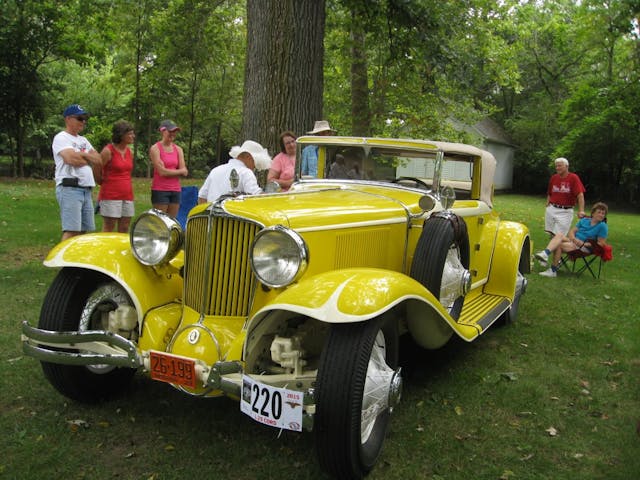


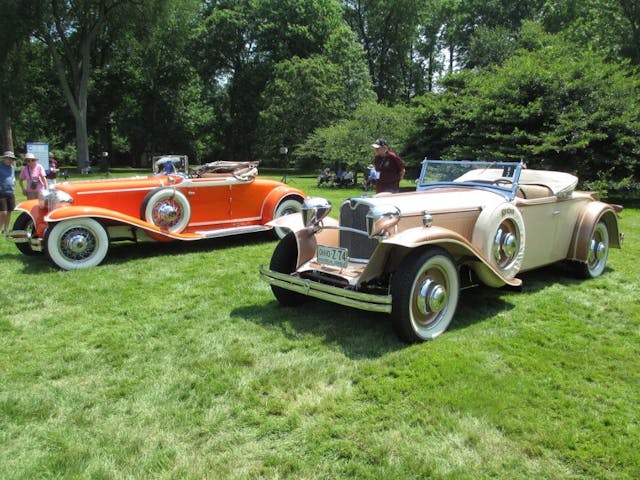






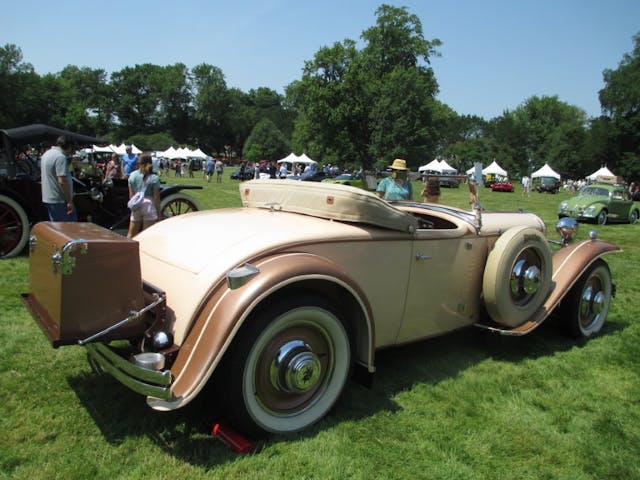
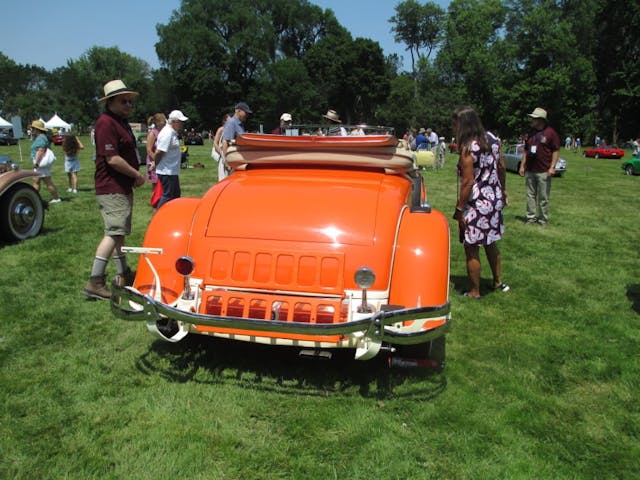
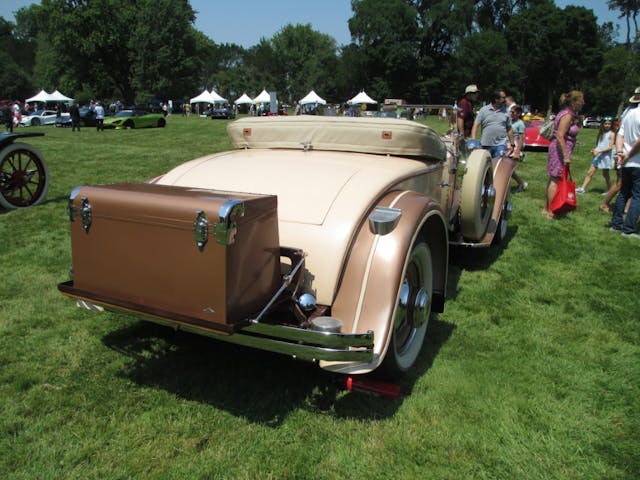



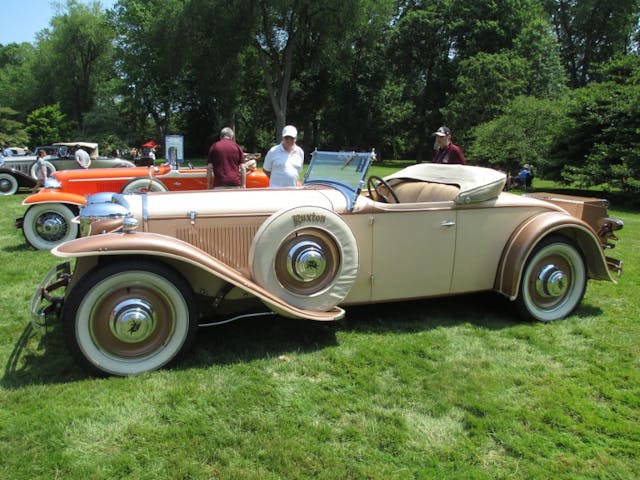


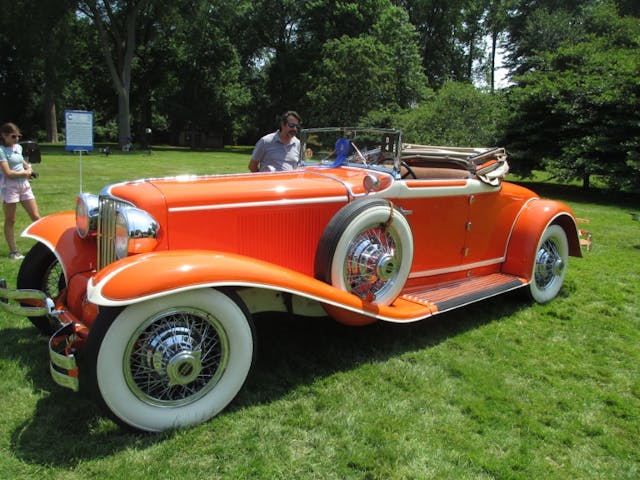












***
Check out the Hagerty Media homepage so you don’t miss a single story, or better yet, bookmark it. To get our best stories delivered right to your inbox, subscribe to our newsletters.
The post How well do you know America’s first front-wheel-drive cars? appeared first on Hagerty Media.
]]>
The Swedes arrived in Pyongyang in the winter of 1975, but they were well used to the cold. Then in his 20s, Swedish diplomat Erik Cornell was at first excited by the prospect of being one of the only westerners in the hermit kingdom of North Korea. Largely shut to the world since the end of the Korean War, North Korea held an unknown potential. Sweden had gambled, sending industrial equipment and a thousand Volvos, as well as its diplomats. But as of 2023, the country has yet to pay for those Volvos.
The Swedish embassy was a first for the West, and for more than two decades, it was also an only. No other western country bothered to open an embassy in North Korea, and that country’s relations outside of the Soviet Bloc remained strained—as they are today.
Cornell soon discovered that there wasn’t much to do in Pyongyang, other than drive his Volvo around. The country felt empty. But Sweden toughed it out, maintaining the contact even as repeated requests for payment went ignored.

In retrospect, Sweden’s gamble doesn’t seem that absurd. While North Korea was still relying on foreign aid in the 1970s, it’s not like South Korea wasn’t also benefitting from western support. Just look at something like the Genesis G90 as an example of how western aid funneled into South Korea paid off with a strong, industrialized economy. In a different time, betting on North Korea might have paid off, too.
As a Scandinavian country looking to make inroads into untapped markets, Sweden’s efforts in North Korea were full of possibility. Contracts were signed for mining equipment, and for those thousand Volvos. All told, the purchase orders were worth $70 million.
On paper, everything made sense. In the 1970s, Volvo was still expanding into the U.S. market, with advertising that basically made fun of Detroit’s planned obsolescence. Volvos were tough and practical, the copy claimed. I mean, we drive them in Sweden, where the winters and roads are terrible. Just imagine how long a 144DL will last on properly plowed interstates. Why buy a new car every couple of years?

For North Korea, a nation beginning to develop its industrial base, a rugged little Swedish sedan was just the ticket. No wonder Pyongyang was so eager to buy shiny new Volvos by the hundreds. This first purchase would surely lead to more, a thriving Korean-Swedish partnership where prosperity would lead to better East-West relations.
In some alternative universe, it’s possible that’s exactly what happened, and Kim Jong Un is driving his daughter to riding lessons in an XC90, instead of taking her to watch ICBM launches. In this world, however, Swedish optimism was met with a reality as cold as a Pyongyang winter.
North Korea’s rulers either wouldn’t or simply couldn’t part with the $70M in cash. The first thousand Volvos, a mix of 140-series and the then-new 240-series, were also the last thousand Volvos. They were distributed to those loyal to Kim Jong Il’s ruling party and became a status symbol.

North Korea has never had an abundance of personal automobiles, and it certainly didn’t in the 1970s and 1980s. When limited tourism opened up in the late ’80s, tourists on highly supervised excursions started noticing something odd in the background of the photos they were allowed to take: Everything they were shown was spotlessly clean and well-ordered—a model kingdom—but what’s the deal with all the old Volvos?
Volvo’s American PR team wasn’t making things up when it touted the longevity and durability of Swedish cars. Boxy old Volvos really were built tough, and while parts availability was an obvious challenge in North Korea, the cars just kept going. And Sweden kept asking to be paid for them. Twice a year, the Swedish government sends an invoice to the North Korean government, and twice a year it is simply ignored. The process has an odd formality to it, almost as if it is required etiquette.

With interest, the amount now owed is up to $322M, although some of that is for the mining equipment (which seems to have never been used). Sweden’s chances of being paid for its Volvos are essentially zero, although Volvo itself was reimbursed by the Swedish government long ago.
As the years have progressed, the ubiquity of Volvo 140 sedans in Pyongyang has faded. Even an old Volvo isn’t immortal, and the cars are approaching their 50th birthday. They also seem to not quite hold the status they once did, and are most commonly used as taxicabs and the like.
Hopefully, the North Koreans preserve at least one of these 140s and put it in a museum. As it turns out, they are not just unpaid-for Volvos, but a curious and vital form of car-based diplomacy.

By taking a gamble that didn’t pay off financially, Sweden established a certain level of trust with North Korea that is unmatched by any other western power. The North Koreans see the Swedes as trusted brokers, able to bring both sides of a disagreement together without Pyongyang losing face. Sweden serves as the protecting power in North Korea for the U.S., Canada, and Australia. When a citizen of those countries gets in hot water in North Korea, the Swedes are often able to set up a solution.
This kind of trusted communication between an isolated nuclear power and those it sees as adversaries is invaluable. Viewed in those terms, even the bill for a thousand Volvos is worth letting go.
Or rather, it was probably worth the cost of those Volvos for Sweden to establish a relationship. The bill for the Volvos itself, delivered twice a year, is a gentle reminder. Of course you can trust Sweden, North Korea—you’ve been driving its cars for 50 years.
***
Check out the Hagerty Media homepage so you don’t miss a single story, or better yet, bookmark it. To get our best stories delivered right to your inbox, subscribe to our newsletters.
The post How a thousand unpaid-for Volvos created a diplomatic bridge between Sweden and North Korea appeared first on Hagerty Media.
]]>
V-6 engines can be found nearly everywhere, from the new Ferrari 296 GTB to Dad’s old minivan. But despite this engine configuration’s relative ubiquity, few enthusiasts know its story began with a young engineer’s work in war-torn 1940s Italy.
Francesco De Virgilio was hired at Lancia in February 1939, where he quickly made a name for himself thanks to the improvements he devised for the Aprilia’s “sliding pillar” front suspension. His work on engines began in early 1943, following the transfer of Lancia’s technical staff to the northeastern city of Padua, away from the Allied bombing raids that had severely damaged Lancia’s factory in Turin.
During their stay in Padua, Lancia’s engineers resumed work on a new 39-degree V-6 engine they had conceived in the fall of 1942. Although the idea of a V-6 wasn’t entirely new, no one had yet solved the balancing issues associated with this configuration, which had never been used in series production. Upon reviewing that V-6 prototype’s crankshaft design to decide whether it deserved a patent application, De Virgilio realized it was fundamentally flawed and generated unacceptable vibrations. This prompted painstaking research into the optimal V angle and crankshaft design for a well balanced V-6 engine.
By August 1943, after having gone through all possible configurations, De Virgilio singled out eight crankshaft designs: four with a 60-degree angle between the cylinder banks and four with a 120-degree angle. Once the idea of a 120-degree V-6 was discarded as impractical due to its width, what emerged was a 60-degree V-6 equipped with a crankshaft with six crankpins spaced at 60-degree intervals. However, due to the events of the war and internal upheaval at Lancia, De Virgilio would have to wait until late 1948 to finally turn the world’s first V-6 engine into a production reality.

Launched at the 1950 Turin motor show, the Lancia Aurelia B10 sedan was perhaps the most sophisticated automobile on sale anywhere at the time: unibody construction, independent suspension all-around, plus a 1754-cc V-6 that sent its power to a four-speed gearbox mounted at the rear for even weight distribution.
The engine’s crankshaft rested on four main bearings, while the crankcase and block were cast in lightweight aluminum with iron cylinder liners. The two overhead valves per cylinder were actuated via pushrods by a single camshaft nested between the cylinder banks, driven by a short duplex chain fitted with a hydraulic tensioner. Groundbreaking as it was, the Aurelia B10 engine’s output of just 56 horsepower was less than impressive even by 1950 standards. This was primarily due to the low (6.85:1) compression ratio needed for the engine to run on cheaper, low-octane “regular” gasoline instead of the premium stuff.

Lancia, however, didn’t take long to exploit the untapped potential of its V-6, starting with the higher-compression 1991-cc version found under the bonnet of the lovely Aurelia B20 GT, which was presented in early 1951. Those elegant coupes punched well above their weight in competition that year, as driver Giovanni Bracco managed a surprise second place in the Mille Miglia, beaten only by a Ferrari that packed an engine twice the size. Galvanized by such success, Lancia entered the same car at the 24 Hours of Le Mans, where it ran flawlessly and won its class against more powerful machinery.
Even though the V-6’s overall design remained the same for all the numerous Aurelia variants produced between 1950 and 1957, Lancia’s engineers made near-constant detail improvements to camshafts, heads, crankshafts, and blocks. Still, by the time Pininfarina penned the drop-dead gorgeous B24 Spider for 1955, the world’s first V-6 had matured into perhaps its ultimate form, with a displacement of 2451 cc and producing a smooth 110 hp.




Unfortunately, history shows that advanced, sophisticated cars built to a high standard rarely make for healthy long-term balance sheets, and Lancia witnessed this phenomenon. In 1955, the Lancia family ceded control of the heavily indebted firm to entrepreneur Carlo Pesenti, while the development of the Aurelia’s replacement was well underway. Lancia’s new flagship sedan, the Flaminia, was presented at the Turin show in 1956. Under its crisp, modern Pininfarina lines sat a 2458-cc V-6 that may have looked like the Aurelia’s to an untrained eye, but actually was a near-complete redesign.

Although the original V-6’s general layout and outer dimensions remained the same, the aluminum castings for the block and cylinder heads were all new, with different internal measurements, improved coolant circulation, and hemispherical combustion chambers. Further enlarged to 2775 cc in 1963, this V-6 would power Lancia’s flagship sedan and its derivatives until as late as 1970, when the last eight Flaminias left the Turin factory.
However, due to personal animosity with Lancia’s new technical director, Antonio Fessia, Francesco De Virgilio was sadly denied the chance to design this second generation of “his” V-6. With De Virgilio effectively exiled to Lancia’s ailing truck division, responsibility for the Flaminia’s V-6 fell on Ettore Zaccone Mina, who previously designed the engine for the Lancia D50 Formula One car.
Still, it’s a somewhat ironic twist of fate that Lancia, after having pioneered the V-6 engine as we know it, ultimately never got the chance to make another one.
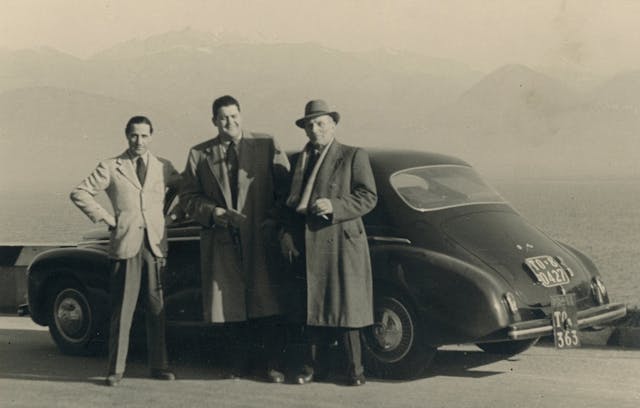
Even though Lancia offered several models equipped with V-6 engines over the decades following Fiat’s late 1969 takeover, all were sourced from other manufacturers, like the 2.4-liter V-6 from the Ferrari Dino, which propelled the Stratos to win three consecutive World Rally Championships between 1974 and 1976.
De Virgilio remained loyal to Lancia until his retirement in 1975 , then stayed on as a consultant for the racing team until 1984. From 1984 to 1986, he collaborated with Alfa Corse on a 3.5-liter, 72-degree V-10 for Formula 1, which predated those of Renault and Honda but was never raced.
Francesco De Virgilio passed away in 1995, but his legacy lives on in the millions of V-6 engines built since his trailblazing work in a war-ravaged Italy.
***
Matteo Licata received his degree in Transportation Design from Turin’s IED (Istituto Europeo di Design) in 2006. He worked as an automobile designer for about a decade, including a stint in the then-Fiat Group’s Turin design studio, during which his proposal for the interior of the 2010–20 Alfa Romeo Giulietta was selected for production. He next joined Changan’s European design studio in Turin and then EDAG in Barcelona, Spain. Licata currently teaches automobile design history to the Transportation Design bachelor students of IAAD (Istituto di Arte Applicata e Design) in Turin.
Check out the Hagerty Media homepage so you don’t miss a single story, or better yet, bookmark it. To get our best stories delivered right to your inbox, subscribe to our newsletters.
The post The man behind Lancia’s pioneering V-6 appeared first on Hagerty Media.
]]>
Tough?
”You’d better believe it,” says Tom Cox, transmission expert at Pete Cox Sportscars, where he works along with his father.
“We had one customer who lent his racing Triumph TR6 to a friend for a race at Brands Hatch. He didn’t really understand what an overdrive was all about and at maximum revs at the end of the pit straight, he simply clicked it out before Paddock Hill bend. The gearbox instantly saw about 9000 rpm; we did the maths. It completely detonated. There wasn’t anything salvageable, but the overdrive, well, that was fine. We took it apart and put it back together—nothing wrong at all.”
Tough, then, but also ingenious and ubiquitous, the Laycock de Normanville (LdN) overdrive might sound a bit like the transmission equivalent of the Duckworth-Lewis equation, but while it’s not as good at determining the result of a rained-off cricket match, it’s quite brilliant at reducing stress on you and your car when highway cruising.

It was invented in 1948 by Edgar de Normanville, an engineer, inventor, and motoring correspondent for The Motor magazine and The Daily Express. He’d already designed a four-speed epicyclic transmission for Humber when he came up with the similarly geared two-speed overdrive unit, which was built by Laycock Engineering in Sheffield. The LdN overdrive was one of a variety of overdrive units, including those from BorgWarner and Fairey, but it was by far the most popular, with an estimated 3.5 million units built over a 40-year period. LdN overdrives saw service on a variety of cars of the 1950s, ’60s, and ’70s: Jaguars, Land Rovers, Rovers, Bristols, Austin-Healeys, MGs, Triumphs, Volvos, AMCs, Chevrolets, and even a Ferrari, the 250 GT 2+2.
An overdrive unit is essentially a two-speed mechanically/hydraulically activated epicyclic gear system, which is shaped like a misshapen football and bolted to the back of the gearbox driving the propellor shaft. Overdrive simply means gearing that provides a tall enough ratio to enable the output shaft of the gearbox to spin faster than its input. Think of the engine “over driving” the propellor shaft.
So why did cars need overdrives at all? Post-WWII motoring marked a profound change; more middle-class motorists bought cars and traveled farther on very different roads. There were just 383,525 cars on the road in 1923, over a million in 1930, more than 2.5 million by 1950, and just under 5 million in 1960. To enable motorists to travel farther faster, in the 1950s the UK government undertook a program of mass road building to enable a 20th century car-based economy. Britain’s first dual carriageway had opened at the London end of the Great West Road in 1925, but the 1950s and ’60s saw their widespread adoption. In December 1958, the Preston Bypass, Britain’s first-ever motorway, was opened by Prime Minister Harold Macmillan, who quoted Robbie Burns: “I’m now arrived—thanks to the gods! Thro’ pathways rough and muddy. A certain sign that makin’ roads is no this people’s study.”



The following year, the first stretch of the M1 opened and cars subjected to the stresses of fast, continuous use on these new roads required a rethink. Better engine bearings, for instance, which could survive that stress, as well as improvements to cooling, better suspension and tires, and lower cruising revs. With sufficient torque from the engine, fitting an overdrive meant that cars and trucks with longitudinally mounted engines and three- and four-speed gearboxes could drive on these long, straight roads with the engine turning at lower revolutions, which reduced fuel consumption, component wear, noise, and vibration.
Of course, there was always the option of an over-driven fifth gear, which does much the same thing as an overdrive unit, and that’s exactly where we’ve ended up today with five- and six-speed gearboxes, which reduce the gearing to improve emissions and fuel consumption. In the 1950s and ’60s, however, a five-speed gearbox could be problematic. Designing and manufacturing a five-speed is neither simple nor cheap; witness today where carmakers often hand off their transmission business to firms such as BorgWarner, Dana, Getrag, Voith, Aisin, or ZF and therefore effectively share the cost with other manufacturers.

And, as James Brearley, engineer and director of Overdrive Repair Services in Sheffield says: “That fifth speed would sit at the back of the gearbox, and would need a method to engage it with different shift rods and forks, and there often isn’t the space to accommodate them at the rear of the ‘box.”
So, for the more outward-bound motorist, an overdrive unit it was. And what are those mysterious parts that fill the misshapen football at the back of the gearbox? The basic overdrive parts are the pump, which runs off the gearbox output shaft to build hydraulic pressure, and the solenoid, which opens a valve and allows high-pressure oil to reach the operating pistons, which in turn bear on a cone clutch that locks the epicyclic gearing and engages the taller overdrive ratio.

Although the epicyclic movement of the planets was described in Greek literature and used to illustrate the orbits of those planets, it took the industrial revolution for a generation of engineers to appreciate the benefits of epicyclic gearing: high-speed transmission reduction, with low vibration and relatively low cost.
An epicyclic gear system comprises one or more outer planet gears revolving around a central, or sun, gear, with the planet gears mounted on a carrier, which rotates relative to the sun gear. It’s ingenious and efficient and strong, but complex. I rebuilt the gearbox of my old Triumph, but entrusted the overdrive to a specialist, reckoning it was a load of voodoo engineering.

“Yes, there is a certain amount of voodoo in there,” admits Brearley, “though the operating principles are fairly straightforward. They all had their own way of building pressure.”
Initially the LdN overdrive was produced as an A-Type unit. “It has a hydraulic pump unit which built up to 340 to 550psi,” explains Brearley. “That stored pressure, when released, pushed the cone clutch into the brake ring, which stopped the sun gear and sent the drive round the epicyclic gears. In the earliest days the overdrive was controlled by a mechanical lever. The 12-volt solenoid came later.”
Brearley says the A-Type unit had a couple of different ratios, expressed as the percentage reduction in engine revs for a given speed: 22 percent for most Triumphs and 28 percent for Jaguars and Austin-Healeys.
By around 1972, the old A-Types were replaced by the J-Type, which had a slightly different mounting system (more to the rear of the car) and different overall gearing drop. Internet warriors rage about the relative strengths of the A versus J, the latter having smaller gears, fewer moving parts, different hydraulics, which subject the gears to less force, and more accessible hydraulics when mounted in the car.
Different vehicle applications have different adaptor plates and output shafts, and there were also special application overdrives: D-Types for early Triumphs, MGBs, and Hillmans; LH Types for MGBs and Ford-engined vehicles such as the Zephyr and Reliant Scimitar; and the P-Types, which were the last built and fitted to Volvos, keeping the faith in the trusty overdrive by taking over a million units from Laycock.

There were other advantages of the overdrive, too, not least that of providing additional ratios, especially the early A-Type units, which would operate on second, third, and fourth gears. This effectively gave the early TRs seven forward ratios, although third overdrive was so close to fourth as to be practically the same. And some applications, such as the Triumph GT6, gave no advantage in lower engine revs since the £58 special-order overdrive on the 1966 two-seat coupé gave a 0.802 overdriven ratio on third and fourth gears. But it was also accompanied by a final-drive ratio change from 3.27:1 to 3.89:1, which not only required a speedometer gear change but also effectively gave the same overall gearing—about 21 mph per 1000 rpm—as the standard four-speed model. So, in this case, the overdrive unit gave substantially better acceleration through the gears over the non-overdrive car.
My own experience is that an LdN overdrive is a reliable if slightly leaky device, and most problems stem from the wiring to the solenoid and neglect of the gearbox oil. Overdrive Repair Services’ Brearley concurs, but says that there are issues with side plates, which come under incredible forces, or the A-Type adaptor plates, which see the same from hydraulic and spring pressure. “It’s unbelievable the pressure those plates have to stand up to, and they bend and crack, so we’ve made up our own stronger items,” he says.
It’s a similar story with linings for the cone clutch, which have had to be remanufactured over the years. Original linings had asbestos content and the new, non-asbestos linings have slightly more grippy characteristics, which means faster and more brutal engagement, which some customers don’t like.
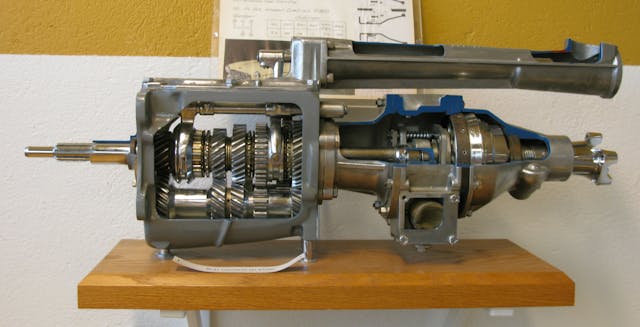
“The clutch has to stop that inertia at quite high engine revs,” says Brearley, “and there’s a slip time which includes the clutch travel and the return rate. If you allow too much slip time, the material can get quite hot quite quickly, so we have to be quite careful. The difference between the clutch thudding in like a ton of bricks and slipping too much can be as little as five-thousands of an inch adjustment.”
There’s also the thorny subject of the right lubrication for the gearbox and overdrive, which share common oil. All are agreed that the most modern GL5 gear oils should be avoided as they can attack some white and yellow metal bearing material. Older GL4 lubricant can be used, but advice from Duckhams, the TR Register, and Pete Cox is a straight mineral-oil SAE 40, changed regularly and with cleaned filters at the same time.


Compact five-speed gearboxes and transverse engines put paid to the bulky overdrive, and Laycock closed down in 1970s. “It was a brutal process,” says Brearley. “Specialist machines worth hundreds of thousands and endless overdrive units all went in the skip.” Overdrive Repair Services was born out of that closure and formed by former Laycock engineer Joe Winter in 1986, building on the winding down of Laycock’s repair and spares service. His son Paul joined the company soon after along with Peter Eggington, another former Laycock engineer. “We’re not the only firm looking after Laycock overdrives,” says Brearley, “but we like to think we do a good job.”
It’s easy to see overdrives as heavy and complicated sources of potential breakdown, but however it alters the gearing, in the end, an overdrive is a brilliant driver’s aid in an older car. For overtaking, accelerating, and holding a ratio between corners, it has no equal, and that flip of the switch on the steering column (or the gear lever) which engages the voodoo and fires the engine’s revs up or down in the blink of an eye, is one of the great pleasures of an old car.
***
Check out the Hagerty Media homepage so you don’t miss a single story, or better yet, bookmark it. To get our best stories delivered right to your inbox, subscribe to our newsletters.
The post LdN Overdrive: The British invention that let the world’s drivers enjoy highways appeared first on Hagerty Media.
]]>
On a typically bone-chilling day in December of 1952, the Number 78 bus trundled onto the Tower Bridge of London and over the River Thames. The month was nearly at an end, the twenty passengers perhaps anticipating New Year celebrations. To his shock and surprise, bus driver Albert Gunter saw the road ahead begin to rise. The bridge’s twin-span bascule was opening.
Were this an episode of The Dukes of Hazzard, Merle Haggard would show up with some crack: “Them Duke boys better start flappin’ their arms.” Were this the defining bus jump stunt from 1994’s Speed, Keanu Reeves would yell for everyone to hang on to something and throw himself in front of Sandra Bullock.
But this is not fiction. A gulf yawned ahead. The engine began to strain. The slight, middle-aged man behind the wheel set his jaw—and floored the pedal. The bus went airborne.

Jumping cars over things is a hundred-year obsession for mankind. Perhaps the idea originated on horseback, with the sport of steeplechase. Perhaps it was merely the wish to create a bigger spectacle in the first days of the silver screen. Whatever the case, early twentieth-century attempts did not go well.
In time, all manner of carefully planned (and sometimes just plain reckless) stunt coordination made the flying automobile or motorcycle a reality, however brief. Some of the highlights: Evel Knievel, who defined the stuntman craze of the 1970s. The complex, computer-assisted choreography of the barrel-rolling AMC Javelin in 1974’s Bond flick, The Man with the Golden Gun. General Lee blasting past a “Bridge Out” sign in 2005. Today’s ever-crazier Fast and Furious shenanigans. Whatever the era, there was something on a screen to make us believe we could fly behind the wheel. To this day, a flat-deck truck with the ramp down looks tempting.
Leaping a Harley over multiple buses is a very different animal than leaping a bus over anything. In Speed the stunt vehicle, a 40-ft GM New Look TDH-5303, smashed into the ground so hard it blew a tire, ruptured the oil pan, and rattled off its doors. The stuntman, wearing a helmet and light body armor, somehow walked away.
A London double-decker bus is an even more ungainly aviator. The distinctive design is a nearly two-century tradition, dating back to the horse-drawn carriages of the early nineteenth century. These were properly called “omnibuses,” and operated by an outfit called the London General Omnibus Company.
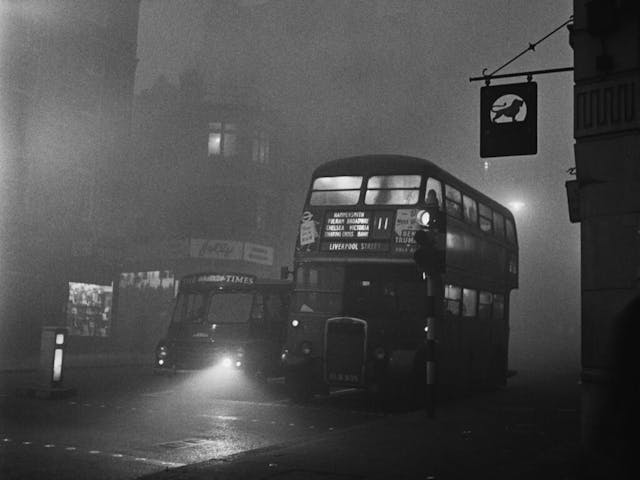
Starting in 1907, London General Omnibus Company began to paint their buses red. Horse power gave way to steam, then to combustion. By 1956, the distinctive AEC Routemaster made its first trip. These double-deckers, with their offset position for the driver and generally cheery appearance, were a stalwart on the roads right up until the mid-2000s. London’s modern bus needs are fulfilled by the New Routemaster, made by Wrightbus.
Gunter’s bus, the 78 line between Shoreditch and Nunhead, was a slightly older AEC model, the Regent III RT. These looked much like the Routemaster, just with a more upright grille, and were the most common buses in London through until the 1970s. The prettier Routemaster got the glamor; the RT was the workhorse. Number 78, however, would have its day in the spotlight.

According to a later interview with one of the passengers, Gunter had been a tank driver during the war. While London double-deckers are tested for top-heaviness, his intuition said that simply stopping on the bridge might cause the bus to topple into the water as the ramp was raised.
The gap is variously described as three to six feet wide at the moment Gunter’s double-decker leaped it. Though the passengers were thrown to the floor and the conductor broke his heel, the bus made it to the far north bank of the river and to safety. One likes to imagine one of the passengers quipping, “Fix the pipe-lighter, old bean.”
Albert Gunter was officially commended for his quick thinking. He received the princely sum of £10 (about $280 today) and several days off. The reward was more than he made in a week. He promised to split it, “five for me and five for the missus.”


There was further good news: By way of apology, the corporation that ran London Bridge paid Gunter £35. His family received a week’s free holiday in the seaside town of Bournemouth, reportedly the Gunters’ first break in five years. Their two children, aged eight and fourteen, were invited to the annual children’s party held by London’s mayor.
The slight, cheerful Gunter returned to driving Number 78 and disappeared from the spotlight. A quiet life in bustling London, a smile for his regular passengers, perhaps a quiet pint at the end of the day. But you know that, sometimes, down at the pub on a Friday, he would get the question.

***
Check out the Hagerty Media homepage so you don’t miss a single story, or better yet, bookmark it. To get our best stories delivered right to your inbox, subscribe to our newsletters.
The post The day a double-decker bus jumped London’s Tower Bridge appeared first on Hagerty Media.
]]>

Some shapes in the automotive world are just timeless, like the grille of a 1969 Mustang. Even restomod shops leave it alone. The same goes for tools: During an evening of working in the garage, you’re likely to touch several whose designs have survived, nearly unchanged, since they were invented.
For the sake of argument, let’s exclude anything that is simply a formed piece of metal—screwdrivers, sockets, and hammers—and focus on items with some kind of mechanism. Inventors are likely the first to tell you that perfection on the first or even the second try doesn’t happen often, but these five tools got awful close.
Ratchets

The use of gears to create a one-way mechanism is old—over a century and a half. J.J. Richardson patented the idea of a ratcheting wrench in June of 1863 and, while his design appears archaic by modern standards, it relies on the same principles as the ratchets that sit in virtually every toolbox around the world.

A center gear doubles as the attachment point for the socket. That gear interacts with two smaller ones that force it to spin either clockwise or counterclockwise. The direction of a modern rachet is easy to switch, and its gears have evolved to be much finer, minimizing the rotation required to grab the next tooth, thus making the ratchet more efficient in tighter spaces.
Bench vise

If you thought of one tool when you saw this article’s headline, it was probably this. History traces the bench vise back to the 1700s, but the first modern version was made of poured cast iron in the 1830s. The casting process was rudimentary, though, and resulted in a porous finished product that had the potential to break during use. Today, the best modern vises are forged.

Piston-ring compressor

The modern four-stroke engine traces back to Nicolaus August Otto and his experiments with compressing the air and fuel inside a cylinder prior to ignition. This discovery led to more efficient engines that gave us—literally—more bang for a buck’s worth of fuel.
To contain compression and combustion, you must put a seal on the piston; to do that, you must be able to compress said piston rings to fit into the cylinder bore while you assemble it. Consider that Otto was experimenting with his designs in the 1860s, and it’s reasonable to conclude that our spring-form piston ring compressors trace to this time period. Not everyone uses these tools, but those who do know just how important they can be.


Scissor jack

As long as there have been cars, we have needed to lift them. While an incline plane (a ramp) effectively raises the car while the vehicle is on its wheels, a spiral incline plane combined with four metal arms and a base will lift a car from any point to allow you to remove wheels or other parts. That is the essential form of a scissor jack: A screw that pulls together two arms that provide lift.
The design traces back at least 100 years and it is nearly comical how little has changed from the patent drawing to the folded-metal jacks found in the trunks of so many modern cars. Jacks and spare tires might be falling by the wayside, but the simplicity of a scissor jack will stand the test of time, even if it has never passed the test of safety with flying colors.

Vise grip

The main thing we need while working is a third hand, something that can hold our workpiece together or give us a handle on something otherwise untouchable. The over-cam design for locking jaw pliers might be the youngest one on this list: 99 years have passed since inventor and blacksmith William S. Petersen penned the design that became the nearly indispensable tool we know today. The easy-release lever was added in a slight redesign by Petersen in 1957 (above).
Have a tool to add to the list? Leave a comment below telling us another tool that has stood the test of time. The history behind what we take for granted can be quite fascinating.

***
Check out the Hagerty Media homepage so you don’t miss a single story, or better yet, bookmark it. To get our best stories delivered right to your inbox, subscribe to our newsletters.
The post 5 old tool designs that survive nearly unchanged appeared first on Hagerty Media.
]]>
Lamborghini’s unique breed of supercars has become part of popular culture. Its scissor doors make regular appearances in music videos and social media posts, the Countach earned a spot on the National Historic Vehicle Register, and the Aventador is present in nearly every toy store in the world.
It wasn’t always this way. Before the Miura, which created the template for the modern supercar, the company planted its stake in the gran turismo segment with a pair of coupes called 350 GT and 400 GT, respectively. GTs have since faded from the Lamborghini range, but they played a significant role in shaping the image and the values that characterize the company today.
Muting Ferrari’s chatter
Ferruccio Lamborghini diligently made a name and a fortune for himself by building tractors, but adding “carmaker” to his resume wasn’t as random as it might seem. He notably competed in the 1948 Mille Miglia with a barchetta based on the humble Fiat Topolino. While the little roadster dropped out of the race, Lamborghini didn’t lose his appetite for speed. His success allowed him to own some of the fastest and most expensive cars available in Italy, including models made by Ferrari. It was the Prancing Horse’s reliability-related problems (and, according to many accounts, Enzo Ferrari’s callous attitude towards customers who complained about mechanical issues) that led Lamborghini to start his own company.

Lamborghini founded Lamborghini in 1963, when there was no shortage of small, obscure carmakers looking to capitalize on a growing demand for fast cars on both sides of the Atlantic. His first concept, the 350 GTV, made its debut to the popping of flashbulbs at the 1963 Turin auto show. It remained a one-off, but it spawned a production model called 350 GT that was presented at the 1964 Geneva auto show.
This is where it all started: the first production-bound Lamborghini was born.

Young, passionate engineers like Paolo Stanzani and Giampaolo Dallara helped make the 350 GT a reality. On paper, the coupe featured a relatively conventional layout: it was powered by a front-mounted, 3.5-liter V-12 engine that spun the rear wheels. Italian coachbuilder Carrozzeria Touring built around 135 units of the first Lamborghini, which was an impressive figure for a small company peddling its first car.
There was one way to tell whether Lamborghini was on the brink of stardom or if it had experienced a bout of beginner’s luck: launch a second model. Released in 1966, the 400 GT landed as an evolution of its predecessor with a redesigned front end, a more spacious interior, and a larger, 3.9-liter V-12. Orders poured in, and production totaled approximately 273 examples. While that doesn’t exactly sound like a smash hit, three-digit production figures were fairly common in this sector of the Italian automotive industry during the 1960s; Ferrari built roughly 200 examples of the Pininfarina-designed 275 GTS from 1964 to 1966.










Several high-profile individuals purchased a 400 GT, including Paul McCartney, and a handful of examples were exported to overseas markets like Japan. In hindsight, one of the 400 GT’s fiercest competitors came not from Maranello, Modena, or Coventry but from Lamborghini’s headquarters in Sant’Agata Bolognese, Italy. The revolutionary Miura made its debut in 1966 as well and quickly overshadowed the 400 GT; it was arguably the first supercar, and it’s the car that made Lamborghini a household name.
Performance meets elegance

Lamborghini tossed me the keys to one of the last 400 GTs. Built in December 1967 and assigned chassis number 01324, it’s a Swiss-market car finished in Saint Vincent Gray with a tobacco interior, and it was ordered with a handful of options such as a heated rear window. Stepping inside is like discovering a new side of the company: luxury is the main theme in the cabin. There’s soft leather everywhere, a wood-rimmed steering wheel, and wood trim on the top part of the center stack. In the back, there’s a two-person bench seat that I wouldn’t mind having as a couch in my living room. It’s not that Lamborghini no longer dabbles in luxury, everything inside its current cars is nice to touch and look at, but even the Urus SUV feels like it was designed with a focus on performance. Not here; this is first and foremost a luxury car. If you want more proof, pop the hood: the underside of it is covered with square-stitched upholstery.




Reach past the wood shift knob to put the key in the ignition barrel, hear the fuel pump click a couple of times, start the V-12, and the luxurious interior becomes an interesting paradox. While you’re not sitting on a bucket seat and surrounded by a roll cage, the engine sounds like it belongs in a race car. Open the (power-operated!) window to let the sound in, close your eyes, and you may as well be at the 1967 Targa Florio. Luckily, the naturally-aspirated V-12’s roar still echoes through Lamborghini’s headquarters today. It’s a configuration that the company has pledged to keep alive for as long as regulations allow it.

It takes only a couple of miles on the roads that snake through the mountains separating Bologna and Florence to get used to the 400 GT. It’s a relatively smooth and easy car to drive: the steering is fairly light, not overly quick, and precise, the shifter’s throws are short and direct, and the power is always there when you need it. The 3.9-liter V-12 slurps fuel from a constellation of six carburetors to develop 320 horsepower, which was a monumental amount in the late 1960s; in comparison, a 1967 911 S used a 2.0-liter flat-six rated at 180 horsepower. With so much power on tap, and an engine that’s markedly more cheerful when the needle is hovering in the upper part of the tachometer, Lamborghini engineers gave the 400 GT relatively long gears and you’re not constantly shifting up and down to keep moving.

The V-12’s sound gets better as the pace picks up, and it’s accompanied by a subtle whine coming from the five-speed manual gearbox. One of the more fascinating aspects of driving the 400 GT is how effortlessly it keeps up with traffic. In a lot of cars from this era, you feel like you’re going fast even if you’re not. That’s the impression I get after driving, say, an Alfa Romeo Giulietta Sprint. Not here; the 400 GT moves with a real sense of urgency, and the brakes are powerful enough to keep the fun in check. While I wasn’t able to test this, Lamborghini tells me the coupe keeps going until its speedometer shows 155 mph. Put another way, you’ll (eventually) beat a BMW i4 in a pedal-to-the-floor race on the autobahn.

Although the mighty V-12 is the 400 GT’s soul, the chassis doesn’t disappoint. This is where the GT genes become dominant: the 400 GT behaves elegantly, even through hairpin turns, thanks to a chassis that strikes a balance between performance and comfort without leaving the realm of sportiness. The ride is never overly firm but body roll is never excessive, either. In this sense, the 400 GT is closer to cars like the current-generation Maserati Gran Turismo, for example, than to the Aventador. It’s happy to go along with whatever you’ve got planned as long as you don’t push it too far toward either extreme. This is part of what sets it apart from the Miura, which leans far more towards the performance side of the scale.



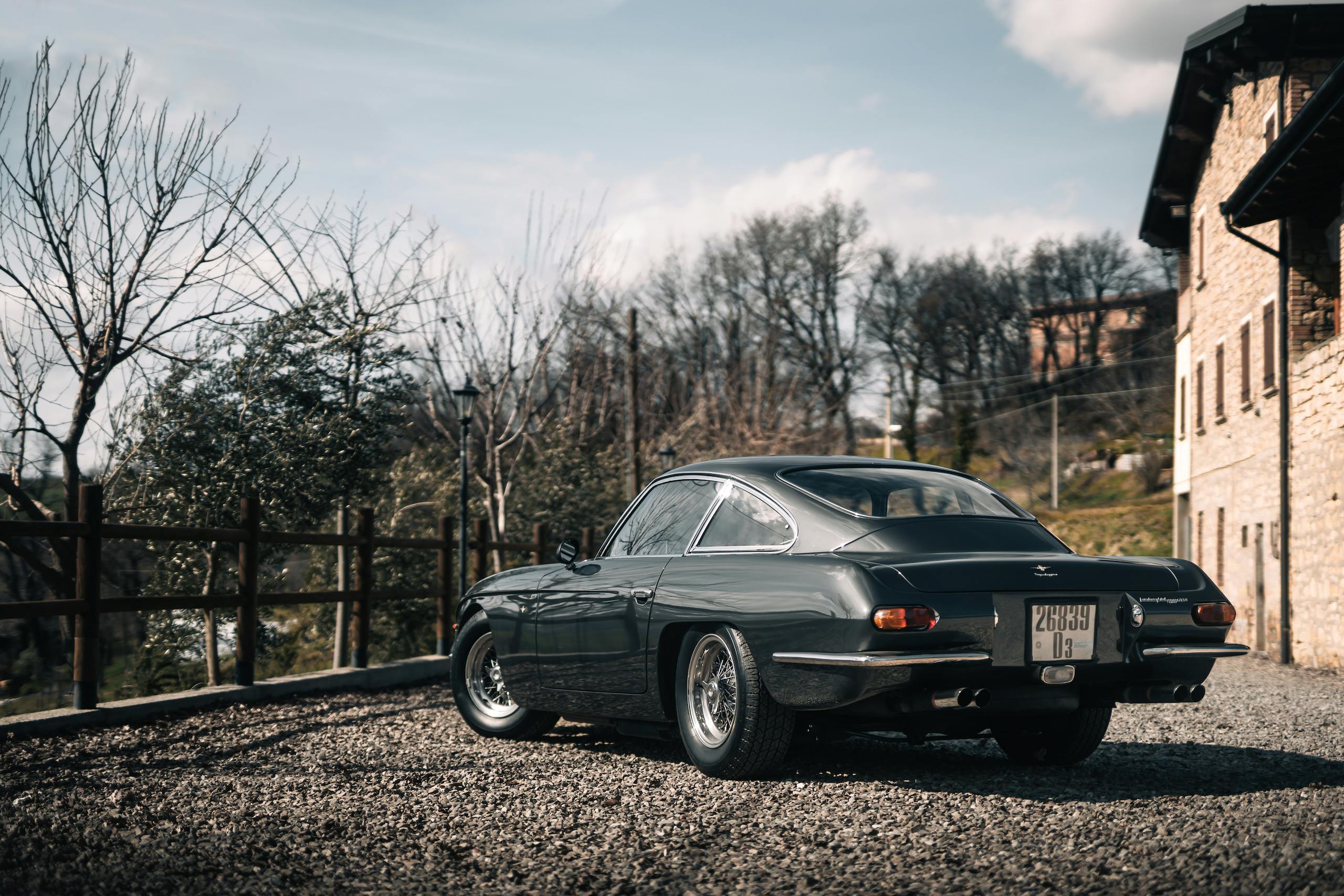
Ripe for revival?
The 400 GT retired in 1968 and passed the torch to the short-lived Islero, which featured a more angular design. That same year, the striking-looking Espada made its debut and remained in production for a decade. It wasn’t directly replaced, and Lamborghini exited the GT segment.
By the beginning of the 1980s, the extravagant Countach had become firmly embedded into the automotive landscape and the market for big, expensive coupes with four seats was coasting in neutral. No one has truly managed to jump-start it since, but Lamborghini hasn’t forgotten about the GT side of its heritage: its first electric model due out before the end of the decade will reportedly take the form of “a 2+2 two-door car.” Despite the future-focused push, the dream of a world-class GT car may soon resurface.




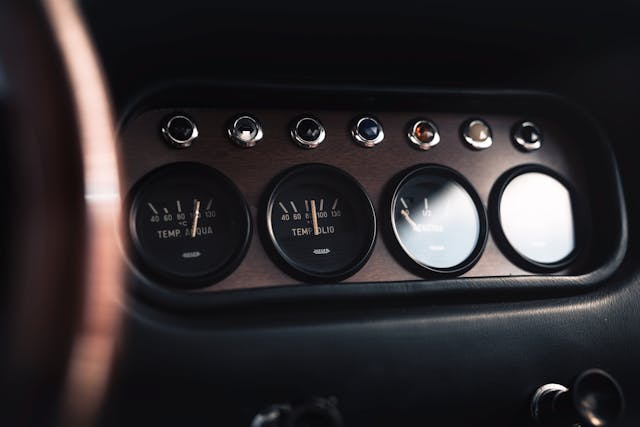






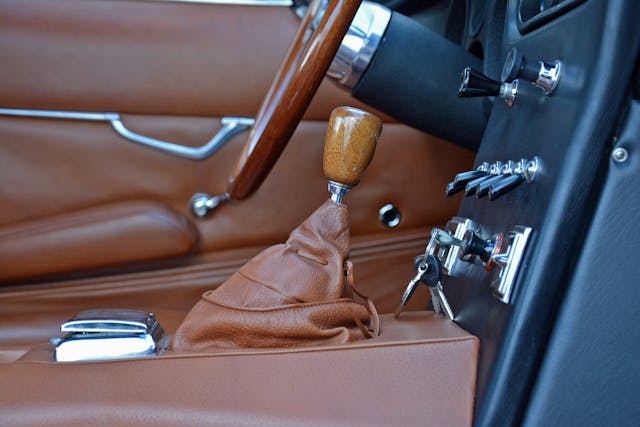






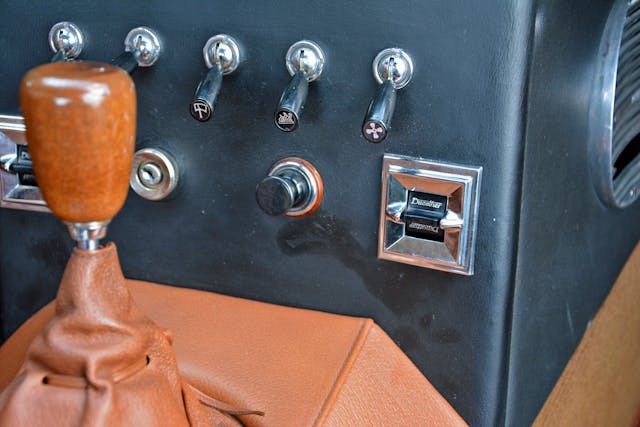



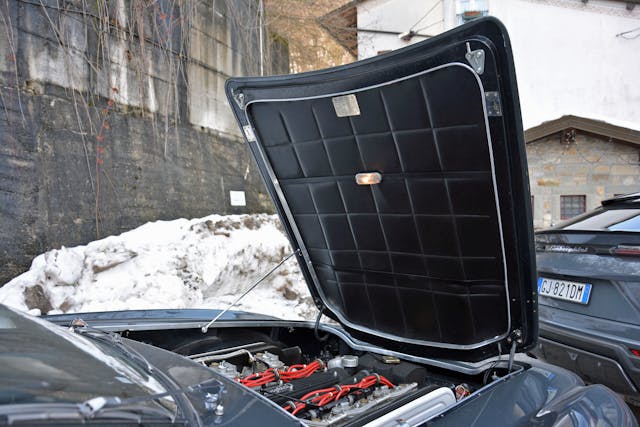





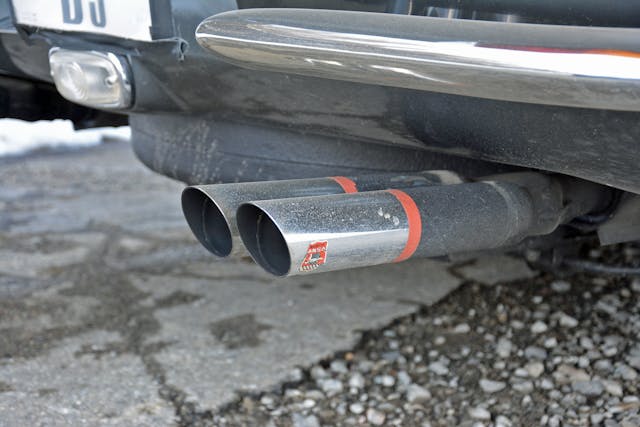

***
Check out the Hagerty Media homepage so you don’t miss a single story, or better yet, bookmark it. To get our best stories delivered right to your inbox, subscribe to our newsletters.
The post The 400 GT feels like a relic of a different Lamborghini appeared first on Hagerty Media.
]]>
John Kiprian Wasenko, or “Kip,” as he is known to his friends who gather for cars and coffee at Pasteiner’s in Birmingham, Michigan, is a true son of the Motor City. Racer, artist, and lover of beautiful automobiles, this Dino driving, GT2-style Corvette-race-car wrassling car designer has a story that begins long before he ever got behind the wheel.

Getting the bug
In 1952, six-year-old Kip Wasenko often sat on the front porch of his family’s Detroit home, waiting for yet another new Caddy to drive down his street. The shiny new luxury cars were en route from the old Clark Street Assembly Plant to a nearby site where they will be loaded onto transports and shipped to dealers. To get there they had pass by the Wasenko residence near Livernois and Michigan. The boy on the porch was far too young to understand Cadillac’s place in the hierarchy of the automotive world, but he kew pretty sheet metal when he saw it.
GM was king in mid-century America, and Cadillac was the Lord Chamberlain of the General’s court, a fact regularly communicated to young Wasenko by an uncle who helped manage GM’s storied Motorama extravaganzas. Knowing the youngster’s fascination with automobiles, he would bring him brochures with artfully rendered illustrations of the new machinery.

Wasenko filled notebooks with his own renderings of fabulous machines, growing more proficient with each drawing and each passing year, becoming more deeply immersed in the world of wheels. As a teen, his passion turned to drag racing and performance, but he never stopped sketching, never stopped conjuring images of very special machines. Machines he longed to create, touch, and drive.
Before he turned 18, Wasenko knew what he wanted to do with the rest of his life. He wanted to create cars. So, he enrolled at Detroit’s Wayne State University and majored in industrial design. His plan was to complete the Wayne State degree program, then continue his education at the Art Center College of Design in Pasadena, California. Before he could get to step two of that plan, he was selected for an internship at General Motors.
In the General’s army
The work environment at GM was challenging and competitive, just the way Wasenko liked it. Drawing on years of devotion to all things automotive, he designed a mid-engine streamliner powered by a turbine. An unusual machine, it featured a vertical fin not unlike those used on some race cars today and a rear track that, for aerodynamic purposes, was narrower than the front track. Bill Mitchell, GM’s design chief, saw the young intern’s work and offered a job on the spot. Wasenko completed his degree work at Wayne State and started designing cars for GM on January 2, 1968. He would continue in that role for 40 years.
Wasenko’s career path saw many successes—too many to cover here. An early win was the acclaim afforded his design of a mid-engine twin-rotor Wankel-powered Corvette in the early 1970s. An assignment at Opel in Germany followed shortly thereafter, and he was able to present the rotary-engine car at the Frankfurt auto show. That car, and a larger four-rotor Vette that his boss Bill Mitchell penned, never saw production, as fuel economy concerns killed GM’s interest in rotary engines.

Wasenko’s work in Germany was followed by a stint at Holden, GM’s Australian brand, where he served as assistant design chief. Back in the states, he became chief designer at Saturn. But Cadillac had won his heart many years before, so a new assignment designing the cars he knew first and loved most saw Wasenko doing some of his best work and ultimately becoming director of design for Cadillac.
Art, science, high performance

The summer of 1998 was a high point in Wasenko’s career. With his Cadillac design team, he developed a concept car called Evoq that was meant to forge a new path for Cadillac styling. He then spent the summer in California supervising its construction at Metalcrafters, an auto industry fabricator. The car was unveiled at the Detroit auto show in January of ’99 and was hailed as a masterpiece of contemporary automotive art and a revolutionary new look for Cadillac. The car and Wasenko were invited to participate in a design show in Milan.
Evoq changed everything. A production version of the concept—the XLR—soon followed, heralding the birth of Cadillac’s Art and Science design language. Wasenko would continue to push the envelope, championing high-performance CTS-V and STS-V coupes and sedans that came to define the new Cadillac.


The Italians’ embrace of Evoq design in 1999 was reflective of Wasenko’s interest and passion for Italian design. His pride and joy has long been a beautiful red 1970 Dino 246 GT that he purchased in ’75 and restored to concours standards in 1991. The Ferrari-built mid-engine car was created as a loving tribute to Enzo’s son, Alfredo “Dino” Ferrari, who had been tragically taken by muscular dystrophy at the age of 24. Styled by Pininfarina with coachwork by Scaglietti, the car is considered one of the most sensuous designs ever to emerge from Maranello. For Wasenko, it was both model and motivation.

Cars that not only look fast but perform accordingly came to define Wasenko, and he would finish his career in the GM performance division with Mark Reuss, Tony Roma, and John Henricy. Racers all. They created pace cars and specialty vehicles for the SEMA show. They took the brand to Le Mans from 2000 to 2002 with a turbocharged V-8 prototype race car and proved competitive with the world’s best.

“Cadillac had it figured out by the end of our final Le Mans race but then backed out,” said Wasenko. “We were disappointed, but the amount of money allocated to the program wasn’t enough to continue to race Le Mans. The reality was that we should race what we sell, and we created a CTS-V race car that proved successful. But Le Mans is the big show and GM will be back this year with five race cars [Cadillac hypercars finished 3rd and 4th overall at the June 10–11 race—Ed.]. Credit Mark Reuss as the guy who kept the V-series alive and prompted a return to Le Mans and the world stage.”

Designed to be driven
Wasenko has always believed cars are meant to be driven, and in 1991, while still designing for Saturn, he cautiously but enthusiastically took to the race track in his gorgeous little Dino. “I took some heat for driving a classic in competition,” he recalls. “But my Dino racing was short-lived. Soon thereafter, I was invited to co-drive a Corvette race car, so the Dino was retired from competition with nary a scratch. In the winter of ’92, I built my own Corvette race car, and I’ve been competing in that same car for 30 years, with numerous upgrades and modifications along the way.”


Wasenko’s racing Corvette is a 1988 C4 that he purchased as a theft recovery survivor; it had been stripped down to its bare frame and rear body doghouse. That’s about where you want to start, he says, if you’re going to turn an older Vette into a race winner.
Danny Kellermeyer of Ortonville, Michigan, welded a full cage into that basic Vette donor car and Doug Chenoweth, a friend and forer racing partner, helped Wasenko turn it into a race car. And a race car it is, appearing regularly at Waterford Hills, an historic road racing course in Oakland County, Michigan. Running in ITE, a class that includes former GT cars and other pure race cars, Wasenko and his pretty Corvette came within 0.2 second of the track record last year. Power is provided by a 6.2-liter LS small-block Chevy engine with CNC-ported LS9 heads, a Callies crankshaft, Oliver connecting rods, and Mahle pistons that provide a compression ratio of 11.8:1. The intake is an LS fuel-injection system that was reprogrammed for competition. The engine was prepped and assembled by Kevin Pranger at Great Lakes Engines; on the dyno, it generated 550 horsepower at the rear wheels.




Wasenko stirs gears with a ZF six-speed manual that delivers power to a 4.10 gear set. At the end of the rear axles hang a pair of 345/35-18 Hoosier A7 sports car racing tires. Those are matched with rubber of the same manufacture up front.
When Wasenko was interviewed for this article, he expressed pride at having passed his pro race car driver physical. At age 76, that’s no small feat. When he’s not racing, he’s busy judging concours events all over the country, something he enjoys and is frequently called on to do. That’s no surprise—he’s been working on that keen eye for exact details since his boyhood days on the front porch.

***
Check out the Hagerty Media homepage so you don’t miss a single story, or better yet, bookmark it. To get our best stories delivered right to your inbox, subscribe to our newsletters.
The post GM design veteran Kip Wasenko has raced this C4 Corvette for three decades appeared first on Hagerty Media.
]]>
The radical but short-lived Tucker 48 sedan remains one of the most spectacular automotive brand failures of all time. Loyalty for the marque still persists among a band of followers who remain convinced that Preston Tucker was victimized by the Detroit “Big Three,” unmercifully harassed by the Securities and Exchange Commission (SEC), and unfairly targeted in a cruel vendetta authored by Homer Ferguson, better known as “The Senator from Detroit.”
Last weekend at the Antique Automobile Club of America (AACA) Museum in Hershey, Pennsylvania, a loyal group of 250 Tucker fans gathered for a two-day celebration to honor company founder Preston Thomas Tucker and “keep the legend alive.” There were nine Tucker automobiles on hand, and four of them paraded around the museum, to the delight of the assembled crowd. Sleek, stylish, and ahead of their time, the Tuckers beg the question: Why were they not successful?

If you somehow missed the 1988 Francis Coppola film, Tucker, The Man and His Dream, here’s a quick recap of the Tucker saga:
Flamboyant entrepreneur Preston Tucker, of Ypsilanti, Michigan, debuted his plans for a radical postwar car in the December 1946 issue of Science Illustrated magazine. With its rocket-ship-inspired styling by George Lawson and Alex Tremulis, a rear-mounted flat-six engine (that could be removed in minutes for servicing), Torsiolastic independent suspension, aircraft-style doors, pop-out windshield, swiveling center headlight, standard seat belts, and padded “safety chamber,” there was nothing like it on the road. Orders poured in for the “Car of Tomorrow.” Tucker’s suggested $2450 price tag undercut Cadillac’s popular Model 62 sedan by about $500—a big difference in 1948.
But Tucker’s then-radical sedan never reached true production. After he was smeared in headlines and maligned by nefarious radio commentator Drew Pearson, Tucker and his company were investigated by the SEC (which seized all the factory records), indicted for investment irregularities, and charged with stock and mail fraud. After a sensational trial, Preston Tucker and his associates were acquitted of all charges, but the company’s reputation suffered and funds were almost wholly depleted after the legal fees. When the Tucker plant closed in mid-1948, just thirty-seven pilot models had been completed. Fourteen additional Tuckers were completed, for a total of 51. Some 47 of those cars have survived.


Myths abound about the Tucker venture, but this much is true: Preston Tucker was fundamentally naïve about business; his effort was seriously underfunded, his showy style and unusual business practices annoyed the powers that be; the hastily built initial cars were not sufficiently developed; and he was very unlucky. Despite the Tucker’s monumental business failure, Tucker owners and club members remain passionately loyal to his memory, and Tucker cars presently sell for seven-figure sums.

At the recent “Tuckerama,” John Tucker, Preston’s grandson, and his sons, Shaun and Mike, spoke about the nine individual cars on show. They were each assembled by hand, so there are countless differences and running changes. Based on detailed questions asked in the event’s seminars, there’s no such thing as too much minutia for Tuckerphiles. The audience listened raptly. Attorney Steve Lehto, author of Preston Tucker and His Battle to Build the Car of Tomorrow, reviewed Tucker’s many legal problems. “It was a shame,” one spectator exclaimed. “Tucker was treated so unfairly.”
Mark Lieberman, whose company, Nostalgic Motors, offers restoration, parts, and service for Tucker survivors, held court on a variety of Tucker issues. The Tucker was principally designed by Alex Tremulis, who penned the prewar Chrysler Thunderbolt and the two-wheeled Gyronaut X-1. Tremulis was represented by his nephew, Steve, and Steve’s lovely daughter, Allie, who both fondly remembered their Uncle Alex. Preston Tucker and Alex Tremulis were recognized with Hall of Honor awards.
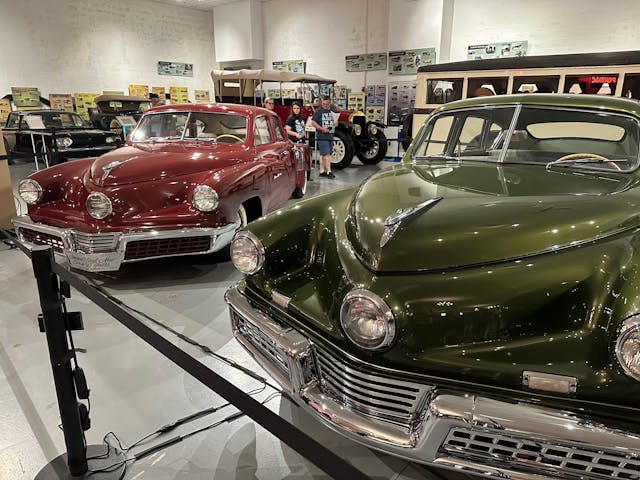
A few years ago, the late David Cammack, who operated a Tucker museum in Arlington, Virginia, donated three Tucker cars and a treasure trove of the original Tucker company’s files and blueprints to the AACA Museum. During the Tuckerama weekend, the new David S. Cammack Research Center was opened on the museum’s second floor. When Preston Tucker was on trial, skeptics claimed he never seriously intended to build a car; he was just trying to extort money. But there were 51 completed cars, and a cursory look at hundreds of blueprints here, as well as copious correspondence with suppliers, underscores that Tucker was serious, and it helps explain why his trials ended with acquittals in every instance.




The cars on hand spanned the full gamut of Tucker history. Pat Swigart, who owns the Swigart Museum in Huntingdon, Pennsylvania (founded in 1920!), brought the “Tin Goose,” the original Tucker prototype. It’s been listed on the National Historic Vehicle Register. The AACA Museum trotted out one of two sedans that were fitted with the “Tuckermatic” automatic transmission. And Howard Kroplick’s Model 48, number 1044, took a second in class in 2018 at the Pebble Beach Concours d’Elegance. Filmmaker George Lucas won that year with a very original example, number 1009. Both Lucas and Francis Coppola still own Tucker cars.

Looking back, Preston Tucker battled valiantly to build his dream car, insisting that streamlined styling and safety features like seat belts were essential and predicting that every manufacturer would follow his lead someday. But Steve Lehto insists that Tucker’s legacy is more than just the car. “Tucker dared to compete in the highest levels of American business,” he wrote, “and he came tantalizingly close to succeeding.”
“Most people become a loyalist to a specific car because of its physical attributes or their past experience with it,” adds Mark Lieberman. “Tucker fans are attracted to the story, the history, the people, and the car itself. There is a lot to love, even if you’ve never seen one in person.”

The Tucker faithful can’t rewrite history, but they point to the cars’ advanced styling and engineering, their astounding value today, and the eternal appeal of the “David vs. Goliath” story as evidence that Preston Tucker remains their automotive hero for the ages.









***
Check out the Hagerty Media homepage so you don’t miss a single story, or better yet, bookmark it. To get our best stories delivered right to your inbox, subscribe to our newsletters.
The post Tucker faithful celebrate 75 years of a revolutionary car appeared first on Hagerty Media.
]]>
Gerald C. Meyers, former president and CEO of American Motors Corporation, died on June 19 at his home in West Bloomfield, Michigan. He was 94 years old.
In the winter of 2017, I remember driving to a 1980s industrial park outside Detroit to interview Meyers for The Last Independent Automaker, our documentary on the automaker. My co-producer had convinced the notoriously cagy Meyers to do it, and I remember feeling nervous as we hauled our equipment into the small office.

At 88 years old, Meyers was still imposing. He was tall, square jawed, and deadly serious, with a deep, baritone voice. His memories of dates and production numbers were fuzzy, but he lit up when discussing the people he’d worked with during his 20 years at American Motors—George Romney, Roy Abernethy, Roy Chapin, Dick Teague, Roy Lunn. Meyers seemed always to be on the front lines of whatever the company was doing.
He had a colorful résumé, including stints at Ford Motor Company, the U.S. Air Force, Chrysler Corporation, and AMC–where he oversaw numerous products and projects from 1962 to 1982.
Tired of bureaucracy at Chrysler, he came to American Motors with hopes of faster career advancement. Starting as director of purchasing, Meyers did the granular but important work of calculating which parts were cheaper to build in-house instead of buying from suppliers. From there, he advanced to director of manufacturing, where he ended up sitting next to head designer Dick Teague on the flight where the designer made the infamous barf bag sketch that would become the AMC Gremlin.

In 1969, chairman and CEO Roy Chapin Jr. assigned Meyers to investigate Kaiser Jeep’s Toledo facilities to see if American Motors should buy it. While it turned out to be one of the greatest decisions in automotive history, Meyers told us that he was staunchly against the purchase, at first.
“I didn’t know anything about Jeep. I didn’t think much of it. The volume wasn’t so wonderful and the vehicles looked kind of old to me,” he said during our 2017 interview. “But I went down, and I spent a week in the Jeep Toledo plant, talking to everybody I could get to listen.
The first thing that struck me when I walked in was how many people there were. The assembly lines were just crowded with people. A three-man job had ten men on it. A two-man job had four men on it. It was very inefficient, and the flow of material through the plant was archaic. There were parts all over the place, and the pace of the people who were building the cars was very slow.
And I said, ‘Roy, here’s what I think. I think it’s a disaster. You don’t want anything to do with it. It’s inefficient. It’s archaic. It’s absurd. And my recommendation is to forget it.’
Then they had a board meeting. Roy came out and said, ‘Gerry, come into my office. Now, sit down. We’re going to buy Jeep.’
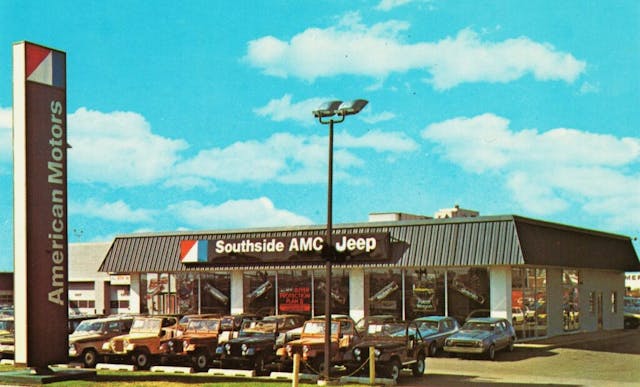
I said, ‘You gotta be crazy! I’ve been down there, I did what you told me, I looked around. It’s a disaster! The costs are too high, it’s totally inefficient. The product is neglected. And I don’t know anything about the distribution organization, but the dealers are probably no good, either!’
He said, ‘Well, we just had a board meeting and we decided to buy it, and I’ve got something else to tell you. We’re going to put you in charge of it, and you’re going to make it work.’”

Meyers dutifully accepted the challenge, and his turnaround of Jeep helped lower costs and streamline production, as well as replace outdated powertrains with AMC’s in-house units. At the same time, his work on passenger-car manufacturing helped improve quality to the point where journalists were applauding AMC for building better cars than the Big Three. Meyers was promoted to VP of product engineering in 1972, putting him within reach of the CEO suite.
His record wasn’t all wins, however, as he was part of the board that signed off on the AMC Pacer’s development in 1971. It was supposed to be a modern, Wankel-powered urban commuter of the future, but the radical gamble didn’t pay off when GM canceled the rotary engine AMC had planned to buy. As a result, the Pacer ended up as an overweight, underpowered, economy car that wasn’t very economical, and its failure helped doom American Motors financially. A bright spot during this time came when Meyers helped engineer Roy Lunn get money to clandestinely develop the 4WD system that led to the revolutionary AMC Eagle.
As Meyers’ ambitions grew, so did an internal feud with marketing VP, Bill McNealy. Both wanted the company’s top job, and the battle turned ugly. Wrote Meyers years later, “McNealy and I carefully refrained from open hostilities, but alone with our people each of us moved with a vengeance to look good at our adversary’s expense. We learned first hand how destructive it is to an organization to select multiple heirs apparent, [with] the winner to be decided later.”
In 1977, at age 49, Meyers became CEO and president of AMC, making him one of the youngest leaders of any automaker. He beat McNealy for the job after selling AMC’s board of directors on his vision of the future. Knowing the company lacked the capital to design the all-new generation of fuel-efficient front-wheel-drive passenger cars that it would need to stay competitive, he recommended increasing profitable Jeep production and partnering with a foreign automaker to build new cars in the U.S.


“American Motors had been known for high fuel economy,” Meyers told me. “But we were not the fuel economy winners at that time. And we thought that one quick way to get onto the new wave, because of the price of fuel, would be to get smaller vehicles, and get them quickly. And that’s the reason I went over to France and made an offer to Renault.”
But even with the best of intentions, the Franco-American partnership struggled. After proclaiming that no stock would change hands, the 1979 oil crisis hit and the economy tanked, almost killing AMC. Renault was forced to buy 46 percent of American Motors to keep it afloat, which led to increasing French influence. Meyers developed an acrimonious relationship with Renault executive Jose Dedeurwaerder, who would eventually replace him.

“When Renault not only bought our company but decided to run our company, that was too much for me,” Meyers said in 2017. He left the American Motors Corporation suddenly in 1982, without publicly discussing the internal disputes. Years later, he candidly admitted, “By that time, my ego had gotten overcharged, and I felt if I can’t run this company, I’d better ought to leave it. And I did.”
After American Motors, Meyers found his second passion as a professor at Carnegie Mellon University, his alma mater. He also ran a consulting business and published When it Hits the Fan: Managing the Nine Crises of Business, a book filled with corporate crisis stories, including many from AMC.

Even when I met him six years ago, Meyers was still working hard and keeping busy, although his pace was slowing. We had to cut our interview short, leaving me with the perpetual filmmaker’s remorse of wanting more. There were so many questions I still had to ask, so many more stories I still wanted to hear.
It’s easy to reduce a CEO’s tenure to a chart of yearly profits and losses, sales increases and decreases. But it’s a lot harder to pass judgment on someone’s choices when you’re actually sitting across from them, as opposed to reading about them in a car magazine. People are human. They have bad luck and do the best they can with what they’ve got to work with.
Meyers’ record is filled with ups (the Jeep turnaround, Hornet, Eagle, XJ Cherokee) and downs (Pacer, Alliance, the Renault partnership). He worked hard and made some incredibly difficult choices—ones that likely kept AMC in business far longer than it would have lasted under somebody else.
I returned to that office park several months later in 2017 to borrow some photographs from his secretary. As I examined the dusty pictures, I saw a side of Gerry Meyers that I had missed during my interview.
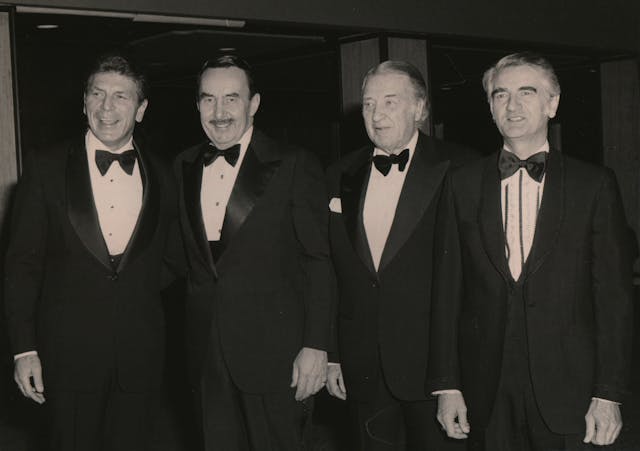
There was pride in his chiseled face—joy, even. I saw his passion for the work. The automotive industry meant something to him. He was serious, but sentimental, too.

On the wall hung a letter from President Ronald Reagan, thanking Meyers for attending a meeting of auto executives at the White House. The president specifically enjoyed that Meyers had complimented the old Jeep CJ-6 he kept at his California ranch. Although Meyers hadn’t pointed it out during my first visit, I doubt anyone from GM, Ford, or Chrysler received such a letter.

Car enthusiasts may never recognize Gerald C. Meyers in the same breath as Lee Iacocca, John Z. DeLorean, or even George Romney, but his impact remains important. Throughout his career, Meyers brought action and energy to American Motors. Although I am sad that he’s passed away, I’m thankful we had the chance to capture his story.
Joe Ligo is the producer and director of The Last Independent Automaker. You can learn more and support the documentary here.
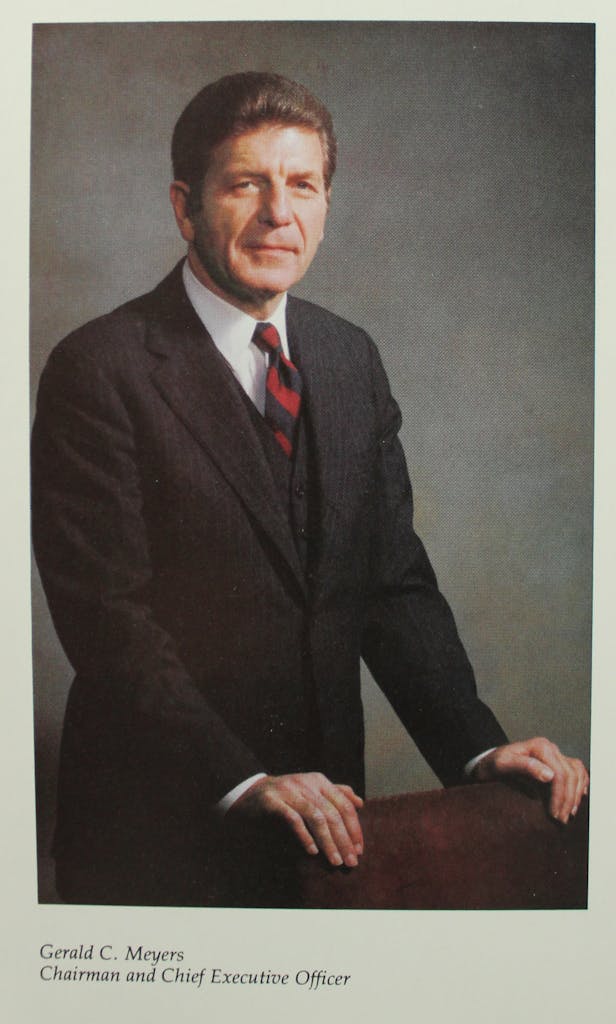
***
Check out the Hagerty Media homepage so you don’t miss a single story, or better yet, bookmark it. To get our best stories delivered right to your inbox, subscribe to our newsletters.
The post Gerald C. Meyers, former AMC CEO, dies at age 94 appeared first on Hagerty Media.
]]>
In the 2010s, Alfa Romeo renovated its museum near Milan, Italy. Spacious, well-lit, and scattered over several stories, the space organizes its vehicular displays by theme. Most of the prewar cars live in one room, race cars congregate in another, and more modern sedans (including a lovely 156) get their own display.
Most of Alfa Romeo’s classic models are sought-after; they’re generally restored, well-kept, and displayed at car shows. But Alfa Romeo deserves credit for highlighting nearly every part of its 110-year history: The story, as told by the manufacturer, isn’t limited to the usual suspects, the greatest hits, and the poster-worthy models. I’ve owned several classic Alfas, and even ran an owner’s club in Salt Lake City for a couple of years, yet I walked out of the museum with several new pieces of knowledge.
Approaching the collection like an Easter egg hunt, I discovered the first surprise in the prewar room: a 1931 6C 1750 Gran Sport with an “Alfa Romeo Paris” emblem on its grille. Lorenzo Ardizio, the museum’s curator, clarified that the French city’s name on the Italian car’s nose isn’t a typo or a one-off request: In the ’30s, Alfa Romeo shipped some of its cars as kits to Paris, where they were assembled by a local firm.



The prewar cars grow sleeker with each year, giving visitors a quick course in automotive aerodynamics. (The leap between, say, a 1932 8C 2300 Corto and a 1935 6C 2300 B is significant.) Performance improves over time, too: the 2300 B (one of 86 units built) uses a 2.3-liter straight-six rated at 76 horsepower, enough for a top speed of approximately 81 mph. Fast-forward to 1947, and you’ll find the 6C 2500 Sport “Freccia d’Oro,” which tops out at about 96 mph thanks to a 2.4-liter straight-six tuned to develop 90 horsepower.
Alfa Romeo’s next chapter begins with a 1955 Giulietta finished in an eye-catching shade of red. (Your local home improvement store would likely label it “salmon.”) Offered in numerous body styles, the original Giulietta (the nameplate has surfaced twice since) is unquestionably one of the most important cars in Alfa Romeo’s history: It shifted the company towards the mainstream market both in Italy and abroad. The O.G. Giulietta passed the torch to the first-generation Giulia, which is also proudly displayed in the museum.




From there, we get to the modern (1970s and on) cars with which most Alfisti are familiar. There’s a Montreal, an Alfetta, a 75 (briefly sold as the Milano in the United States), a 164, and the aforementioned 156. The red Alfasud gives the smaller, flat-four-powered cars their 15 minutes of fame, though its successor, the 33, is one of the models that wasn’t displayed during my visit. Keep walking, and you’ll find yourself nose-to-grille with better-known classics, including the 115-series GTV. You’ll then wander into a room full of race cars, many of which would inspire an enthusiast to sell an organ to purchase.
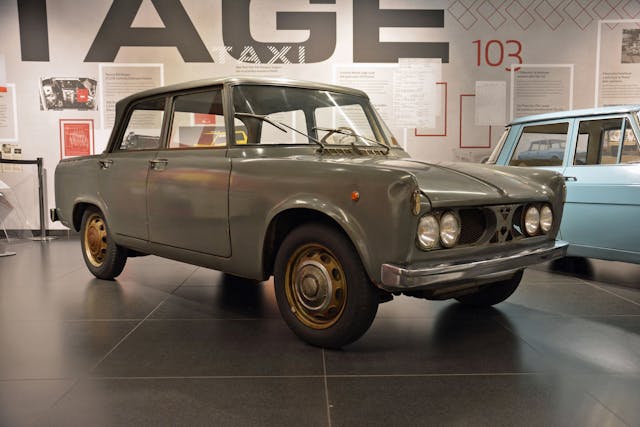
Here’s what you won’t see at cars and coffee: a Giulia prototype, built in 1959 to put the then-upcoming sedan through its paces without revealing its final design to prying eyes. Even with the power of hindsight, it’s not easy to forge a link between this test mule and the sedan launched in 1962. The overall proportions and the shape of the steel wheels are the main giveaways, but the rest is uncharted territory. It wears four round headlights, no grille, little in the way of exterior trim, and fenders that end in tailfins reminiscent of those on contemporary American cars. The roofline is Giulia-esque, but the quarter panels are finned and the back end features two vertical lights.





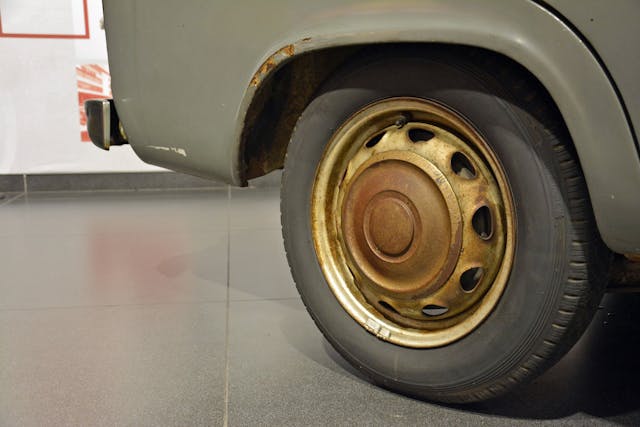



Have you ever cooked pasta e fagioli on an Alfa Romeo-built stove? I haven’t, but I’m guessing some Italian households have: There’s just such a kitchen appliance in the museum, complete with cool, car-like dials.
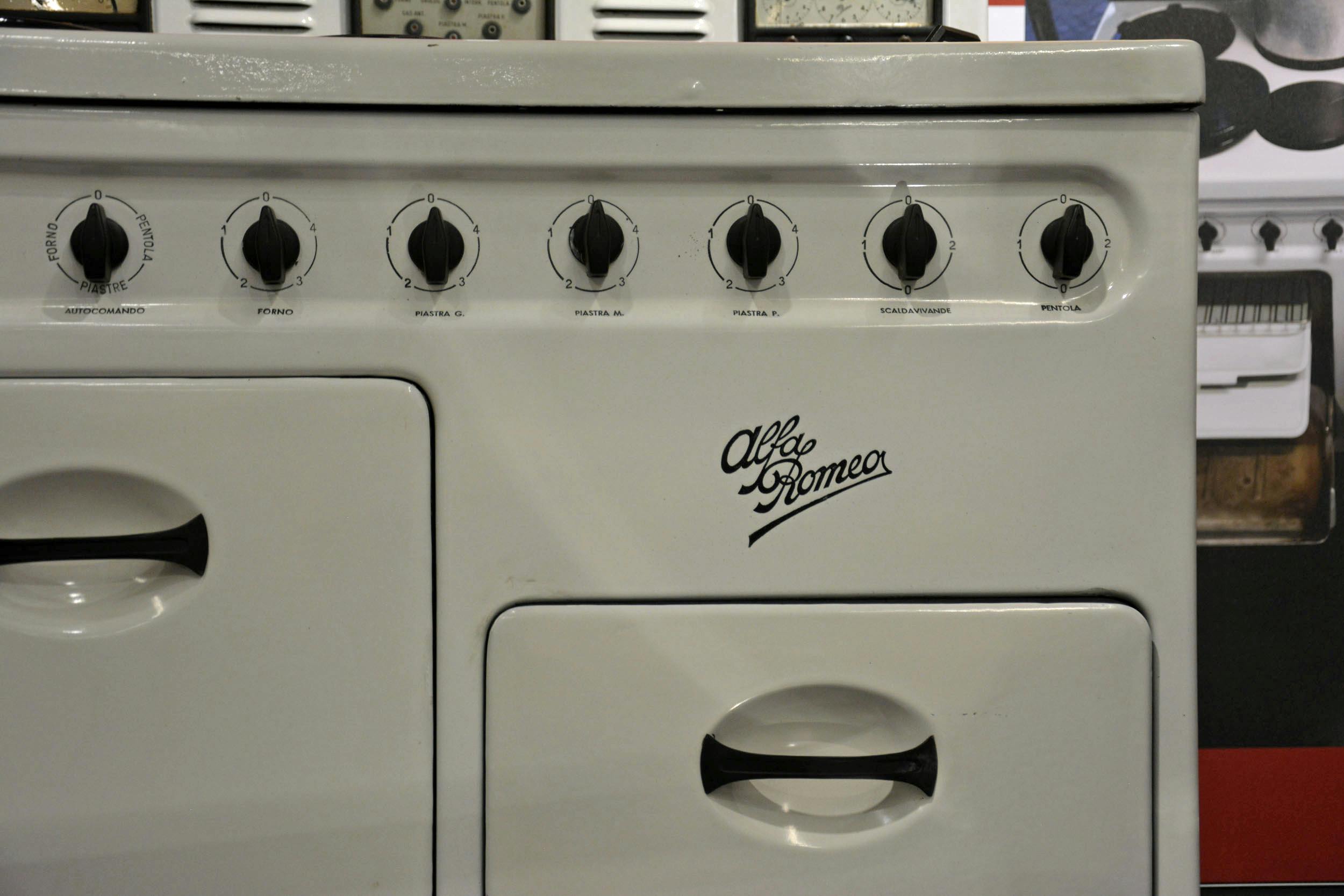

Something else your Alfa Romeo–hoarding buddy has never owned: the Tipo 103 prototype. Designed in the late 1950s and tested through the early 1960s, it’s characterized by a boxy design that, grille aside, could pass as just about any entry-level sedan built in Europe during this era. And yet, what’s under the sheetmetal would have made this little sedan revolutionary . . . had it ever seen the end of a production line.

Power for the Tipo 103 comes from a twin-cam, all-aluminum engine installed transversely in the front of the car and mounted inline to a manual transmission. This orientation of engine and gearbox is more modern than that of the original Mini or, later, of the Peugeot 204, each of which had its transmission bolted below its engine. The Tipo 103’s suspension system was even more futuristic for the mid-century era: Alfa Romeo incorporated what it describes as “an electric system” into the rear axle to adjust the car’s ride height.
A carmaker rarely reveals the obscure projects it canned, so these never-realized Alfas on display are truly special treats.








At the other end of the “what the hell is that?” spectrum, Alfa’s museum holds a room full of concepts, such as the 1952 C52 Disco Volante, the 1965 Giulia Sprint Speciale, and the 1996 Nuvola. In contrast to the see-if-it-works Tipo 103, these cars were designed to grace the covers of magazines and were presented by Alfa at major international events. They’re no less interesting than the engineering prototypes: the one-off Nuvola, for example, helped shape Alfa Romeo’s 21st-century design language.
Finally, one of the permanent exhibits highlights the Alfa Romeo models that various agencies within the Italian government have used over the past couple of decades. They range from mundane to exotic: The 1.8-liter-powered 75 is what you could expect to see in your rear-view mirror if you summoned the Carabinieri’s dark cloud of disapproval in the early 1990s. You’d end up with an Alfetta on your tail if you broke the law in the 1970s, and a Giulia behind you if you broke the same law 10 years earlier. Then, there’s an ultra-rare Giulia Super wagon built by coachbuilder Colli. And, pop quiz: what was Alfa Romeo’s first small SUV? It’s not the Tonale, due out as a 2024 model. It’s the AR51 Matta, a Jeep-like off-roader that won its class (!) in the 1952 Mille Miglia.
If you visited the Alfa Romeo museum, which car (or room) would you beeline toward?











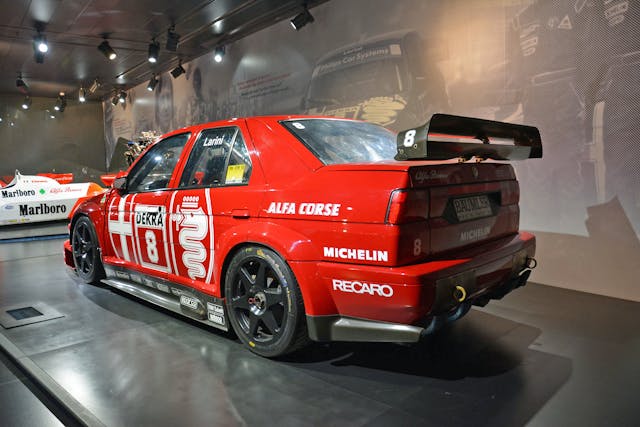







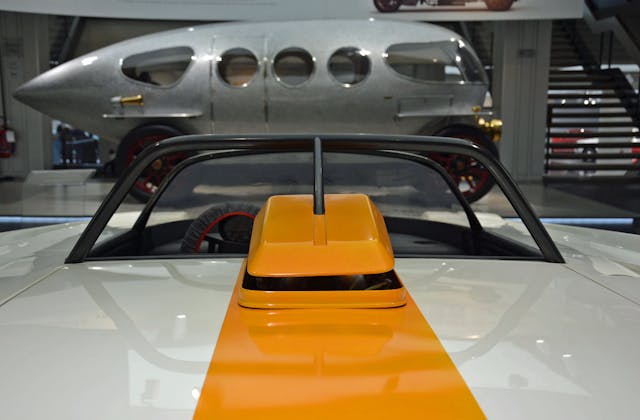




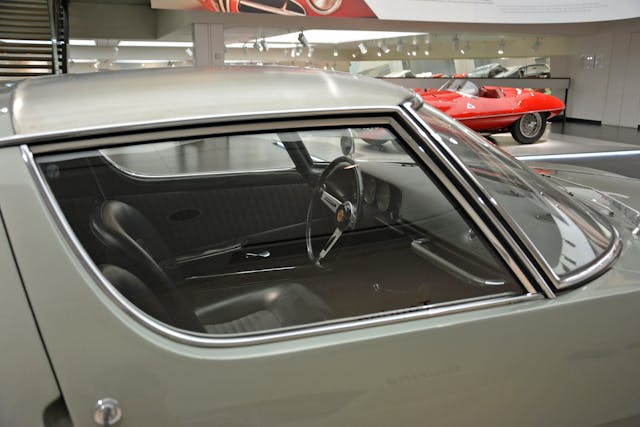

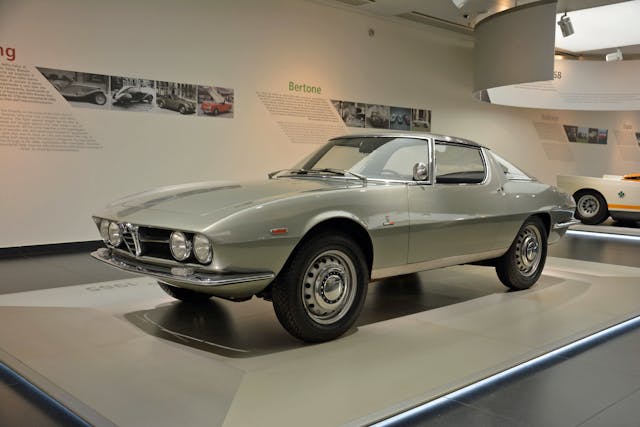





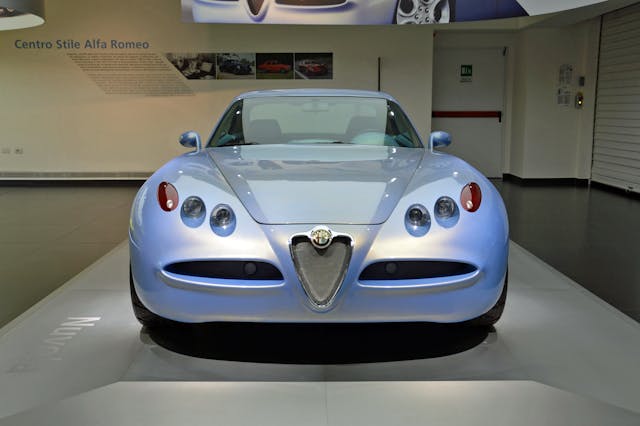
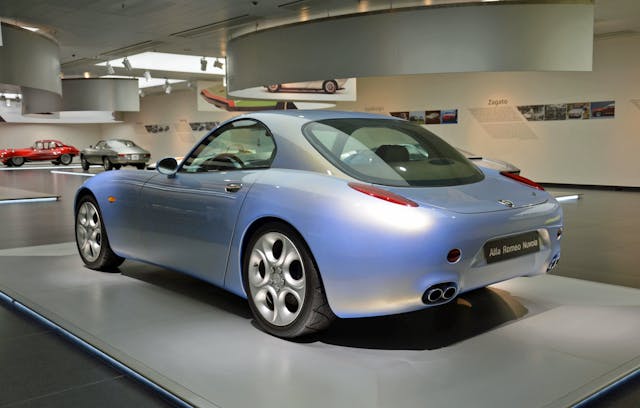



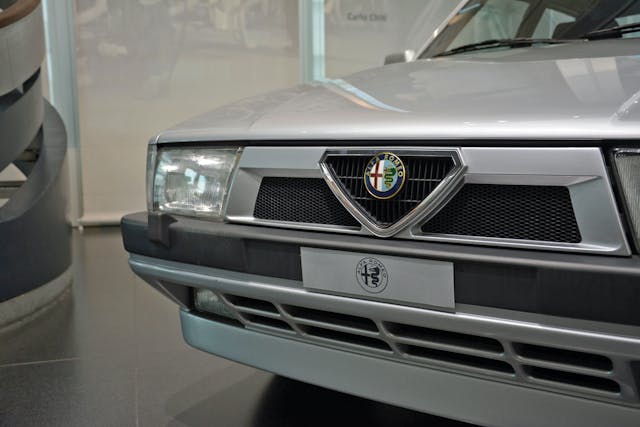


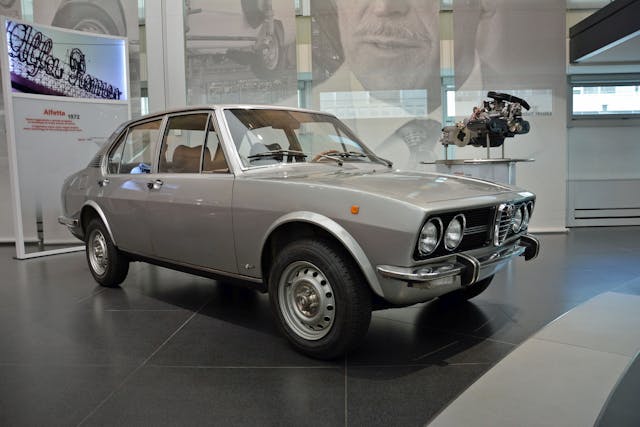
























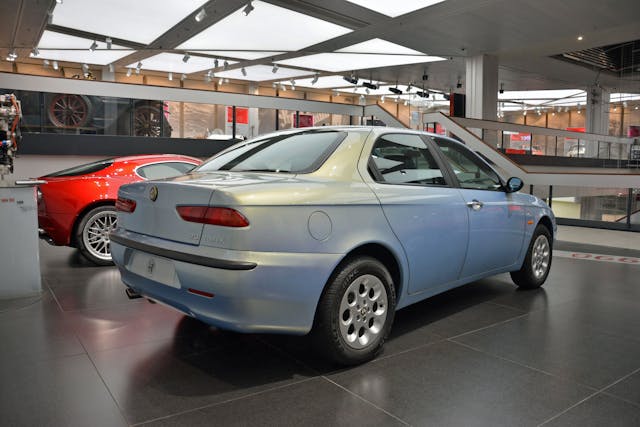






***
Check out the Hagerty Media homepage so you don’t miss a single story, or better yet, bookmark it. To get our best stories delivered right to your inbox, subscribe to our newsletters.
The post Alfa Romeo’s museum plays it all, from greatest hits to deep cuts appeared first on Hagerty Media.
]]>
Whether you’re looking for economical family entertainment or a more intimate way to watch a movie with a love interest, there’s nothing quite like a drive-in theater. While some accounts claim that movies were shown outdoors as early as the 1910s, the first patented “Park-In Theatre”—as they were first called—opened 90 years ago on June 6, 1933 in Pennsauken Township, New Jersey, near Camden.


The brainchild of Richard Milton Hollingshead, Jr., the venue offered moviegoers a new—and for many, an easier—way to watch a film: in the comfort of their own “Private Theatre Box.” Hollingshead, a sales manager at his father’s Camden company, Whiz Auto Products, was reportedly inspired by his mother’s struggle to sit comfortably in traditional movie-theater seats. According to PBS.com, Hollingshead tested the idea of an outdoor theater by using a 1928 Kodak projector, a sheet nailed to a tree in his backyard, and a speaker placed behind the “screen.” He spent weeks perfecting the idea, even turning on his sprinkler to simulate rainy conditions. By spacing and staggering the parking spots, he also ensured that the occupants of each car would have an unobstructed view of the screen.

On August 6, 1932, Hollingshead applied for a patent. “My invention relates to a new and useful outdoor theater,” he wrote in his application, “whereby the transportation facilities to and from the theater are made to constitute an element of the seating facilities.”
The patent was approved on May 16, 1933, and within three weeks, Hollingshead’s outdoor theater was open for business. Charging 25 cents per car and 25 cents per person—and capping the cost at $1 per vehicle—Hollingshead advertised this new-fangled entertainment venue as a more comfortable alternative to traditional movie houses. “The whole family is welcome,” he told New Jersey’s Courier-Post newspaper, “regardless of how noisy the children are.”

The first film shown on the outdoor screen was the comedy Wives Beware (also known as Two White Arms), starring Adolphe Menjou and Margaret Bannerman. Menjou began his acting career in silent films but was able to make a successful jump to “talkies.” In fact, he sang the title song on Wives Beware.
The drive-in’s sound quality was initially poor—Hollingshead mounted three RCA Victor speakers near the screen—but later technological advances allowed individual speakers to be hung on each driver’s-side window. Eventually, passengers could tune the car’s FM radio to the movie soundtrack.
Other entrepreneurs began to copy Hollingshead’s idea. After years of fighting in court, his patent was overturned in 1949. With the threat of legal action removed, drive-in theaters began popping up all over the country, particularly in rural areas. At one point in the 1950s, there were as many as 4000 outdoor venues in the U.S., proving the idea was more than a fad. One of the largest drive-ins was the All-Weather Drive-In of Copiague, New York, which featured parking space for 2500 cars. Its 28-acre property included a children’s playground and full-service restaurant.
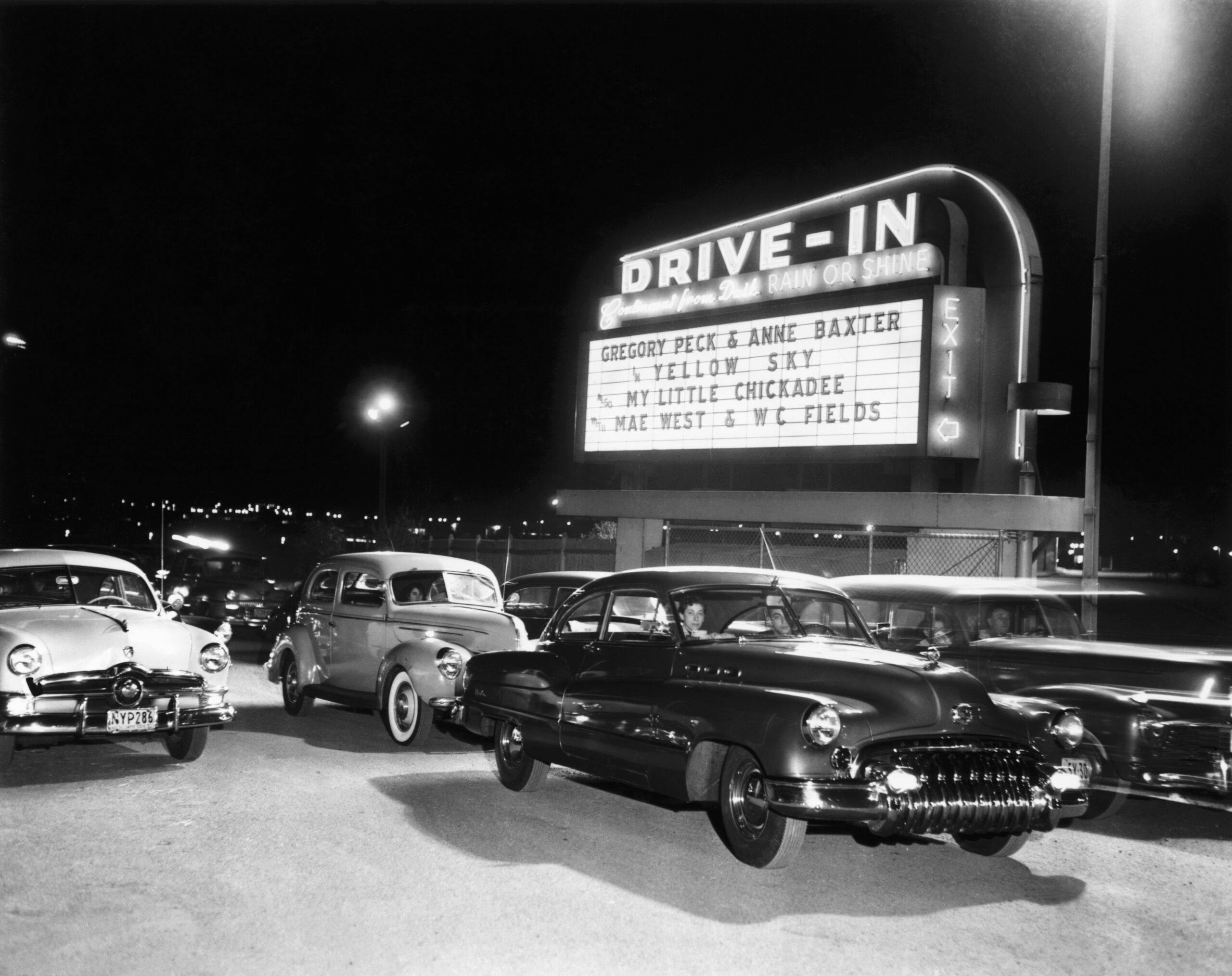


Of course, in many parts of the country, drive-ins could only be operated during the summer, limiting revenue. By the 1970s, drive-in theaters began to lose their appeal as people began to buy smaller, less lounge-friendly cars, and VCRs offered movie fans the opportunity to watch from their couches.
According to the National Association of Theater Owners, in 2020 only 549 drive-ins remained in the U.S., a number that no doubt received a financial bump from COVID-19 restrictions that limited or eliminated indoor gatherings. In fact, many “pop-up” drive-ins using inflatable screens opened during the pandemic.
Though it may be a less popular venue, a drive-in is still a fun way to watch a movie. Today most venues offer double features, continuing their reputation as affordable entertainment. Somewhere, Richard Hollingshead is smiling … and so is his mom.
***
Check out the Hagerty Media homepage so you don’t miss a single story, or better yet, bookmark it. To get our best stories delivered right to your inbox, subscribe to our newsletters.
The post Happy 90th birthday to the drive-in theater appeared first on Hagerty Media.
]]>
As Cole Porter might have put it: In the 1920s and 1930s, Alfa Romeo was The Top! Vittorio Jano was there, along with Gioacchino Colombo and Enzo Ferrari. Thanks to high-performance models such as the Zagato-bodied 6C 1750 GS, the 8C 2300 Le Mans, and the 8C 2900B—plus a host of world-class racing cars—Alfa Romeo was indisputably the grandest of Grand Marques, rivaled only by Bugatti.
World War II ruined all that. Completely controlled by Benito Mussolini’s government, Alfa’s factory in the Milan suburb of Portello was switched in 1940 from hand-crafting sports cars to assembling Daimler-Benz 34.0-liter V-12 aero engines under license. Flattened by Allied bombers in 1944, Alfa needed years to resume passenger-car production.
In the meantime, the automaker dominated early postwar grand prix racing with a prewar design. Two types of engines were eligible for Formula 1 in the post–World War II world: 4.5 liters normally aspirated or 1.5 liters supercharged. Designed in 1937, Gioacchino Colombo’s jewel-like 1.5-liter inline-eight could be supercharged to produce more than 420 horsepower, albeit while guzzling an explosive mixture of gasoline, methanol, and nitromethane.
In a competition career that stretched from 1938 to 1953, Alfa’s 158/159 Alfetta won a remarkable 47 grand prix races out of 54 entered, including back-to-back Formula 1 World Championships in 1950 and 1951 with aging prewar star Giuseppe “Nino” Farina and newcomer Juan Manuel Fangio. Today, only a few authentic Alfettas still exist, as well as two accurate replicas. If you’d like to buy one, the price for a genuine icon of racing history is going to be steep. Is $5 million too much? Maybe $10 million?

Though Alfa dominated Formula 1, it struggled with passenger cars. The 1946 Freccia d’Oro, derived from the prewar bread and butter 6C 2500, was a big, expensive Gran Turismo with coachbuilt bodywork; it was completely out of touch with economic conditions in war-ravaged Europe. Though few were sold, the 6C 2500 remained in Alfa catalogues until 1953. Today, 6C 2500 prices vary wildly, depending on condition, body style, and which coachbuilder built the body. Restoration projects start at less than $300,000; attractive, concours-winning convertibles can be worth more than $1 million.
Alfa’s first postwar design was the 1900, which appeared in 1950 and stayed in production until 1958. Some 20,000 were built, about as many as all the prewar Alfas put together. A new 80-hp, 1.9-liter dual-over-head-cam inline-four used chains rather than gears to drive the camshafts, but otherwise it was very similar to Vittorio Jano–designed engines dating back to 1924. The new engine went into a factory-made unitized body/chassis sedan that looked like a bread box.
There was also an alternate sports-car chassis with a conventional ladder frame, independent front suspension, huge drum brakes, and Borrani knock-off wheels. The 1884-cc Sprint and 1975-cc Super Sprint were the last Alfas supplied in bulk to carrozzeria. Most of these smooth and desirable coupes and spiders received bodies by Bertone, Castagna, Pinin Farina, Touring, Vignale, or Zagato.




Today, you can buy a 1900 coupe with attractive, batch-built coupe bodywork by Touring or Pinin Farina for roughly $300,000, while a one-off, Zagato-bodied 1900 CSS Berlinetta with racing history, celebrity ownership, and concours restoration is going to cost you at least $1 million … or even double that.
The 1900 was a start, but what really saved Alfa Romeo was the smaller Giulietta/Giulia series, which debuted at the 1954 Turin Auto Show and stayed in production for an amazing four decades. The Giulietta/Giulia had a unitized body/chassis, front-engine configuration, rear-wheel drive, independent front suspension, a rigid rear axle with multi-links, and coil springs all around.
The new DOHC inline-four was built in 1290-cc, 1570-cc, 1779-cc, and 1962-cc versions and drove through either a four-speed or five-speed gearbox. There were the expected sedans and wagons, but, more important for our story, there were two new sports cars.
The Giulietta 1300 began with the adorable Carrozzeria Bertone Sprint coupe in 1954; the equally attractive Pinin Farina Spider came along in 1955. Both grew into the Giulia 1600 in 1962. The larger 2000 inline-four and 2600 inline-six engines were put into a similar but bigger chassis to create an exclusive Gran Turismo, but the 2000/2600 was both more expensive and less attractive—it also wasn’t as much fun.
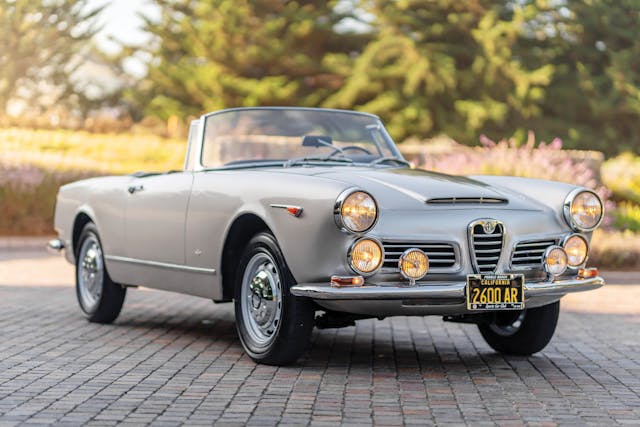
The little Giulietta/Giulia Sprints and Spiders have risen precipitously in value; the best ones are approaching $250,000, though good ones can still be found for under $100,000. Compared with a Porsche 356, however, a Giulietta or Giulia seems like a bargain. These are delightful little cars—the very definition of an Italian sports car. They will always be in demand, and guaranteed to put a smile on your face.
From 1958 until 1967, Bertone built exactly 1366 coupes with either 1300 or 1600 engines on short-wheelbase Giulietta chassis. Styled by Franco Scaglione and called Sprint Speciale, the SS has always been controversial. People who love the SS consider it to be an exquisite jewel, while people who hate the SS think it’s the visual equivalent of chewing on tin foil. There is no middle ground! Back at the peak of the collector-car market in 2014, prices approached $500,000, but have since fallen precipitously. A mere $150,000 will now buy you a great Sprint Speciale.
At the 1960 Geneva Salon, Zagato presented a lightweight, street-legal Giulietta coupe by young styling sensation Ercole Spada. With aerodynamic aluminum bodywork and Plexiglass windows, 217 copies of the Sprint Zagato were completed by 1962. Using the SZ, Alfa Romeo won the 1.3-liter category in the FIA Grand Touring Manufacturers Championship in both 1962 and 1963. These exquisite little coupes are now priced from $500,000 to $750,000.

Back in the 1930s, Dr. Wunibald Kamm had theorized that a car with a vertical flat tail would generate turbulence that would act like the pointed tail of a teardrop to increase aerodynamic efficiency. In 1963, Alfa replaced the SZ with the TZ, also styled by Ercole Spada and incorporating a truncated “Kamm tail.” Only 112 TZs were completed in four years, with Giulia 1600 running gear and lightweight Zagato aluminum bodywork. A TZ weighed just 1460 pounds, ready to race. Nowadays, a TZ is worth twice as much as an SZ, anywhere from $1 million to $2 million.
A more radical Kamm tail graced the 1965 TZ2. This used a fiberglass body instead of the TZ’s aluminum, which not only improved aerodynamics but got the weight down to 1370 pounds. With 175 horsepower from a Conrero-tuned, 1570-cc Giulia engine, a TZ2 could easily top 150 mph. Only 12 TZ2s were built, and it will now take roughly $3 million to park one in your garage.
Nowhere near as rare but just as collectible is the 1963 Alfa Romeo Sprint GT, designed by a very young Giorgetto Giugiaro for Bertone. Over the next 14 years, the GT was powered by every size of Giulietta/Giulia engine, turned into a variety of racing models, renamed Gran Turismo Veloce, and became a classic in its own right. The GTV has proved to be timeless and evergreen, one of the most beloved Alfa Romeos of all.

GTVs from the 1960s and 1970s are now in the $50,000 to $100,000 range for a good one, less than half the price of a Porsche 911 with which these Alfas originally competed. GTA and GT Trans-Am racers are going for astronomical amounts, but still significantly less than a Porsche 911 Carrera RS or RSR.
In 1966, the GTV was joined by an equally popular new spider designed by Franco Martinengo for Pininfarina. For the first four years, the spider had a distinctive rounded boat tail. This highly desirable model is now often called the Duetto and was made famous in the 1967 film The Graduate. Just 9000 were made. Prices are now in the $30,000 to $50,000 range, surprisingly less than the mechanically similar GTV.
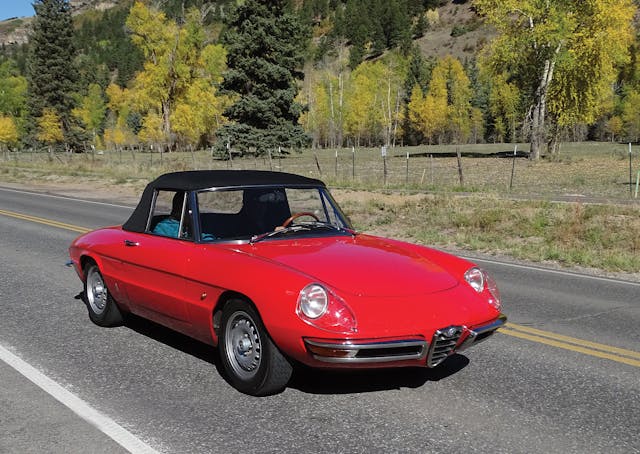
In 1970, the spider was given a flat tail sort of like that on the TZ coupe. The timeless model soldiered on until 1993, just two years before new owner Fiat pulled Alfa out of the U.S. market. By then, Alfa had sold 110,000 Kamm tails. Run-of-the-mill Alfa spiders from the 1980s and 1990s can still be found for less than $10,000, and even concours winners are going for less than $50,000.
There is one postwar Alfa Romeo sports car that was never sold in the U.S. when new but has still become a significant collectible. At the 1967 Montreal Expo, Alfa exhibited a concept car with body by Marcello Gandini of Bertone on a Giulia Sprint GT chassis. This was put into limited production with a 2.6-liter V-8 derived from the Alfa Tipo 33 sports/racer.
Alfa built just 3700 Montreal coupes in six years, priced even higher than a Jaguar E-Type or Porsche 911. Thanks primarily to high maintenance and restoration costs, these rare machines are surprisingly inexpensive, averaging around $60,000 over the past five years, and less than $100,000 for the best of the best.

In 1986, Alfa Romeo was taken over by Fiat, becoming part of Gianni Agnelli’s “ladder of marques” that climbed in price and prestige: Fiat, Alfa Romeo, Lancia, Maserati, Ferrari. In 1989, Alfa stylist Antonio Castellana and Fiat stylist Robert Opron collaborated to design a limited-production sports car confusingly named SZ, like the totally different model from three decades earlier. The new SZ was based on the Alfa Romeo Milano 75 sedan that had finally replaced the Giulietta.
For the SZ, the Milano chassis was modified with a racing suspension; Koni shock absorbers; wide wheels wearing Pirelli P Zero tires; a 210-hp 2959-cc V-6; and a five-speed manual gearbox. Zagato built the SZ coupe and RZ convertible with unique injection-molded thermoplastic body panels. A total of 284 SZ and RZ models were completed over a period of five years. One of these Alfa SZs from the early 1990s will cost you between $40,000 and $100,000 depending on condition, but now that they are more than 25 years old and can be imported into the United States, prices are rising rapidly.
Every Alfa Romeo sports car ever built is being collected somewhere by a fanatical Alfisti. There’s a reason. Alfa Romeo embodies the timelessly iconic Italian sports car mystique: exciting, high-performance machines that are technically interesting, artistically beautiful, and fun to drive.
Postwar Alfa Romeos is one of 20 classes to be featured at the 2023 Greenwich Concours d’Elegance, on June 2-4, 2023. Download the 2023 Greenwich Concours d’Elegance event program to learn more about Sunday’s other featured classes, Saturday’s Concours de Sport, our judges, sponsors, non-profit partners, 2022 winners and more!
***
Check out the Hagerty Media homepage so you don’t miss a single story, or better yet, bookmark it. To get our best stories delivered right to your inbox, subscribe to our newsletters.
The post Alfa rose from WWII’s ashes to build decades of coveted cars appeared first on Hagerty Media.
]]>
The idea of show cars arrived in 1939, when General Motors built a car called the Buick Y Job. The Y Job was GM’s attempt at producing an advanced-styled show car. The value in building such cars was to create public exposure for the manufacturers through articles in magazines or newspapers, as well as auto shows and dealerships. The primary purposes were to increase the sales of production cars, to test public reaction, create favorable perceptions of the manufacturer, and to introduce new features.
Then in 1940, Chrysler introduced both the Thunderbolt and Chrysler Newport show cars. Between four and six Thunderbolts were built for display across the country, each painted and trimmed differently. Next, six Chrysler Newport automobiles were designed and built by LeBaron, a well-known Detroit coachbuilder. One Newport actually became the pace car for the 1941 Indianapolis 500. For corporate security reasons as well as costs, Chrysler looked overseas to find a satisfactory coachbuilder. It found that company in Ghia, located in Turin, Italy.

A brief history of Ghia
Scroll back 90-plus years ago and the town of Turin was to coachbuilding as Florence, Italy, was to the Renaissance. Many automotive coachbuilders (carrozzerie) with hammer-wielding skills created car bodies that eclipsed Detroit’s stamped-steel methods. The Italians’ skills were products of centuries of experience going back to the armorers of the Middle Ages. For the carrozzerie, these skills translated into the ability to execute complex metal panels over simple wooden forms with marvelous dexterity of compound curvature and executing beautiful design.
Giacinto Ghia was born on September 18, 1887, and began working at age 15 in a number of small Turin-based carriage/coachbuilders, progressing from woodwork to mechanics to testing of new cars. Shortly after the outbreak of World War I, Ghia joined the Diatto company as a test driver. That ended in 1915 with a crash that broke both his legs.
Ghia then put his early training in carriage/coachbuilding to begin subcontracting to build wooden framework for car bodies for Diatto. By 1918, he had gained a reputation as an excellent body builder. In 1919, Motor Italia described Ghia as “one of the Torinese coach builders whose woodwork bears the imprint of great distinction.” During the late 1930s, Ghia hit its peak production, turning out eight to ten cars a month. This ended at the outbreak of World War II.
During the war years, Ghia built trailers and carts for the Italian army plus bicycles sold on the black market for the local population for transportation. The Ghia facility was demolished in 1943. Ghia was determined to rebuild but died on February 21, 1944. He was only 56.

Chrysler makes the Italian connection
In 1949, K. T. Keller, president of Chrysler realized that the lackluster styling of the company’s cars was an issue. The company’s conservative styling was becoming a trademark in the industry and sales were dropping. Ford passed Chrysler in sales in 1952 and the company had a 12-percent market share in 1954. Other automakers were beginning to make good use of curved-glass windshields, slab-side styling, flattened hoods and fender lines, plus sleek styling.
To begin to address the challenges, Chrysler contacted Ghia and one of its Italian competitors, carrozzeria Pinin Farina, to discuss building a car. In early 1949, Chrysler sent a Plymouth chassis to each coachbuilder; the Ghia car received a more favorable response. Keller was sufficiently impressed by Ghia’s design, craftsmanship, and certainly the moderate cost of only $10,000. Interestingly, in 1949 as well, Kaufman had hired a stylist, Virgil Exner, to revive Chrysler’s design image. Exner was not hired as the overall head of styling (that would occur in the mid-1950s), but mainly as a catalyst who was given a small staff and work area to design and arrange production with Ghia of one-off Chrysler “Idea Cars.”
Keller’s plan, which Exner supported, was to build not radical, futuristic-looking styling exercises, but cars that were fully functional. The purpose was to test public reaction, but more important, help change perception (of both the public and the company’s financial backers) that Chrysler really cared about contemporary styling and what the public could expect in the near future. Exner established the Advanced Styling Group; this group and the new collaboration with Ghia were the main forces in the creation of Chrysler’s Idea Cars.
The first Exner-designed show car was produced in late 1951 by Ghia and marked the initial beginning of the Idea Car Program. The car was called the K-310; the “K” was in honor of K. T. Keller. The K-310 was a two-door, four-passenger hardtop with a 331-cubic inch Hemi engine. It was painted blue and black and had a big eggcrate grill. It reflected Exner’s design philosophy, which he had promoted since his days with Studebaker: simple classic surfaces accentuated the functional elements of the car, rather than hiding them.

Exner insisted that all the show cars be designed as practical roadgoing automobiles, not simply static show cars like the General Motors Motorama specials. He also decreed that all vehicles be made from steel, although the Italians preferred aluminum. The K-310 was followed by the Chrysler C-200 convertible. Both cars have yet to be rediscovered and may no longer exist today.

In late 1952, Ghia built for Chrysler a car designed by Virgil Exner that was known as the Chrysler “Styling Special,” which is on the field today. This car, known as the Fastback design, was the only example built. Later in 1953, Chrysler built a similarly shaped body with a few other changes that it called the “Thomas Special,” named for Chrysler’s vice president of export sales, J. B. Thomas. Experts estimate that 12 of the 18 examples built still exist today—truly a limited-production car. The Chrysler Styling Special could be considered the father of the Thomas Special.
Then in 1954, a somewhat redesigned Thomas Special was built, called the Chrysler GS-1. Approximately 10 to 12 of these were built. None of the three phases of similarly designed cars were sold to dealers or purchased by individuals. Instead, they usually were given to world leaders, very important people, or members of Chrysler’s Board of Directors. The last version—the GS-1—was only sold in Europe by the Société France Motors, Chrysler’s distributor for France. Approximately eight GS-1s still exist. The Styling Special on the field today was the first version that influenced the very limited number of Thomas Specials and GS-1s made.
Exner was involved with all the Ghia-designed idea cars, including the 1961 XNR and the 1962 Chrysler Turbine car. Rising to vice president of styling in 1956, he left Chrysler in 1961. He died on December 22, 1973, at just 65 years old. During his tenure, Exner worked with Ghia to design and produce some of the most amazing cars ever to come out of Chrysler, and today we honor that achievement.
Ghia Concepts is one of 20 classes to be featured at the 2023 Greenwich Concours d’Elegance, on June 2-4, 2023. Download the 2023 Greenwich Concours d’Elegance event program to learn more about Sunday’s other featured classes, Saturday’s Concours de Sport, our judges, sponsors, non-profit partners, 2022 winners and more!
***
Check out the Hagerty Media homepage so you don’t miss a single story, or better yet, bookmark it. To get our best stories delivered right to your inbox, subscribe to our newsletters.
The post When Chrysler wanted “wow” it called Ghia appeared first on Hagerty Media.
]]>
In the late 1960s and early 1970s, American automakers began offering suitably psychedelic and wild exterior paint colors for their muscle cars—a perfect match for the era.
Commonly referred to as “high-impact colors,” these shades appeared in the spring of 1969, when Chrysler’s Dodge and Plymouth divisions introduced one of the first and rarest high-impact colors. For Dodge it was known as Bright Green and for Plymouth it was Rallye Green; each division had its own name for the same color. Additional colors were orange—Go Mango for Dodge and Vitamin C for Plymouth—and a yellow that Dodge called Butterscotch and that Plymouth named Bahama Yellow.
Chrysler’s color palette expanded for the period from 1970 to 1971. One of the most desirable hues was a purple known as Plum Crazy for the Dodge products and In-Violet for Plymouth. Other color names included Lemon Twist/Top Banana, Tor-Red/Hemi Orange, Moulin Rouge/Panther Pink, and Sassy Grass/Green Go, to name a few. These high-impact colors lasted until 1974.

Not to be left behind, other Detroit automakers got in on the trend. From 1969 to 1970, American Motors offered Big Bad Blue and Big Bad Green; its most popular color was Big Bad Orange. At General Motors, in 1969, Pontiac introduced Carousel Red, which was a popular color for the GTO Judge. In 1970, Pontiac also offered Orbit Orange, again exclusive for the GTO Judge model; Chevrolet called the color Hugger Orange. The Buick division had Saturn Yellow and, for one year, a conservative Apollo White color for its GSX model. Oldsmobile had a special 1970 Cutlass Rallye 350 model in a vibrant Sebring Yellow hue with color-keyed yellow bumpers. Last but not least, Ford had its bright Grabber Blue, Grabber Orange, Grabber Green, and Grabber Yellow in 1971.
In 1969, the AMC Hurst SC/Rambler was a special model with a red, white, and blue patriotic paint scheme. An option for a toned-down paint job was available as well. The SC/Rambler featured a conservatively rated 315-hp, 390-cubic-inch V-8 (AMC’s largest engine in 1969) and a Hurst four-speed manual shifter. The following year, AMC featured a special 390-cubic-inch, 340-hp V-8 engine in the Rebel Machine. It had a special red, white, and blue stripe on a white body and an option to paint it in any AMC color that was offered in the Rebel.
The high-impact colors added more excitement and flash to the muscle car era; combined with a dual-exhaust rumble and neck-snapping acceleration, the paints made these cars truly stand out among other vehicles of the period.




High-Impact Colors is one of 20 classes to be featured at the 2023 Greenwich Concours d’Elegance, on June 2-4, 2023. Download the 2023 Greenwich Concours d’Elegance event program to learn more about Sunday’s other featured classes, Saturday’s Concours de Sport, our judges, sponsors, non-profit partners, 2022 winners and more!
***
Check out the Hagerty Media homepage so you don’t miss a single story, or better yet, bookmark it. To get our best stories delivered right to your inbox, subscribe to our newsletters.
The post High-impact colors: When hot muscle cars got some crazy paint appeared first on Hagerty Media.
]]>
In the early 1980s, Mazda was flush with capital from record sales and already deep in the design process for the next generation of the RX-7. Having proven to the world that it could solve engineering problems that had flummoxed other automotive companies (Wankel’s problematic rotary-engine design, for example), Mazda was confident in its ability to make its flagship sports car a true “world-class” competitor.
Riding all this momentum and strength, the company aimed to move its second-generation RX-7 upward in the market to meet and beat the Porsche 944, with a long-term goal for the third-gen car to surpass the 911’s performance. Mazda’s “stretch goals” were laudable, but the lofty aspirations left a void in the product line just beneath the RX-7—an opening crying out for a great car.
Meanwhile, the longstanding European supply of lightweight sports cars to America had all but shriveled up, leaving its own roadster-shaped void. Whether due to quality issues, labor unions, or America’s ever-restrictive emissions and crash-protection laws, European manufacturers could no longer supply 40,000 small sports cars to American customers annually.



Mazda product planner Bob Hall, a former journalist who fully understood the sports car market, made the suggestion to upper management that the company should develop an entry-level sports car to sit beneath the second-generation RX-7. The advice did not fall on deaf ears. The Porsche 911 had always had a more affordable showroom sibling, an even Toyota had a pseudo sports-car companion for its Supra in the MR2. A younger brother to the RX-7 made sense.
Bob sent a fax to the home office in Japan, inquiring if Mazda could be profitable with a car that sold only 40,000 units per year. The answer was yes, thanks to Mazda’s flexible assembly lines, which allowed a mix of models to be built in one factory (as opposed to GM and Ford practice, where one model supported a whole factory). Hall’s suggestion led to funding for an initial design study.

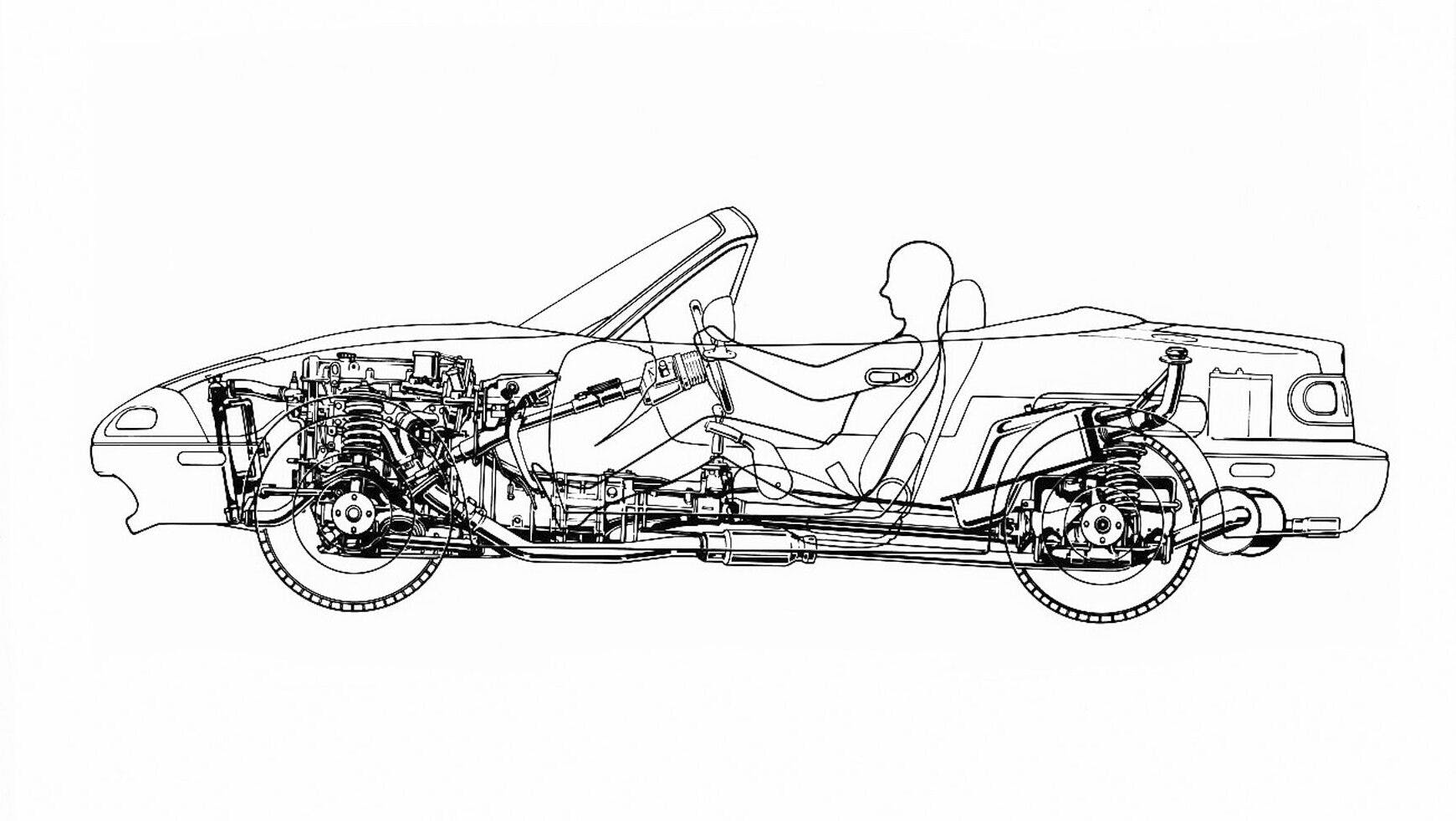
Every enthusiast employed by a car company has, as a core desire, a wish to create a performance car. No one doodles minivans in their high school notebooks, after all. Mazda’s small team of planners and designers were no different. I was no different. The new Lightweight Sports (LWS) concept, codename project 729, ignited a fire in Mazda’s Southern California Design Studio. I was hired as the first American engineer into a small skunk-works team that Mazda Japan had created to develop products for the U.S. market.
On my first day of work, my supervisor, Shinzo Kubo, asked what I knew about designing a sports car. I had gone to engineering school specifically to learn how to design race cars, and I had by that point owned, restored, and raced about 20 European sports cars, so I told him I might be able help. Since 1979, as a sort of foreshadowing of my own career, I had been marking up RX-7 brochures with a black Sharpie, blacking-out the roof to make the car a convertible and sketching in an open “mouth” at the front bumper. Needless to say, I was very much primed.

Everyone was. Among the stylists were a couple of Art Center graduates and a long legacy of sports car love, ownership, and appreciation. The product-planning department also held people deep in love with racing and sports cars.
Car companies around the world employ sports-car enthusiasts, of course, but at Mazda’s Southern California operation, we reached critical mass, thanks to our own rabid enthusiasm and an upper-management team that truly wanted to be the largest sports-car manufacturer in the world based on sales. (Mazda achieved that title in 1992, thanks mostly to the Miata.)
So we sat around the office’s little white common area and dreamed up specifications for the perfect 1000-kilogram (2200-pound) sports car. Each of us suggested special features that had endeared us to the cars we had owned: We counted over 65 different sports cars in our collective ownership history, from lowly Austin-Healey Sprites and Triumph Spitfires to Lotus Europas, Jaguar E-Types, De Tomaso Vallelungas, and Lamborghini Countaches. With the Mazda project, we had a blank canvas onto which we threw the best characteristics we could think of.
Informing much more than just the shape of the clay model, we were assembling the 729’s soul—trying to make it far more than just an attractive little car. The thing had to drive and race like the best we had known. And that became the engineering department’s job—to fit a capable sports car beneath the design studio’s skin.

The Southern California studio typically hosted visiting designers from Hiroshima. Those individuals would do a few years at our location, then rotate back home. Designer Masao Yagi was on staff when the initial study was commissioned, and he was given a drawing of the rear-wheel-drive GLC econobox chassis layout to work with. He did an exemplary job of draping a sports-car shape over that clunky and upright package, and that gave upper management something to consider.
A fiberglass body was made up from Yagi’s model, and we engaged the English firm International Automotive Design (IAD) to build a running prototype. After the prototype had been shipped back to us, we took it to Santa Barbara to drive around, so executives could view the shape in traffic. That was a key policy at Mazda; the company believed potential new cars should be seen and evaluated in their natural environment, not just in a sterile design studio.


I drove that prototype all around Santa Barbara. People were literally chasing me down to ask about it. At one point, I got stuck at a traffic light beside a Porsche dealership and was nervous about someone taking photos. Looking into the showroom, I saw a few people viewing a 944 on display. One by one, they left the Porsche and came to the window, looking at the prototype, pointing and calling for others to come see.
It was basically an ad-hoc focus group, and we could not have asked for a better demonstration of our concept’s attractiveness to the people who actually buy sports cars. That evening at dinner, R&D director Masataka Matsui said, “Maybe we should build this car.” With that, the “Miata” project was funded for a second clay model.
The styling would be its own challenge, but what lay underneath was critical, what makes a car a car. When an aerospace engineer designs a fighter jet, every part has to contribute to flight. Similarly, we compared every proposed specification for the 729 to the Lightweight Sports Car concept, all while embracing Lotus founder Colin Chapman’s motto of “simplify, then add lightness.”
“We can ditch the ashtray, no one smokes any more, anyway,” suggested planner Jim Kilborne, when we discussed reducing weight. All well and good, but at the time, 22 percent of Americans and more than 50 percent of Japanese men smoked, so the ashtray stayed.
“True sports cars don’t need radios,” Bob Hall offered in a meeting. “We’ll make the engine’s exhaust so melodious, [it’ll be] all you want to hear.” We all nodded in agreement, even though eliminating a sound system wasn’t practical. Such was our laser-focus on making the car enjoyable, light, and sporting.
“The car’s beltline has to be low enough so you can see the asphalt out of your peripheral vision, helping you gauge your speed and see apexes.” That was my suggestion. The idea stuck, and “sensing” the road over the Miata’s door top became a key element in how the car communicates to the driver in a corner.
The fever spread, in the best way, to Mazda’s home office in Hiroshima. Everyone on the project was all in, and the essence of a small, race-capable, high-quality jewel of a sports car became a guiding light. Driven by their own passion, enthusiasts in each department in Japan volunteered their time—often after hours—to work on the 729 project. It was as if we were all in love with the same girl, just without the jealousy.

As our work began in earnest, engineering delivered a much more condensed packaging layout for the second clay model—one suitable for a sports car, and that could be easily adapted for club racing. Because no amount of tuning can cover for poor decisions at the packaging and layout stage, we were careful to place the heavy components low and toward the center of the car for balance and weight distribution.
We were dedicated to a front engine/rear-drive (FR) configuration for a number of reasons, the joy of lift-off oversteer among them. We benchmarked the design against cars like the Lotus 7 and Lotus Elan (for driving “feel”), the Porsche 911 cabriolet (for soft-top function and chassis rigidity), and the Triumph Spitfire, MG MGB, and Alfa Romeo Spider (as beloved legacy designs).
Those early design stages held long engineering discussions. Takao Kijima and Jiro Maebayashi, two of the best vehicle-dynamics engineers in the world at the time, kept the focus on optimizing the 729’s handling and grip. As we saw this elegant chassis design come together, the excitement grew. Great credit goes to the late Toshihiko Hirai, who became the car’s program manager and fought so many internal battles at Mazda HQ—first to keep the project alive, and then to find tooling money to construct the special parts required to make the 729 work.
One of these parts the Power Plant Frame (PPF), the long metal brace that ties the Miata’s engine and transmission assembly to its differential. This part was purposefully engineered to allow quick on-off throttle action at 6000 rpm in second gear during full-g cornering without undue drivetrain wind-up—a quality that can kill a car’s controllability during, say, autocrossing or track lapping. I had dug up some details on the torque tube used in the Ferrari Daytona, which performs a similar function, and incorporated it into the design. Hirai found the money in the development and tooling budget to retain this important feature, along with the bespoke double wishbone suspension at each corner, the unique fuel tank tucked in front of the rear wheel’s centerline, and the thousands of other small but special choices baked into the Miata’s character.
People like to compare the Miata to the Lotus Elan. From an engineering standpoint, though, it is more akin to a four-cylinder, nine-tenths-scale Ferrari Daytona.

Back in the studio, Shigenori Fukuda oversaw the stylists working to wrap something attractive over the new chassis layout; Tom Matano, Mark Jordan, and Wu-Huang Chin were sketching like crazy to get our model into shape. Designer Koichi Hayashi was onsite from Mazda Japan to coordinate body design, and we had something on the floor for viewing, analyzing, critiquing, and updating as fast as our modelers could reshape the clay.
This went on for months as the second model became more and more viable. Engineering and design fought over hood lines, door cuts, cowl points, and the usual “hard points,” the points where a car’s guts meet its skin. The body designers had a difficult job, of course, because everyone in the building had an opinion. I had my own and recall reminding the designers that “the tooling costs for a beautiful fender are no higher than for an ugly one, so why don’t you work a little harder on that fender you’ve got there?”
Design of the underpinnings went a little easier. We engineers had only to use the best designs possible for our parts, no human opinion, because math and physics lead to irrefutable conclusions. In the end, the second clay model made a great sports car, but it was not ambitious enough in terms of visual passion, so a third clay model was commissioned. That’s where Chin’s gifts came into play, as the final surfaces were given character and grace.
We shipped the final design package—clay model, engineering drawings, and specifications—over to Japan, where designer Shunji Tanaka tuned up the final body surfaces and developed the interior design. Only then did the very difficult work of designing the nuts and bolts of an actual car begin. Taking a car’s design from concept, even a highly defined one, to reality is always a difficult job, and it often goes awry. But the steadfast Hirai sourced support from key internal departments and protected the fundamental design elements, all of which kept the 729 on track the whole way.

Throughout the duration of the project, there were endless conversations about setting targets and challenging Mazda’s home team to meet them in clever ways. In the transmission department, we had a long talk about shift-rod notch design, chamfer angles, detent-ball spring rates, and synchronizer design, all of which affect a shift lever’s feel.
As I left the meeting, I said, “Just buy a worn-out BMW 7-series with a five-speed and a Jaguar E-type transmission, then blend the feel of those two.” That’s how the Miata’s shifter came out so well.

We also agreed that the soft top had to be able to be closed, one-handed, by an American woman sized in the 50th-percentile, while seated behind the wheel. No one had ever made such a soft top, though the roof on the Alfa Romeo Spider came very close. When Mazda engineers hit that difficult target, they simultaneously created the industry’s best leak-free soft top. For two years, conversations like that went on, and optimization continued, system by system, until finally, the 729 was tooled and ready for testing, including crash tests and final suspension tuning.
In the summer of 1988, U.S.-based product manager Rod Bymaster was casually browsing etymologies in the dictionary when he found the word “miata.” It means “reward” in Old High German, and the name was set. I drove an early production prototype on an autocross course in late ’88 and could not believe how well the dynamics had come together. It drove as well as it looked. Mazda had breathed life into a concept that started as a glimmer in a few fanatics’ eyes just six years earlier. In July 1989, the company filled that void in the market with a masterpiece of a design and execution, the distillation of all the great lightweight sports cars that had come before.

Designed by enthusiasts from around the globe, made by one of the highest-quality engineering and manufacturing companies in the industry, the Miata rolled out and the marketplace rejoiced.
More than one million units later, I guess we got it right. The current Miata MX-5 (ND) carries the same DNA, to the delight of its owners. To be honest, at first, we only wanted to make about a dozen Miatas—just enough so we could each have one for ourselves. I’m glad many of you feel the same way.
***
Check out the Hagerty Media homepage so you don’t miss a single story, or better yet, bookmark it. To get our best stories delivered right to your inbox, subscribe to our newsletters.
The post The first-hand story of the first Mazda Miata appeared first on Hagerty Media.
]]>
Jack Swansey holds a degree in anthropology with a focus on car culture, and he is the world’s leading ethnographic authority (by default, if you must know) on NASCAR fandom. His love of the automobile fuels him to discover what cars mean to the people who own, drive, and love them. —EW
“What got you into cars?”
It’s a question I’m asked a lot. Unable to translate into a suitably small-talk-sized answer my decades of passion and fascination with speed, history, and engineering, I usually say, “I don’t really know, I just am.”
But if you were to corner me at a party and press me on the best way for a person to get interested in automobiles, I’d tell you that you should have been playing Gran Turismo 4 in 2006.

In the last Auto Anthro, I concluded that the joys of car culture are the same anywhere in the world. In fact, car culture offers the same joy as any culture: communitas, that feeling of being a part of something greater than yourself. It’s a feeling shared equally by Soviet-era missile engineers fabricating parts for their Moskvitches and 12-year-olds quoting Donut Media on voice chat. I also alluded to the concept of mechanical sympathy, the awareness that a driver is only one part of the complex mechanical (and, increasingly, electrical) systems of the car, and I suggested that somewhere in the connection between those two experiences was the final, magical piece of the puzzle that explains our fascination with cars.
That final puzzle piece can be found in the first place you’d think to look: underneath a Japanese game developer’s desk in the mid-1990s. I’ll explain.
The magnum opus of car-mad game developer Kazunori Yamauchi and his studio Polys Entertainment, (now Polyphony Digital) the original Gran Turismo launched in December 1997 for the Sony PlayStation. It went on to sell more than 10 million copies worldwide, becoming, at the time, the best-selling home console’s best-selling game.
Its story has become the stuff of legend. When Yamauchi first pitched “the real driving simulator,” his bosses at Sony turned him down. Undaunted, by day he and his hand-picked squad of 15 developers made two competent if uninspired kart racers under the Motor Toon Grand Prix banner. By night, they built what would become GT. And yes, in the five years it took to bring GT from concept to reality, they often slept under their desks.

Even in 2023, the sheer ambition of their creation is impressive. On PS1 hardware, they crammed in 11 fictional tracks and 140 fully licensed cars, when the same year’s Need for Speed II had just eight tracks and nine cars. The handling model incorporated different tire compounds, turbo lag, and weight transfer over elevation changes. Two years later, Gran Turismo 2 added mixed-surface racing and 410 more cars, and that was that.
In the 25 years since Gran Turismo‘s arrival, across seven mainline games and nine spin-off titles (ten, counting the motorcycle-focused Tourist Trophy), more than 90 million copies have been sold. No other automotive media has had more influence on modern car culture. Sure, the Fast and Furious movies are the six-billion-dollar elephant in the room, but now, as the cars of golden-era Gran Turismo eclipse that magical mark of 25 years, cars-and-coffee lots across the country are filling up with recent adoptees from the Japanese domestic market.
These aren’t just Skylines and Supras, either. The current fad for ’80s and ’90s iron has also swept up oddities like the Nissan Pao, Toyota Sera, and Autozam AZ-1—cars that made their original American debuts decades ago in Gran Turismo 4. They were admired then by the same people who are now taking their Bring a Trailer auctions to the stratosphere.




But the usual story doesn’t answer the question I always like to ask. Why? And, as a follow-up: How? Exactly what about maneuvering a pixelated RX-7 around Trial Mountain turns a person into a lifelong auto enthusiast?
Buckle up folks, it’s about to get anthropological.
In his 1983 book Imagined Communities, political scientist Benedict Anderson laid out his titular theory, a model for national identity that suggests any sufficiently large social group is, to some extent, an imagined experience.
For example, it is impossible for a Green Bay Packers fan sitting in Lambeau Field to know every other Packers fan in the venue personally. But when they look around and see tens of thousands of fellow Cheeseheads decked out in green and gold, or see other fans on TV when watching from home, or even don’t see them but know they’re there, that fan feels communitas.
An “imagined community” doesn’t mean a community isn’t real or isn’t meaningful, it just means its members must sometimes take for granted that it exists—usually because it does.

In the GT games, the main “career mode” experience had players buy a cheap, used car in order to win races so they could afford performance parts and faster cars, which granted access to higher-paying races. Career mode was only available to a single player at a time, and in the first four games, the best-selling and most influential ones, there was no way at all to play online with other enthusiasts around the world. Anderson’s imagined communities model can explain how this lonesome experience still provided communitas.
Not with other players. With the cars.

Human beings are such social animals that even our relationships with non-human objects teem with personification. I’m confident that at least some of you feel personally victimized by your printer. Cars, with their distinctive personalities and rich symbolic potential, are some of the most socially active objects around. That’s why we love them. Gran Turismo created a generation of gearheads by demanding its players develop a social relationship with its cars: imagined mechanical sympathy.
“Be careful going around the corner, as the car will swerve to the left on braking, making it unstable,” advises the intro text to one of GT1’s “license test” challenges. In 19 simple words, it set the players a challenge: To advance in the game, they must develop an intuitive understanding of the principles of weight transfer. Even if it was incomplete, the advice was one of a thousand nudges in the right direction that Yamauchi’s masterpiece made.

It may seem obvious now, but in 1997 it was pioneering: GT created the structure of a role-playing game, with its deep worldbuilding and statistical memorization, out of automotive knowledge. Being a car enthusiast made you better at the game, whether you were anticipating lift-off oversteer from a Toyota MR2 or saving your credits by forgoing the new R33 GT-R for a used WRX and a stage 3 turbo. And even if you didn’t have an encyclopedic knowledge of mid-1990s Japanese cars, GT was all too willing to teach you, with tutorials describing everything from the handling characteristics of the A70 Toyota Supra to the function of a flywheel, all in a pre-internet era of gaming.
Even the oft-maligned lack of modeled crash damage in the first four GT games worked toward this goal (albeit by happy accident—Yamauchi simply refused to incorporate crash damage unless it could be done perfectly). If the cars didn’t get beaten up, what was the point in a player getting angry, driving around the track the wrong way, and ramming the computer-controlled opponents head-on? And besides, even at age 6, 8, 14, or 40, could you really bear doing that to your Mazda Demio? You know, the car you won from the Sunday Cup, which inspired you to save up your credits in order to splurge on a big turbo and racing tires? It’s not like there were any actual consequences. You could always just restart the race. But that would just feel wrong.
Congratulations, player. You now care about cars. Welcome to the community.

***
Check out the Hagerty Media homepage so you don’t miss a single story, or better yet, bookmark it. To get our best stories delivered right to your inbox, subscribe to our newsletters.
The post Auto Anthro: How <em>Gran Turismo</em> created a generation of gearheads appeared first on Hagerty Media.
]]>
Wags billed it as “the opening of King Stutz’s tomb.” Held over a weekend in early September of 1996, the Christie’s auction comprised some 287 lots. Thirty-five were vintage Stutz automobiles in various states of disrepair. There were other rare prewar cars too, a Locomobile and a Rolls-Royce and a Stanley Steamer and more besides. Drawn by the tales of hidden gold bullion, crowds flocked to see one of the greatest barn finds ever uncovered. All of it had belonged to a recluse that everyone thought a pauper.
Alexander Kennedy Miller died in 1993, his wife Imogene three years later. After each had passed, a local church took up collection on their behalf, so the pair might be respectfully buried. No money had been set aside by the couple, and while the farm they had owned stretched across several acres in rural Vermont, the property was a ramshackle collection of dilapidated buildings. The place barely had electricity, all heat was by wood-burning stove, and the plumbing was ancient. A rotting Volkswagen or two sat in the front yard.
The couple were known to be friendly enough with a few locals, but outsiders found them withdrawn, stiff, and reserved. And outsiders would come, every so often, hoping for a glimpse at the Millers’ rumored treasures, hidden from sight for decades.
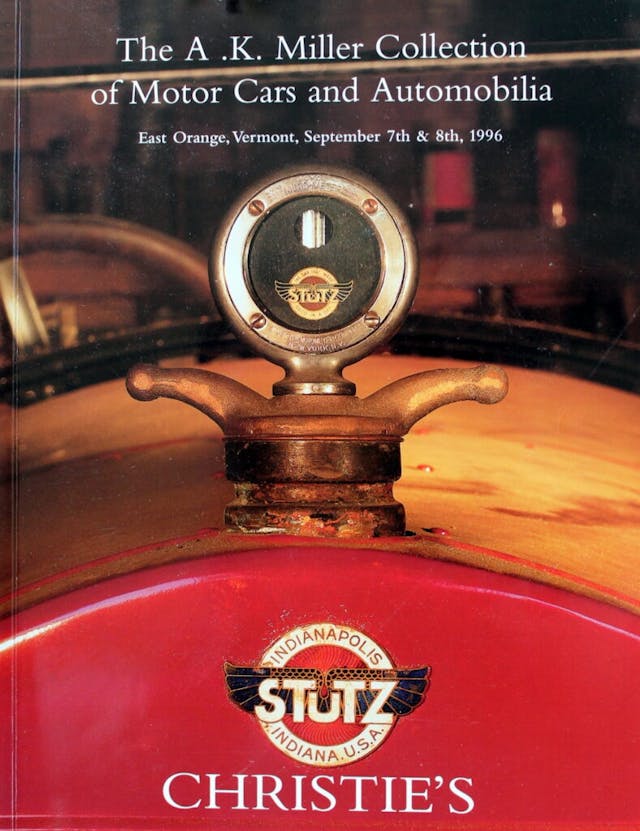
A.K. Miller, as he was known, was born into wealth in 1906. The only son of a New York stockbroker, he received a fine education and enrolled in the mechanical engineering program at Rutgers University. While still in high school, he had the funds to buy a Stutz automobile, a 1917 Bulldog, the first of many he would own. He kept the car until his death.
Stutz is perhaps not a familiar name to modern ears, but the marque is significant. Considered by many to be America’s first sports car, Stutzes were at their peak found everywhere from the Indy 500 to the podium at the 24 Hours of Le Mans.

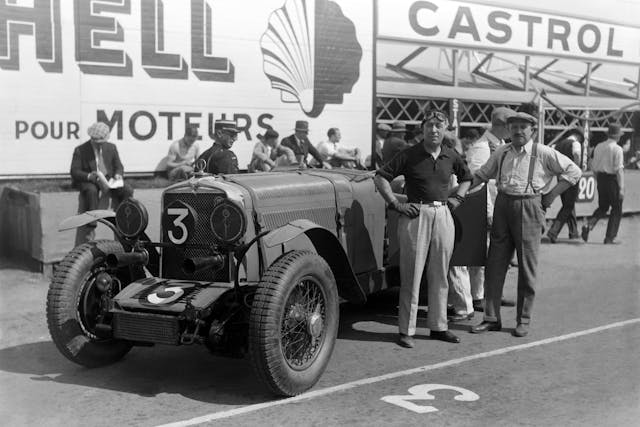
In fact, the Indy 500 was the birthplace of the marque. Harry C. Stutz was one of many mechanical geniuses at the dawn of the 20th century, and the first car he ever built was entered at the first running of the 500, in 1911. It placed eleventh that year, out of the prize money, but even finishing was a victory in those days, and almost half the field did not. Mr. Stutz took up the slogan, “The car that made good in a day,” then set about building road cars.
Stutz production ran until 1935. They were quick and luxurious machines with underslung chassis, given names like Bearcat and Blackhawk. The rare supercharged models were often judged to be faster than contemporary Bentleys.
One of those forced-induction machines, a 1929 Stutz Model M Supercharged with coachwork by Lancefield of London, eventually found its way to the A.K. Miller collection. Bought for $151,000 at that 1996 Christie’s sale, it was later restored. Ten years later, in an auction at Michigan’s Meadow Brook Concours, it sold for $715,000.



Miller himself probably paid a pittance for the car. He began collecting Stutzes in the late 1920s, snapping up many of them at bankruptcy sales or estate auctions. Many of those cars would be carefully brought home and then parked under a lean-to or in a barn, not to see the light of day for decades hence.
Adding further quirkiness to the tale, Miller was a pilot and collected aircraft of all sorts. In the mid-1930s he founded Miller’s Flying Service service, right around the time United States Air Mail was embroiled in a corruption scandal. It was a time when air travel was something of a Wild West for entrepreneurs, with heavy subsidies and much profit to be made.
Miller delivered the mail by autogyro—a helicopter-airplane mashup contraption that seems outlandish today but was relatively common at the time. When he retired from that work, he tucked the autogyro away in a barn as well. Later, he flew as a transport pilot for the Royal Canadian Air Force (he was over the United States age limit for military pilots), achieving the rank of captain. After World War II, he settled down with Imogene, who he married in 1941.
Early pictures of the couple twinkle with Gatsby-like glamour. But with time, the Millers began to withdraw from the social order, almost as if they distrusted it. In the days before Social Security numbers, they probably found it relatively easy to fade into the country’s background. Their money was not kept in banks, but in coins and bullion, or stocks and bonds. Nobody knew how much the Millers had squirreled away. Eventually, most folks forgot they had anything.
A.K. Miller was not unknown in the Stutz community. People remarked on his odd personality, but his vast knowledge of the brand was perhaps unequaled. In a letter to one petitioner, Miller notes that Stutz windshield stanchions differed between 1929–1930 models and those built in 1931. As it happened, he added in the letter, he had the correct parts on hand, for a price.
Those parts were likely manufactured by Miller himself. The note was typed in red—he had a habit of using the red “highlight” ribbon of a typewriter long after the ribbon’s primary black ink had run out.
Most people who had financial dealings with Miller found him frustratingly parsimonious, or at least quite odd. But there are a few stories from Vermont locals that depict him as all too happy to show off his collection. The Millers lived at a level of thrift that seems extreme, but then, they had each weathered uncertain times, a Depression and two World Wars. Keeping a low profile also made it easier to avoid taxes, which A.K. Miller never paid.
This last habit was the eventual undoing of Miller’s Stutz hoard. At 87 years old, he fell off his roof while repairing a storm window and died. Imogene passed three years later from heart attack. As they had no heirs, local officials moved in to secure the estate. When a sheriff found a stack of bonds taped behind a mirror, it was like kicking over a hornet’s nest.
The Miller farm was soon ringed in police tape. When the Internal Revenue Service realized that millions were owed in back taxes, the agency began exploring just what had been hidden. What they found was staggering: A million dollars in gold bullion. Nearly the same amount in stocks and bonds. And, of course, those dozens of Stutzes.

That Christie’s automotive auction netted about $2 million, and many of the cars are still in the market today. They were largely in sad shape when recovered, but the sheer number of parts and accessories that Miller had kept helped many of the cars be restored. One, a 1918 Bearcat roadster, is currently owned by Jay Leno.
The eccentric and reclusive life here may seem sad, glory faded shabby. But it’s worth remembering that Miller’s obsessive pack-rat mentality did result in many spectacular cars being saved from the 1930s to the 1950s. In that press-forward and often resource-thin time, even something as exotic as a Stutz would have been seen as merely an old car, fit only for the crusher.
If Miller’s collecting was a bit selfish in life, it still preserved much for the future. Even if the taxman did end up getting his share.
***
Check out the Hagerty Media homepage so you don’t miss a single story, or better yet, bookmark it. To get our best stories delivered right to your inbox, subscribe to our newsletters.
The post When a mysterious American recluse hoarded gold, airplanes—and fabulous cars appeared first on Hagerty Media.
]]>
Whether it’s the rotund eldritch horror from the 19th century or today’s more cheerful grinning character, Bibendum—more commonly known as the Michelin Man—is one of the world’s oldest and most recognizable mascots.
Ostensibly a clever way of flogging round, rubber hoops for your chosen method of transportation, he’s become the face of one of the world’s largest tire manufacturers, a familiar figure in motorsport, and even a figurehead for cuisine, thanks to the respected Michelin Guide and the stars it awards to restaurants around the world.
Who is Bibendum?

He is, if you hadn’t guessed, a man made of tires, though he started as merely a stack, when during 1894’s Exposition internationale et coloniale in Lyon, France, brothers Édouard and André Michelin spotted an armless figure in the form of the pile of tires advertising their wares.
The stack’s transformation into a character came four years later, when André asked cartoonist Marius Rossillon to adapt an earlier cartoon of a large, drinking individual, with a figure made from tires. His white color, a characteristic continued to this day, reflects the color of natural rubber used in tires at the time, before carbon was added as a strengthener.
The accompanying slogan, “Nunc est Bibendum” (“Now we must drink,” taken from the odes of Roman poet Horace), perhaps made more sense when the character was human, but Rossillon had an answer for that. His poster, used largely unchanged from 1898 well into the 1910s, cleverly depicted the character holding aloft a glass full of nails and other detritus, alongside deflated competitor characters, suggesting Michelin’s tires “drink obstacles.”

By the early 20th century, Michelin was already producing guidebooks promoting travel (and indirectly, but certainly intentionally, its tires) across France, and it’s here that the name Bibendum stuck for the company’s portly mascot. Michelin hired writer Maurice Edmond Sailland, also known as Curnonsky, to pen the company’s gastronomy columns for newspaper Le Journal. Curnonsky began signing off the columns as “Bibendum” from 1908, so it’s likely the character was officially named around this time.
A man made of tires

Disconcertingly, it was many years before Bibendum gained anything you might call a face, the character frequently pictured drinking or smoking through a terrifyingly dark gap in his head, and wearing fashionable “pince-nez” spectacles despite lacking a nez (nose) to pince (clamp). Or indeed, distinct eyes. The somewhat high-society settings in which he was often depicted were very deliberate though, appealing directly to the well-to-do motoring classes of the era.
As car buyers changed, so too did Bibendum’s image. In 1925, the character gained a proper face—if you can call it that—with eyes and a distinct mouth, and only the suggestion that his head was made from tires. Rather than drinking or smoking, he was often depicted rolling a tire down the road, or riding a bicycle (imagine the squeaking).
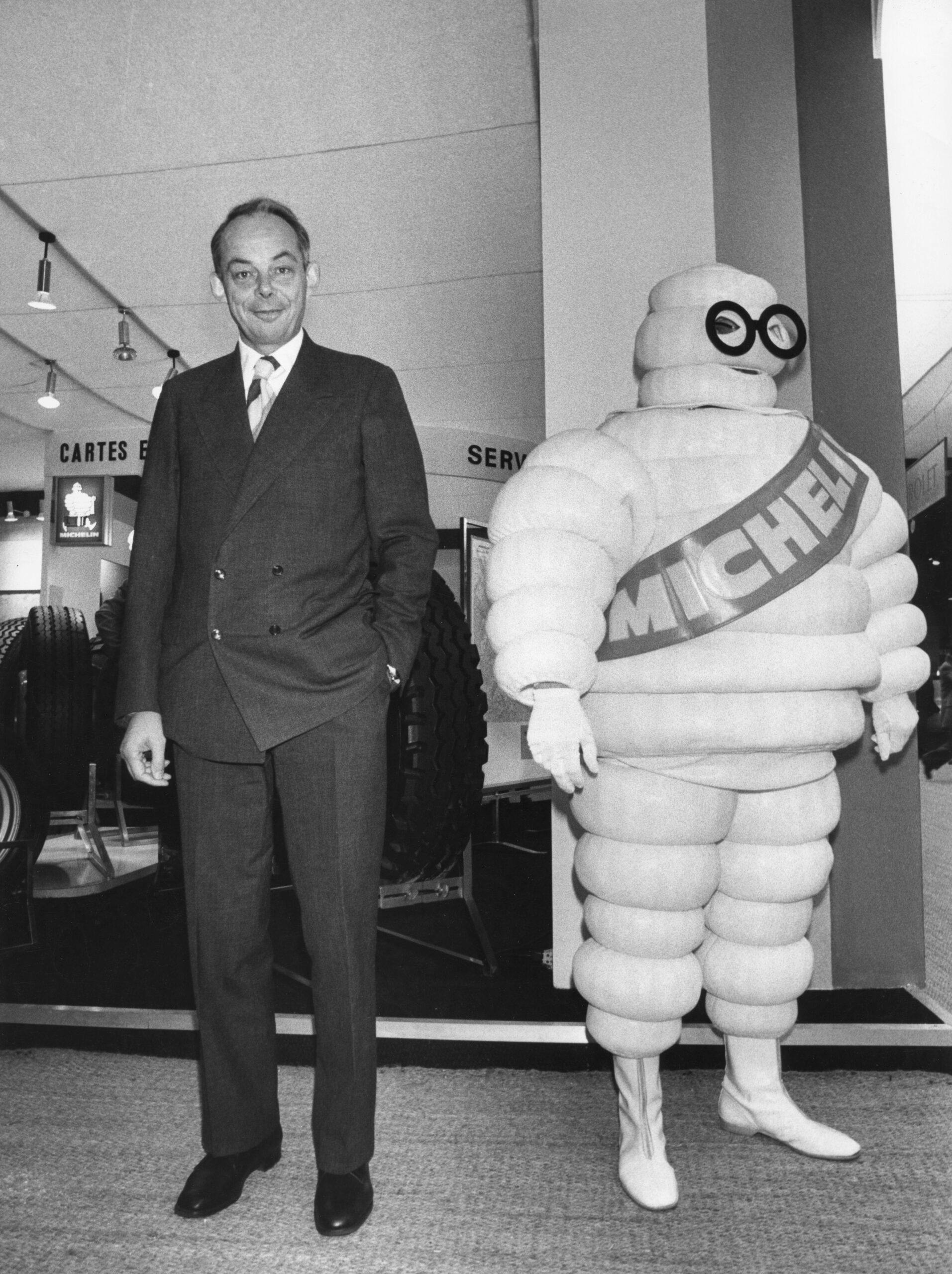

The famous pageant-style sash appeared in 1950, and through the 1970s and ’80s Bibendum became both more cheery and human in his appearance, and also more athletic—between 1980 and ’90, the character was more often than not depicted sprinting towards the viewer, perhaps a nod to the company’s increasing involvement in motor sport. Today, one might call him chubby rather than corpulent.
Restaurants and reviews

If you wish to emulate his physique, that’s been possible since 1987 in the restaurant at Michelin House in Chelsea. The art-deco building was opened as Michelin’s UK headquarters in 1911, but it became a mixed-use venue in the 1930s when the company moved to Stoke-on-Trent. The company returned after World War II, still as owners of the premises, but finally sold the building in 1985.
The buyers, Sir Terence Conran and publisher Paul Hamlyn, redeveloped Michelin House into a mixed-use commercial development, including a restaurant and oyster bar, today run by chef Claude Bosi.
The building was listed in 1969, and is best-known for its spectacular stained-glass window depicting the original, drinking Bibendum. The windows were removed and sent to Stoke during the WWII to prevent damage, but this backfired somewhat when the originals could not be found again after the war. The windows seen today are instead close replicas, installed in the late 1940s, based on old photographs, and to this day the originals are still missing.
The mystery hasn’t affected Claude Bosi’s restaurant, which enjoys a two-Michelin-star rating. Stars have become almost as significant a part of Michelin’s heritage as tires, and the rating system was conceived in 1926 to score restaurants featured in the popular Michelin Guides.
One, two, or three stars can be awarded, and in 1936, Michelin revealed its criteria for each: One star for “a very good restaurant in its category,” two for “excellent cooking, worth a detour,” and three for “exceptional cuisine, worth a special journey.”

It has become a gold standard for the industry, if one that’s easy to criticize for its focus on high-end eating; don’t expect any stars even at the world’s greatest greasy cafe or waffle bar. Oh, and for the fact that France has the most starred eateries, with 628 in total—read into that what you will—ahead of Japan’s 414. Great Britain and Ireland? They combine for 194 at the time of this writing, a fraction of the 1284 restaurants listed in the guide.
Star ratings are awarded by anonymous reviewers; a great shame, given that we probably won’t get to see Bibendum lounging in the corner of a restaurant eyeing the presentation of an eight-course meal like that old sketch on Not The Nine O’Clock News (a 1979–82 British television comedy starring Rowan Atkinson). But if you do, make sure to raise a glass of nails in his honor.
***
Check out the Hagerty Media homepage so you don’t miss a single story, or better yet, bookmark it. To get our best stories delivered right to your inbox, subscribe to our newsletters.
Via Hagerty UK
The post Michelin Man: From nail-drinking oddball to global mascot appeared first on Hagerty Media.
]]>
From relying on newspapers for race results to receiving in-race updates in the palm of your hand, the way in which auto-racing fans consume the sport is always changing.
The most recent hot button within the sport’s consumption is the quantity of streaming services. Subscription-based streaming platforms have ballooned over the past five years, providing high-definition coverage with complex graphics and telemetry for anything from sports car racing at Sebring to snowmobile racing in Wisconsin. In an instant, grassroots racing can be pulled from every corner of the continent to your backlit screen. And the coverage is just as good as it is on the national broadcasts.
Watching a Formula 1 or NASCAR race on the television feels like you are there in person, and sometimes even inside the driver’s helmet. This year, NASCAR followed F1’s lead and debuted a thimble-sized camera that can be mounted to any driver’s helmet foam. The camera provides a racer’s eye view of the spectacle. It’s awesome. I could watch an entire race from that perspective.
Oh, and the data on any broadcast is remarkable. The amount of figures flashed across the screen would likely overwhelm any Nixon-era crew chief.
So why would anyone leave the comfort of their home to watch a race?
The roar of the engines, the smell of burnt rubber, the camaraderie—I could go on, but I know I’m preaching to the choir.
I would like to offer a less-obvious allure: the venue.
In motorsports, the venue and its surrounding area is just as important as the cars on track. Plenty of courses produce intense on-track action, sure, but what sets certain raceways apart from others—and lures fans away from their screens—is the track’s window dressing. The ancillary bits.

The structure on the outside of turn three that promises cold beer and a unique vantage point.
The river outside of the track that hosts race-day tubing runs.
The bar down the street where drivers’ signatures adorn its cinderblock walls.
Gamers and Jeep product managers would call these “easter eggs.” Whether on campus, or down the street, almost every track has at least one. If you think your local track doesn’t have a hidden gem, chances are you haven’t immersed yourself amongst the race course’s cognoscenti. Let’s take a look at some of our favorites.
Sebring’s Turn 10 and Green Park

Really, the entirety of Sebring’s spectating zones could be regarded as the track’s special location. The 17-turn Florida track annually hosts the 12 Hours of Sebring. Despite being considered a jewel of pro sports-car racing’s triple crown, the 12-hour enduro seems secondary to the party.
Portions of the infield, such as Green Park—which is neither green nor a park—as well as Turn 10 are particularly rowdy. Long before his stint at The Doors frontman, Jim Morrison got drunk on Chianti at Green Park and nearly stumbled onto the track. Today, fans bring couches and chairs to spectate. Rather than pack up, they simply set fire to the furniture.
Watkins Glen has been domesticated and Bryar Motorsport Park was shuttered, leaving Sebring to carry the torch for rowdy road courses.
IMS Snake Pit

Indy’s infield party zone has endured since the speedway’s early days, though the Snake Pit, as it’s called today, looks a lot different than it did back in the day.
Since the 1920s, fans flocked to the inside of Indianapolis Motor Speedway’s Turn 1 to watch open-wheelers pour into the sweeping corner. Over time, that area became the designated hangout for college-age fans looking for a place to cut loose. By the ’70s, it was known as the “Snake Pit,” where mud wrestling and loud music were commonplace.
As the inside of the first turn became crowded with grandstands and additional buildings, Snake Pitters had to find a home somewhere else, so they moved to the inside of Turn 4. The party atmosphere faded, and the Pit nearly became extinct.
In 2010, however, Speedway staff revived the pit inside the Indy oval’s third turn. Large temporary stages are erected for a race-day music festival. Lights, smoke, premier electronic dance artists, and throngs of young fans keep the Snake Pit legacy alive.
Hillbilly Hotel

In the early 1970s, Korean War vet Benny Corbin transformed a small sandy dirt track in Barberville, Florida, into a half-mile, clay-paved speed palace.
Within his demo crew, seven-year-old David Blackwelder was responsible for driving one of the tractors. After six decades, and numerous track changes, Blackwelder is still here. He’s traded the tractor seat for a three-story structure outside of Volusia’s third turn known as the “Hillbilly Hotel.”

What started out as a small area next to the fence, reserved for Blackwelder and his closest friends, has evolved into a VIP suite on wooden stilts. One story, then another, then a third—Blackwelder added to his structure as safety precautions pushed his group back from the fence and retaining walls eliminated sight lines.


At a backwoods oval track, the perspective is a unique treat, and portions of the first and second floor are enclosed to supply dirt-free spectating. Blackwelder even ran a plastic drain hose to the ground for depositing empty beverage cans. (Florida is one of the 10 states that uses a 10-cent bottle-deposit system.) Down on the ground floor, he also built a kitchen with a working sink and a portable toilet. All told, the homebuilt structure can accommodate 45 people.
How do you gain access to the best seat in the house? Blackwelder has one prerequisite: “If I like you, you can come up.”
Butler Treehouse

For Midwest dirt fans, you don’t have to travel to Florida to get a bird’s eye view of a dirt track. Some crafty diehards at Michigan’s Butler Motor Speedway built a treehouse on the edge of a neighboring property to take in the local action. Stickers and signs adorn the massive tree, and climbing up through the branches is reminiscent of the dream treehouse from the Peter Pan movie Hook.
To misquote Pan, “All the world is made of faith, trust, and dirt track dust.”
Apple River Tubing
Sticking with the dirt-track theme, Cedar Lake Speedway in New Richmond, Wisconsin, invites fans out to the nearby Apple River for a morning of race-day tubing. The track offers bus transit from the river to the track and promises to “have you back to the track way before hot laps start!” Floating, then racing, in the heart of cheese country—I can’t think of a more indulgent summer day.
Seneca Lodge


In 1944, Donald L. Brubaker steered his 1941 Packard into Watkins Glen, New York, with plans to establish roots in the Finger Lakes town. He had just purchased a camp that he intended to run while raising his family.
The original campus lodge, a log cabin that Brubaker built in 1947, burned to the ground in 1948. With the help of local volunteers, Brubaker’s cabin was rebuilt and reopened in the same year. And just in time to host the banquet for the inaugural Watkins Glen Grand Prix.
Since then, the lodge has been a mainstay for racers, and the Bench and Bar Tavern room is evidence. Numerous patches, stickers, and pennants line the walls of the room. To this day, winners still hang their wreath on the wall.
Barber Motorsports Park
The Alabama Rollercoaster, as it’s called by its most devout, is the poster child for window dressing. What other track features a 230,000-square-foot museum, multiple installation art pieces, and enough giant animal sculptures to be considered an inanimate zoo? The on-track product is great, and IndyCar visits every year, sure, but the real fun is searching the property for the hidden Easter eggs. Can you spot the zombie or the wild monkey?
Siebkens Hotel
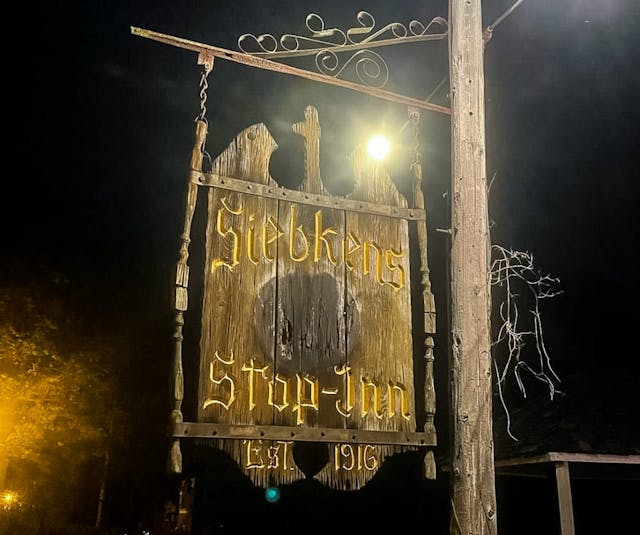
After emigrating from Northern Germany in 1912, Herman and Laura Siebkens opened the Elm Park Hotel in Elkhart Lake, Wisconsin. While Herman Siebkens leaned on his hotel expertise to establish Elm Park as a world class hotel, it was his daughter Olive (aka Ollie) who made the resort’s name synonymous with auto racing.
For three years (1950–52) the small Wisconsin town hosted a race through its streets. Jaguars, Allards, and Cunninghams whizzed past Siebkens front door awning. After racing was decidedly moved out of town, Ollie helped with the completion of the purpose-built race track on the outskirts of town.

Since 1955, Road America has become one of North America’s premier road-racing facilities. During that time, Elm Park, now known as Siebkens Resort, has remained a weekend destination for drivers, crews, fans, and even “King of Cool” Paul Newman, who stayed in Room 11 while filming Winning.
Carteret Speedway
“The place is wild and reminds me of putt golf mixed with a museum and a race track,” motorsport journeyman Andy Newsome says of the North Carolina bullring. “The place is one of a kind.” If you go, make sure you spot the old Union 75 ball towers outside of the fourth turn that were once used by NASCAR spotters at stock car racing’s superspeedways.
Nelson Ledges

This is an odd one. Supposedly, Nelson Ledges sports car course in Eastern Ohio has a rather rare set of concrete bathrooms. During a visit to the quirky track, a grounds manager mentioned that the Smithsonian Museum offered dough to take the vintage bathrooms off of the property. The story goes that these are some of the last remaining concrete potties in existence. Who knows if there’s any validity to the story, or if the track worker was pulling my leg. Regardless, it’s a testament to the wild, wacky, and supremely wonderful Easter eggs you may find at a race track.
Does your local track have a hidden gem, oddity, or Easter egg? Let us know in the comments below.
***
Check out the Hagerty Media homepage so you don’t miss a single story, or better yet, bookmark it. To get our best stories delivered right to your inbox, subscribe to our newsletters.
Via Imola
The post Against the Stream: 10 trackside attractions worth the road trip appeared first on Hagerty Media.
]]>
Leonardo da Vinci lived and worked more than five hundred years ago, but he became da Vinci—arguably the most famous and most valuable artist of all time—thanks to an early 20th-century robbery.
“The Mona Lisa was stolen in 1911. It was the first art theft that really resonated in the mainstream press worldwide, and became the first truly global art market news,” explained Darius Spieth, a professor of art history and art market specialist at Louisiana State University. “Before that, Leonardo was obviously well known and important, but he was one amongst others.”
Some of us at Insider are art enthusiasts; others can’t tell the difference between a Renaissance masterpiece and the stuff hanging in the hallways of the Hilton Garden Inn. But all of us love big datasets. The bigger the sample size, the better we are able to tell you what a car is worth and why. That’s why we constantly dig into Hagerty’s trove of insurance data and why we inspect hundreds of thousands of cars at auction.
The market for fine art is roughly the same size as that for cars in terms of dollars, but it utterly dwarfs us by another metric: time. The automobile is only about 150 years old, and although enthusiasts have been collecting them in some form or another since practically the beginning, the collector car market, as we know it, coalesced only toward the end of the 20th century. In contrast, art has been bought and sold at auction since at least the time of the Roman Empire, and some of companies we recognize today—Sotheby’s, Bonhams, Christie’s—were doing business some 250 years ago.
Spieth focuses on the history of art markets and how technological changes, among other things, have impacted it. We chatted with him about how art markets have (and haven’t) changed over the centuries and, maybe, caught a glimpse at what’s in store for cars over the long run.

We sometimes wonder what will happen to values of older cars as those who remember them new leave the market. What can art history teach us here? Obviously, no one alive today remembers when the Mona Lisa was brand new, and yet it’s still universally viewed as a great work of art.
If you go back in time, to the 18th or 19th centuries, Raphael was king, and Leonardo was a distant second. Today, we put Leonardo first because we’re living in a very technology-driven society. Leonardo did all of these drawings with flying machines, military equipment, and natural sciences, so he resonates much more with our own mentalities. Raphael painted lots of Madonnas and whatnot, and they’re amazing—they’re great—but who gets still excited about that? Taste is an interesting thing.
The list of who is considered famous and great is being reshuffled with time. I’d like to tell a story: There’s a small painting in the Louvre, by an artist called Gerrit Dou, who lived four hundred years ago. The painting is called “The Dropsical Woman.” Napoleon Bonaparte thought this was the greatest painting on the face of the earth. He moved heaven and earth to basically extort it from an Italian nobleman, succeeded, and it’s still in the Louvre. But it’s in the Netherlandish section, and hardly anyone knows the artist any longer. It doesn’t draw the crowds. If this were around 1800, it would be in a bullet-proof glass case and would attract millions of paying visitors every year.
I think every generation renegotiates these things. What constitutes greatness? Consider the change to electric cars. What will that mean if you can no longer have a gas station at every corner? Will that damper the passion for historical cars? I don’t know. Personally, I think it will be the unique craftsmanship that went into classic cars that will be the decisive factor; it will be what defines their endurance as aesthetic objects as well as their role as a storage of value.
That’s interesting. We often talk about how the electrification of the automobile will impact the classic car market from a practical sense—regulations, how we’ll get parts for them, etc. But you’re talking about something different—how electrification will impact desire for classic gas-powered cars.
My thoughts in this discussion always seem to be circling back to issues of psychology. Economists will tell you that humans make rational decisions. I’m not so sure that’s always true. There’s a branch of finance called behavioral finance, which says we need to get away from mechanical models of how markets react to information and keep in mind that we’re dealing with human beings making decisions. Classic cars are a prime example because there are so many psychological—and ultimately irrational—circumstances that define their appreciation; this is what links their market to that of art.
Speaking of finance: To what extent do you think today’s art buyers are actually collectors driven by passion as opposed to investors, looking for financial gain?
That’s a difficult question for me because, to some extent, my gut reaction is to reply from the vantage point of the collector who I am, which makes me biased. On multiple occasions, I’ve paid more than the rational market price for an object. I wanted to have it and I knew this would be the only opportunity in my lifetime. And the segments where I am active is not big-name art. I deliberately buy things that I find interesting, top quality, high craftsmanship, but that are obscure by today’s standards. I could take the same amount of money and invest it in, say, Andy Warhol (or at least prints by Andy Warhol). So, what I’m doing as a private citizen defies the purely rational investment perspective. If you’re really interested in very niche, little-knowns artists, it takes a lot of time to learn about these people—and courage to follow your own convictions. It’s also a major time investment to go down that road, which the busy lives of most people will not permit. So, they go with what the algorithms of a Google search delivers to them—they go for the big names. Real collectors are driven by passion. If you are looking to maximize return on investment, go to the stock markets. Don’t buy art or classic cars.

How important is craftsmanship? Even to a layperson like myself, it’s pretty obvious that certain Renaissance paintings require a tremendous amount of skill, in the same way that someone ignorant of cars probably understands that building a Delahaye or Bugatti required a lot of craftsmanship. But shift to some modern art or, say, a million-dollar muscle car that came off an assembly line and the craftsmanship is harder to see. Does that matter?
If you look at the art world today, “craftsmanship” is almost like an evil word—but not for everyone and not for me; I relish it. But ever since contemporary art came about in the 60s and 70s, the prevailing attitude towards craftsmanship has been, “No, no, no, it’s just about the ideas you have and that’s it. Never mind the execution or whether you know how to draw or paint a human figure.” But in the longer term what matters will be endurance—what people still want to look at, read, or want to own in 30, 50 or 200 years from now.
Interestingly enough, with the advent of computers and the digital age, even our definitions of craftsmanship have changed—especially so in the context of cars. For a long period of time, cars were not seen as “craft objects.” None of them were. But older cars are appreciated from this vantage point today, especially in relation to newer ones. All of the sudden, there’s this awareness that cars, especially from the middle years of the twentieth century, are really these handcrafted objects, they are part of the lure of modernism and the machine age and we need to preserve them because we no longer make them this way. Leonardo made a living as an engineer and many of his drawings are really engineering drawings, so why not look at some of the finest pieces of twentieth-century machinery as art?
What I’m hearing from you is: a lot of what we love and value may be ephemeral. But are there things in the art world that you can point to as more or less permanent?
A while back, I published this book about the art market during the French Revolution of 1789. And one thing that I found quite amazing is that, yes, there are changes over time but not that many after all. There are just some artists who are less known today. But nevertheless, if you look at it over a long period of time, it does not change that much. Auctions, for instance, the quintessential marketplaces for classic cars and art, work in the same way as they worked in the eighteenth century.
If you look at auction catalogs from about 1800, you read long lot descriptions, and wonder, where is this artwork now? What happened to it? And, unfortunately, probably a lot of it got destroyed over time. But then again, it is always surprising just how much is still here.
This whole time we’ve been circling around a very big question: What makes something valuable? And why do we like what we like?
I believe it was Carl Laszlo, a great collector and Holocaust survivor, who said collecting is something that you do in order to overcome your mortality. You want to do something in your life that has a lasting impact. That is what gives purpose. And that has a lot to do with value. And of course, what is value? Ultimately, it is what endures. Even money may lose its value, but assets like land, gold, and art endure. But art still comes out ahead within this group because it has intellectual content. Intellectual content is socially constructed; it is what moves people emotionally. By this point in time, through literature, movies, popular culture, and the rose-colored glasses of nostalgia, this intellectual dimension is something that unites the market for historical automobiles and the art market. The quest for value, and the passion that goes into it, I think you need to have these two things come together.
Let’s talk briefly about NFTs. They’ve taken the art world by storm, and they’ve begun to creep into the car market. What’s your take on them, from the point of view of an art historian? Will they last?
Artworks are basically analog objects, many of them with long histories, because, you know, they have this tactile quality. Look at a painting: It’s a physical thing, you turn it around, and it’s a piece of canvas or a wooden panel with oil paint on it, and you feel connected to the person who did that. It may be crumbling or damaged. No matter how expensive it is, even if you have a $100 million Picasso or whatever, it’s still a piece of cloth with color squeezed out of a tube. The same is true for a $10 painting from the flea market. Right? With NFTs, I think their promoters try to cater to a different, immaterial world, to people with very different mentalities, who consider, like Plato or Kandinsky, the material world a burden.

The NFT marketing machine is piggybacking on the idea of art—they give people the illusion of the prestige that comes with owning original artworks, even cloning the idea of originality. They say, “Oh, here’s your file, but in order to ‘own’ it as something original, you need to pay a huge premium.” The truth of the matter is that the visual image that you get is the same as a JPEG. It’s intangible and infinitely reproducible and exists only on a screen reliant on electricity and software, etc. There are very basic technological constrains on accessibility and the aesthetic nature of the image, which in any case will always be electronically generated (and it shows). So, it’s very much a psychological mind game full of manipulation and self-deceptions. But if that’s what you enjoy, go for it. I doubt that it really appeals to the same people who populate the traditional art, antiques, and classic car worlds. Admittedly, by this point in time, way too much money has been poured into this enterprise, and the hype surrounding it, to pull the plug and say, “Never mind.” It’s going to be around for a while for that reason alone.
Before I let you go, I have to put you on the spot: Do you consider classic cars to be art? If so, where do they fit in the broader art world?
I think there’s a parallel to be drawn between art and classic cars. Believe it or not, I don’t even drive. I don’t own a car. But I love cars, and I appreciate them as both static and moving aesthetic objects.
I’m friends with painter Robert Williams in Los Angeles, who did the original cover art for Guns N’ Roses. He and his wife Suzanne have been part of the hot rod scene for decades, own vintage Ford Model Ts, and turn them into artwork. Of course, they invested a tremendous amount of effort into getting spare parts and going to the meets with other enthusiasts. So, like in the art world, you have the benefit of going to all of these social activities, and then, of course, they go out on the road and drive their cars, getting a lot of attention wherever they show up. So, there’s huge component of social interaction involved in all of that. That’s a much-underrated, added value.
I attended the Venice Biennale in 2022. And if you go to contemporary art events today, you see so many things that are interactive. People want to be engaged in some kind of activity. And that’s also another place where the collector car market overlaps with the art world.
***
Check out the Hagerty Media homepage so you don’t miss a single story, or better yet, bookmark it. To get our best stories delivered right to your inbox, subscribe to our newsletters.
The post Car collectors need to study art history (really) appeared first on Hagerty Media.
]]>
For much of the 21st century, it seems that the automotive world has focused its attention on two concepts: electrification and autonomous driving. The road to driverless electric cars, however, has recently hit a few potholes. A bit of the bloom has faded from the self-driving rose with the recent shuttering of Argo AI, the autonomous driving startup backed by $2.6 billion of Ford and VW’s money, and Akio Toyoda, head of Toyota, recently claimed that he’s not the only automotive executive who is skeptical about embracing an all-electric future.
Whether or not internal combustion engines and steering wheels will be supplanted by electric motors and artificial intelligence is still an open question. There are apologists and critics making their points on both sides of the issue.
However, the automotive industry, influenced by decisions made in California, Washington, and Brussels, is undoubtedly moving headlong into the electric age, investing billions and billions of dollars, euros, yuan, and yen on battery powered cars and trucks. Originally spurred by Tesla’s introduction of its Autopilot feature, and despite setbacks like the closing of Argo AI, the auto industry continues to spend considerable sums on developing some form of self-driving vehicles, perhaps with more modest goals than full autonomy.
While you might think that working on autonomous EVs is a modern phenomenon, the simple historical fact is that 50 years ago a major tier-one automotive supplier built a dedicated research facility and track specifically for the purpose of testing the feasibility of driverless vehicles, and the vehicles that they tested were powered by electricity, not gasoline.
That vendor was Bendix, then a major supplier of braking systems and other automotive components. The lab and test track the company built on the north side of Ann Arbor, Michigan, was located on a site that coincidentally now houses one of the most up-to-date facilities for developing and testing connected and autonomous vehicles in existence.
The Bendix facility was established to evaluate what was called Personal Rapid Transit (PRT) systems, fostered by the federal government’s creation of the Urban Mass Transit Administration (UMTA, now called the Federal Transit Administration) in 1964. The feds were concerned about the demise of streetcars and passenger railways, leading to increased traffic congestion and emission of pollutants from all that traffic.
It was thought by planners of the era that the collapse of those mass transit systems was at least partially due to their route and scheduling inflexibility, particularly when compared to the personal automobile. In the case of PRTs, the word “personal” didn’t mean individual vehicles but rather that service would be personalized. A passenger would summon a multi-passenger vehicle, which would pick them up and then drive them to the destination station of their choice. UMTA funding either directly or indirectly influenced the creation of still-operating urban rail systems like Detroit’s People Mover and Morgantown, West Virginia’s PRT system, and even more personalized services like Ann Arbor’s own Dial-A-Ride bus system.

Today Bendix concentrates on truck braking systems as part of Germany’s Knorr-Bremse, but before a series of mergers and acquisitions that have somewhat diluted the Bendix brand, the company was widely diversified, with interests beyond the automotive industry in aviation, consumer and industrial electronics, and computers. In 1958, Bendix Aviation Systems spent $13.5 million ($139 million in 2023 dollars) building a research laboratory on the north side of Ann Arbor, on Plymouth Road just west of Green Road. Other than the lab and Ann Arbor’s nearby water tower, the marshy area remained mostly undeveloped until the University of Michigan started construction about a decade later on its North Campus.
Reflecting the space race, Bendix Aviation was renamed to the Aerospace System Division. Working with Johns Hopkins University’s Applied Physics Laboratory, under funding from the U.S. Department of Transportation, in 1970 Bendix Aerospace started studying “headway sensing systems for automatic vehicles” at the Ann Arbor facility. Both vehicle-mounted and roadside-placed sensors with microwave systems would send information to special-purpose computers that would control vehicle distance and speeds. The vehicles would be capable of carrying freight or up to 15 passengers at speeds of 10–60 mph and would be primarily intended for downtown business districts and airports.

At some point the project was moved to Bendix Corp. Transportation Systems, which began construction of a test track on 15 acres of the north Ann Arbor site, which the company titled the Transportation Controls Laboratory. The installation included a more than mile-long asphalt roadway with banked curves, modest elevation changes, and a 2000-foot inner loop, buried with wires and sensors. An auxiliary building was constructed to house the observation center and computer control equipment. Initial testing began with three small Kalmar delivery vans originally built by Sweden’s DAF, which were converted to electric power by EV pioneer Robert R. Aronson’s Electric Fuel Propulsion Corporation (today Apollo Energy Systems).
Those were apparently among the dozen Kalmars that EPF converted to electric power in 1969 and ’70. Electrons were supplied by EFP’s proprietary “tri-polar” lead cobalt batteries, powering a 20-horsepower motor, which drove the wheels through one of DAF’s variomatic belt drives. EPF claimed a 75 mile range at the vehicle’s top speed of 45 mph.
Bendix’s Transportation Controls Laboratory started operations in November 1971. While we know that the facility used sensors and a computer to control the 20-hp vans, contemporary accounts don’t describe the technology used inside the driverless trucklets.
It’s also not exactly clear why Bendix chose electric vehicles for the testing. Charles Weatherred, director of Bendix’s Transportation System Department, told the Ann Arbor News in 1971, “It really wouldn’t matter what type of vehicle we used on the track (roadway),” because the Transportation Controls Laboratory had “nothing to do with the development of vehicles. It deals in controlling the vehicles on guideways through use of computers.”
In the wake of the 1973 oil embargo, the federal government’s automotive focus turned away from PRT towards fuel economy. Bendix’s interest and investment in driverless technology lasted about as long as the government contracts. Less than four years after the facility was constructed, in October 1974 it was reported that Bendix was thinking of putting the entire 43-acre site on the market. In 1983, the University of Michigan bought the real estate, buildings, and track.

The Bendix Aviation lab was torn down decades ago, but the water tower is still there overlooking the site. If you check the satellite imagery or are not far from Ann Arbor, you can see for yourself that remnants of the Bendix autonomous test track are still extant today. There is grass growing up through the cracks, but much of the asphalt is still intact. When I walked the site, I could see that at least one straightaway and a banked curve still exist and next to the straight there is a circuit box on a post next to the track, possibly part of the original system for controlling the electric vans. From the piles of discarded Hoosier 18x6x10 racing tires, it looks like local dirt track ATV racers may use the site for testing.

As it happens, the water tower still overlooks an autonomous testing facility, though this one was constructed in 2015, not 1971. Immediately adjacent to the remnants of the Bendix test track there is an ersatz little town known as MCity, built by the University’s engineering school with about $10 million of the automotive industry’s dollars. When adjusted for inflation, that’s about six or seven times the $150,000 Bendix reportedly spent on building its Transportation Control Laboratory. The MCity track actually traces part of the route of the Bendix test track.

It’s been more than 50 years since Bendix started testing autonomous electric vehicles in Ann Arbor. Once again, autonomous cars—including some EVs, I’m sure—are being tested at the same location. I doubt I’ll be around to see it then, but it will be interesting to see what kind of vehicles may be tested at the Plymouth Road site in another 50 years, what will power them, and who, or what, will be driving them.







![]()

***
Check out the Hagerty Media homepage so you don’t miss a single story, or better yet, bookmark it. To get our best stories delivered right to your inbox, subscribe to our newsletters.
The post A half century ago, Bendix tested autonomous EVs right where automakers test them today appeared first on Hagerty Media.
]]>
Car enthusiasts are accustomed to aspirational names on vehicles: “Le Mans” on workaday Pontiacs; “Cougar” on mild-not-wild Mercury station wagons, and “Falcon” on a Ford economy car that could not fly—these are but a few examples.
Cashing in on a brand name is standard practice in the auto industry. For many years after WWII, two Detroit brands repurposed names of renowned coachbuilders to give high-line models an extra dose of dash. In some cases it was marketing sleight of hand, suggesting coachbuilt construction that was more homage than anything else.
Rare today, “coachbuilding” was a not-uncommon practice among luxury makes before WWII. The automaker would provide a rolling chassis with running gear to a design and body specialist house, giving elite clients a dose of exclusivity and class over standard-issue models. As Hagerty editor-at-large Aaron Robinson put it: “Coachbuilders delivered a few handmade bolides produced by irreplaceable craftsmen using ancient tools and techniques, while mass production harnessed unskilled labor and mechanized automation to deliver millions of identical vehicles at an affordable price.”
While the practice largely faded in the post-war era, the status that came with a designer label remained powerful. Cadillac leveraged this name equity with Fleetwood-badged models and Chrysler did so with the LeBaron-badged Imperials. Both names had originated from pre-war designer/body-makers that were later acquired by their largest customers.

From Italy came big names like Pininfarina, Vignale, and Ghia. That last name had perhaps become best known in America for the 1955–1974 Volkswagen Karmann-Ghia, or as a trim badge on 1970s Fords. Ghia, however, had an illustrious history that included building Chrysler concept cars and limited-production specials in the ’50s and ’60s.
Gradually, these designer badges lost their meaning and connection to their history. One even became the butt of a joke in American comedy. How did things go so far downhill?
Let’s have a look at Fleetwood, LeBaron, and Ghia.
Born in Fleetwood, Pennsylvania

Perusing some car auction catalogs and websites, you might see references to “Body by Fleetwood” or even “Coachwork by Fleetwood” for Cadillacs from the 1950s–1970s. It’s not the real deal, so treat these models with an asterisk that nods to genuine coachbuilding history. Fleetwood, you may not know, was there near the start of the automobile’s story in America.
At the turn of the 20th century, it was popular for automakers to subcontract body design and manufacturing. The Fleetwood Metal Body Company of Fleetwood, Pennsylvania, sixty miles outside Philadelphia, supplied several makes, including the General Motors brands. Around the same time, Fisher Body Company (founded in Detroit in 1908) innovated and supplied closed auto bodies for GM and others.
Consolidation within the auto industry made big players bigger. GM bought 60 percent of Fisher in 1919. Six years later, Fisher bought Fleetwood and moved the Pennsylvania operation to its Fort Street factory in Detroit, renaming it the Fisher Body Fleetwood Plant. GM bought out Fisher in 1926 and essentially married Cadillac to Fleetwood.
A successful union
Cadillac deftly adapted Fleetwood’s design and construction expertise, not to mention the cachet of its name. Fleetwood Cadillacs from the ’30s could stand up to any coachbuilt cars of the period. By the late ’40s, the Fleetwood name had come to identify Cadillac’s long-wheelbase sedans and factory limousines. Some Cadillacs wore “Body by Fisher / Interior by Fleetwood” tags.
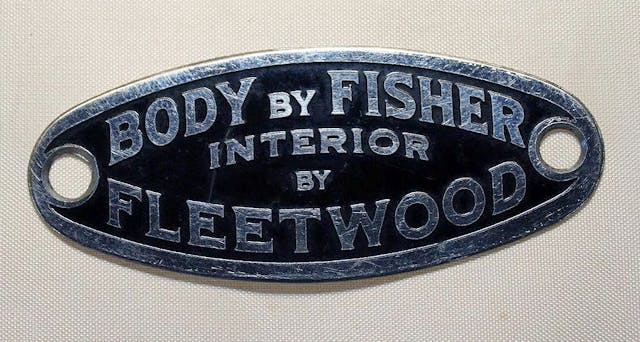
Curiously, the limited-production $13,000 1957–1958 Eldorado Brougham, whose construction required much hand work, did not use the Fleetwood name. Its fender tag, however, discreetly indicated “Body by Fleetwood,” meaning it was built in Fisher’s Fleetwood plant, along with other Cadillac bodies. It seems fair to call this example a bit of understated semi-coachbuilding.


Cadillac, meanwhile, had built a relationship with Italy’s Pininfarina. After creating a series of one-offs on Cadillac chassis, the Italian firm best known for design and bodywork for Ferraris won the contract to build the Cadillac-designed 1959–1960 Eldorado Brougham. These were genuine coachbuilt cars, with just 200 made. (The Pininfarina-built Cadillac Allanté from the 1990s was a whole other story.)


The Fleetwood flame burned on
Perhaps setting the stage for the ultra-distinctive and front-drive 1967 Eldorado on the horizon, Cadillac applied the Fleetwood badge to its DeVille-based Eldo in 1965, and it stuck around for more than thirty years. The nomenclature far outlasted the final Cadillac body from Fisher’s Fleetwood plant, which was the D-body 1987 Brougham (formerly the Fleetwood Brougham). That car was essentially the rear-drive 1977–1984 DeVille, rebadged simply as the Brougham after the DeVille and Fleetwood name moved to a front-wheel-drive platform for 1985. Cadillac moved Brougham production to the Arlington, Texas plant in 1988, where the 1993–1996 redesign, called the Fleetwood, would be built. (Cadillac was not about to call it the “Arlington.”)
The Fleetwood name took its final bow with a bit of irony. For 1998–1999, Cadillac commissioned a sort-of coachbuilding project when it issued a specially built long-wheelbase version of its front-drive DeVille, dubbing it the Fleetwood Limited. Superior Coach Company in Lima, Ohio, did the conversions on about 800 cars, closing the book on the Fleetwood story for good.
Chrysler and LeBaron
If the name “LeBaron” makes you think of Steve Martin and John Candy driving a semi-disguised (and ultimately burnt) 1983 Chrysler convertible in the 1987 comedy hit film Planes, Trains, and Automobiles, you’re not alone. Seven years later, another ’83 LeBaron convertible met a similar fiery fate in the Seinfeld episode, “The Mom and Pop Store,” in which it was misidentified as a 1989. The episode is known to many as “the one with Jon Voight’s car.”

In real life, however, LeBaron was no joke. Raymond H. Dietrich and Thomas L. Hibbard founded their “automobile architect” firm in New York City in 1920, calling it LeBaron Carrossiers to imply a European pedigree. Despite the marketing fluff, the company’s work spoke for itself. LeBaron would go on to create designs for Lincoln, Packard, Locomobile, Pierce-Arrow, Cadillac, Rolls-Royce, Delage, Hispano-Suiza, and others. A merger in 1923 with The Bridgeport Body Co., which supplied Connecticut-based Locomobile, added body construction to LeBaron’s services.
Not long afterward, founders Dietrich and Hibbard left LeBaron to start their own separate design firms, with Hibbard joining Howard “Dutch” Darrin in Paris. LeBaron carried on with Ralph Roberts as head designer. In 1927, Briggs, which was at the time Detroit’s largest independent body maker, bought LeBaron and moved the operation to Detroit to serve as its in-house design department. Briggs mainly supplied Ford, Chrysler, Packard, and Hudson. Chrysler’s Imperials of the period wore some of LeBaron’s most revered designs.

LeBaron’s design work for Chrysler essentially ended in 1941 when it created the Imperial-based Newport dual-cowl phaeton, building five examples. One paced that year’s Indianapolis 500. That same year’s Chrysler Thunderbolt was a low, aerodynamic aluminum roadster with a one-piece retractable hardtop. Five were made, priced at $8250 each (about $167,000 in 2022 dollars).
By then, Briggs’ customers were relying mostly on their own design departments. In 1953, Chrysler bought Briggs, and LeBaron effectively ceased to exist. The name, however, found a new life as the top trim level for Chrysler’s 1957–1975 Imperial, with some “coachbuilding” suggested as part of the mystique.

Coachwork, or coach-bull?
While the Imperial LeBaron touted some special features, these were merely assembly line variations, with one notable exception. The assembly plant performed a bit of coachwork on the 1960 Imperial LeBaron, which featured a smaller rear window than the base and mid-line Crown versions. Ed Micalef, an Imperial collector profiled by Hagerty, explained that line workers welded in a metal insert that partially covered the standard rear window, using asbestos rope under it and lead-filling the seams.
Micalef, who owns a ’60 Imperial LeBaron, says the time-consuming modification was prone to failure as the car aged. “The asbestos rope would absorb moisture and expand, exposing the seam,” he explains. For 1961, Chrysler invested in a separate roof pressing for the LeBaron featuring a smaller window, which was used through 1963. And that is why the model wore a “LeBaron coachwork” badge for those years only. A stretch? We’ll let you decide.

Life after Imperial
Following the Imperial’s first demise in 1975, Chrysler played musical cars with the LeBaron name. The 1977–1981 LeBaron was essentially a deluxe M-body Dodge Diplomat that also inherited the retired Imperial’s eagle insignia. The LeBaron badge jumped to a K-car in 1982, and the M-body version became the “downsized” New Yorker.

Various LeBaron-badged front-drivers would serve as Chrysler’s bread and butter for the next 13 years. The J-Body coupe and convertible were attractive bright spots in this badge-engineering morass and were the only LeBaron models to not share a body with Plymouth or Dodge. The once-storied name ended with that car in 1995.
Ghia: The Chrysler Years
Founded in 1916, Carrozzeria Ghia came to prominence with designs for pre- and post-WWII Alfa Romeos and some early Ferraris. In 1954, Ghia’s chief designer, Luigi Segre, purchased the company and put it on track for what would become a golden age. Among its many masterpieces were the “Supersonic” designs built on chassis from Alfa Romeo, Aston Martin, Fiat, and Jaguar.

Segre forged an association with Virgil Exner, Chrysler’s head of Advanced Design, who tapped Ghia’s coachbuilding prowess to turn his studio’s daring designs into drivable “idea cars.” The collaboration included the 1952 Ghia Special (a.k.a. Thomas Special), with Chrysler commissioning six copies. Ghia then also built another dozen.
Ghia adopted key design elements from both the Thomas Special and another Exner-Ghia collaboration, the 1953 Chrysler d’ Elegance, for the smaller-scale Volkswagen Karmann-Ghia. Karmann contract-built the car for VW.



Firebombs and Hollywood moguls
Ghia’s work with Chrysler would bear more fruit, both inside and outside the corporation’s walls. In 1956, Ghia put the Dodge Firebomb concept into limited production as the Dual-Ghia, using a Dodge chassis and engine and financial backing from American specialty truck maker Dual Motors. Just 117 were made, priced at around $7500.
Chrysler called upon Ghia’s coachbuilding prowess once again for the limited-production Crown Imperial limousine, starting in 1957. Ghia constructed each one using two bare Imperial coupe shells, a lengthened chassis, and other components shipped from the U.S., as well as fitting a handcrafted interior. It’s coachbuilding in a manner of speaking. Just 132 examples were made through 1965, and it was expensive, selling for around $15,000–$18,000. For comparison, the 1958 Cadillac Fleetwood 75 factory limo cost about $9000.

Ghia won another major project from Chrysler in 1963, building bodies for the company’s experimental Turbine car. The first five built were considered prototypes, and 50 more were used for a nationwide public evaluation campaign. Jay Leno has one of the nine still in existence.
Nineteen-sixty-seven teed up an intriguing Chrysler-Ghia coachbuilding collaboration, similar to the Dual-Ghia deal. Approached by TV producer Burt Sugarman to supply engines and drivelines for a limited-production sports car he planned to commission from Ghia, Chrysler obliged. The company shipped the Plymouth Barracuda’s 273-cubic-inch (4.5-liter) V-8 along with its driveline, chassis, and interior components, to Italy. Ghia adapted these to a proprietary frame and clothed it with a striking two-seat convertible body.

The resulting car, the 1967 Ghia 450/SS, remained a limited build, with an estimated 57 made. Chrysler had deeper involvement with this project, sending product development executive Paul Farago to Ghia to provide engineering support. Before he had emigrated to the U.S., Farago had previously worked for Ghia on the Exner concept cars. The 450/SS was the last Chrysler-Ghia mashup.
Ghia’s Road to Ford

Chrysler was, of course, not Ghia’s only client. Also in 1967, the firm’s low-volume production subsidiary, Officine Stampaggi Industriale (OSI), collaborated with Ford of Europe to design and build a coupe based on the German front-wheel-drive Taunus 20M, making about 2000 examples of the so-called OSI 20M TS.
That same year, Ghia’s destiny took another twist when Argentinian ex-racer and auto entrepreneur Alejandro de Tomaso teamed with New Jersey-based electric motor maker Rowan Industries to buy Ghia and Vignale, another renowned Italian designer/coachbuilder. The designs for DeTomaso’s Ford-powered Mangusta and Pantera sports cars emerged from Ghia, the Mangusta by Giorgetto Giugiaro and the Pantera by American designer Tom Tjaarda.
Then Ford shook things up, buying a controlling stake in DeTomaso in 1971. Ghia would go on to do design work for Ford, in Europe and America, including the 1976 Fiesta. During the Mustang II’s development, Ghia designed and built two drivable prototypes, including a notchback style that Ford had not initially planned. The final model adopted the prototype’s general form and some design features.

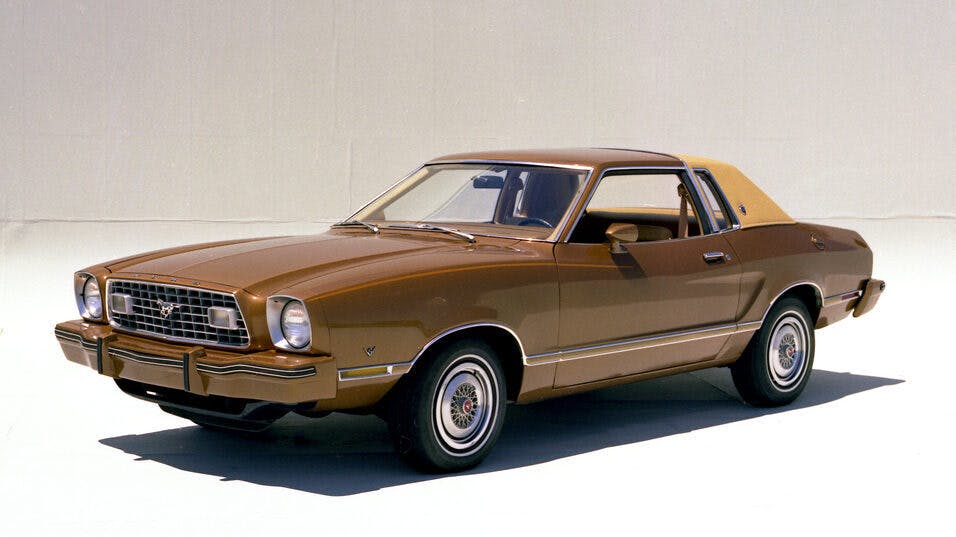

Meanwhile, Ford had begun using the Ghia badge to denote the premium trim line for several European models. Not surprisingly, the practice came Stateside, starting with a premium-trim 1974 Mustang II, followed by the 1975 Granada and a luxury version of its Mercury twin, called Grand Monarch Ghia. The Ghia badge continued on the Fox-platform Mustang for a few years.
After designing some Ford concept cars built in the 1990s, Ghia faded from sight, and Ford stopped using the badge on its European cars in 2008. An inquiry to Ford Motor Company in the U.S. about Ghia’s status turned up no answers. (Ghia: phone home if you’re out there!)

Epilogue
Some might say the former Big Three ran the names of great coachbuilders into the ground. However, adopting those names, even for mundane cars, kept alive at least the memory of a dying part of auto history. It gave customers a feeling they’d bought something special, which—diluted or not—is a worthy achievement.
***
Check out the Hagerty Media homepage so you don’t miss a single story, or better yet, bookmark it. To get our best stories delivered right to your inbox, subscribe to our newsletters.
The post How Detroit’s Big Three cashed in on coachbuilders appeared first on Hagerty Media.
]]>
Update: this Hildebrand & Wolfmüller sold on February 1st at Bonhams Paris for €195,500 ($211,155).
The term “motorcycle” easily describes the path through which innovative engineers in the 1800s reached this transportation milestone: it’s a simple combination of motor and bicycle. Pioneers first began by experimenting with steam engines on bicycles. Gasoline-powered contraptions soon followed, with the likes of the Hildebrand brothers and Alois Wolfmüller leading the way. In addition to identifying the ideal power source, work was put into creating a dedicated, durable frame that took the concept beyond mere motorized bicycles. On January 20th, 1894, the Hildebrand brothers received their patent for what would be the first motorcycle offered to the public.
Said to be the “first powered two-wheeler to enter series production,” according to Bonhams, the 1894 Hildebrand & Wolfmüller “is the first such device to which the name ‘motorcycle’ (motorrad in German) was ever applied.” Bonhams is auctioning what is said to be the earliest Hildebrand & Wolfmüller known to exist, making this lot potentially the earliest motorcycle in existence today.




Even more shocking is that it is said to be in largely untouched condition. Bonhams added that production numbers are cited to be anywhere from 800 to 2000, making the chances extremely low for any to have survived for 129 years—let alone in the shape this one’s in. This is a motorcycle that will only ever be on display as it is unusable today (it is extremely rudimentary, and sadly there’s no London to Brighton race of others to travel with), so the buyer will likely be a museum, large collection, or even an art enthusiast rather than a motorcycle enthusiast. The difference, and functionality, between an earliest-of-the-early 1894 motorcycle and a 1910s-era motorcycle is huge, so the value here is in its historical significance and rarity.

What’s the market for these motorcycles? As surprising as it might be, a number of these have survived and Bonhams itself appears to be the king of auctioning them off. Save for one replica sold by Mecum, Bonahms has been the auction house for all original and replica Hildebrand & Wolfmüllers.
Bonhams offered one of 15 very well-built replicas by Mike Kron in Germany at their 2008 Stafford sale. The bike failed to sell but had an estimate of £48,000–£52,000 ($59,145–$64,000). A month later, Bonhams sold another of the same replicas at their San Francisco auction for $58,500. Another one of those same replicas then sold at Bonhams 2010 Stafford sale for £29,900, or $45,700 given exchange rates at the time. And again, a replica example sold at Mecum’s 2019 Las vegas Motorcycle Auction for $99,000.



The market is thinner when searching for original examples—this Bonhams lot will be the first to come up for auction since 2011. At the 2010 Bonhams Stafford sale, an example in very rough but original condition sold for £86,200, or $131,800 with exchange rates at the time. Less than a year later, Bonhams sold an 1894/1895 example for $161,000 at their Las Vegas Motorcycle Auction. It seems the replicas in 2008 and 2010 brought out these few original examples in 2010/2011. Since then the market has been quiet.
What would you do if you owned the oldest motorcycle in existence? Would you don your period-correct goggles and scarf, or carve out some extra-clean space in the garage to showcase your new bit of history?






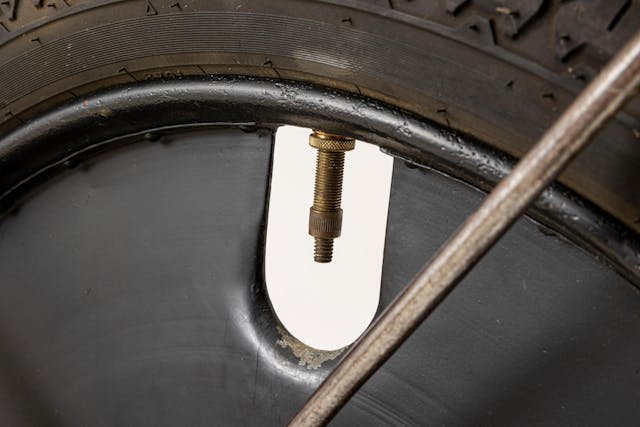



Check out the Hagerty Media homepage so you don’t miss a single story, or better yet, bookmark it.
The post The oldest motorcycle in existence is for sale, 129 years after being born appeared first on Hagerty Media.
]]>
It’s August of 1943 and German troopers are dug into a hillside somewhere in occupied Sicily. American scout cars probing the lines suddenly come under their fire. The Yanks answer with the rat-a-tatting of their own light machine guns. Then, ka-BOOOOM! The air is split open by the concussion of an American 155-mm “Long Tom” artillery piece firing in the distance. Dirt flies, smoke billows, but the enemy resistance only strengthens. The scout cars flank left; behind them, three American Sherman tanks clank forward, flame pluming from their gun barrels while their turret-mounted .50-caliber machine guns go POM!-POM!-POM! as if bullets the size of Coke bottles are flying out. More dirt flies and bodies begin tumbling. The radio crackles: “Chris, are you on comms? I need you at Oy Vey—fast, fast, fast!”
The show goes on, but without the Rabbi.
That day, the Rabbi was off somewhere doing something that his crew would only speak about in cagey terms. “Cybersecurity,” was all they would tell me. The Russians had just invaded Ukraine and started a real war, so the Rabbi was busy and couldn’t be at this make-believe war at a military museum in Florida, even though he was footing a rather sizable bill for it. Ah well, war—both real and staged—is hell.

Drive north out of Orlando into the citrus groves, hothouses, and organic boutique farms of central Florida and, if you’re lucky and turn your head just right to catch it when the doors are up, you may spy a shed full of tanks. This is Rabbi Rob Thomas’s domain, a healthy spread of Florida forest and swampland that is the equivalent of a Kentucky stud farm for retired military vehicles. Some people collect firetrucks; others, steam engines. Rabbi Rob—everybody calls him that, or just “the Rabbi”—collects tanks, trucks, and equipment from World War II. And, as you might expect an ordained rabbi to do, he has given them all Yiddish or Old Testament nicknames: Oy Vey, Schmuel, Golem, Bupkes, Meshuggah, which means “crazy.” The booming 15-ton Long Tom has been dubbed Kelev Gadol, or “Big Dog” in Hebrew. Even the machine guns have Judaic nicknames.

Rabbi Rob shares his tanks with the public through his nonprofit organization, WW2Armor.org, which regularly trucks tons (and tons… and tons) of equipment to weekend historical reenactments where anyone can see and touch a tank and hear it grind around a field in noisy mock battles. “First and foremost,” reads WW2 Armor’s website, “we’re an educational outfit seeking to educate the wider public on U.S. armor tactics, training, vehicles, and personnel of WWII. In short, our goal is to allow a taste of what it meant to be a tank crew member during that time and to show what those soldiers endured and accomplished.”
Most of Detroit’s World War II arsenal went to the scrapper decades ago, making wartime equipment highly collectible and very expensive. A decent Sherman tank nowadays can run $400,000 to $500,000. At Rabbi Rob’s, no fewer than 16 of these iron mastodons now live in pampered comfort, their every (and frequent) need tended to by a permanent paid staff of 11 and a volunteer force of more than 30. The day we visited, the team was preparing its machines for the aforementioned attack on the Sicilian hillside, which was to take place at the Military Museum of North Florida in Green Cove Springs near Jacksonville the following weekend.

And to be clear, we definitely mean Sicily, and not Italy or France or the sands of Iwo Jima. WW2Armor.org prides itself on historical accuracy, meaning the equipment, uniforms, and tactics used in Green Cove Springs would evoke a specific theme. “The theme is Operation Husky,” explained the group’s “Technician Fifth Grade,” Matt Lambert, referring to the Allied code name for the Sicily invasion in the summer of 1943. Lambert, who carries a notional military rank like everyone else in the organization, is the group’s armorer and maintains a heavily secured room full of pistols and machine guns. “We have to have the right equipment,” he says. “No ‘grease guns,’ for example, because they weren’t available in Sicily.” He’s referring to the war-time-era .45-caliber M3 submachine gun that resembled a mechanic’s grease gun.
Pining for an interview with Rabbi Rob—there were so many questions—as well as a ride in a tank, we were first shown around the property. A bunch of sheds house the machines and the workshops that are necessary to keep them running. Former car mechanic Chris Bischoff joined six years ago, answering an ad that advertised for diesel and aircraft specialists and mentioned a Hellcat. “I thought they meant a real Grumman Hellcat—you know, the fighter plane.” Most people probably would have thought a Dodge Hellcat, but Bischoff found out that they meant an M18 Hellcat, a 19-ton tracked and armored tank destroyer built by Buick starting in 1943.
Why did they want an aircraft mechanic? Six of the Rabbi’s tanks are powered by versions of a common Wright nine-cylinder radial aircraft engine. The rest of the American tanks (they have a couple of German ones) run an 1100-cubic-inch Ford GAA, a four-cam, 32-valve V-8 designed specifically for tanks. “Unlike being a car mechanic, I just have to be an expert in two engines,” says Bischoff. “I used to spend seven hours pulling an engine out of a Toyota. Last week, we pulled an engine out of a tank in 50 minutes.” The downside: “There’s not a lot you can lift by hand.”


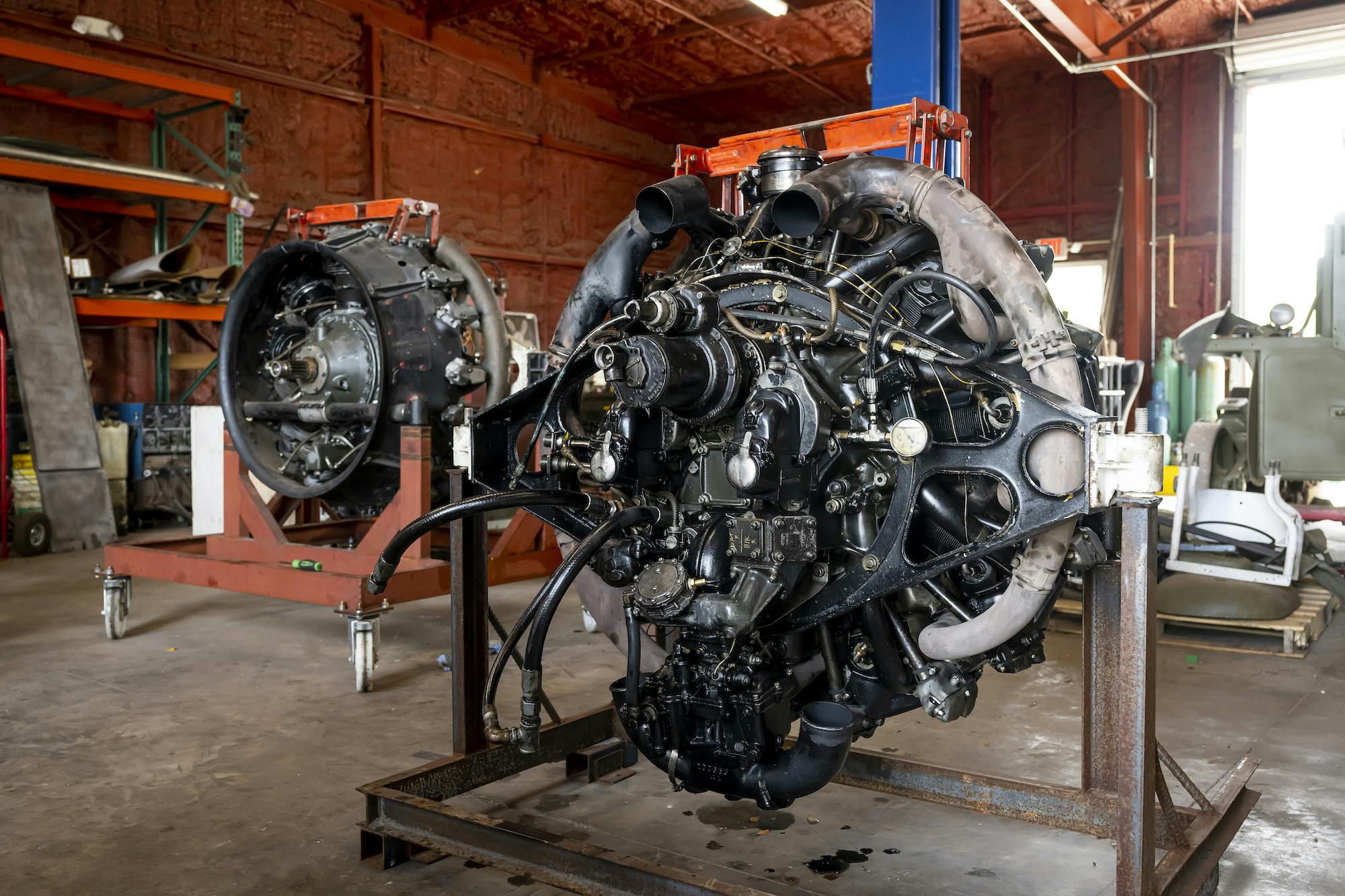
We were ushered to the small engine room, the only air-conditioned shed on the property, where John “Wolfie” Nicholson, a retired Marine helicopter crewman and civilian aircraft mechanic, works on the fleet’s fuel-burners. “It’s so relaxing. I get left alone, and I get a lot done. Who doesn’t like playing with tanks all day?” The organization’s pre-COVID schedule had at least five tanks going to four to five shows a year, Nicholson told me, and back in the day, the Army rule of thumb was one hour of maintenance for every hour of running time.
Over a show weekend, the tanks may run for four to five hours. A tank’s radial engine holds 14 gallons of oil and burns 7 quarts of it an hour in normal operation. “With all the heat cycling, they loosen up and they leak.” Worn cam lobes are another big problem, as is the usual gamut of electrical fritzes, like bad plugs and dead starters. “Once the V-8s came in, the Army didn’t want anything to do with radials,” he says.
After some safety instruction, I was plopped into a small chair at the front of a Hellcat named Bracha, which means “blessing” in Hebrew. My helmeted head poked out of the hull while the driver sat to my left, on the other side of the enormous transmission turning the front sprockets. Sitting in a tank is like driving a car from under its hood, and you realize quickly that it was not built with any thought to comfort. If your knee, elbow, or head collides with anything, it leaves a nasty bruise. And the clatter from the radial engine is ear-shattering. If Grandpa was deaf, this was the reason; jockeying these things to Berlin must have wrecked the hearing of an entire generation. But did they complain?
The driver pushed both steering bars forward, releasing the brakes, and the engine roared as if a bomber were taking off 3 feet behind our backs. The relatively light tank scampered—for a tank—toward the woods at 10 or 15 mph. There is a set of redundant controls on the right side. Two long bars control steering and, with both pulled back, braking, and a lone floor pedal is the throttle. I was told not to touch them, which was fine, because I was partially blinded by sand flying into my face and up my nose.

A tank underneath you feels like a boat in water. It rolls and pitches with soft motions as the tracks and torsion bar–supported wheels soak up, or simply flatten, even the biggest ruts. Gravel, mud, water, a house; the tank doesn’t really care what it’s churning through, it just pootles wherever you point it by alternately tugging or pulling on the two control handles. Shermans had five-speed manuals, but the later Hellcat had a three-speed automatic shifted via a stick on the huge transmission case. They were designed to be operated by kids accustomed to driving the family farm truck.
As the photographer blasted away, we went romping over yumps and plowing through mudholes. We flung off big clods in tight turns and crisscrossed a sandy flat with deep track ruts. After a while, our tank commander, “Sergeant” Tim “Hellfish” Meyering, called a halt for a water break and we switched positions so I could see what life was like in the turret. Standing next to the huge breech of the 76-millimeter main gun, it’s hard to imagine actually firing it in combat. The explosive concussion, the rocking of the tank, the certainty that somebody will be firing back.
Hellcats were appreciated by their crews because the open turret was less hot, less noisy, and less claustrophobic than the sealed-up Sherman’s. It’s the classic convertible versus coupe argument. The downside was the Hellcat crew’s vulnerability to snipers, air bursts, and any kid carrying a potato masher grenade, not normally concerns in an MGB.



After enough time of burning gas at the rate of 8 gallons per mile, it was time to put Bracha to bed. I was still hoping to catch up with “Colonel” Rabbi Rob, but alas, he was nowhere to be seen. Mike Houk, an Army veteran who now serves as the group’s chief of staff and PR flak, said he would email the Rabbi and request some time, but he warned that the Rabbi was presently somewhat distracted. By this point, Rabbi Rob was starting to take on the aura of a modern-day Howard Hughes, an eccentric recluse who ran his empire and communicated to the outside world exclusively through underlings.
Our meeting wouldn’t come until weeks later, via a Zoom call that I was instructed would be exactly one half-hour, no more. Rabbi Rob joined but with his camera off, the dark rectangle on my screen only confirming his hermit-like persona. Then, after a couple of minutes, he said, “Oh, I should probably turn the camera on!”
And there he was, not a black-hatted, black-suited, bearded rabbi of popular conception, but a slender, balding, middle-aged everyman wearing a yarmulke and a purple T-shirt emblazoned with a flying saucer and the words “Visit Roswell New Mexico.”

“I am a rabbi,” he says in the rapid cadence of a firing grease gun (I later transcribed almost 5000 words spoken over 34 minutes, studded with Old Testament refs and Hebrew catchphrases). “I am ordained. I am not a bema rabbi [meaning one with a permanent congregation], though occasionally I am an associate rabbi at the local Chabad, where we attend, so I help out there. I do life-cycle events, mostly marriages, because it’s a lot of fun, it’s a lot of mazel [good fortune], it’s a great time.”
Rabbi Rob counsels Jewish military vets struggling with their experiences in Iraq and Afghanistan, as well. “I am a veteran, and I’m obviously a Jew, so I can appreciate them at a spiritual level, but I can also appreciate them at a military level. So when they go quiet and stare straight ahead into space, I know what they’re thinking.”
He describes himself as “a late bloomer,” and indeed almost everything that defines him nowadays came largely in recent years. After serving as a Navy medic attached to the Marines during the first Gulf War—a so-called “devil doc”—he invested in tech at a good time when many of the big names today were still in their infancy. And he started a cybersecurity company. “It’s not cagey; it’s just not that interesting. We look at malware and malware infrastructures and provide threat intelligence so that companies can protect themselves.”
Did the Russian invasion explain why he was so busy?
“Yeah,” he says, “though nothing really sexy should be read into that. A lot of it has been spinning down alleged incidents that are alleged to be tied to [Russia]. What you generally find is that it’s a punk kid in Texas who’s having a go. It’s still bad, but it’s not going to be followed by nukes. It’s going to be followed by a picture of buttocks or something.”
Raised in a casually Jewish household in Chicago where there was “a lot of tradition but very little religion,” Thomas was asked about a decade ago to serve as a reference for a friend wanting to become a rabbi. The dean of the rabbinical school called him, “and he asked a lot of very good questions.” After the interview, the dean told Thomas that he thought Thomas should become a rabbi himself. “And I thought, you know, people don’t say things randomly, and by the way, he’s a fellow human, so I should respect his opinion even if I disagree.”
He didn’t disagree for long, and after Rabbi Rob finished his rabbinical studies, the World War II thing started. “I grew up watching the movies and the TV shows. I was marinated in it,” he says. There was also a personal angle; his wife’s father had been a truck driver in the war until he was asked by an American officer to serve as a Yiddish translator at a recently liberated concentration camp. “He had lost a buddy to a sniper, had been under sniper fire himself. It was very common for the truck convoys to be sniped at and attacked, so he had seen a lot and he had seen death, but [after he saw the camp] he said it was the first time he was truly shellshocked.”

Around 2014, Rabbi Rob decided that he wanted an M1A1 Thompson submachine gun. “Like a real one, not a toy. I was going to put it up on a wall, and shoot it sometimes, but I dunno, I just wanted one.” It was a slippery slope; it led to him obtaining a Federal Firearms License and a couple more guns, including a war-time .50-caliber machine gun. “So I bring it home and put it on the garage floor. My wife comes out and says, ‘How do you even carry that?’ I said, ‘Well, it’s got a tripod so it sits on the ground, but nobody does that. You got to have it on a vehicle.’ So now I have to buy a jeep.”
The jeep was an even slipperier slope. It led Rabbi Rob into the reenactment community, in which hobbyists don the uniforms and equipment of war and stage mock battles with the goal of evoking history and thus being closer to it. Soon there were tanks, a 138-acre plot of land to run them on, staff and volunteers to care for them, and a mission to educate the public on the sacrifices of an earlier generation. Rabbi Rob is even on the hunt for German equipment, though it seems incongruous with his Jewish faith. For him, it’s about telling a more complete story. “We’re told that the 614th mitzvah [commandment] after the Shoah [Holocaust] was ‘never again.’ Well, that’s not sufficient. I’m sorry, but it’s not. Never again what? If we don’t teach the history, then ‘never again’ has no meaning.”
Of his reenactment audiences, Rabbi Rob says, “I want them to smell it, I want them to feel it, I want them to hear it. And obviously we do everything at safe distances and stuff, so it’s not like they’re experiencing it the way their grandfathers did, but they are getting a sense of it that you’re just not going to get from a movie or a book or seeing this stuff sit in a museum.”

Rabbi Rob’s one word of advice for anyone who wants to buy a tank: “Don’t.” They have two states, he says, “breaking and broken, that’s just the way it is.” And besides the time and expense of keeping them running, there’s the ever-present danger of serious injury or death.
In addition to adhering to strict operation protocols—such as always having two crew aboard and keeping reenactors at a safe distance during the highly choreographed battles—WW2Armor.org conducts monthly crew drills that include fire evacuation, rollover, and spectator safety. Tanks were designed purely to kill, he says, and his organization’s approach to events is the same as what Rabbi Rob learned in the Marine Corps: “The more you sweat, the less you bleed.”
Back in “Sicily,” around 18,000 rounds of various calibers of ammo were fired over two days (the .50-caliber blanks come from a Hollywood supply house and cost about five bucks each). The Germans were inevitably vanquished. Before this staged battle, Chris Haskell, the organization’s vice president and executive officer as well as its licensed pyrotechnics man, led a group that spent six hours peppering the field with 98 black-powder charges that he controls with a laptop from the sidelines to simulate bullet and shell bursts. Each charge, one or a couple of ounces of black powder, is wrapped in cellophane and placed in small, specially made steel pots that ensure the blast goes safely up and not out. Then it’s packed with dirt that the group has sifted through by hand to ensure that there are no hard objects to make dangerous shrapnel. Haskell told me that the first load of dirt he inspected had nails in it.

With the battle won, the crowd applauding, and the tanks returning to their lines, the mopping up began. Lambert, the armorer, says that once all the equipment comes back to the sheds, it takes a week of cleaning guns and swabbing out tank-cannon barrels of the corrosive black powder used in the blanks. Broken things need fixing, and everything else a good greasing. And the war goes on to remind Americans of the bravery of their forefathers. “Bravery isn’t the absence of fear,” Rabbi Rob insists. “Bravery is having absolute fear and doing it anyway. Those guys knew what they were doing, and they did it anyway.”
He seems to get that this is an odd hobby, especially for a rabbi. But as you might expect from a clergyman, even a part-time one, the rationale for what is clearly a fun (if expensive) pastime has a heavy philosophical slant. Rabbi Rob: “People say to me, ‘Wow, you have a lot of weapons of war.’ I say, ‘No, I don’t think I have any, but I do have some weapons of liberation I’d like to show you. They all have a story to tell, and I wish they could tell it. But they can’t, so we have to tell it for them.”
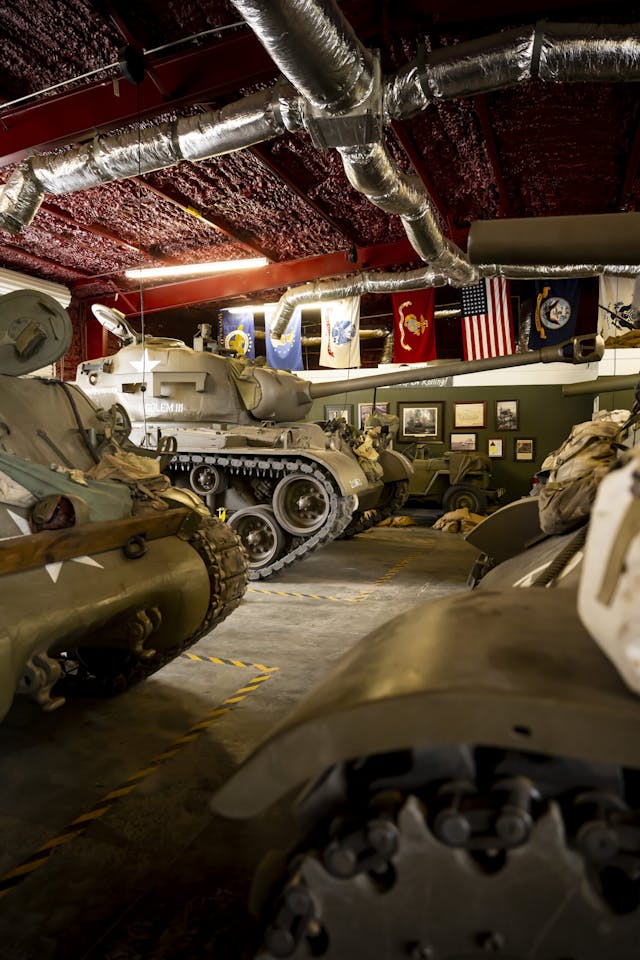











Check out the Hagerty Media homepage so you don’t miss a single story, or better yet, bookmark it.
The post The Tank Rabbi: Gulf War vet deploys WWII armor to tell its story appeared first on Hagerty Media.
]]>
Plenty of race-track corners have earned nicknames for their complexity or pucker factor. But Thunder Road’s “Widowmaker” isn’t even a corner—it’s a retaining wall.
The front-stretch barrier at Thunder Road Speedbowl in Barre, Vermont, is an ominous slab of slanted concrete slathered in green and yellow house paint. Back in the early 1970s, while racing at the paved oval, East Coast hotshoe Rene Charland smacked the wall in his Chevelle stocker. A photographer caught the scene: Four-time NASCAR Sportsman Series champion, vaulted into the air.
“They call it the Widowmaker for a reason,” says Flo Racing correspondent Matthew Dillner. “I’ve seen a few people get bit by it even in the times that I’ve gone.”
It’s a recipe for disaster. The racing groove narrows on the exit of turn four, forcing drivers to either give quarter or flirt with the Widowmaker.

The ominous wall is just part of the formula that sets this Vermont quarter-mile oval apart from the numerous short tracks dotting the American countryside. Broadcaster and NASCAR Hall-of-Famer Ken Squire founded the track in 1960 with support from a local paving contractor. Squire chose to run races on Thursday night rather than on Saturday—a tradition that remains today—because Thursday was when the day workers from the local quarry got their paychecks.
Since then, the track has become a staple for Northeast short-track ringers. Plenty of national-level talents circle the light poles every Thursday night, too, but Thunder Road’s distance from NASCAR’s primetime stage in the American Southeast hides many local drivers from the spotlight. Vermont may not be considered a racing hotbed, but the level of competition and the car count here are exceptional.

Even Vermont’s current Governor Phil Scott gets in on the action. Prior to serving as Vermont’s face, Scott won the 1996 and 1998 Thunder Road late-model championships. And he’s a two-time winner of the track’s most illustrious race: the Milk Bowl.
Named after Vermont’s dairy industry—which produces 2.7 billion gallons of milk annually—the historic race celebrated its 60th running in 2022.

Squire, the man who started it all, is no longer the owner but is still a mainstay at the track, belting his legendarily verbose lines from the press box. “It’s like magic to hear a voice that you grew up listening to at Daytona or Talladega calling a late-model race tucked in the mountains of Vermont,” says Dillner.
From its origin story to its color scheme, “There’s nothing typical about Thunder Road,” Dillner says. Even the spectators have an unusual experience: In the photo, behind Charland’s airborne Chevelle, you’ll spot a grassy knoll. Known as Bud Hill, the hillside offers spectators a unique vantage point from an unconventional perch—but bring a trowel. Dillner said that, on his first visit, he had to borrow another fan’s scoop to dig into the hillside and level his camping chair.

The post Widowmaker: Thunder Road’s treacherous turn-four wall appeared first on Hagerty Media.
]]>
A few racers with professional or academic backgrounds in engineering have had great success on the track, in part because of their ability to communicate the car’s behavior to the team. However, even Mark Donohue and Niki Lauda didn’t do much engineering on their own cars.
British engineer Michael Parkes raced successfully at the highest levels of motorsport and headed the development of the Hillman Imp, a technologically superior contemporary of the Mini Cooper. (The car’s design was brilliant; dealer support, production quality, and marketing were not.) Parkes was recruited by Enzo himself to develop race cars for Ferrari at a time when the Scuderia was dominant. Later in life, Parkes would develop the Lancia Stratos into a winner of multiple world rally championships.
You probably don’t even know his name.
Born in 1931, Michael Parkes followed his father—managing director and later chairman of Alvis—into the automotive industry, starting his career at the Rootes Group in 1949 as an 18-year-old apprentice engineer at Humber, a motorcycle and automobile company. (Along with the rest of the Group, which some considered U.K.’s General Motors, Humber was eventually purchased by Chrysler Corporation in 1967.) Three years after he arrived at Humber, Parkes’ father gave him a MG TD on the occasion of his 21st birthday, with the condition that he not race it. Parkes immediately did—and won.
He soon started club racing, eventually moving from MGs to Lotuses. He did well enough for none other than company founder Colin Chapman to offer him a stint as a reserve driver for the Lotus works team at the 1957 24 Hours of Le Mans. This was when Parkes was already working full time at Rootes, as the project engineer on the Hillman Imp.
According to his associate and racing buddy Tim Fry, the two young men—Parkes was 24, Fry was just 20—approached the Rootes technical director about the small car project that would become the Imp.
“We were very bored with the sort of cars Rootes were producing and with the arrogance of youth we went to the technical director and told him we could design just the car he needed. He just said, ‘All right, get on with it!'”

Parkes continued to race on the side. His success behind the wheel earned more and more attention, and heavyweights like Graham Hill started to offer him rides.
While Parkes was at Le Mans in 1961 to supervise Rootes’ Sunbeam Alpines competing in the race, the Ferrari team gave him the opportunity to take one of the factory 250GTs out on the La Sarthe circuit during testing. Parkes proved faster than Enzo’s own drivers. Small wonder that at the end of 1962, Parkes left Rootes to work for Ferrari as a reserve driver and development engineer.
He competed in Formula 1 for Ferrari, but his real métier was racing sports cars for Il Commendatore. Parkes won at Sebring and Spa in 1964, Monza in 1965, and Monza and Spa in 1966. The good times wouldn’t last, however.


The following year, while racing at Spa, Parkes’ tires became slick with oil. His Ferrari spun, then rolled.
Race cars of the era had few, if any, safety features. They had spindly tube frames and drivers were often flanked by fuel tanks. Many drivers opted to not wear seat belts as they preferred the possibility of being thrown from the car and crippled to that of being trapped in the car and getting burned to death.
As his Ferrari rolled, Parkes was ejected from the cockpit and dragged behind the car as it came to a stop. He ended up in a coma for a week and his leg injuries were so severe that his doctors considered amputating both limbs.
It took six months of recuperation and rehabilitation before Parkes could drive again. When he did return to full-time work at Ferrari in 1969, Enzo made him a financial offer described as “staggering”: Management of the Ferrari sports-car racing program in addition to his current role as engineer.
The catch was that Enzo considered Parkes to be more valuable as an engineer than a driver. If he accepted the offer, Parkes wouldn’t race.

Parkes was a born racer. In 1971, he left Ferrari, competing as a privateer in a Ferrari and later in a Pantera for the Filipinetti team.
Whether because of age or 1967’s accident, Parkes was not able to recover his form or pace. After the Filipinetti team broke up in 1973, Parkes moved to Lancia as the development engineer for the new Stratos rally car, powered by a Ferrari-designed engine. Under his direction, the Stratos won the 1974 Targa Florio and the World Rally Championship three years running, from 1974 to 1976, making it one of the truly iconic cars of its period.
Michael Parkes died in a road accident in 1977 when he rear-ended a 43-ton truck in his Lancia. He was killed instantly.

The exceptional range of Parkes’ portfolio distinguishes him from other successful engineer-drivers, a roster that includes three-time Indy 500 winner Mauri Rose and Chaparral creator Jim Hall.
Rose worked for GM’s Allison transmission division in Indianapolis and also had a role in the development of the V-8-powered Corvette and a number of high-profile GM show cars, including the turbine-powered Firebirds. One year he qualified for the Indianapolis race during his lunch break from the transmission plant, which sat across the street from the Motor Speedway.
Regarding Jim Hall, Roger Penske, who himself won four consecutive SCCA national championships as a driver, said: “Jim was one of the great road-racing drivers of his time. It was Jim who made me realize that you can’t win races without good equipment.” Hall, who trained as an engineer at CalTech, won with equipment of his own making and his innovations in those race cars continue to resonate today.
No disrespect to Rose and Hall, but Rose never was in charge of engineering an entire vehicle, and Hall’s engineering talents were generally restricted to racing vehicles. Parkes’ applied his engineering skills to both an innovative economy car and some very successful racing machinery, and during much of that time he also competed at the highest levels of racing with success.
To give you an idea of the high regard Parkes was held in by the racing community, TransAm champion David Hobbs, no slouch behind the wheel himself, told me that the best race he ever had was on the way to compete in an actual race at Goodwood in the U.K. in 1959.
Driving on narrow B roads through small towns and villages to the race course, Hobbs found himself being overtaken by someone driving a Hillman Minx at pace. Hobbs took up the challenge, and the two cars went wheel to wheel, exchanging leads all the way to Goodwood. Hobbs didn’t say who got to Goodwood first but he did say that when he arrived at the track, he discovered that his unknown competitor was Michael Parkes.
Michael Parkes was a man of singular distinction in automotive history, combining excellence in engineering and racing as few, if any, others have done. You should remember his name.
Check out the Hagerty Media homepage so you don’t miss a single story, or better yet, bookmark it.
The post Would you reject Enzo to keep racing? Engineer Michael Parkes did appeared first on Hagerty Media.
]]>

When you think of great automotive countries, France usually gets mentioned somewhere after the United States, Great Britain, Germany, Japan, and Italy. The truth is that France has been an automotive pioneer.
The traditional layout of front-engined rear-wheel drive cars is known as the System Panhard, after the French company that originated it. Likewise, the driveshaft-based Hotchkiss Drive, was how most 20th century automobiles were propelled. Citroën’s Traction Avant was arguably the first practical and commercially successful front-wheel drive automobile. Mathis is attributed with making the first all-aluminum car. In the 1930s, French luxury brands like Delahaye and Delage represented the apotheosis of Art Deco, and those marques continue to win high awards at the most prestigious concours. Ettore Bugatti, maker of what are considered the greatest cars of all time, had his atelier in Molsheim, in France’s Alsace region. Those French luxury brands are long gone (today’s Bugatti is a replica of the original, a vanity project of Ferdinand Piech).

What happened to those grand marques? Was it the Great Depression? No, most of the French luxury car makers survived the depression of the 1930s, and although they struggled, that decade was when those companies likely made their best products. Was it World War II? No, most of the French luxury car manufacturers were still in business when the Allies liberated France from the Nazis.
While those companies survived the Great Depression and the Second World War, they didn’t survive the plans of one man, Paul-Marie Pons.
The immediate postwar period was difficult for automakers worldwide. Germany, Italy, and Japan were in ruins. Britain’s factories had been bombed. American automakers were intact, but they faced the task of switching back to making cars after five years of producing armaments. Simply getting the material goods needed to manufacture automobiles was problematic. The War Production Board in the U.S. and the Combined Production and Resource Board in the U.K. continued to control the allocation of steel, rubber, and other commodities into the postwar period. American automotive startups like Tucker and Kaiser-Frazer struggled and scrambled to get materials. As steel was still allocated, smaller British automakers and specialists turned to aluminum—since war production had wound down, the aircraft industry was using less of it and there was no shortage of easily recyclable scrap aluminum littering the English countryside following the Battle of Britain. Automakers on both sides of the Atlantic started exploring a new material, glass-fiber reinforced plastic, GFRP, or fiberglass as we call it in the U.S.

During wartime, strategic materials must be allocated according to defense needs. In peacetime, however, central planning can be a roadblock to innovation. It doesn’t matter to some central planner that you have an innovative idea. The bureaucrat has already allocated the machinery and materials you need to an existing firm with a government contract.
After liberation, France was ripe for central planning. The provisional, transitional government set up after the Germans were expelled and the Vichy government collapsed was a three-party coalition joining the Christian Democrats with the Socialists and Communists. It was in power from 1944 until late 1946. With Socialists and Communists dominating the government, it’s not surprising that France embraced a centrally planned economy.
Influential economist Jean Monnet was put in charge of modernizing and reconstructing the French economy, and Paul-Marie Pons was tasked with rationalizing the French automotive industry. Pons had trained as a naval engineer and before the war had worked as an engineer and manager. After the war he was appointed to the Ministry of Industrial Production, under minster Robert Lacoste, a leading socialist politician.

In the aftermath of WWII, France had 22 car companies and 28 truck makers. Monnet and Pons thought that there were too many companies in those markets. In a manner that has been described as arbitrary and authoritarian, under Pons’ five-year plan seven companies were favored: Citroën, Peugeot, Renault, Berliet (a maker of military vehicles in addition to cars, trucks, and buses), Panhard, Simca, and Ford’s French subsidiary.
Renault and Citroën were allowed to operated autonomously, as they were considered large enough and strong enough on their own. Peugeot was required to join Hotchkiss, Latil, and Saurer for truck and commercial vehicle production. In the Lyon region, Berliet was required to link up with bus manufacturer Isobloc and Rochet-Schneider, which made commercial vehicles. Smaller manufactures than the favored seven were grouped together under Panhard at the U.F.A (Union Française Automobile) and Simca at the G.F.A (Générale Française de l’Automobile), each assigned only one vehicle.

In other words, not only did the Pons Plan tell which companies had to link up with other companies, the French government decided who would make what.
Passenger cars were divided into three main groups, according to vehicle size and market segment. Citroën, with its front-wheel drive Traction model, would would sell larger, expensive cars. Renault and Peugeot would produce mid-sized, mid-priced cars, leaving the less profitable small car market for Panhard and Simca. That small car would be versions of the A.F.G. (Aluminium Français Grégoire), a radical front-wheel drive aluminium based car designed by Jean-Albert Grégoire. Luxury specialists would concentrate on the export market, to help with France’s balance of trade.

Things don’t always go according to plan. After the war, Renault came under the control of Resistance veteran Pierre Lafaucheux, who simply ignored the Pons Plan. The small 4CV’s development was well underway before the war, so Lafaucheux went ahead with launching it in 1948. That left mid-size cars to Peugeot. Simca (Société Industrielle de Mécanique et Carrosserie Automobile) was controlled by a foreign company, Fiat, and located in the west of France, far from Paris, and they too ignored Pons. That left Panhard with the A.F.G, which was rebranded as the Panhard Dyna X. For its part, Citroën, which had been assigned large car manufacturing, went ahead and developed a small car that is quintessentially French, the little 2CV, also developed before the war and launched in 1948. In case you’re wondering why Renault and Citroën sold cars with similar CV brands, CV stands for chevaux, the French word for horses, and is related to the displacement and horsepower taxing scheme.
While the larger car companies, which were favored by Pons, did not quite follow his plan, by the time the government fell in late 1946 and Paul-Marie Pons was out of a job, the French vehicle market and the industry that served it were forever changed. The impact would last longer than five years, with clear winners and losers.
The winners were the four big companies which ended up dominating the French automobile market over the next 25 years: Citroën, Renault, Peugeot, and Simca.
The losers included Panhard, formerly a maker of stylish, large, expensive cars, now consigned to making a complicated small car that was expensive to make. In 1949, Panhard sold fewer than 5000 vehicles, less than 10 percent of the volume at Renault and Citroën. The use of relatively expensive aluminum, and an arithmetic mistake by Jean Panhard, the managing director and company founder’s son, in calculating its cost put Panhard in precarious financial situation from which it never really recovered, eventually selling off, bit by bit, it’s car operations and equity to Citroën, which discontinued Panhard passenger cars in 1967.
Small luxury car makers faced the dual problem of being restricted in their home market and trying to sell expensive cars in a war-torn Europe. While wealthy and neutral Switzerland survived the war with its economy intact, French luxury automakers had to compete with high-end manufacturers in Britain, Italy, and even Germany as it rebuilt in the 1950s. Americans and Canadians had money to spend, but they were already served by American automakers capable of producing huge volume.
Also into the 1950s, while steel was no longer a controlled commodity in France, tax policies enacted in the late 1940s started taking a toll on makers of larger cars, with an almost punitive annual tax on cars with engines larger than about two liters displacement. Once again a large company was favored as the displacement limit was just above what Citroën was featuring in its larger cars.
France’s smaller-volume makers particularly suffered in the wake of the Pons Plan. During the war, Émile Mathis had to go into exile because the Vichy government collaborated with the Nazi occupation forces when it came to Jews. He returned in 1946 and spent considerable sums rebuilding his factory in Strasbourg, which was bombed during the war as the Germans used it to make military engines and munitions. As a matter of fact, in exile Mathis himself had given the Allies the plans to his factory so that it could be more effectively destroyed. At the 1948 Paris Motor Show, Mathis revealed a modern six-cylinder sedan called the Type 666, but steel supplies were still controlled by the government. In the end, the Type 666 was never built, and the factory was sold to Citroën in 1953. In 1956, Émile Mathis died after a fall from a Geneva hotel window.
The displacement taxes severely affected Talbot-Lago, which closed its doors in 1958 and sold the Talbot brand to Simca.
Licorne, another small luxury car maker, showed new 8CV and 14CV cars at the 1947 and ’48 Paris shows, but like Mathis, they could not get the steel to go into production with them.

Rosengart and Samson, which survived the war by making military materiel, found their transistion to peacetime production stymied by Pons’ “preferred producers list.”
That leaves us with Bugatti and Delahaye, arguably the makers of France’s best cars in the 1930s.
The war left Etore Bugatti’s Molsheim factory in Alsace in ruins, and he lost control of the property. He had planned a new factory closer to Paris in Levallois, and he designed a series of new cars after the war, which he called the Type 73, to be made in both road and racing versions. But he was only able to complete five of the series. Just seven of the Type 101 were built. Plans to build a small car, powered by a supercharged 375cc engine, died with Etore Bugatti in August 1947. Without either Ettore or Jean Bugatti (who died in a prewar car accident) at the helm, the company declined and was out of business by 1953.
As for Delahaye, which also owned the Delage brand, the tax on large displacement cars was hard on its domestic-market sales. In 1947, Delahaye sold fewer than 70 cars in France, with 88 percent of its total production of 573 vehicles being exported, mostly to French colonies in Africa and Asia. Also, while the company was advanced in the 1930s, it struggled to keep up technologically in the postwar period, so in the case of Delahaye, its eventual demise cannot be attributed solely to the Pons Plan, but the Plan didn’t help. While production of the respected Type 135 was restarted in 1946 to generate some cash flow; by then the prewar design was considered obsolete, but Delahaye didn’t have much in the way of alternatives or money to create them. The new Type 175 and its variants, all planned before the war, were also outdated by the time they started production in 1948, as production was again impacted by material shortages. Also, the Type 175 had some serious quality issues, as in catastrophic failure of suspension components. The new models did not generate sufficient sales to recover costs, so they were discontinued in 1951.

Delahaye struggled moving forward, surviving by making military vehicles (despite the Pons Plan, the French army still needed vehicles) and a small number of trucks. In 1953, an updated version of the Type 135, branded as the Type 235, was introduced, but only 84 of those were ever built.
Hotchkiss, Delahaye’s main competitor, also survived by making military vehicles, in its case the Willys MB Jeep under license from Kaiser-Willys. It was cheaper and simpler than what Delahaye was making for the French army, which canceled Delahaye’s contract. Layoffs followed at Delahaye. In 1954, Hotchkiss merged with Delahaye, which was somewhat ironic in that Hotchkiss building Jeeps under license hurt Delahaye financially, making the combined company less viable in the long run. In mid-1954, Hotchkiss took over Delahaye and shut down car production there but continued to sell trucks under the Hotchkiss-Delahaye brand. By the mid 1950s, France’s most prestigious prewar car makers, Bugatti, Hotchkiss, Delahaye, and Delage were gone.
While all of the failures of French automakers in the 1940s and ’50s cannot be put at the feet of Paul-Marie Pons, it is certain that the Pons Plan put most of them in a precarious situation, favoring large, politically connected firms over many of the companies that established France’s reputation as a world-class automaking country. Maybe there’s a lesson for our current atmosphere, in which fossil fuels are disfavored and electric vehicles promoted. Sometimes it might make more sense to keep politicians out of the loop and let producers and consumers decide what’s good for the market. Perhaps better Adam Smith’s “invisible hand” rather than the government putting a few fingers on the scale.
Check out the Hagerty Media homepage so you don’t miss a single story, or better yet, bookmark it.
The post How one man destroyed French luxury car makers appeared first on Hagerty Media.
]]>
In the early hours of September 3, 1967, all traffic across Sweden came to a halt. All non-essential cars were banned from the road from 1:00 a.m. onwards. At 4:50 a.m., everything on wheels stopped.
Then, in systematically careful fashion, every car, truck, and bus moved from the left to the right hand side of the road. Slowly, traffic began moving again, the streets flowing in a mirror image of the way they had the day before.
The Swedes called it Dagen H (literally “H Day”). It was one of the greatest traffic logistics solutions ever enacted. The problem it was designed to deal with was straightforward but quite serious. Up until this point, Swedes drove on the left side of the road (and on the right-hand side of the car), as is still the convention in the U.K., Australia, and Japan. But in the countries that Sweden shares a land border with—namely, Finland and Norway—cars drive on the right side of the road. Crossing the border from Sweden into Norway was a bit of a kerfuffle, to say nothing of a visiting Finn in Stockholm getting a bit absentminded and driving the wrong way down a street.
Perhaps more pressing was that the Swedish themselves were wrecking cars by the hundreds. Traffic speeds had increased significantly through the 1950s and into the 1960s, and fatalities were way up. The vast majority of the cars driven in Sweden were left-hand-drive, which made passing on the right especially hazardous.

Hang on, I hear you saying, why didn’t the likes of Volvo and Saab simply build right-hand-drive cars? Surely, a country’s domestic auto manufacturers should build cars in accordance with its own rules of the road, no? Unfortunately, the reality of the situation was not so simple.
Horse sense
To understand the phenomena at work here, we need to delve into why different countries drive on different sides of the road.
As you might expect, the story begins when horsepower came from hairy beasts with two ears and four legs. Roadgoing conventions were first established in the era of horse-drawn transportation. Historians can’t entirely pinpoint when the practice of dividing up the roadway began, but it probably dates back to the invention of the sword. And in the past, different from the prevailing practice today, almost everyone stayed to the left.
Picture a mounted Roman cavalry officer riding down a track and encountering another rider headed the opposite direction. His right hand instinctively falls to the hilt of his sword, ready for action should this cloaked stranger present a threat. If he draws that sword, what’s the easiest side to defend on? The right, of course. So the two riders each keep to the left, and on they ride.
There are other considerations, familiar to any motorcyclist. Most people are right-handed, and similarly most people also are left-leg dominant. When throwing your leg over a motorcycle, the rider almost always approaches from the left. Some bikes even have ignition locks that engage with the handlebars turned to the left, and kickstands almost always lean to the left. In horseback days, staying to the left meant getting on and off on the verge, rather than in the middle of the road.
There is evidence to show that Roman charioteers and infantry columns followed the same practice of sticking to the left, and there was even a papal decree in the 1300s that pilgrims to Rome should keep to the left. But last I checked, everything from the Fiat 500 to the Ferrari F40 has the wheel on the right. So, what gives?

“Right” of way for wagons
The reason most of Europe and North America drives on the right is thanks to Napoleon and the Teamsters (regrettably, not a band name). In post-medieval times, wagon trains became the chief way to transport goods on land, and that whole business about swords was less of an issue. An early wagon driver with several oxen or horses lashed together in pairs would sit on the left-rear animal in the team, such that his right hand—holding the whip—was capable of keeping every member of the team going.
With two heavily-laden wagons passing one another, it was easier for the two drivers to keep right because they could more easily ensure that the sides of their wagons didn’t collide. Napoleon, who was actually left-handed, codified this into law in 1792 and later applied that law to French colonies.
“Left” out
The British, meanwhile, made keeping to the left the law. Wagon trains were less important to trade in an island nation like England, particularly one with a developed system of canals. As British and French clashed over ownership of global resources, passing on the right or left became a point of contention that played out in the respective imperial colonies.
Thus, as you have probably gathered, is why Australians and New Zealanders today drive on the left.
Yes, one fractious former British colony did throw off all possible vestiges of the empire’s oppressive yoke. It’s the U.S. of A., of course! (Actually, it’s possible driving on the right wasn’t a political choice at all in the U.S., as much as a consequence of the wagon-pulling phenomenon. But I digress.)
Meanwhile, in Canada, both approaches were going on simultaneously. In what must have surely been a thoroughly confusing time, anyone driving from the west coast to the east coast of Canada in 1919 would have started out driving on the left in British Columbia, switched to the right in Ontario, then back to the left by the time they hit the maritimes provinces. Newfoundlanders drove on the left until 1949.

And so we come back to Sweden
In Europe, most countries switched to driving on the right side of the road long before the first cars arrived. Sweden was a holdout, but no-one can seem to agree on exactly why. Keeping to the left became law in 1916, and many Swedish-built buses up until the 1960s were right-hand-drive, with doors opening on the left.
Here’s where it got dicey for the Swedes. Well-known domestic car companies like Saab and Volvo didn’t really get production going to scale until the 1950s, so until then, the passenger car market in Sweden was served by the likes of Ford, General Motors, and Chrysler. And, as we know, American automakers built cars to drive on the right side of the road. (This bit of history also helps explain the voracious—and enduring—Swedish appetite for Detroit iron. It’s an ongoing mania, with some 8000 muscle cars, cruisers, and hot rods gather in Lidkōping for a celebration earlier this year.)
Your average Swedish driver—let’s call him Lars Svensson—most likely owned a left-hand-drive Chevrolet (the top-selling marque until 1948). When Lars was stuck behind a Volvo truck on a winding country road in 1950, he couldn’t really see when it was safe to pass.
Happily, the Swedish government aimed to fix this conundrum. In 1955, a public referendum was held to discuss changing driving from the left side of the road to the right. Eight-three percent of the public said, “No thanks we’re fine just crashing.”
Their problem with the initiative was, ostensibly, its cost: many millions of Swedish Krona in signage, roadworks, and labor. Also at work was the natural societal resistance to change. The devil you know, and all.

Dagen H and its lasting legacy
Against public opinion, Dagen H went ahead anyway. The H stands for “Högertrafikomlāggningen” which means “right-hand traffic reorganization,” and also proves that the Germans don’t have a monopoly on long compound words.
The move was a shrewd one, in the end. Crashes dropped significantly, and Volvo and Saab ended up looking smart for not wasting money building right-hand-drive cars.
There were other, much weirder after-effects. Sweden’s government agencies organized a song contest as part of the efforts to remind the public not to drive on the left. The winning entry, “Keep to the right, Svensson,” ended up placing high in the country’s pop music charts.

We could leave things there. Instead, we invite you to come travel with us some 9200 miles from Stockholm, all the way to a small chain of islands in the Pacific. In tropical Samoa, people drive on the left-hand side of the road, a change they made in 2007. Why? Because of proximity of Australia and New Zealand. With most cars in Samoa being right-hand-drive imports from those countries, it’s the inverse situation of Sweden’s 1960s change on Dagen H. Samoa’s swap wasn’t easy to do, and there was similar public disapproval about the initiative. But as it turned out, most people think it was the right thing to do. Or rather the left thing.
Check out the Hagerty Media homepage so you don’t miss a single story, or better yet, bookmark it.
The post Dagen H: The day Sweden’s drivers crossed a line appeared first on Hagerty Media.
]]>
“Rules,” Chuck Yeager once said, “are made for people who aren’t willing to make up their own.” Armed with courage, confidence, and the talent to back it up, Yeager continually defied the odds and experts on his way to becoming a legend.
Yeager was already a decorated World War II combat fighter when he volunteered to test-fly the experimental Bell X-1 rocket plane and explore the possibility of supersonic flight. And 75 years ago, on October 14, 1947, he was the first to fly faster than the speed of sound.

“There’s no such thing as a natural-born pilot,” Yeager said, but he displayed an obvious knack for it. In September 1941, shortly after graduating high school, he enlisted in the Army Air Corps, where he first served as an airplane mechanic. Yeager said he applied to flight training because “I saw pilots had beautiful girls on their arms and didn’t have dirty hands.”
The U.S. entered WWII with the bombing of Pearl Harbor in December 1941, and the young pilot eventually flew 64 combat missions in his P-51 Mustang, recording 13 enemy kills.
Shot down over France while escorting a flight of B-24 bombers in March 1944, Yeager was aided by members of the French Resistance, who helped him return to his base in England. Although Yeager could have gone home to the U.S., he put in a request to return to combat, and General Dwight D. Eisenhower ultimately granted his wish. Yeager returned to action in August 1944.
“The secret of my success,” he said, “is that I always managed to live to fly another day.”
In October 1944, he became an “ace in a day” when he shot down five German planes in a single mission. Among the casualties was a German Me 262 jet. “The first time I ever saw a jet,” he said, “I shot it down.”

When the war ended in 1945, Yeager became a test pilot, and his exploits were among those chronicled in Tom Wolfe’s 1979 book The Right Stuff, about the origins of U.S. space program. The book became a movie four years later. Without a college degree, Yeager not allowed to become an astronaut, but his contribution to the program is undeniable.
Yeager’s historic supersonic flight on October 14, 1947, took all of the bravery and skill that he could muster. For years, aviation experts believed that we weren’t meant to fly faster than the speed of sound—Mach 1—theorizing that transonic drag rise would tear apart any aircraft. But Bell Aircraft Company had other ideas, and it was ready to prove it with the X-1, a light, streamlined rocket plane that resembled a .50-caliber bullet.
It was up to Yeager to pull it off. Two days before the flight, however, he was nearly grounded by a horse.
According to chuckyeager.com, Yeager and his wife, Glennis, went horseback riding, and on their return home, they challenged each other to a race. When Yeager’s horse came to a fast stop as it neared a closed gate, Yeager was hurled head over heels to the ground. The following day, with Yeager in intense pain due to broken ribs, he went to see a veterinarian so that he could keep his injury hidden from the flight doctor. The vet taped Yeager up, then advised, “Don’t do nothin’ strenuous.” Sure thing, Yeager promised.

The next morning, he slipped into the cramped cockpit of the X-1, named Glamorous Glennis, and prepared to enter uncharted territory, which he jokingly referred to as the “ugh-known.” Flying over Rogers Dry Lake in Southern California, the X-1 was lifted to an altitude of 25,000 feet by a B-29 aircraft and then released through the bomb bay. Yeager, climbing to 40,000 feet, accelerated until he exceeded 662 miles per hour (the sound barrier at that altitude). The X-1 survived completely intact, and the sonic boom could be heard on the ground.
Yeager’s quote afterward doubles as an encouraging message about perseverance. “Just before you break through the sound barrier,” he said, “the cockpit shakes the most.”
Due to the secrecy of the project, the achievement wasn’t announced until June 1948. Yeager continued to serve as an Air Force test pilot, and in 1953 he flew 1650 miles per hour in an X-1A rocket plane.

Often called fearless by the media, Yeager said he was anything but. He just used fear to his advantage.
“I was always afraid of dying. Always,” he said. “It was my fear that made me learn everything I could about my airplane and my emergency equipment and kept me flying, respectful of my machine and always alert in the cockpit.”
Yeager retired from the U.S. Air Force in 1975 with the rank of brigadier general. He died on December 7, 2020, at age 97. Today, his orange X-1 rocket plane hangs in the Smithsonian Air & Space Museum in Washington, a testament to breaking the sound barrier—and the rules.
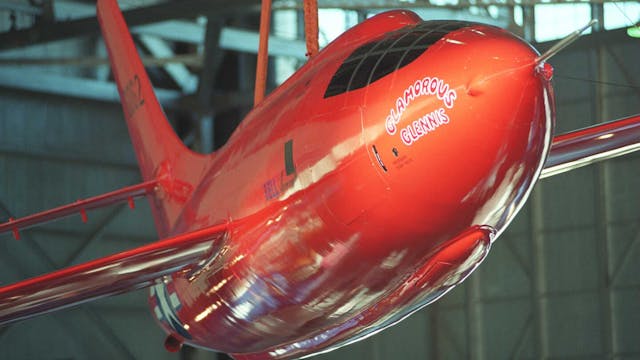
Check out the Hagerty Media homepage so you don’t miss a single story, or better yet, bookmark us.
The post 75 years ago, test pilot Chuck Yeager went supersonic appeared first on Hagerty Media.
]]>
In California’s high desert, U.S. Route 395 meanders under the eastern shadow of the Sierra Nevada. Cruelly hot in summer and freezing in winter, it can also be windblown, sweeping Isetta-size tumbleweeds across the gritty terrain like demonic medicine balls. Or it can be benevolent, with only the caw of a wheeling crow and the distant drumming of tires rending the stillness. Nearby are an ancient lava flow, leering overhead like a battalion of case-hardened gargoyles, and several volcanic cones, their iron-rich alluvium spilling about like the train of hell’s wedding dress. And right beside the highway are scattered chunks of pure obsidian, gleaming black and smooth as a Duesenberg at Pebble Beach.
But what do volcanology and Duesenberg have in common? Insolent natural forces, and chance. The Earth’s surface was shaped by physics and time. And so was Duesenberg, which celebrated its 100th anniversary in 2021. The “physics” that shaped America’s greatest luxury marque were the collective vision, drive, and innovation of Frederick and August Duesenberg—and, later, Errett L. Cord. The Duesenberg brothers were, figuratively, forces of nature in their time, developing and producing what some regard as America’s greatest cars, the 1928–37 Model J and supercharged Model SJ. Based on the brothers’ racing technology, they unequivocally delivered the most power, performance, and prestige at an unashamedly high price.
That is, until it all crashed and burned.

Two hundred miles south, the streets of Burbank, California, are the polar opposite of the high desert, with the maximum imaginable quotient of concrete and asphalt. Inside Jay Leno’s Big Dog Garage are eight Duesenbergs, including a supercharged 1932 Model SJ with a Murphy convertible body.
On a Tuesday morning last spring, Leno said, “If you’re going to write about Duesenbergs, you have to ride in one.” So I turned the passenger-side door handle, stepped in, and obediently sat, like a 5-year-old on the first day of kindergarten. There are no seatbelts. The engine-turned dashboard is crowded with instruments—including an altimeter, stopwatch, and brake-pressure gauge—plus four ingenious annunciators for chassis lubrication (every 80 miles), battery water level (every 1500 miles), engine oil service (every 700 miles), and the lubricant level in a chassis greasing system. Electromechanically operated, they are akin to an early computerized maintenance minder.
Leno was already inside, after unplugging a charger from the 6-volt batteries. With practiced precision, he set the ignition-timing lever and updraft carburetor’s choke, centered the gear lever, switched on the ignition, and pulled the starter knob. The big engine whirred slowly, laboriously turning its massive 350-pound crankshaft through 12 quarts of 50-weight oil and groaning like a massive radial on a Mitchell bomber. And then the 420-cubic-inch straight-eight engine sneezed, caught, and settled into a smooth, easy idle. Fred Duesenberg was passionate about engineering, and his engines prove it. The 3.5-foot-long forged-steel crankshaft has five main bearings and runs supremely smoothly, thanks to an integrated balancer incorporating cartridges filled with mercury—a liquid metal 13.5 times denser than water—that quell vibration. The forged camshafts are drilled hollow, and the aluminum pistons and tubular steel rods (Duralumin, or aluminum-copper alloy, on the Model J) are blueprinted.
The straight-eight drives through a three-speed non-synchro gearbox and a torque tube to the live rear axle. Though silky, the motor is busy-sounding, a telltale of the twin-cam cylinder head. The cams are driven by two chains; one from the crankshaft to a reduction sprocket on a jackshaft, and another, longer chain wrapping around the camshaft sprockets. Thirty-two tappets, located under polished aluminum covers, add more commotion. Add in the shaft-driven centrifugal blower and the deep, free-flowing exhausts (a cutout lever lets the driver bypass the muffler), and a Duesenberg SJ sounds like a machine shop in full production.
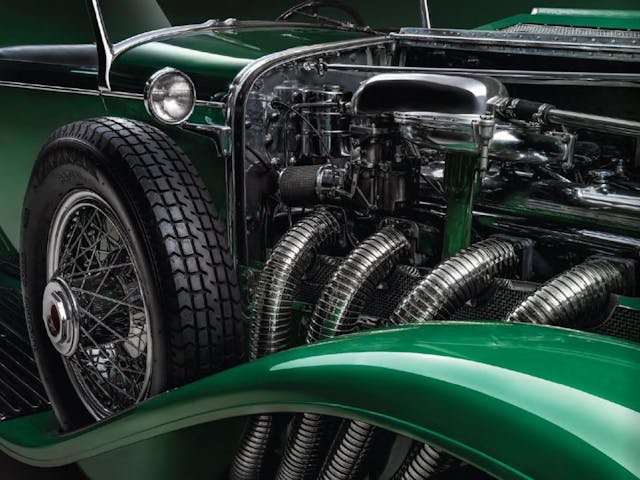

“Duesenbergs were bought by extroverts, Hollywood people, flashy people,” Leno said. “In 1928, there were hardly any roads you could go fast on, so there was really no need for a huge twin-cam four-valve straight-eight engine.” But the way you rose in stature in 1920s America was by flaunting it, and these were the fastest, most powerful you could buy. “Packard probably outsold Duesenberg 4 or 5 to 1,” continued Leno. “And because Packards were for bankers and conservative old money, you didn’t even hear them coming up the street. But a Duesenberg announced itself with the roar of the engine and all that kind of stuff. It was a showoff car, and certain people just loved it.”
Double-clutching between first and second gear, Leno guided the SJ out of the garage and toward the Golden State Freeway, accustomed to the stir that his impressive mug and such cars cause among Burbank’s populace. Although only a two-seater, the Murphy convertible is huge. Its 142.5-inch wheelbase is similar to a Ford F-150 SuperCab, and it weighs close to 6000 pounds. Mounted on 19-inch rims, its beaded tires stand nearly 3 feet tall—merely a hand’s width lower than the 1966 Le Mans–winning Ford GT40. With 6-inch-high sidewalls, the tires roll over city streets like an M4 Sherman tank over Rice Krispies.
Reportedly, the SJ could hit 90 mph in second gear, reach 100 mph from a standing start in 17 seconds, and go nearly 130 mph. “Imagine that in 1930, when going ‘a mile a minute’ was considered over the top,” Leno shouted above the engine noise. “This is a classic you can drive like a regular car, because it can keep up with traffic.” Then he punched it up the freeway on-ramp. The man gets on the gas.
***

If you thought Duesenberg was a German car, well, it might have been. This constitutes the first bit of chance that let America birth Duesenberg for her own. Brothers Fred and Augie immigrated with their mother in 1885, settling in Iowa. In that agrarian state, they finished their formal education early. They were ambitious, though, and with Fred the hard-headed mechanical innovator and Augie the production specialist, they started building and racing bicycles.
Over time, Fred became chief engineer of Mason, an early car company based in Iowa, and with financial backing from founder Edward R. Mason, the brothers began developing four-cylinder race cars. They won several important races and finished 10th in the 1914 Indianapolis 500 with future World War I ace of aces Eddie Rickenbacker at the wheel. The brothers also began building truck and marine engines.
When Europe’s first war of the 20th century came pounding at America’s door, Fred Duesenberg was ineligible for active duty due to a leg injury from racing. So the brothers started manufacturing military aircraft engines in New Jersey. By chance, the Duesenbergs’ airplane unit was based on a powerful 16-cylinder Bugatti aero motor, created by pairing two straight-eights at the crankshafts in parallel to create a unique “U-16.” And since multicylinder airplane motors were more powerful, faster, and lighter for their size than car engines of the day, why not adopt their architecture? Motors made to kill might make killer car engines, too.

Wartime was hell for people but outstanding for technology. In the U.S. Army Air Service, a precursor to the Air Force, engines had to be light, high-revving, and powerful. This bred lighter valvetrains, aluminum pistons, higher crankshaft speeds, tougher bearings, and pressurized oiling systems. And so, while the Duesenbergs produced high-output inline engines for war, their interest in racing and Fred’s engineering acumen soon begat the Duesenberg straight-eight. By chance, the Duesenberg game board was set.
“Before the [Duesenberg] Model A was produced, they were looking at the market,” explained marque authority Randy Ema. “They followed the American Springfield-built Rolls-Royce concept, which was to build the chassis and engines and let coachbuilders create the bodies. One of their experiments was with early alloy pistons, an Achilles’ heel for automobiles. Production cars had cast-iron pistons and their engines operated at low speeds, up to maybe 1800 rpm. But eventually, the Duesenberg Model A could turn 4000 rpm and racing Duesenbergs could turn 5000 rpm.”

Soon after Armistice Day in 1918, the Duesenbergs focused on building a production car, the Model A. “They were already successful in racing,” Leno pointed out later. “They were like Ferrari—they liked to build racing cars. Well, how do you finance your race car wins? Build production cars and sell them.”
Their masterwork was the 260-cubic-inch, 88-hp engine, with its eight inline cylinders and gear-driven single-overhead camshaft, which made the Duesenberg Model A exotic for its day. America’s first such engine, its prescient layout became an essential part of production and racing cars, particularly at Indianapolis, until the mid-1950s. Cradling the motor was a ladder frame consisting of a pair of 8.5-inch rails made by Parish of New Jersey (later acquired by Dana Corp.), with six cross-braces. To these were bolted semi-elliptical leaf springs and solid axles, including a tubular front unit.
The Model A braking system was another Fred Duesenberg invention. He didn’t formalize the principles of fluid dynamics or make the discovery that fluids are noncompressible, but he did apply them to the Model A by using four-wheel hydraulic brakes with large, 15-inch drums. In lieu of brake fluid as we now know it, Duesenberg used a mixture of glycerin and water in the lines. And Fred never patented the invention. Imagine if he had.

Ironically, the racing- and aero-based engineering existed beneath typically unremarkable bodies. But to the Duesenberg brothers’ way of thinking, the whole idea was to achieve functional excellence, so letting owners and coachbuilders create the bodies was both logical and practical.
Some context may help here. In 1921, when the Duesenberg debuted, the automobile industry was transitioning from horse-and-buggy-era craftsmanship into mechanized moving assembly lines. Of course, Henry Ford, Walter P. Chrysler, and GM co-founder William Durant had head starts, but mass production simply wasn’t a mountain the Duesenbergs wanted to climb. Instead, every Duesenberg was hand-built from commissioned parts and assemblies at Duesenberg’s Building No. 1 at 1501 West Washington Street in Indianapolis. Part of the structure remains today.

With the engines and chassis done, bodies could be as elegant and rich as the buyer wanted. Coachbuilders including LaGrande (a Duesenberg holding in Indiana); Judkins Co. of Massachusetts; Brunn & Co., LeBaron, Rollston, and Willoughby Co. of New York; Derham Body Co. of Pennsylvania; and Bohman & Schwartz and Murphy of California created Duesenberg bodies. Fundamentally, period body designs needed to: a) cover the engine; and b) accommodate passengers. “You know, owners would sometimes put 10 people in their car—it was crazy,” Leno later said from a comfy couch in his “Brough Room” at the garage, named for the extensive collection of British Brough Superior motorcycles it holds. “So they just made the bodies as big and strong as they could. And particularly with the later Model J’s powerful engine, it worked fine.”
Want to know why a 2021 Mercedes-Benz S-Class looks the way it does? The dual necessities of covering the engine and accommodating passengers created the archetypical luxury look of a long hood joining a long body, which included a convenient side entrance we now simply call “doors.” And the forms stuck. Adding these requirements together, plus the period luxury element of a setback radiator, yielded two Model A wheelbase variants, one 134 inches and the other 141 inches. Long, sweeping fenders protected passengers from dust and mud on the primitive roads.
In 1921, the Model A chassis cost about $6500, with the coachbuilt body pushing the total price upward of $8500. For contrast, in 1921, Briggs & Stratton produced the Flyer, sort of a soapbox racer for the road, with two bucket seats and an air-cooled engine, advertised for $125. The wealth disparity of today recalls the wealth disparity a century ago. In all, 650 Duesenberg Model As were made.
***
Long before slogans such as “Win on Sunday, sell on Monday” were bantered around conference rooms by marketing flacks, the Duesenberg brothers went racing. In contrast to Europe’s road races, in America, racing largely meant ovals, and so the two primary forms of motorsport already started diverging; the Indy 500 had only existed since 1911, and permanent road circuits didn’t exist at all yet.
This affects the Duesenberg story because oval racing and road racing required different approaches. The former rewarded durable high-speed engines, high-capacity oiling and fuel-delivery systems, high-speed tires, and reduced frontal area; it also required fewer speeds in the transmission. Conversely, road racing required flexible engines, multispeed transmissions, and strong brakes. The Duesenbergs’ interest and appetite for both forms of racing ultimately yielded a production car that was more fully rounded than those of its competitors, even though production Duesenbergs were not intended to be racers—just technically superior luxury cars.
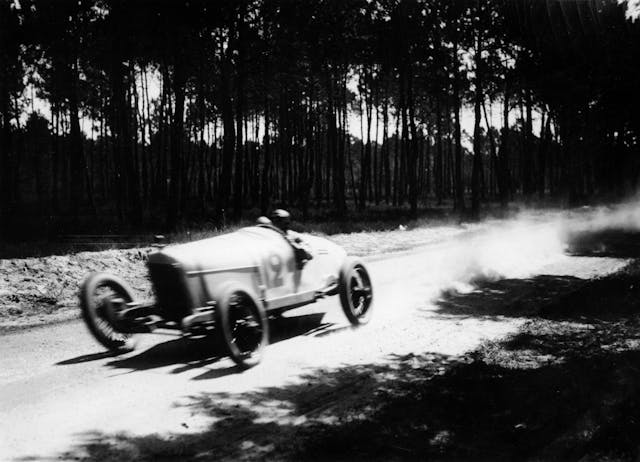
Following their early U.S. efforts, including Indy, with four-cylinder single-seaters, the Duesenbergs went to Europe with bespoke 3.0-liter eight-cylinder racers. Their breakthrough was the French Grand Prix at Le Mans in 1921. An early form of today’s Circuit de la Sarthe, it then measured 10.7 miles and was rough as hell. To even call it tarmacadam would be a big stretch—during the 322-mile race, it grew rutted and the cars’ tires threw stones with punishing force. After battling the favored French Ballot entries, American Jimmy Murphy won by some 15 minutes despite losing his radiator water and driving the last lap with flat tires and a cooked engine. The Duesenberg racers were that strong. Importantly, it was the first time an American car and American driver had won a grand prix, a feat not repeated until Dan Gurney drove his Eagle Mk 1 to victory at Spa-Francorchamps in 1967. (Sadly, although the French GP–winning car returned to the States, where it continued racing with Miller power, it did not survive.)
Racers to the core, the Duesenbergs continued building engines and chassis for Indianapolis. In some form, their inventions raced at the Brickyard most years from 1913 to 1937 and won three times against their technological archrival, Miller, another dual-overhead-cam machine patterned after the Duesenberg. The Duesenbergs set land speed records as well, including a 1-hour run at Bonneville in 1935 at an average speed of 153.97 mph with a rebodied, supercharged Model SJ driven by Ab Jenkins.

***
The Model A clearly wasn’t for everyone, due to both size and cost, although these cars ultimately accounted for the majority of Duesenberg’s total production. Fiscally, this left Duesenberg on the ropes in 1926. Along came E.L. Cord, a captain of industry and the owner of Auburn, who had deep pockets and a flair for style. He visualized an even larger Duesenberg to headline a three-brand company that would include Auburn and, eventually, Cord.
Cord enacted his plan: Buy out Duesenberg Motors and provide the resources and freedom to build the most technologically advanced, the most powerful, and the most luxurious American car ever. This was, after all, the Roaring Twenties. And that’s what happened. From 1926 on, as chief engineer, Fred focused on creating the Duesenberg Model J, a machine that is still considered, nearly a century later, a pinnacle of American ingenuity, performance, and quality.
Rightfully confident with the cars’ engineering, their racing successes, and the infusion of cost-no-object capital from Cord, Fred Duesenberg embarked on building the finest motorcar the world had seen to date. Unsurprisingly, its essence was its engine. Debuting in late 1928, the Model J straight-eight was 420 cubic inches of dual-overhead-camshaft, 32-valve brashness. Valve actuation used a single cam lobe and follower for each of the valves, a dizzyingly complex arrangement for the day. Producing a reported 265 horsepower at 4250 rpm, the Model J engine was—by more than twice—the most powerful American production car engine. It was also the only DOHC eight-cylinder production car engine on the planet. Bugatti, Bentley, Hispano-Suiza, and Mercedes-Benz couldn’t touch a Duesenberg’s output, nor could any other American car until the Chrysler Hemi three decades later.

The Lycoming-built mill had European influence beyond Bugatti. In 1912, Peugeot, a maker of family cars, had created the world’s finest grand prix car using a DOHC hemi-head engine with four valves per cylinder, devised to reduce valve-train mass and thus valve float, a side effect of high revs that limited both engine speeds and volumetric efficiency. Swiss engineer Ernest Henry deserves credit here, but the Duesenbergs saw the value and first harnessed it in a production car. It’s worth noting that over a half-century later, Mercedes-Benz in 1986 and Oldsmobile in 1988, with much fanfare, announced their four-valve engines, the 190E 2.3-16 and Quad 4, respectively. Now they are commonplace in most every variety of automobile except those with pushrod valvetrains.
Duesenberg’s sophistication came at a price, however, because (for example) a Model J valve adjustment requires both camshafts come out and it consumes an entire 40-hour workweek. “But Duesenberg said, ‘We don’t care what it costs,’” Leno said, shoes propped on a coffee table and gazing at a Brough SS100 worth maybe half a million. “‘We’re going to have four valves, twin cams, and perfect balance.’ It was just ridiculously amazing. To me, the two greatest [cars] are the four-valve 8-liter Bentley—although it was only a six-cylinder—and the 7-liter Duesenberg. And by the way, compared with the Model J, I think the Mercedes 540K drives like a truck.”
Ema added later, “I personally have driven everything, including the Bugatti Royale, Hispano-Suiza J12, and Bentleys. None are as drivable as a Duesenberg. Even comparing apples to apples, at the time, a Rolls was more money and a fifth the car, with less than half the drivability. The Rolls turned 2100–2200 rpm max, and in terms of power, in 1928, the closest American car was a 115-hp Auburn Model 115 flathead-eight. Nobody had anything close to the Model J. The Duesenberg was a Veyron compared to a Fiesta.”

The Model J “chassis,” as the rolling machine was called, still used a ladder frame, with elliptical springs and Columbia axles that were stiffer than those of the Model A. The wheelbase options were 142.5 inches or 153.5 inches. Innovations included lightweight aluminum castings for the firewall, the instrument panel, and for its hollow mounting brackets. It was an elegant contrast to other luxury cars that used sheet metal in these places. Up front, in lieu of a thermostat to control water temperature through flow restriction, automatic radiator shutters opened and closed as the cooling needs dictated. A bimetal spring inside the radiator tank moved a bell-crank to open the shutters as water temperature rose or close them as it cooled. This was in 1928; Honda ballyhooed its own active shutter grille 90 years later.
There’s more: As an early form of antilock brakes, the Model J had an adjustable valve that increased or lessened vacuum in the brake booster. In ideal road conditions, the driver opened the valve fully, thereby allowing maximum hydraulic pressure during pedal activation. The valve could be adjusted for rain and snow, reducing clamping force at the drums to lessen the likelihood of wheel lockup in low-grip conditions. A gauge displayed hydraulic pressure on the instrument panel. Note: Electronic ABS finally gained prominence in production automobiles in the 1990s.
With Cord’s blessing, the Duesenbergs maintained their focus on building the best possible “chassis” while entrusting coachbuilders to finish the car. Both American and European coachbuilders were used, per Model J buyers’ preferences.

Prior to delivery by driving, truck, or rail, every chassis was driven several miles to the Indianapolis Motor Speedway and tested for 100 miles, with each driver responsible for sorting out any problems found. Exactly 481 Model J chassis were built, at a nominal cost of $8500. A done-to-the-nines Model J could cost $25,000 at a time “when a house cost $1200,” noted Leno.
***
Like a town built unknowingly on a giant strike-slip fault, Duesenberg’s undeserved misfortune was that it began producing America’s grandest car right before the Great Depression of 1929 knocked the country flat. Worse, this happened when the company was having its biggest year (200 cars sold), employing 42 people (at a typical wage of 50 cents per hour) and turning out a chassis every 22 days. The Depression, predictably and historically, ended Duesenberg Inc. in 1937, but not before the untimely demise of Fred Duesenberg, who succumbed to pneumonia in 1932 after suffering injuries in a road accident. Duesenberg had lost its engineering seer, its magma source, its soul.
Included in the Model J build were 38 supercharged Model SJs, whose chassis were priced at $9500. A shaft-driven centrifugal supercharger turning at seven times engine speed—up to 31,500 rpm—pushed a dense, powerful air-fuel mixture into the cylinders. Bolstered by their tubular-steel connecting rods, SJ engines produced a claimed 320 horsepower at 4200 rpm, enough to propel the 3-ton cars to 140 mph. But it takes a big commitment with the right pedal to make this happen; the supercharger is ineffective below 2500 rpm, about where the SJ cruises at 65 mph. Like in a race car, in a Duesenberg SJ, you must step on it if you want to go.
The iconic side exhausts, initially an SJ exclusive, were adopted for their flash appearance on numerous normally aspirated Model J cars. Two special, shorter, 125-inch-wheelbase two-seat roadsters were delivered to actors Gary Cooper and Clark Gable. They featured twin updraft carbs and reportedly made 400 horses, slightly shy of the audacious 1967 Corvette L88’s rated 430 horsepower.

***
Richie Clyne and Sam Mann are friends and collectors who own seven Duesenbergs and actually use them on tour. “I have driven my 1933 Murphy Town Car all over the country,” Clyne said. “If you’re standing still in traffic or parking, it’s hard to turn, but on the open road at 70, there’s a wonderful sweet spot where the engine torque, gearing, steering, ride compliance, noise, and vibration are all in harmony.”
“I organize an all-Duesenberg tour where we drive 200 to 250 miles a day for four straight days,” Mann added. “If you are going to do twisties and drive fast, your technique needs some maturity and it’s a little tiring, but I would say no more so than driving a 300SL.” But once you’re familiar with the car on halfway decent roads, it’s very much a serene experience, he added. “They’re not like a needy World War I–era car to keep running—they just need gas.”
In a final bit of chance, Augie Duesenberg died in 1955, the year Chrysler’s C-300 broke the 1928 Model J’s 265-hp figure with a dual-quad 331-cube Hemi. The great book had closed. As automobiles evolved and WWII came and went, Duesenbergs met with mixed fates. Some stayed with their families for generations, while others were summarily scrapped, or in the case involving Leno’s incomparable aerodynamic Walker Coupe, used as a tow truck. “During World War II, a Duesenberg might be found for $600,” said Leno. “If that sounds cheap, consider that, at the same time, a used Ford Model A cost $5. So they’ve always been expensive.”
Today, 378 Duesenbergs Model Js are known to exist, and Ema has seen all but a few. As for value, the SSJ owned by Cooper and later Briggs Cunningham sold for $22 million in 2018, making it the most valuable known American car. On the low end, a decent “starter” Duesenberg Model A might run $300,000 today. Author Ken Purdy couldn’t have predicted such values in his 1960 book, Wonderful World of the Automobile.
“Many Americans have never seen a Duesenberg automobile, the most luxurious and expensive this country has known,” he wrote. “Today the cars rarely come on the market at all and when they do the price asked ranges from $3500 to $10,000 … it’s unlikely that we will ever build $25,000 cars again.”
The numbers may have changed with inflation, but the sentiment is correct: Duesenberg will likely never be topped as America’s greatest force of nature in the art of the automobile.


Check out the Hagerty Media homepage so you don’t miss a single story, or better yet, bookmark it.
The post How the Duesenberg brothers redefined the great American automobile appeared first on Hagerty Media.
]]>
Across the digital world, most published content is bite-size, designed for quick consumption. Still, deeper stories have a place—to share the breadth of an experience, explore a corner of history, or ponder a question that truly engages the goopy mass between your ears. Pour your beverage of choice and join us each day this week for a Great Read. Want more? Have suggestions? Let us know what you think in the comments or by email: editor@hagerty.com
The signs are everywhere, but they might as well be nowhere. Yellow markers, warning against trespassing and promising that violators will be prosecuted, no longer serve as deterrent, if they ever did. As Detroit’s once-proud Packard assembly plant continues its slide into ruin, interlopers have turned the automotive landmark into a giant dump. The buildings, or their remains, hold unwanted junk of all sorts—as large as cars and boats, as small as household waste.
Now it appears the brick and mortar will soon follow suit. After a foreign developer abandoned his redevelopment plans for the plant, the City of Detroit was given permission to level the place in the name of public safety. The wrecking ball could get to work any day. When that happens, a hundred-year-old landmark and long-contested symbol of a struggling city’s glory days will be gone for good.
Detroit being Detroit, the Packard plant is not alone. Eleven miles to the west, the former American Motors Corporation headquarters will also meet the wrecking ball as part of a redevelopment costing $66 million. Other historical industrial/transportation buildings are also undergoing change. In the Corktown neighborhood, the 18-story Michigan Central Station, opened in 1914, is receiving the finishing touches of a reported $738 million makeover. (USA Today says the number is closer to $1 billion.) Like the Packard plant, Michigan Central has been deserted for years. Unlike that plant, it is on the way to becoming the centerpiece of a new high-tech campus for the Ford Motor Company. Meanwhile, the long-vacant Fisher Body Plant 21 on Piquette Avenue is set to be repurposed as Fisher 21 Lofts, a $134 million project.
Detroit has been a home of “ruin porn” since the tail of the last century—these buildings are but the four most visible and well-known. Depending on where you stand, their diverging futures are either exciting or tragic.
“I grew up in the city. I know all these buildings well, and yeah, you’d like to preserve them, but it’s a balance,” says Tim Conder, vice president of acquisitions for NorthPoint Development, which is redeveloping the AMC site. “Sometimes you can preserve them, sometimes you can’t. People compare Central Station [which is essentially an office building] with AMC, but you’ve seen AMC—that’s not an office market out there … It just wouldn’t work.”


Claire Zimmerman is an associate professor of architecture at the University of Michigan. She favors at least partial preservation whenever possible. So much of Detroit’s architectural history, she says, has already been lost.
“When Detroit grew so fast [in the early 20th century], one of the defining typologies of the city, in terms of architecture, was the daylight factory,” she says. “It was a significant invention because daylight factories were so well lit, and the conditions were so much better than the timber factories and mill buildings. These factories were really the fabric of the city.”
The remaining daylight factories are valuable, Zimmerman says, not just for their history, but because they’re also big, well-built, and versatile. “You can use them for pretty much anything … They’re really kind of flexible. But they’ve been demolished one after the other.”

The problem with saving these buildings, Conder says, is the cost. And there are other considerations with structures like these.
“If you want to maintain the historical aspect of it, you want to get tax credits,” he says. “That’s a long process, it’s a tedious process, and it’s not an easy process. It’s like restoring a car; do you want to do it halfway? Maybe there’s adaptive reuse, and you can include portions of a façade, but that still costs money. That wasn’t factored in at AMC. That building is just too far gone.”

The Motor City is a place both shackled and bolstered by its past. These four buildings are a tangible version of Detroit’s complex relationship with history, but they’re also deeply representative of how the city operates and has always operated. How optimistic plans born of good intention can repeatedly stall. How tradition matters, but long periods of decline can bring too much entrenchment in the past. And how the city’s very strengths can stand in the way of it becoming the best modern version of itself.
The undeniable truth is that things in Detroit are changing, and not always as everyone would like. So, we went there to see the condition of these historic for ourselves.
AMC Headquarters

The former American Motors Company headquarters and factory sit at 14250 Plymouth Road, about 10 miles northwest of downtown Detroit. At 95 years old, the AMC complex is the youngest of the four sites in this story. It is also the only one not built from the start for the transportation industry.
Designed by the city firm of Smith, Hinchman & Grylls, and built under the direction of architects Amedeo Leoni and William E. Kapp, the facility’s administration building and factory were completed in 1927. They were constructed for the Kelvinator Corporation, which made home refrigerators. Originally 1.5 million square feet (later expanded), the park included a tall office tower facing Plymouth Road. Behind that building sat a huge, three-story factory in multiple sections, plus a self-contained power plant. Kelvinator’s name was chosen to honor the British physicist Lord Kelvin, who developed a scale for measuring absolute temperature. A Kelvin quote was once engraved above the doorway to the plant’s administrative entrance: “I’ve thought of a better way.”

For Kelvinator, the better way involved a merger with Nash Motors in 1937. In 1954, the resulting company, Nash-Kelvinator, merged again, this time with Detroit’s Hudson Motors, forming the American Motors Corporation. When AMC relocated its headquarters to suburban Southfield in 1975, the Plymouth Road facility refocused on Jeep. In 1987, when Chrysler bought AMC, the complex was renamed the Jeep and Truck Engineering Center.
Twenty years later, in 2007, Chrysler filed for bankruptcy. The Plymouth Road complex closed in June 2009.
Drama began soon after. In 2010, the AMC facility was sold to Terry Williams for $2.3 million. (The original ask was $10 million.) Williams announced that he was going to turn the facility into a school for autistic children, but he began stripping the factory of scrap metal, which authorities said “disturbed asbestos-containing materials and released ozone-depleting substances.” In 2014, Williams was convicted of violating the Clean Air Act and sentenced to 27 months in prison. The AMC property, seized by the court, was transferred to the Wayne County Land Bank. It wound up as property of the City of Detroit in a 2018 land swap. A subsequent environmental-cleanup operation included demolition of the power plant and much of the rear of the factory.
After the property sat vacant for more than a decade, Detroit Mayor Mike Duggan held a press conference on December 9, 2021. NorthPoint, he announced, would demolish the remaining buildings and replace the complex with a $66 million warehouse development.

“One by one,” Duggan said, “we are taking down the massive vacant buildings that for too long have been a drain on our neighborhoods and our city’s image, and putting something new in their place … (and) I expect we will be announcing plans for other such sites in the city very soon.”
Not everyone was so excited. Because NorthPoint pursued public incentives (the firm eventually secured $32.6 million in brownfield TIFs), the Missouri-based developer was required to hold public meetings about its plans for the site. Those meetings resulted in “a ton of pushback” from preservationists, Conder says, and a December 2021 editorial in Crain’s Business News—the headline was “Detroit needs a plan to save its industrial history”—advocated saving the historic structure. The Crain’s story immediately prompted an open letter to the editor from neighborhood residents, who were thrilled that something was finally being done with the abandoned complex. It was an eyesore near a public park, they claimed, one with racist ties to the area.

“The joy in our neighborhoods was indescribable,” the letter read. “For many years, that monstrous abandoned AMC site has devastated our community, driving down the home values of those who stayed, crippling any effort to rebuild commercial businesses on Plymouth, and permanently affecting our children’s view of the neighborhood where they are being raised … We won’t sit by while outsiders, who couldn’t find our neighborhood without a map, presume to tell us how much we should value their precious ‘Art-deco neighborhood landmark.’”
NorthPoint’s Conder, despite his admitted affection for historic buildings, agrees: The time to save the AMC facility has come and gone.

“Do you know how long that building has sat there untouched?” he says. “The moment someone is interested in the site, all of a sudden people come out of the woodwork and say, ‘You can’t do that …’ No one cared about it until we got it under contract. Talk to the community; they’re happy to see it go. Hey, I love historical buildings and want to preserve as much history as we can, but again, you have to balance that with economics and business going forward.
“The problem with Detroit is, there are not enough readily available sites to develop. So, when requirements come out for space in the city, they quickly realize there are no sites available, so they immediately look in the suburbs. And there are sites available in the suburbs, so none of the business stays in Detroit. What we’re really trying to do is help the city of Detroit create developable sites that are readily available … We’re trying to remove blighted properties, bring in new projects, bring in new jobs to the area.”
Northpoint says the plan to build a 794,000-square-foot warehouse or light industrial space on the former AMC campus at Plymouth Road will create 350 permanent jobs and 100 temporary construction jobs. Demolition is expected to begin this month. Conder says it will take approximately six months to “prepare the pad” and 12 months to complete construction.


“We approach these as spec developments, meaning we don’t have a tenant,” he says. “We buy the property, tear it down, clean it up, and go vertical—all while talking to prospective tenants.”
In addition to cost, Conder says, the number-one reason NorthPoint never considered saving even a portion of the AMC structure is that every bit of the 50-acre site is needed to deliver adequate warehouse space.
University of Michigan’s Zimmerman has not visited the AMC headquarters recently, so she admits that it might be too far gone. Regardless, she says, the facility never should have reached this point. On historic Detroit buildings in general, she reasons, “The City of Detroit is not thinking about the city’s heritage here; they’re thinking about the city’s budget … (but) once these things are gone, they’re just gone. You can’t recapture them.
“I think it’s a little bit of a failure of the public realm not to have some provision to guard the history of the city and its significant buildings. Yes, they require some maintenance, and you’d have to do serious work to bring them back up to a usable state, but what do we have city governments for? We have them to keep law and order, and to preserve civic identity.”








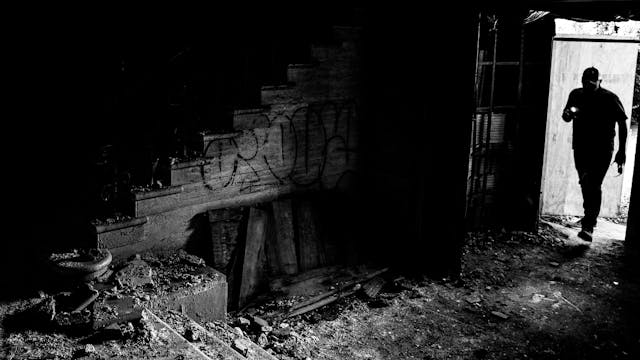












Fisher Body Plant #21

Daylight factories, Zimmerman says, can be used “for pretty much anything.” Perhaps as evidence, the 600,000-square-foot Fisher Body Plant 21 is in the process of being resurrected as Fisher 21 Lofts. Standing at the corner of Piquette and Saint Antoine—but officially listed at 6051 Hastings Street—Fisher 21 is only a few blocks east of the refurbished Ford Piquette Avenue Plant Museum, where the Model T was born. Visible from both I-94 and I-75, Fisher is often referred to, Zimmerman says, as “the big white factory with all the graffiti.”
Since it was abandoned, she notes, the plant has been a magnet for “urban explorers, music-video performers, and what you might call informal social events, like raves. It has had quite a devoted audience.”
Designed by architecture firm Smith, Hinchman & Grylls, the Fisher factory was constructed in 1919. The company operated as an independent coachmaker, producing bodies for Cadillac and Buick, before being purchased by General Motors in 1926. Among Fisher 21’s many production roles was the assembly of tanks and war materiel during both World Wars. It built limited-production limousine bodies starting in 1955.
Historically speaking, Zimmerman says the significance of Fisher Body goes beyond the war effort and vehicles produced.
“Sort of controversial was Fisher’s role in the emergence of the UAW—not so much in Detroit, but in Flint, where sit-down strikes occupied Fisher Body No. 1. It essentially gave the UAW a foothold in Detroit, and that ultimately included all of the Fisher plants and other automotive plants in the city. No matter how you feel about the union, it was a feature of midcentury American history, and these modern factories helped to bring it into being.”

On November 29, 1982, GM announced that Fisher Plant 21 would cease operations, citing the building’s inefficiency as reason for closure. The facility was officially shuttered two years later. In 1990, the Carter Color Coat Company purchased the plant, using it for industrial painting. When Carter declared bankruptcy in June 1992, Fisher 21 was abandoned for good. The City of Detroit took ownership of the plant in 2000, and the Environmental Protection Agency began remediation work in 2008, removing and disposing of soil, contaminated equipment, and underground storage tanks.
In March 2022, Mayor Duggan, echoing his AMC comments just four months earlier, announced that Fisher 21 would no longer be a blight on the city. Duggan exulted in the news that the former factory would be saved and redeveloped as a $134-million residential building with 433 apartments and ground-floor retail: “It is very exciting to be able to save this historic landmark and put it to work for the residents of this city for decades to come.”
The Fisher 21 Lofts venture is believed to be the largest African American-led project in Detroit’s history. It is helmed by developers Gregory Jackson of Jackson Asset Management and Richard Hosey of Hosey Development. In a press release, Jackson said, “This project is being done by Detroiters and for Detroiters. This project is proof of the potential of Detroit, its spirit, and its people. We are honored to become stewards of this forgotten piece of the city’s storied past and turn it into a key piece of its future, bringing catalytic investment, quality housing, and destination retail to this proud neighborhood.”

According to the Detroit News, the Fisher 21 Lofts project triggers a city ordinance that requires developers to work out a benefits package for the community. Project officials have promised to hire city workers and contractors.
“Not only will they be taking Fisher Body 21 from blight to beauty,” Duggan tweeted, “they have committed to making sure Detroiters are able to take part in the redevelopment.”
Fisher 21 Lofts will be a mix of studio, one-bedroom, and two-bedroom apartments, and at least 20 percent of them will be at or below 80 percent of the area median income. Designers with architectural firm McIntosh Poris Associates are planning 28,000 square feet of commercial space and 15,000 square feet of co-working space, plus a two-acre roof with views of the city, a quarter-mile walking track, an indoor lounge, a fitness center, and dog areas.
Zimmerman, naturally, is elated.
“The Fisher Corporation had so many of these body plants—I mean, this is number 21—so to me it’s representative of a type that was widespread across the United States,” she says. “I think it’s going to be great as a refurbished building. Some of the splendor of these ruins is lost when they’re reused, but it’s far better that they be reused, than demolished.”



Michigan Central Station

Years before airplanes became the preferred choice for long-distance travel, Michigan Central Station—located at 2001 15th Street, southwest of downtown—served as Detroit’s transport hub. To acquire the space required by the 500,000-square-foot structure, the city began buying out homeowners and condemning property as early as 1908.
Hastened by a fire at the city’s old depot, Michigan Central opened five years later—and two weeks early—on December 26, 1913. The mammoth building, a three-story train depot underneath an 18-story office tower, was a collaboration between architectural firms Warren & Wetmore of New York and Reed & Stem of St. Paul, Minnesota. The two firms also created New York City’s Grand Central Terminal.


For decades, the glistening marble floors, elegant bronze appointments, and 54-foot ceilings of Michigan Central’s majestic main lobby bore witness to soldiers heading off to war, sad goodbyes and happy hellos, and the comings and goings of entertainers and politicians. As historicdetroit.org so aptly put it, Michigan Central also served as Detroit’s Ellis Island, where generations of Detroiters “first stepped foot into the city,” pursuing factory jobs and a better life.
At the station’s opening it represented the tallest railroad station in the world and was the fourth tallest building in Detroit. The Michigan Central Railroad, a subsidiary of the New York Central, invested $16 million (nearly $450 million today) in the grounds, including the office building, the rail yards, and an underwater rail tunnel to Windsor, Canada. The station itself cost $2.5 million and featured a restaurant, a main concourse with copper skylights, a lunch counter, and bathing facilities.

At the beginning of World War I, when American rail travel peaked, more than 200 trains left Michigan Central each day. But as the auto and airline industries grew, train travel began to wane. In 1956, historicdetroit.org says, the New York Central System offered Michigan Central Station and 405 other passenger stations for sale for $5 million ($55.5 million today). There were no takers. Railroad companies began to merge, pooling their resources. In 1971, the U.S. government formed Amtrak, and there was a glimmer of hope as an oil crisis that hurt the auto industry sparked an uptick in rail travel. Locals applauded when Michigan Central’s main waiting hall underwent a $1 million upgrade in 1975, but the depot was never able to return to its former glory or retain enough riders to stay afloat. By 1985, as few as six trains per day passed through Michigan Central. On January 5, 1988, the last train rolled out, bound for Chicago.
Potential buyers and tenants came and went. So did trespassers, looters, and vandals. At one point there wasn’t a single unbroken window in the place, and water filled the basement. In 1995, the station was purchased as an investment by billionaire Manuel Moroun, who refused to spend any money on its upkeep until he found a suitable purpose and tenant.
Finally, on June 11, 2018, the Moroun family announced that the depot and surrounding property had been sold to Ford Motor Company, for $90 million. Ford said the building would become the centerpiece of a 1.2-million-square-foot Detroit campus focused on new technology, an area it has since named the Michigan Central Innovation District.

Multiple requests to interview a Ford representative familiar with the project were unsuccessful, but officials have said that Michigan Central will serve as hub of a 30-acre facility dedicated to entrepreneurs, workforce development, and testing. Some 5000 workers—half of them Ford staff—are expected to be employed there. Google has signed on to become a district “founding member,” providing cloud services and training for students and job seekers.
“This is not going to be a Ford campus,” Ford Motor Company executive chair Bill Ford said, at a press conference. “This is going to be a campus where entrepreneurs, big and small, (will) help develop the future.”
The Michigan Central renovation is expected to be completed in 2023. “I’m thrilled about it,” University of Michigan’s Zimmerman says. “What they’ve done is really kind of amazing.”
Describing the massive transformation of the old train depot, which has received $126 million from the state of Michigan, Bill Ford said, “We are in the process of turning this from a national punchline into a national treasure.”


Packard Plant

Once upon a time, many hoped the same would be said of Detroit’s Packard plant. The gargantuan facility, once the standard-bearer of modern automotive factories, is now a globally recognized symbol of urban decay. Part of the complex will soon be torn down. Like the AMC headquarters, the plant has been subject of debate for years.
Just after the turn of the 20th century, investors persuaded the Packard Automotive Company to move its headquarters from Warren, Ohio, to Detroit, and company president Henry Joy tasked Albert Kahn to head up the project. Built on 40 acres of pastureland on Detroit’s east side, at 1580 East Grand Boulevard, the first buildings opened for business in 1903. With 10,000 square feet of floor space, the Packard factory was considered the finest and most-efficient automotive plant on earth.
From 1903 to 1905, Kahn built nine structures at Packard. Then he decided those buildings were too cramped and didn’t provide enough light. While constructing building #10, he improved the design—more windows and open space, for better light and ventilation, to make Packard workers more comfortable and more productive. Kahn tapped his brother, engineer Julius Kahn, to design a trussed-concrete rebar reinforcement system. The resulting masterpiece became the most well-known of the daylight factories. Kahn quickly renovated those nine earlier buildings in similar fashion, and other manufacturers soon followed his lead, even outside the car industry. The complex would eventually comprise four million square feet of factory space and employ up to 40,000 workers at its peak.

“Albert Kahn was a giant in Detroit’s heroic age, the visionary who created the humane ‘daylight factories’ for Packard Motor and Henry Ford,” author Michael H. Hodges writes in Building the Modern World: Albert Kahn in Detroit. “And in the process, (he) helped birth both modern manufacturing and modern architecture.”
Owning a Packard automobile was considered prestigious, and buyers were considered particularly intelligent for doing so. Packard vehicles were known for their cutting-edge features, which included the modern steering wheel and air-conditioning in a passenger car. Following WWI, Packard made the transition from hand-built products, high in labor hours, to production-line assembly. In 1939, it constructed a bridge over East Grand Boulevard to connect the north and south halves of the plant, and that bridge became a landmark.

Tasked with building Rolls-Royce aircraft engines during WWII, the Packard Plant required further expansion and upgrades, and additional improvements were necessary following the war. By the mid-1950s, however, the plant’s multistory layout had become obsolete. Worse, sales were down. In 1954, Packard merged with Studebaker—also struggling financially—and two years later, production was moved to a smaller plant on Conner Avenue. The last true Packard from East Grand Boulevard rolled off the line on June 25, 1956.
Portions of the Packard site were used by numerous small businesses until the late 1990s, when most of the structures were abandoned, left to scrappers, squatters, and the elements. The last tenant moved out more than a dozen years ago. Wayne County eventually took ownership of the property, offering it to the highest bidder in a 2013 tax-foreclosure auction.

Despite many years of neglect and abuse, Packard’s reinforced concrete structures were then mostly intact and structurally sound. Peruvian developer Fernando Palazuelo bought the complex, two 20-acre sites, from Wayne County for $405,000. Palazuelo’s local company, Arte Express Detroit LLC, immediately began cleaning up the property, and in 2017 it officially broke ground on a 15-year, $350 million plan to redevelop the complex into a mixed-use site.
“I was really impressed (with) the power, the charisma, and the future,” Palazuelo said. And then, quoting Napoleon, he declared, “I assure you, we will not fail.”


Zimmerman believes Palazuelo was sincere. “I’ve been there many times over the years,” she says. “The first few times, it was like they’d just walked out the previous day and left everything behind … But the last time I was there—in 2018 or ’19—all of that stuff had been cleared away. The floor plates were clear, and you got the sense that he was planning something new for that building, that it had been prepared for that.”
There was a bit of a setback in January 2019 when the iconic bridge collapsed and had to be razed, and then a year later the COVID-19 pandemic hit. In November 2020, Palazuelo announced that he was scaling back his original plan. In October 2021, a lack of progress caused him to lose tax incentives tied to the plant’s development. That resulted in Arte Express announcing plans to sell the site for $5 million.
Company representatives have not commented publicly since.

After Palazuelo’s attorney missed a March 24, 2022 court appearance to address safety issues at the Packard site, Wayne County Circuit Judge Brian Sullivan ordered Palazuelo to immediately raze the structures and foot the bill. Sullivan, calling the crumbling Packard Plant a “public nuisance,” said it threatened “the public’s health, safety, and welfare.”
When Palazuelo missed a court-ordered deadline of April 21 to apply for a demo permit, the city began seeking bids from demolition contractors. On July 12, the Detroit Demolition Department announced that it had selected Michigan contractor Homrich Wrecking Inc. to perform partial demolition. The $1,685,000 contract will be paid for using funds available through the American Rescue Plan Act.
Charles Raimi, attorney for the City of Detroit, expressed frustration and disappointment when he told Detroit’s Fox 2 News in April that Palazuelo “never delivered on anything. He just left this horrible, blighted, dangerous property sitting in the middle of the city for years … all these grand plans … turned out to be not true.”

Regardless, for historians, there remains a flicker of hope. According to a report in the Detroit News, in his State of the City address in March, Mayor Duggan vowed that the Packard Plant would be redeveloped. He also said that the process would save the front portion of the city-owned building, along the south side of Grand. If that happens, it would be a win for both the city and for preservationists.
The plant, awaiting its fate, remains a bit of tourist attraction. The day I visited with a photographer, we were all alone with the ghosts, walking among trespassing signs, rubble, and trash. On the south side of the plant, in a doorway near a pile of bricks from a collapsed floor above, we found a tattered Look magazine, dated April 9, 1963. Its pages flapped back and forth in the breeze, much like the Packard plant’s fate has for years.

Zimmerman chooses to remain optimistic. “If you can rehab Fisher 21,” she says, “you can rehab Packard—at least some part of it. What these buildings have going for them is that they’re really hard to tear down; they’re so big and well-built. At this point, a lot of it may be too far gone and no longer structurally safe, but hopefully some of Packard can be saved.”
The clock is ticking. As always, in Detroit, the question is what happens when it stops.
Want more stories from our Great Reads project? Click here.
***
Check out the Hagerty Media homepage so you don’t miss a single story, or better yet, bookmark us.





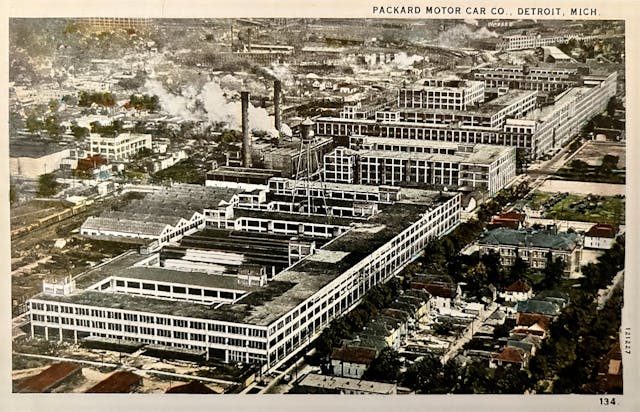
The post How Detroit’s transportation landmarks are—and aren’t—being saved from ruin appeared first on Hagerty Media.
]]>
There are Instagram accounts and fan sites; eBay sellers holding the rarest beasts in the field; dedicated obsessives boasting hundreds of examples in their collections and displaying these pieces in their homes like hunters mounting their hard-won, taxidermied prizes.
Welcome to the passion of the vintage steering wheel, and to one of the most storied names in car culture—the vintage Momo, the face that launched a thousand apexes, the timeless Italian circle with the deliciously tidy name.
Born into a wealthy Milanese family, Gianpiero Moretti found racing while studying political science at the University of Pavia. If you believe the lore, at the age of 24, he designed his first wheel in a garage in 1964—the leather-covered rim was thicker and smaller than the industry average, for a finer sense of control. When the legendarily skilled John Surtees won the Formula 1 World Championship for Ferrari that year, he used a new Moretti wheel. Moretti said the helm was ordered personally by Enzo Ferrari; other accounts hold it had been specified by Surtees himself, and that il Commendatore needed to be convinced of the benefits, attached as he was to a traditional wooden rim.
Whatever the truth, Moretti’s work made a dent in the culture. The accessories company he founded in 1966 was called Momo, for Moretti Monza, hat-tipping the Italian track. In the early years, the firm sold not just wheels but racing suits and other gear, reflecting Moretti’s romantic vision—and embodiment—of a pro’s track life and neon personality. (No less than Mario Andretti once called Moretti a “flamboyant, likable guy.”) Ferraris soon came with Momo wheels, and in the late 1960s, when the Porsche 917 went to Le Mans with a factory-installed Momo Prototipo, you could buy a virtually identical wheel for your road-going 911. In the years that followed, Momo parts landed wins from Sebring to Salisbury, and the company became an OEM supplier to manufacturers as varied as Mazda and Rolls-Royce.

Steering-wheel collectors appreciate the racing aura, but also the uniquely Italian sense of myth—that shrugging approach to history, where record-keeping is often seen as nuisance and facts rarely compass the bolder, brighter romance. With early and uncommon Momos often trading hands at four-figure cost, the wheels can seem like attainable relics of a simpler time, where the hand-worn leather provides obvious evidence of the connection between body and machine. [Smith’s “Weissrat” BMW 2002 features a vintage Momo, whereas editor Larry Webster’s 911 has a modern reproduction -Ed.]
Mads van Appeldoorn runs the Momo fan site patipatina.com. He has owned around 500 vintage wheels, though his collection currently holds only 50, including an early, 380-millimeter Monte Carlo made by Moretti himself, before creation of the Momo label. Prototipos seem to be “the one to have,” van Appeldoorn explains, not least due to the Porsche connection and because a version of the wheel is still made today. But the prime appeal, he claims, is in the aesthetic perfection that Moretti laid out.
“The ratio of spokes to circumference, the size of the spoke holes [if there were any], the way the leather has been treated and stretched around the rim—it just felt right, balanced. You might say a Nardi”—Italy’s other wheelmaking titan—“is not that different, but for me, it starts with the hub pattern: first bolt at 12 o’clock, straight in the direction of driving. It feels harmonious and calm.”

Naturally, values vary. More common vintage Momos in rough shape can be had for as little as $20. Sought-after rarities from the 1960s, like the Sebring or Monte Carlo, can take years to find and are priced accordingly. Parts can also be pricey. Vintage Momo-made marque horn buttons (logos shifted over time) and vintage solid hubs (new ones are collapsible) often fetch hundreds of dollars, which doesn’t sound like a lot until you notice that the hubs are indifferently cast pot metal and the horn buttons are made of cheap-looking plastic the diameter of the top of a soda can.
Chalk it up to Italian charm—and part of the fun. There is no singular great source for vintage-Momo information, Appeldoorn says, not even the company itself; manufacturing changes were never well-documented, even for high-profile signature wheels named for racers like Lauda and Andretti. Or take the Prototipo: It began life as a flat-spoke wheel in mostly large diameters, 370 and 380 millimeters. Spokes were later dished for strength, the leather and stitching evolved, and engravings and fonts were altered and moved around. Still, even for the brand’s most storied offerings, nobody logged those alterations in company books. This is, interestingly, where an enthusiast’s typical obsession with minutia blurs against the unprovable. If you want to know, Appeldoorn says, you have to dig on your own.
Moretti sold his company to an American firm, Breed Technologies, in 1996. Momo remains based in Italy but is now owned by the MW Company, with a design office in Los Angeles. MW’s creative director, Howie Idelson, a co-founder of Porsche gathering Luftgekühlt, says the brand is influenced heavily by American desires, “because aftermarket equipment is so restrictive in Europe.”

And what about the idea of a road-going tool, someone’s hard work, displayed as dust-gathering “art” on a wall?
“I love it,” Idelson says. “I think it’s a tribute to how strong the brand is, the history and story. And it ultimately comes down to this recently renewed passion for driving old cars—that steering wheel is a connection, the experience coming into your hands and body.”
Four years ago, Momo launched its Heritage line, a reimagining of vintage models like the Prototipo and the Grand Prix. These new wheels retail for around $300 and offer the perfume of vintage aesthetics—primarily distressed leather and classic logos. They aren’t literal reissues, but they’re a nice nod to the obsessives, and the feel is right. Which matters most of all, Idelson says.
“I think ‘simple’ is a good word here. The Prototipo is a great example. It’s not invasive, and the spoke concavity—people seem to like the position it puts them in. It looks at home in any car of the era.”
“My first one came in a vintage Porsche 911, 20 years ago,” van Appeldoorn says. “A beat-up, sunburned Prototipo, cracked leather, a bit greasy, worn aluminum, lots of patina. But from that moment, I was caught by the idea of vintage steering wheels in vintage cars. The only palpable connection between the driver and the road.”
This feature originally ran in the Hagerty print magazine RADIUS, a perk of one of our exclusive member programs.
Check out the Hagerty Media homepage so you don’t miss a single story, or better yet, bookmark it.
The post Perfect Circle: Momo’s Prototipo steering wheel isn’t flashy, and that’s the appeal appeared first on Hagerty Media.
]]>
Enzo Ferrari opened his namesake scuderia in Modena, in 1929. It took 18 years for the future automotive titan’s name to grace the nose of a road car—the Ferrari 125 S. In the three-quarter-century since, the Prancing Horse has become synonymous with ultra high performance, timeless style, and motorsport prowess. For many both in and outside of the automotive know, Ferrari is the pinnacle.
To celebrate 75 years of Ferrari as a formal automaker, we’ve assembled this diverse roster of snapshots from the brand’s history. The company’s sterling legacy is the product of its cars, racing exploits, cost-no-object engineering, personalities, and devoted fans. Take a few minutes to relive it all.
Lusso

“Lusso” means “luxury” in Italian. It means “gorgeous” in Ferrari. Many consider the Pininfarina-designed 250 GT Berlinetta Lusso to be Ferrari’s most ravishing road car. Within its graceful fuselage was the final iteration of Gioacchino Colombo’s 250 V-12, a racing mill mellowed for the road. As a 34th birthday present, Neile Adams bought a chestnut brown Lusso, No. 4891, for her husband, Steve McQueen. It was that kind of car.
Ferrari 312T

Pole-sitter Niki Lauda takes flight at the Nürburgring Flugplatz in the 1975 German GP, on his way to his first world championship. It was a year in which it all came together for Ferrari, with a dominant car, a flat-12 engine designed by the brilliant Mauro Forghieri, Lauda “The Computer” at the wheel, and team manager Luca di Montezemolo, Ferrari’s future CEO, providing a steady hand. A year later, Lauda nearly died at the same circuit in a fiery crash, permanently ending Formula 1 racing on the ’Ring’s famous 14.2-mile Nordschleife.
Michael Schumacher

Ferrari’s single greatest period of F1 domination was at its peak at the 2002 French Grand Prix at Circuit de Nevers Magny-Cours. Ferraris driven by Michael Schumacher and Rubens Barrichello won 15 of the 17 rounds that season. Schumacher, whose 3.0-liter V-10–powered F2002 is reflected in the helmet visor of one of the circuit’s sapeurs-pompiers, or firefighters, was on his way to winning his fifth of seven world champion titles.
250 GTO

For many, the 250 GTO is the quintessential Ferrari, a euphoric mix of voluptuous styling and savage V-12 performance. Launched by Giotto Bizzarrini and later developed by Mauro Forghieri, the GTO was a homologation special (hence the O in its name, for omologoto), conceived as a semi-practical production coupe hiding a full-bore track weapon. With only 36 built, it flouted the 100-car production requirement at the time, yet it became the last front-engine machine to dominate sports car racing.
Turbo Formula 1

Ferrari’s fortunes in F1 crashed in the turbo era, known for its 1500-hp monsters as well as its pyrotechnic turbo failures. The Scuderia won but one race in 1984, and the following year, the Ferrari 156/85, pictured here at Monaco with its 1.5-liter turbo V-6 spitting flame on its way to second place, only managed two wins (and 11 retirements) at the hands of Michele Alboreto and Stefan Johansson. After that, Ferrari went into a 37-race slump as Honda returned to F1 and conquered all.
Scuderia Ferrari

Ferrari’s dedication to the sport is summed up in this one photo of the team’s chockablock garage at the 12 Hours of Sebring in March 1962. In the distance: the No. 23 250 TRI/61 that would win overall. Not pictured: the No. 24 NART 250 GTO crewed by Phil Hill and Olivier Gendebien that marked the GTO’s racing debut. It finished second. Enzo Ferrari only reluctantly joined the migration to mid-engine layouts, long clinging to the notion that “the ox always goes in front of the cart.”
La Ferrari

It was the successor to the Enzo and the lineal descendant of the F50 and F40. As such, the La Ferrari arrived in 2013 as a $1.4 million limited-production special intended as a styling and technology showpiece. The 6.3-liter V-12 was Ferrari’s first roadgoing powerplant to incorporate a hybrid-electric drive, the unit delivering 950 horsepower and 60 mph in 2.5 seconds.
Mille Miglia
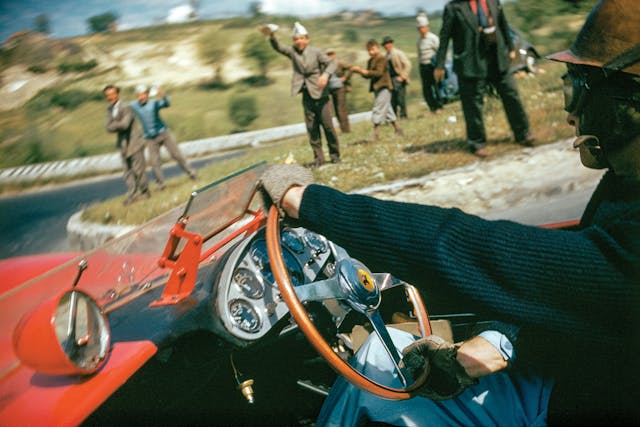
Famed motorsport photographer Louis Klemantaski snapped Peter Collins racing toward Rome in a Ferrari 335 Sport in the 1957 Mille Miglia. Klemantaski served as Collins’s navigator as well as a photo documentarian of the final Mille Miglia. Authorities banned the event after Alfonso de Portago plowed another Ferrari into a crowd, killing himself, his navigator, and 10 spectators. Collins died a year later in a Ferrari in Germany, one of a number of crashes in the period that decimated the Scuderia.
Targa Florio

Though racing on public roads largely disappeared in the 1950s, Vincenzo Florio’s original 1906 sprint around Sicily somehow managed to survive until 1977 despite repeated fatal incidents. Here, the No. 6 Ferrari 512S of Nino Vaccarella and Ignazio Giunti blasts through the ancient stone villages at Le Mans speeds during the 1970 running, nothing but hay bales separating the cars from the crowds. This lone factory entry finished third, turning 11 laps of the 44-mile circuit.
F40

Enzo Ferrari himself pulled the sheet off the F40 in 1987, saying he had tasked his engineers with building “a car to be the best in the world.” The twin-turbo 478-hp, 197-mph supercar car was the best—and still is, according to many. In the mold of the stripped-down sports-racers of Ferrari’s early years, the $400,000 F40 was intended to go from showroom to track with few mods. Enzo died a year later, igniting demand (1315 were built) and resale prices.
John Surtees

When he joined Ferrari in 1963, “Big John” Surtees was already a name in Italy for bagging the GP motorcycle world championship for MV Agusta. Naturally gifted, tireless, and utterly fearless, he was instantly a contender on four wheels and revived Ferrari’s fortunes as it chased Lotus and BRM. In 1964, the Scuderia returned with the new V-8–powered 158, and though Surtees won only two races, he nicked the championship by a single point, making him an Italian national hero.
Gilles Villeneuve

Enzo Ferrari demanded devotion from his drivers as well as unflinching courage. A former snowmobile racer from Quebec, Gilles Villeneuve had all those qualities, plus enough raw talent to vault him to the highest level of motorsport without any help from a family fortune. From the moment he joined Ferrari in 1977, he drove flat-out, taking his stiff ground-effect cars to the edge of control—and sometimes beyond.
Enzo

The Old Man, Il Commendatore, Mr. Ferrari. Whatever people chose to call him, they did so with respect. The son of a metalworker from Modena, Enzo Ferrari was a commoner who built an empire to which aristocrats and dilettantes came on bended knee. A ruthless competitor and weaver of political intrigue, he sold cars in order to race, though he almost never attended races himself. He died in 1988, as much an enigma as a legend. The car they chose to honor him with in 2002 was equally complex, a 651-hp, $659,000 statement of the Scuderia’s accumulated knowledge and technology.
Le Mans
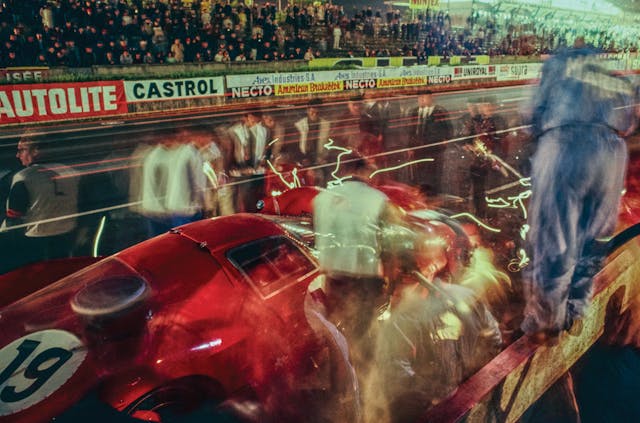
When buyout negotiations between Ford and Ferrari fell apart in the summer of 1963, Henry Ford II is reputed to have said, “OK then, we’ll kick his ass.” By 1967, the onslaught was in full swing, the modified Ford GT40 Mk IVs gunning for a repeat of the ’66 Le Mans win. Here, the Ferrari 330 P4 of Günter Klass and Peter Sutcliffe pits during the ultimately futile effort to salvage Ferrari’s honor.
Spaghetti
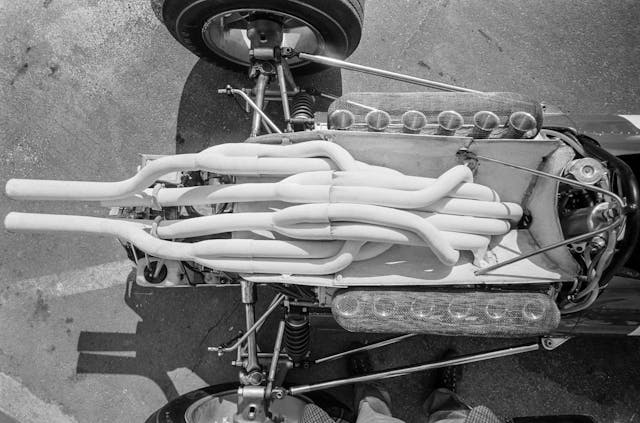
The famous coil of white pythons on the back of a Ferrari F1 car first appeared in 1966, when the rules doubled displacement to 3.0 liters and Ferrari was quick off the mark with its V-12–powered 312. The 1967 car, pictured here, was an improved version. Despite the heady power and wailing song from this Italian pipe organ, the season was a disaster, with the death of Lorenzo Bandini at Monaco and Chris Amon only managing fifth in the championship.
F50

It’s a gross understatement to say the F40 was a hard act to follow, but an open roadster with an F1-derived, naturally aspirated, 8500-rpm V-12 that could eat 60 mph in 3.8 seconds certainly managed. The 1995–97 F50 was a child of its moment, after speculators had driven Ferrari prices to the stratosphere and damaged the brand. Only 349 were made, all initially leased by application to prevent flipping. Rarely seen in the wild, the F50 birthed a whole new genre of limited-production, hyper-exotic supercars.
The Tifosi

Like the Roman Colosseum or Sophia Loren, Ferrari is an Italian icon that its people claim as their own. Ferrari helped resurrect Italy’s self-esteem after a devastating war, and without Ferrari, F1 would probably have ceased to exist long ago. When Ferrari wins, it’s a national holiday. When it loses, the recriminations are vicious. Unbridled passion is what sustains Ferrari—and also what makes it so Italian.
Sharknose

By 1961, when the FIA cut the engine displacement in F1 down to 1.5 liters, the sport was dominated by the small-fry British garage teams of Cooper and Lotus, which innovated with disc brakes, coil springs, and engines behind the driver. Ferrari finally responded with the rakish Tipo 156, a twin-nostril Brit hunter with a 120-degree V-6 that Phil Hill piloted to a fateful world championship.
Check out the Hagerty Media homepage so you don’t miss a single story, or better yet, bookmark it.
The post Galleria Della Ferrari: 18 images celebrating 75 years of the Prancing Horse appeared first on Hagerty Media.
]]>
There have been dozens of silver-bullet solutions to the automotive industry’s problems over the years. However, once manufacturers, the public, and the government realize that some solutions not only fail but perpetrate the same toxic phenomenon, they take swift action.
Just kidding.
Regulatory bodies are infamous for moving at an ambulatory pace when it comes to managing toxins. The latest example is leaded gasoline. You thought that stuff left the market in the ’70s? Well, 1970’s Clean Air Act did set a deadline for its elimination, but that same law left a few loopholes, including one that, despite the known effects of leaded gasoline, has permitted the stuff to remain commonplace.
It’s harmed entire generations of Americans, too.

A recent video from Engineering Explained on YouTube brought up this topic. Jason Fenske, the channel’s host, cherry-picked some interesting data from two studies that looked deep into how large-scale exposure to this developmental neurotoxin has impacted our health. In the short term, the symptoms are not good. In long run, they’re even worse. The metric to which you should pay attention is blood-lead level (BLL): According to a study published in October 2021, over half the U.S. population—53 percent, to be exact—has increased levels of lead in their bloodstream. Lead exposure and IQ are inversely related, so this means that over half of Americans have lost some degree of intellectual capacity.
The usefulness of lead in the transportation industry is well-documented. Lead was actually a fuel substitute when first brought to market. Internal-combustion engines run more efficiently and make more power when the octane rating of their fuel is higher. In period, the first suggestion to leverage this was to introduce ethanol—the very stuff so many despise today—into the gasoline formula, but the price of ethanol made the idea prohibitively expensive. Enter Thomas Midgley and his tetraethyl lead additive in 1921. By 1923, refineries were adding TEL to gasoline at a ratio of 1 gallon TEL to every 1260 gallons of gas. Thus began our destructive love affair with lead.



Even in the ’20s, lead’s effect on the human body was no secret. Workers at the DuPont facility that made TEL had hallucinations so regularly that the factory floor was known as the “house of butterflies.” (That is an extremely concentrated environment, though; today, there certainly aren’t areas where a normal person would be exposed like that.) Then we realized how tailpipe emissions worked. Unfortunately, it was too late for those born between 1951 and 1980, nearly all of whom have blood-lead levels above the Center for Disease Control’s (CDC) defined “toxic” amount of five micrograms per deciliter (μg/dL.)
The pre-boomer generation bore the brunt of lead exposure, but baby boomers didn’t fare much better. That generation suffered an average drop in IQ of 2.6 points, while those born between 1966 and 1970 likely lost 5.9. This same study found people born during that late-’60s timeframe whose blood-lead levels were as high as 25 μg/dL. (Again, literally any lead in the bloodstream is bad; the CDC simply set a reference line at 5 μg/dL. Five times a reference point that really means nothing because there should be no lead in the human bloodstream.)

When Richard Nixon signed the Clean Air Act into law in 1970, most considered the problem solved—after all, leaded gas was on the way out. Unfortunately, not until 1996 did lead or lead additives disappear from the gasoline Americans bought at the pump. Eventually the law bore fruit: Those born after the year 2000 show significantly lower amounts of lead in their bloodstream than in previous generations.
Interestingly, the average BBL of people born after 2000 is not zero. Why? A giant loophole in the Clean Air Act still allows the use of leaded gas.
Anyone familiar with fuels who is also into piston engines knows that aviation is the last bastion of leaded gas—and for good reason. The rules set forth by the Federal Aviation Administration are written in blood. Change isn’t accepted simply because someone thinks it’s a good idea; alterations are only made after methodical testing produces confirmed, dependable results. Planes cannot just fall out of the sky due to a seized engine or some fringe-case mechanical failure. Look into how planes are maintained and it’s easy to understand why flying cars will never be anything more than a fever dream for a few crazy folks. The masses can’t be bothered to look behind their cars when backing out of a parking spot, hence the rearview cameras required on all new vehicles since May of 2018. You expect them to do legit pre-flight checklists? Get outta here.

That “don’t change what isn’t broken” approach means that leaded fuel remains the standard choice for most recreational aircraft. The aviation community is entirely grounded in the tried-and-true. Many piston-powered planes produced today have designs that you could easily trace to the 1950s. Development rarely happens because the FAA’s certification process is so difficult and expensive. Add in the Boeing 737 MAX debacle, and the FAA is rightfully cautious. I agree that the FAA exists to create safe flying, and therefore understand the drawn-out process to approve these changes, but the FAA also has a responsibility to balance the safety of the persons in these small, piston-powered planes with the health of millions of persons on the ground. Hence why it started the EAGLE initiative earlier this year.
The Eliminate Aviation Gas Lead Emissions (EAGLE) program seems like a step in the right direction to further prioritize public health. The four-part plan falls apart pretty quickly, however, when you examine it from anything less than 10,000 feet. The first two steps are cited by the FAA as “industry led,” which is a cute way of kicking the can down the road. Developing the infrastructure required to make an honest effort to ditched leaded gas requires big money, money that would need to be invested by individuals or companies before the FAA would write policies about the use (or elimination) of leaded fuel or any alternatives. That dynamic alone discourages innovation, since otherwise-motivated companies have no assurance that the FAA will allow their investments to bear fruit.
To make the situation worse, a viable alternative to leaded gas already exists. Planes have been safely flying with it for 10 years—and the FAA has refused to take meaningful action in support of it.

General Aviation Modifications Incorporated (GAMI) has an unleaded 100-octane fuel (G100UL) whose supplemental type certification (STC) was only approved as of April 2022—and its use is still restricted to certain types of Lycoming-powered aircraft. The real struggle is that without wider approval from the FAA, access is basically null for anyone who wants to use the new G100UL fuel. To install a third pump (most airports only offer Jet-A and 100LL) at an airport requires a lot more than a tank and pump. The EPA would need to get involved, and the owner of the airport put up the money to make it all happen, all while hoping that this third option would sell at a volume that made it financially viable. There, too, G100UL faces an uphill battle: This leaded-gas alternative is projected to cost 60 to 85 cents more per gallon, as estimated by GAMI itself.
Yet this new fuel sits awaiting approval as the FAA pats itself on the back for trotting out the EAGLE program. The work is done, yet the progress that would help so many is stifled. It’s time for the FAA to move on the GAMI G100LL and other similar options rather than ordering another review by a technical advisory board, a requirement which GAMI has already sought and completed five times. Generations have lost reasoning ability due to lead exposure that continues to this day thanks to bureaucratic standards set forth in the name of safety. Whose safety?
The post Leaded gas lowered America’s IQ, and we’re still using it appeared first on Hagerty Media.
]]>
Going into this weekend’s British Grand Prix, Lewis Hamilton holds more than double the number of Nigel Mansell’s home grand prix wins. But the Birmingham born driver, now 68, recorded arguably the most dramatic British Grand Prix win ever seen. Let’s go back 35 years and remember how Mansell destroyed Piquet – and settled a score.
With just over three laps of the 1987 British Grand Prix to go, Nigel Mansell looked at the fuel readout inside the cramped confines of his Williams-Honda. The tank was showing empty but there were still nearly nine miles around the Silverstone circuit to go. He refocused on the red and white helmeted head in the car in front.
Sitting between the moustachioed Briton and his third win of the season was his team-mate, Nelson Piquet. The pair had a famously prickly relationship. The Brazilian, a double world champion cheese to Mansell’s chalk, once called his British rival’s wife “ugly” in a magazine interview. [He has since done much worse, during an interview about the championship battle between Hamilton and Verstappen, last year. Ed.]
In his autobiography Mansell later wrote: “That was out of order. I think it says an awful lot about the sort of person he is.” Punchy. Part of the problem the pair had was the Williams-Honda was the fastest car on the track in 1986 and ’87. Only a tire failure at the final race had taken the ’86 crown from Mansell and given it to Alain Prost.
In ’87, Nigel knew his FW11B car was even more dominant. Like Piquet it hadn’t taken him long to realize that his teammate was all that stood between him and that year’s title. And at the previous grand prix in France, Mansell had out-driven, out-thought, and outmaneuvered the Brazilian.
For his part, Piquet was determined to win his first race of 1987. Being in his rival’s backyard would make it all the sweeter.
The Brazilian’s efforts began well. He was quicker than Mansell for much of the weekend. That had culminated in pole position on Saturday which converted into the race lead 24 hours later.
Mansell had followed, staying a comfortable few seconds behind, the two Williams-Hondas leaving the other cars trailing. But Nigel’s home-win hopes hadn’t been helped when a wheel weight had flown off on lap 12. He’d maintained a steady gap to his team-mate but as his rubber wore, the vibrations began to affect the Briton’s vision.
On lap 35, Mansell blasted into the pits for new tires. The Williams mechanics changed all four wheels and sent Nigel on his way in 9.5 seconds, speedy for the time.
Such was the advantage enjoyed by the Williams-Honda that Mansell re-joined still in second place. But he was now 28 seconds behind Piquet with 29 laps remaining. Surely the best the British fans could hope for was to applaud their hero on the podium.
If many in the stands on that hot and sunny July day were thinking that, it hadn’t entered the mind of the man in the cockpit of Williams number 5. Mansell immediately started lapping quicker than he had done up to that point. Piquet responded and with 22 laps to go, he still had a handy 23 second lead. The race must be his now. Mustn’t it?
Again, no one had told Mansell, who was driving like a man possessed. His Williams-Honda was hitting every apex and exiting corners noticeably faster than anything else on the track. With 12 laps to go, the gap was down to 11.6 seconds.
At the same time, Piquet felt the life drain out of his tires. Manufacturer Goodyear had said they’d be good for a race distance. But they hadn’t banked on defending from a man whose tires had done half as many laps.
With 10 laps remaining, Mansell had the gap down to 7.6 seconds. He’d decided to run slightly less rear wing on his car than Piquet and this was about to prove decisive. With eight laps to go, Mansell put in the fastest lap of the race. The gap was down to 3.9 seconds and the excitement in the grandstands was reaching fever pitch.
Willed on by the increasing clamor of the 100,000-strong crowd, Nigel’s Williams closed up on the identical blue, white, and yellow car.
With three laps to go, he was 0.8 of a second behind Piquet. Nothing stood in the way of him and a famous victory now. Or did it? The fuel consumption read out for his Honda V6 turbo was now showing negative. “If it ran out of fuel, then so be it,” Mansell later said.
He put that to the back of his mind and soldiered on, tailing Piquet through Chapel Curve and onto the Hangar Straight. Sweating heavily in his red overalls Mansell’s focus remained laser-like.
Piquet covered the right of the track as the pair rushed up to Stowe corner so Mansell dummied left. The Brazilian responded enabling Mansell to fill the now-vacant space to his rival’s right and the corner was his. As they turned into Stowe, Piquet moved towards his team-mate, intimidating him at 190 mph.
They almost banged wheels. Almost. But nothing was going to deny Nigel that day. Or was it?
The crowd went wild to the point that Mansell could hear them from beneath his helmet. It did little to allay his fears as he reeled off the last couple of laps, knowing his engine was now sucking up the dregs in the fuel tank. Starting the last lap, the Honda hesitated agonizingly, but it kept going to the flag.

The superiority of the Williams cars and the ferocity of their battle had been such that Mansell and Piquet were a full lap ahead of the third-placed driver, a certain Ayrton Senna.
Two thirds of the way round the slowing down lap, Mansell’s Honda gave up for good, its final drops of Mobil race fuel exhausted. The stricken car was immediately engulfed by crowds of jubilant fans. A shell-shocked Piquet didn’t bother stopping to offer his nemesis a way out of the crush.
“When I crossed the line, the place erupted. Driving down the vast expanse of the Silverstone pit straight felt like walking into a small room on your birthday. I was overwhelmed by people power,” Mansell later recalled.
It was a mesmerizing drive and gave us a British Grand Prix that cemented the Brummie’s position as a full-on fans’ favorite.
The post Masterclass: When Nigel Mansell destroyed Nelson Piquet at the 1987 British Grand Prix appeared first on Hagerty Media.
]]>
Every car enthusiast knows that the Tin Lizzie put the world on wheels. Ford sold over 15 million Model Ts between 1908 and 1927, a volume topped only by VW’s Beetle. The 1932 Model 18 successor to the T is equally revered for delivering speed to showrooms. Ford’s new flathead V-8 armed working stiffs with 65 horsepower, enough to middle-finger Chevies and Plymouths of the day.
But what’s almost a CIA-grade secret is the great leap Ford accomplished between its Model T and Model 18. Momentarily bored by building cars, Henry and Edsel Ford launched commercial aviation with their aptly nicknamed Tin Goose. Though only 199 Tri-Motor aircraft were produced, Ford’s big bird was instrumental in lofting passengers, mail, and freight heavenward in the Roaring Twenties and Tough Thirties.
A Stout foundation

Ford ally Bill Stout was the jack of too many trades. He studied engineering at the University of Minnesota though illness caused him to miss the final exam needed to earn a degree. Undaunted, he served as the chief engineer for Packard’s aircraft division and later created the Stout Scarab precursor to Volkswagen’s passenger van.

During his lifetime, Stout was second only to Thomas Edison in the number of patents earned. He designed scores of model toys and covered automotive and aviation advancements for the Chicago Tribune and his own Aerial Age magazine. For years he employed the clever pen name Jack Knieff to shroud his identity. Stout’s credo—”simplicate and add lightness”—was cribbed by Colin Chapman in the 1950s.
During World War I, the global aircraft fleet consisted largely of open-cockpit biplanes with wood framing covered by fabric and reinforced with guy wires. Inspired by Fokker and Junkers’ advancements with metal construction and multiple engines shortly after the war, Stout designed and built what he called his Air Sedan in 1922.
Ford and Stout join forces

Thanks in part to Stout, the Fords became intrigued by the aviation business. When the company’s corporate charter was rewritten in 1919, a provision for aircraft manufacturing was added. At that time, dirigibles were considered the most practical form of air travel, so the Fords founded their Aircraft Development Corporation to pursue the manufacture of a lighter-than-air transporter made of metal.
Coincidentally, Ford’s material of choice was a new aluminum alloy called duralumin already in use by Stout. Formulated by the Aluminum Company of America (now Alcoa), this mix of aluminum, copper, manganese, and magnesium doubled ordinary aluminum’s tensile strength without increasing its weight.
Stout established the Metal Airplane Company in 1922 when a hundred Detroit industrialists were solicited to invest in his startup. Auto magnates Chrysler, Olds, Fisher, and Dodge and a dozen or so other investors took the bait.

In 1923, the Ford Motor Company’s chief engineer William Mayo paid Stout a visit to arrange a meeting with the Fords who were then producing two million Model Ts per year.
Hoping to retain control of his enterprise, Stout imposed a $1000 limit per investor. The wily Henry Ford was intrigued by the opportunity but sought a greater slice of Detroit’s newest enterprise. After a moment’s hesitation, he proposed a $2000 investment—$1000 from father and son. The shrewd Stout quickly agreed. When the news media caught wind, the senior Ford was quoted philosophizing that mass-produced aircraft would not only shorten distances between the globe’s citizens but also erase their misunderstandings.
Air sedan and air transport

Stout’s first all-metal plane was fitted with four seats. Initial tests were disappointing due to the Air Sedan’s modest 90 horsepower. Undaunted, Stout shared his thoughts with the Fords about the Air Sedan’s successor, dubbed Air Transport. This new high-wing, corrugated-duralumin aircraft, which was coded 2-AT, was powered by a single, 420-hp Liberty V-12. Its mission was transporting eight passengers or a ton of freight.
The Fords were sufficiently impressed to join other investors kicking in additional funds to keep Stout solvent. The 2-AT was christened Maiden Detroit, a play on the Made in Detroit label.
Despite two failed test flights, Stout’s 2-AT proved so airworthy that more than a thousand passengers reveled in joy rides in the summer of 1924. This rising enthusiasm for aviation underlined the need for a viable airport near Detroit. In pursuit of such a facility, Stout and a local dirigible manufacturer were invited to tour a 12,000-acre site the Fords owned in Dearborn.
The Blue Oval’s airport

Henry Ford offered to build Stout the world’s best landing field on property previously reserved for an employee subdivision. In addition to a pair of intersecting half-mile-long runways, Ford suggested construction of an adjoining factory for aircraft and dirigible construction. Following Stout’s eager acceptance of that proposal, Edsel Ford penned a Nation’s Business feature story declaring 1924 as the dawn of the aviation age.
The day following the Stout-Ford property inspection, hundreds of workers began reshaping the landscape with trucks and tractors. The senior Ford hired architects to design a sprawling factory and visited the construction site on a daily basis. Stout concluded his first sale—the Maiden Detroit to the U.S. Post Office for airmail transport—and the Ford Airport was officially dedicated in January 1925.
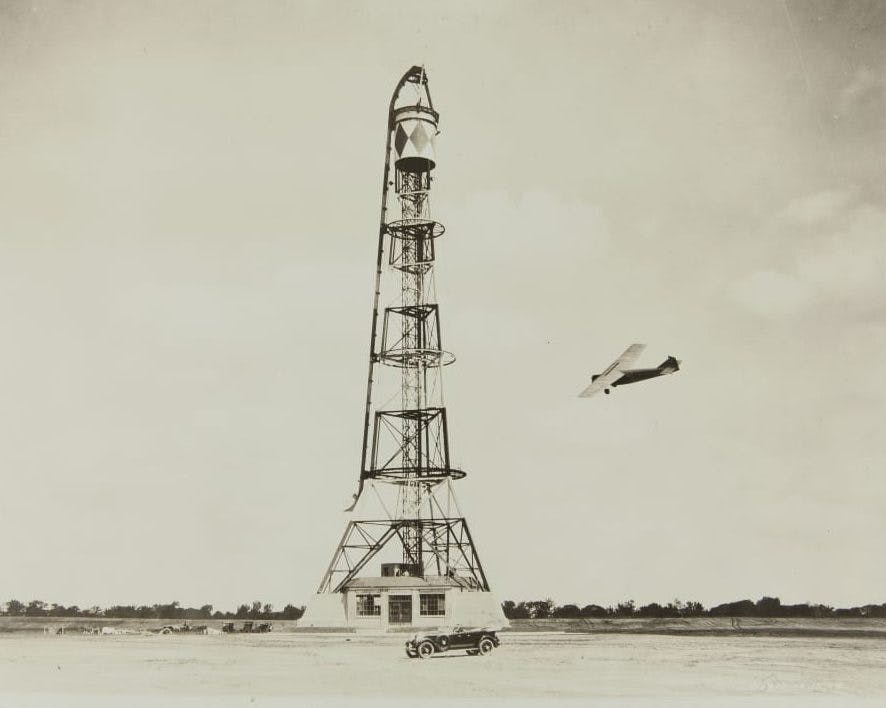

After constructing two grass runways, the Fords invested another $4 million in further improvements. Adding a dirigible mast, a passenger terminal, a restaurant, hotel accommodations, and concrete runway paving soon made this the world’s finest airport. With safe air travel as the goal, a weather bureau, traffic-control center, and radio communication office were also added. 70-foot-tall letters spelling FORD in white paint helped incoming flyers spot the airfield.

Ford’s 200-foot-long plant offered ample manufacturing space and offices for Stout engineers and executives. Stout christened the first 2-AT to roll of the line the Maiden Dearborn. Half a ton lighter than the typical car of the day, it had a 60-foot wingspan, a 46-foot length, and $20,000 price tag.
Ford takes over
More interested in operating an airline than manufacturing planes, Stout was immediately responsive to Ford’s take-over overtures. Cashing out other investors tried everyone’s patience but on July 31, 1925, Stout’s company became the Ford’s Metal Airplane division.
Three months earlier, Ford’s Air Transport Service had made its inaugural flight to Chicago carrying half a ton of freight. The round trip took five hours. Following the ship’s return, Edsel Ford reported to the press that the goal was not only carrying mail and freight between Ford plants but testing the company’s aviation advancements before carrying passengers. Round-trip service between Detroit and Cleveland commenced at the end of June.
Enter the Tri-Motor

Discussions with the U.S. Air Mail Service in Washington DC revealed that the 2-AT was deemed too large and cumbersome to efficiently carry mail. What was needed was a faster, multi-engine plane with the ability to fly through the night in adverse weather.
Stout, the Fords, and Ford chief engineer William Mayo agreed that a triple-engine plane was essential to progress. Luckily, the Wright Aeronautical Company had a new 200-hp, air-cooled, 9-cylinder radial ideally suited to their task. Three such engines were shipped to Dearborn and Stout begun designing another new plane. His game plan was to add two engines while retaining as much as possible of the 2-AT’s successful design.
By now, Henry Ford was more intrigued by aviation than by the car business. But when the Shenandoah dirigible crashed in September of 1925, killing all but one of the 41 passengers onboard, the Fords abandoned all hopes of manufacturing lighter-than-air craft to focus on Stout’s triple-engine design.
3-AT crashes and burns
Unfortunately, what Stout created was an ugly duckling. On its first test flight, the 3-AT lacked both stability and cruising speed. It couldn’t haul enough payload and was a handful to land. The two test pilots who flew it concurred that the design was a total bust.
Stout pleaded for time to develop his creation but the impatient Henry Ford had him banned from the design office. Overnight, trusted Ford engineer Harold Hicks became head of the airplane division while Stout remained on the payroll to promote Ford’s aviation interests.
Then a fire of suspicious origins wiped out the 3-AT prototype, all of Stout’s jigs and tools, four nearly finished 2-ATs, and the aircraft manufacturing building. Ford consoled Stout by noting: “It’s the best thing that could have happened. Now we can build the kind of factory we should have built in the first place.” Work immediately began to construct a three-times-larger factory and a 15-plane hangar.
Rising from the ashes
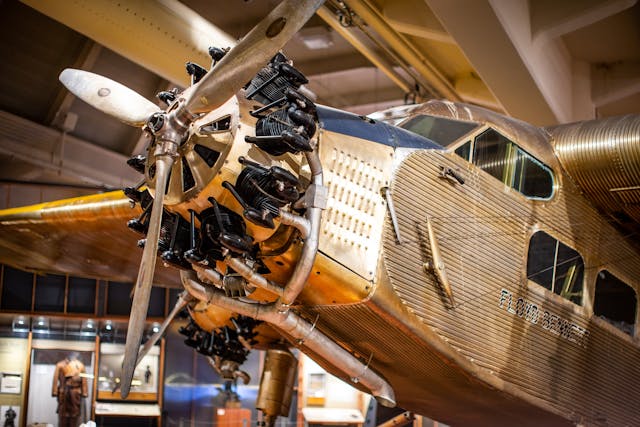
In June of 1926, barely six months after the $200,000 fire, a vastly improved 4-AT was ready for its test flight. The center engine was positioned low in the nose and the fuselage tapered elegantly towards the tail. A thicker wing spanned 74 feet and overall length was just under 50 feet making the Ford Tri-Motor the largest plane built in the U.S. to date. Like automobiles of the day, the 4-AT used interchangeable parts instead of far less-efficient handicraft construction.
After the initial test flight, pilot Major “Shorty” Schroeder rushed up to Henry. “This plane’s got what it takes!”





Boasting 600 total horsepower and a streamlined design with no exposed struts or guy wires, the 4-AT could top 120 mph and cruise over 100. It could carry 1725 pounds, climb at 900 feet per minute, and reach 15,000 feet of altitude. For corrosion resistance, its duralumin skin was clad on both sides by pure aluminum and coated with lacquer. Feeding this Alclad sheet material between rollers created the distinctive corrugations that increased the finished panel’s stiffness. Wing tanks carried 271 gallons of gasoline.
The cockpit provided dual pilot and copilot controls, excellent visibility, and Model T steering wheels atop the control sticks. Cables to the rudder and elevators were routed externally.

Separated from the cockpit by a bulkhead, the 450-cubic-foot passenger compartment was furnished with an entry door and eleven wicker-covered, aluminum-framed seats. Lacking sound proofing, early passengers described the din as “a hundred gremlins hammering a barn door.” Cotton earplugs were provided free of charge. While cabin heat, tray tables, and seat belts were not yet fitted, every passenger did enjoy a spectacular view through large shatterproof glass windows.

The Tri-Motor’s selling price was $50,000 including a full tank of fuel. No competitor could match its combination of size, performance, safety, and all-metal construction. The first public demonstration of the plane awed representatives from four U.S. airlines.
Ford’s new 60,000 square foot factory was completed in early 1927 with two parallel lines producing two planes per week. Within the first month of production, the company had 15 Tri-Motor orders in hand. Initial customers included the U.S. Navy, Standard Oil, and Texaco. Ford car dealers became sales agents, and the company established a pilot training school in Dearborn synched to aircraft deliveries. One Ford dealer operated 16 Tri-Motors transporting freight up and down the West Coast, an operation later bought out by TWA.

Stout Air Services bought six Tri-Motors to carry passengers between Detroit, Cleveland, and Chicago, charging $35 for a round trip from Detroit to Cleveland. That organization’s firsts included uniforms for flight attendants, hot coffee and sandwich meals, and limousine service connecting Detroit’s Book Cadillac hotel with the Ford airport.
In early 1927, a Tri-Motor flew from Dearborn to Dayton Ohio’s Wright Field guided solely by a radio beam operated by two Ford engineers. That technology was soon adopted by all airlines with Ford’s best wishes and no royalty fees.
Ford’s Air Transport Service became the world’s largest private airline by flying Model T parts and bulky manufacturing tools to car assembly plants around the Midwest.
Lucky Lindy comes to town

In May of 1927, Charles Lindbergh completed his flight across the Atlantic, giving aviation a major credibility boost. Three months later, when Lindbergh conducted his nationwide celebration tour with the Spirit of St. Louis, a second seat was fitted to that craft so that both Henry and Edsel Ford could enjoy their first flights over Dearborn.
Later that day, Lindbergh flew the Tri-Motor for an hour with the senior Ford again aboard and Ford’s chief pilot Harry Brooks serving as copilot. Ford likened the rides to going on a picnic, and said he wouldn’t mind taking a spin every day. But, except for one more flight several years later in a Douglas DC-3, Henry never again broke Earth’s surly bonds.
Aircraft business takes off

Contracts to fly mail by air on assigned routes for the U.S. Post Office prompted several airlines to purchase Tri-Motors beginning in 1927. Twenty-three new airlines were soon established to bid on airmail contracts and to fly executives and freight. There were 12 Tri-Motors sold that year followed by 39 more in 1928. The Ford factory was expanded to produce a plane a day.
As commercial aviation evolved from freight and mail service to passenger carrying, over 100 airlines ultimately flew Tri-Motors in the U.S., Canada, Mexico, Central America, China, and Australia. During their fruitful life, Tri-Motor advertisements bragged that “no Ford plane has yet worn out in service.” They successfully flew sightseers over the Grand Canyon for 65 years. In 1932, presidential candidate Franklin Roosevelt began replacing his whistle-stop train trips with Tri-Motor hops.
Epic expeditions
In 1929, a special Tri-Motor was prepared for Rear Admiral Richard Byrd’s first-ever visit to the South Pole. Alterations included a larger wingspan, a 525-hp Wright Cyclone center engine spinning a three-blade prop, and additional fuel capacity. Byrd and a crew of three flew 1600 miles in 18 hours in late November but had to dump 250 pounds of food to clear a 10,000-foot pass en route. After achieving its flyover, Byrd’s team left their plane in Antarctica to journey home. Five years later, Byrd returned to find his Tri-Motor snow-covered but otherwise in excellent condition. In 1935, the craft came home by boat and remains on display at Dearborn’s Henry Ford Museum.



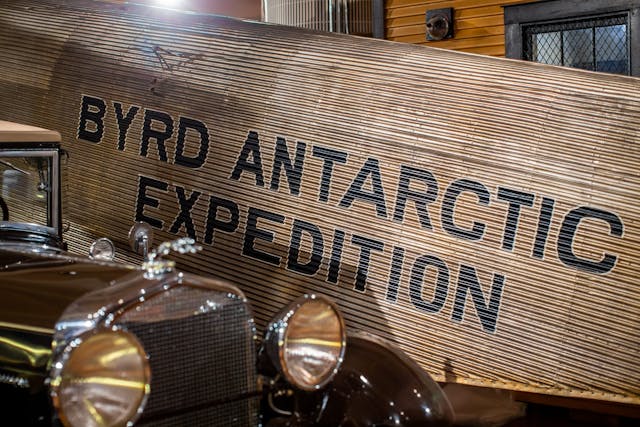
Continuing development
Over the years, Wright Whirlwind engine output rose from 200 to 300 horsepower, gradually improving the performance of the 79 4-AT Tri-Motors manufactured from 1926 through mid-1929. Following a suggestion from Lindbergh, Ford engineers redesigned the plane around new Pratt & Whitney Wasp engines developing 420 horsepower. The new 5-AT Tri-Motor was 1000 pounds heavier, 5 mph faster, and could carry twice the payload thanks to its longer fuselage.
Four distinct 5-AT generations were built from mid-1928 through mid-1933 with prices starting at $65,000, increasing the total Tri-Motor run to 199 planes, not counting experimental builds. Adding floats or skis expanded their service to otherwise inaccessible destinations. During World War II, the Flying Tigers successfully flew Ford Tri-Motors in Italy and China.

Ten Tri-Motors were purchased in 1929 by Transcontinental Air Transport to initiate coast-to-coast passenger service. Lindbergh lent his name to the enterprise which flew by day and used Pullman rail service and comfortable hotel rooms at night. A one-way trip cost $352.
Following rail service from New York to Columbus, Ohio, passengers flew to Waynoka, Oklahoma, with four intermediate stops followed by ground travel to Clovis, New Mexico. The final leg was via Ford Tri-Motor to the Los Angeles suburb of Glendale. Cruising speed was 100 mph, soaring over the rutted, single-lane mud roads below. The entire trip consisting of 2343 air miles and 970 rail miles took 48 hours, roughly half the time required by rail alone.
For reference, the first ever cross-country trip by car in 1903 took 63 days. When the paved Lincoln Highway opened a decade later, a trip across the country could be completed in as little as 20 days.
Flights of fancy
Henry Ford’s imaginative mind wandered in some unlikely directions. Convinced that 100-passenger seating capacity would be necessary to make scheduled service practical, he had Ford engineers investigate a six-engine craft boasting 6000 horsepower, a 125-mph cruising speed, and 700 miles of range. At the opposite end of the spectrum, his tiny single-seat “flivver” was aimed at inexpensive commuter travel. Lindbergh, who barely fit in an experimental example, did succeed in flying it briefly.


Ford’s chief pilot and close friend Harry Brooks broke the distance record for small planes in the flivver. Unfortunately, he disappeared off the Florida coast in February 1928 after the engine in his aircraft sputtered. That loss prompted Henry Ford to abandon his pursuit of a Model T for the air.
Endgame
In the fall of 1929, the Wall Street crash triggered the Great Depression, driving customers contemplating the purchase of an expensive aircraft into hiding. Except for a few planes sold to the U.S. Army Air Corps and the Marine Corps, sales were bleak. Government subsidies kept the major airlines alive by paying them to fly mail and passengers over long distances. Small airlines were quickly purchased by the majors resulting in conglomerates such as TWA.

The last Tri-Motor was finally built in mid-1933 for Pan American Airways. At this juncture, the car side of the business was equally dismal. Ford’s hot V-8 struggled to draw customers into showrooms, achieving barely 300,000 sales per annum. Ford’s seven-year Tri-Motor production run quietly ended, in large part because it was never a profitable enterprise. The 1932 books recorded a net loss over $5 million.
Once the global economy finally settled down, Boeing and Douglas took over as the dominant aircraft manufacturers with 247s, DC-1s, -2s, and -3s. James McDonnell, who later established the McDonnell Douglas combine, learned the ropes of the aviation business as a fresh-out-of-MIT Ford/Stout engineer.
The Tri-Motor was the first practical, modern commercial aircraft. It was instrumental in carrying freight, mail, and passengers in relative comfort. The Ford Airport was the prototype of all subsequent fixed-base operations. The Ford Motor Company convinced Americans that aviation was both safe and dependable.
Postscript
Henry and Edsel Ford did enjoy one more aviation fling. During World War II, they constructed 8685 4-engine B-24 bombers in a huge plant they built on farmland 18 miles due west of the company’s Dearborn headquarters.








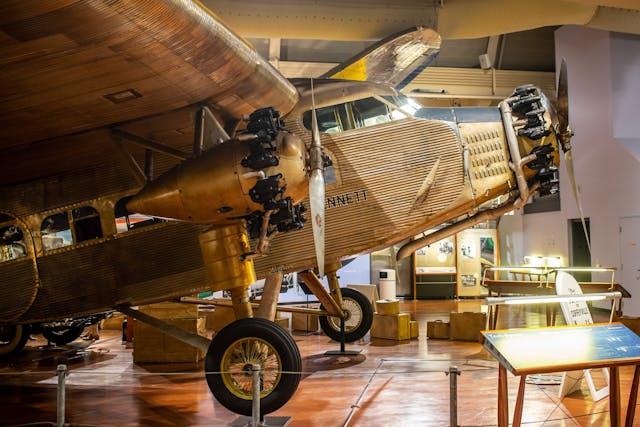



The post Tri-Motor: When Ford gave the world wings appeared first on Hagerty Media.
]]>
The Lincoln Motor Company is celebrating its 100th anniversary with events around the world, showing its past alongside its present and future. It’s a power move from the less-than-Lexian brand, because very few automakers can pull off this level of provenance. For its local, Michigan audience, Lincoln opened up its Dearborn archives for members of the media, much like what Ford did for the Bronco back in 2020. The program’s curators call it the Lincoln Archive Experience, and they’ve truly unearthed some gems for us to behold.
But first, a suggestion: Consider this a supplement to our “Missed the Mark” primer on a century of Lincoln vehicles, please read that first to get the whole picture of the brand’s history. When you’re up to speed on 100 102 years of Lincoln automotive annals, feast your eyes on what the folks in Dearborn had for us.






Unlike future vehicles from the brand, the V-8–powered Model L overtly prioritized engineering excellence over a flashy design, as the young startup didn’t have quite the cash/customer loyalty of Duesenberg, Rolls-Royce, and the like. This meant no fancy chrome grille and no custom coachbuilding from bespoke craftsman. Still, even in those turbulent start-up times, Lincoln made 834 Model Ls roughly two years before Henry Ford purchased the lot and banished founder Henry Leland from its ranks.
This particular Model L was made during Ford’s tenure before it was gifted to Thomas Edison, and it currently belongs to The Henry Ford collection. The swag table associated with this Lincoln was a curated collection of 1922-and-up memorabilia, including the purchase documents (previously seen in our primer) from Henry Leland, the greyhound mascot, and the 1922+ grille emblem representing both the Lincoln and Ford brands.

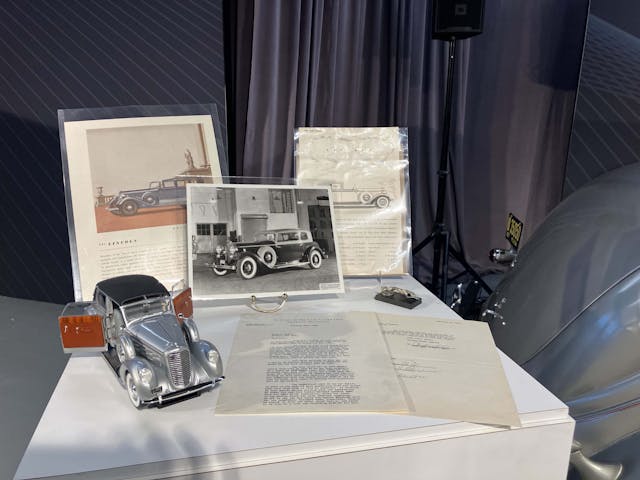

The 1931 through ’40 Lincoln Model K was an excellent representation of a luxury car of the 1930s, doing battle with Packards, Pierce-Arrows, Duesenbergs, and, of course, the Cadillacs of the company’s post-Henry Leland, post-Henry Ford Company era. The V-8 soon gave way to a series of class-appropriate V-12s (sometimes denoted with a KB, depending on year), which earned them praise from power players on both sides of the law. The usual suspects of the custom coachbuilding world also built bodies for the K, KA, and KB Lincolns, giving the brand the prestige it so deserved in this era.
The swag table for this 1937 Model K featured a Yat Ming 1:18th scale die-cast, PR photos, advertising/marketing materials, a pewter Lincoln greyhound mascot, and a letter from Lincoln that formalized its relationship with Brunn & Company. No doubt that letter of intent was chosen because this Model K (on loan from The Henry Ford) also featured a Brunn & Co. body. Nice touch!



As noted in our previous coverage, the Lincoln Zephyr was a successful implementation of Streamline Moderne design, ushering in a new era of luxury vehicle with factory coachwork that beat (rivaled?) the bespoke builders and a new unitized frame. This example from 1936 is on loan from the Gilmore Museum and is notable because it is a 2-door sedan and not the Business Coupe that every customizer turns into hot rod.
The swag table sported a Precision 100 1:18th scale die-cast Business Coupe and an odd smattering of Lincoln information that would be a stretch to call even tangentially connected to the Zephyr. While avoiding connections to the regrettable 2006 Zephyr-Fusion luxury sedan is a good idea, choosing the sales brochure for a 1995 Lincoln Continental is rather perplexing.








The main gallery had what might be the pièce de résistance of the collection: Edsel Ford’s personal 1941 Continental. While Edsel technically owned the prototype (1939) Continental fashioned to be a show/concept car before such terms were commonplace, this ’41 is a production model that belongs to The Henry Ford’s collection. Speaking of this museum, they suggest that the original concept was destroyed, so it’s a safe bet that Edsel’s affection for this production model was strong.
The Continental came with a series of artifacts giving rare insight into Edsel Ford the artist. I had never seen Edsel’s fine art in person before, and his charcoal rendering of a still life (pot and vase) proves what the history books have always suggested: Edsel was a far, far different person than his father, Henry Ford. Edsel’s portrait, painted by Diego Rivera, hangs a few feet away from the 1941 Continental and is reported to be the only work of the famous artist that didn’t show the automotive industry from the perspective of hard labor and assembly line automation (see: his massive Detroit Industry Murals in the Rivera Court of the Detroit Institute of Arts).




While the 1939 Continental was a show car intended for a very small audience (i.e., only Edsel’s friends as he vacationed in Florida) the 1953 Lincoln X-100 was Ford’s first official concept car intended to wow auto-show attendees in the same way as the vehicles present in General Motors’ Motorama. The X-100 coincided with Ford’s 50th Anniversary, and featured cutting edge innovations like heated seats, a panoramic power sunroof, and an in-car telephone. Perhaps it was William Clay Ford who ensured the X-100’s themes didn’t make production, as the understated 1956 Continental Mark II instead made the cut. The X-100’s swag table included promotional material, including a press release.








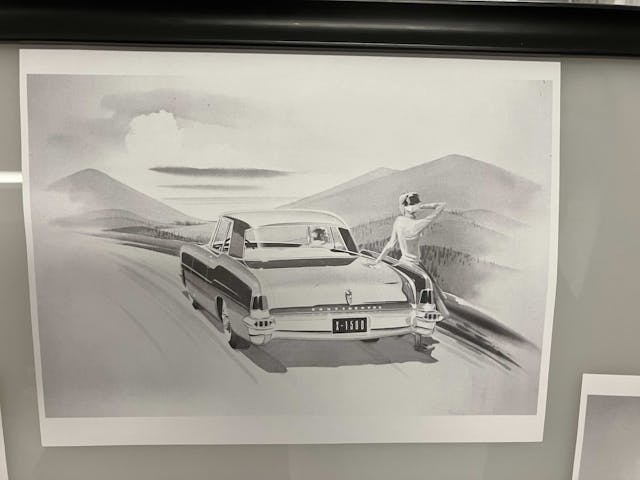

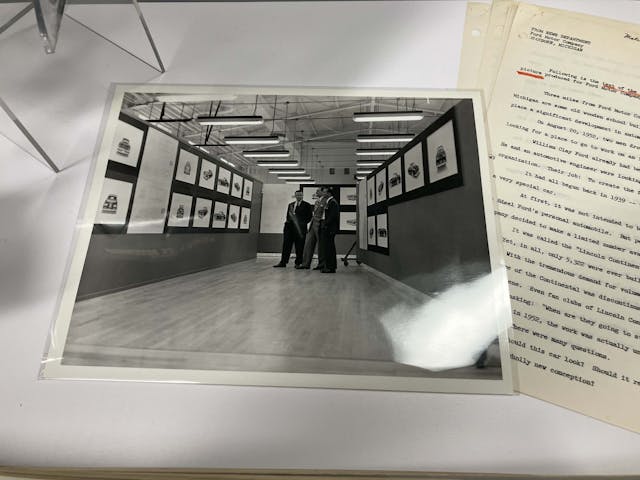
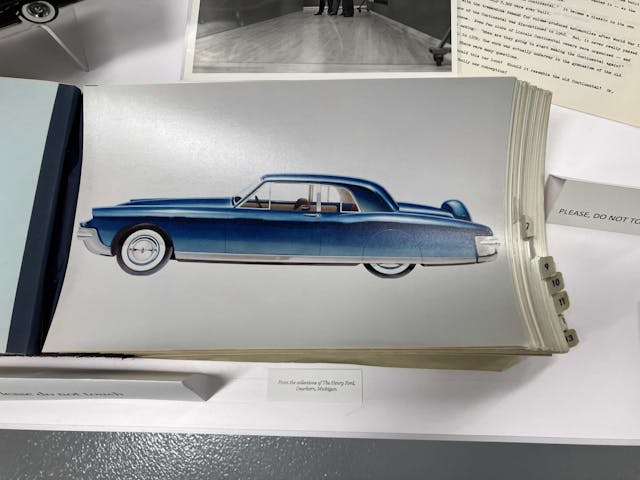





The historical significance of the 1956 through ’57 Continental Mark II cannot be understated for the Lincoln brand. That said, it has been discussed at length in previous articles, so instead enjoy these photos of this example, borrowed from a private collection, and all the historical items that led to the creation of this car (and the standalone Continental Division behind it) displayed alongside it.

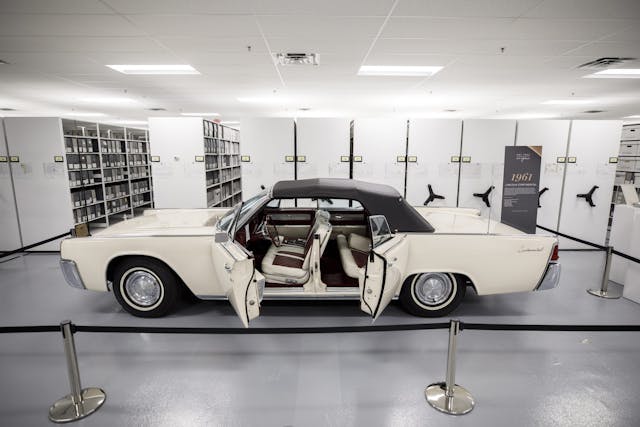



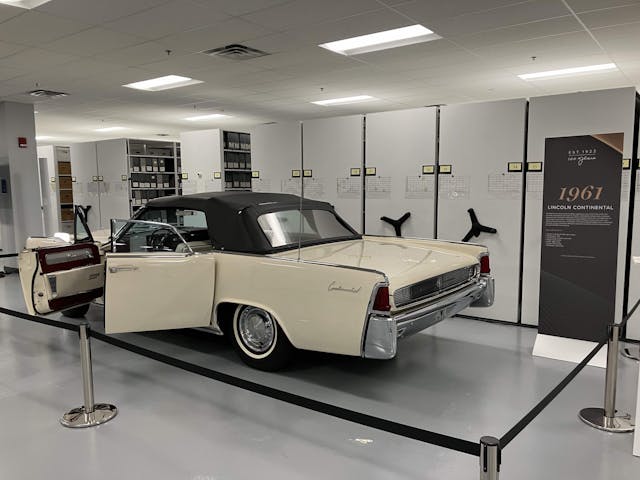








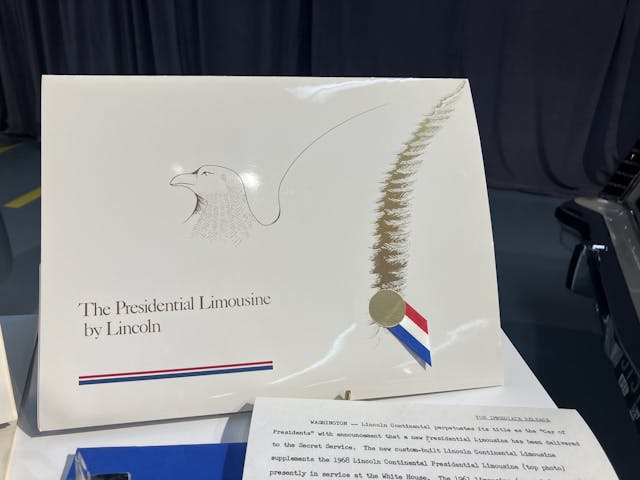

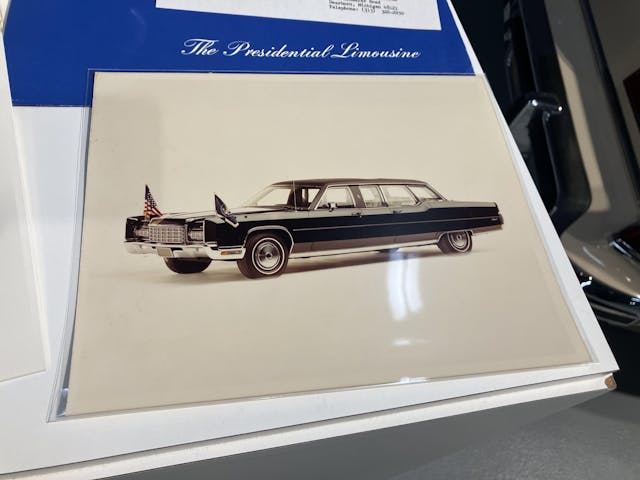
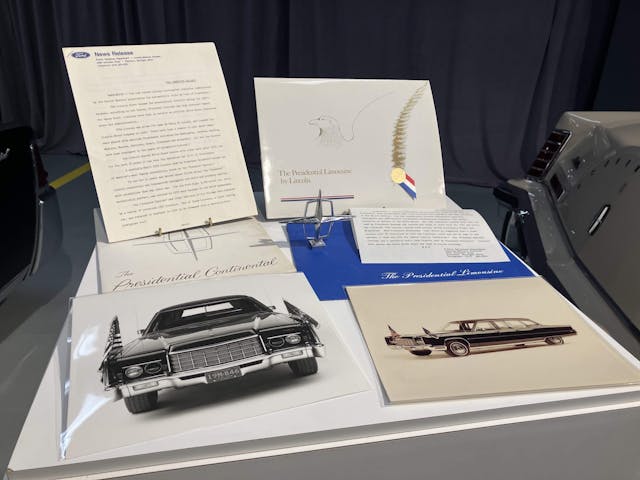
To cover Lincoln’s fabulous 1961 through ’69 Continentals, we were treated to a 1961 Continental convertible (on loan from the Gilmore Museum) and a 1964 Lehmann-Peterson stretch limousine (from The Henry Ford) used by the Pope in a 1965 visit to New York City. Again, we’ve gone into painful detail in our Continental buyer’s guide, so please enjoy the photos of the vehicles and the supporting documents. They include PR materials for the Presidential limousine, marketing/press materials from the first year, and even a feasibility study of the Continental’s now famous “coach doors” paired with a pillarless hardtop design.
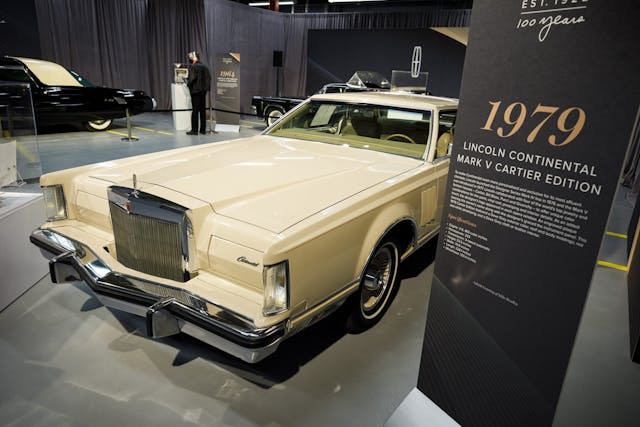








Apparently enough time has passed that the once-infamous Malaise Era of automotive design has now become palatable for everyone, whether the favorable reflections occur online or in a curated exhibit from an OEM. Considering Lincoln’s sales successes (the Continental Mark V was the best-selling Mark Series) and cultural relevance (every TV/movie “bad guy” of the era was driven in a black Town Car) this 1979 Continental Mark V Cartier designer edition (from a private collection) is the last year of peak luxury from Lincoln. The swag table associated with the pinnacle of American personal luxury even included a letter from the folks at Cartier, all the way back in 1926!
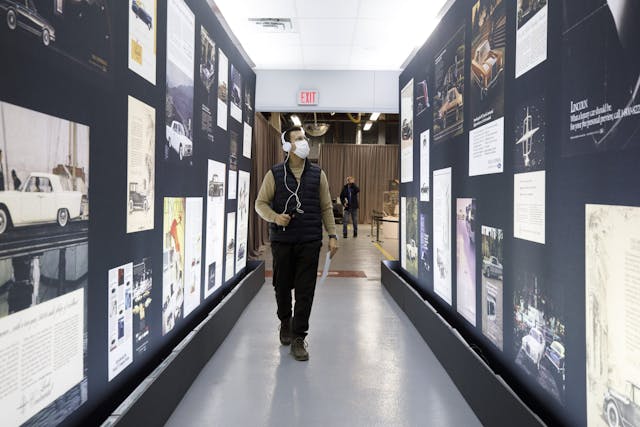
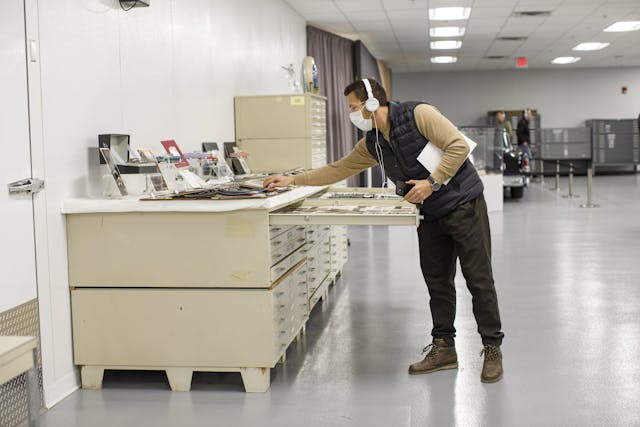

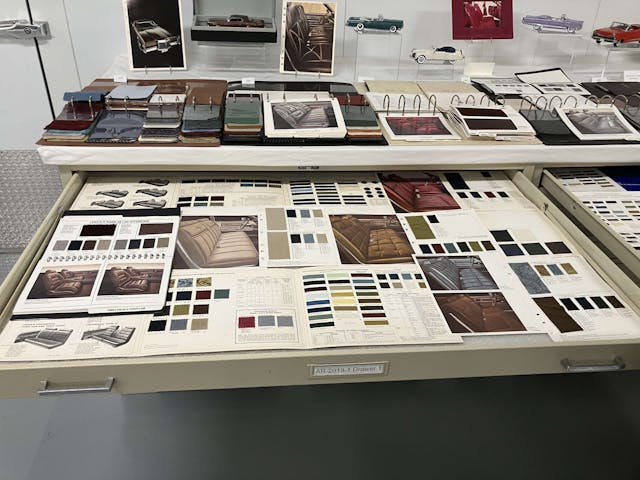













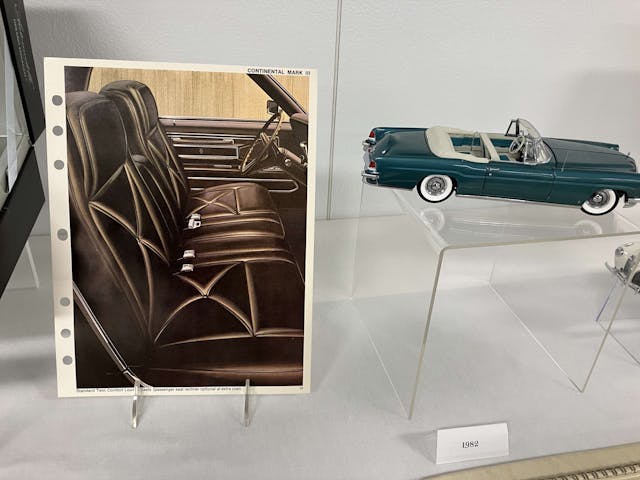


See above for a few more displays of Lincoln memorabilia: While some of this is readily available from collectors on eBay, there are plenty of items I’ve never seen online. The combination of all these items was rather stunning—almost as impressive as the secret stash of vintage renderings the kind folks at Lincoln presented to us in a museum-quality setting. Those works of art are seen below.








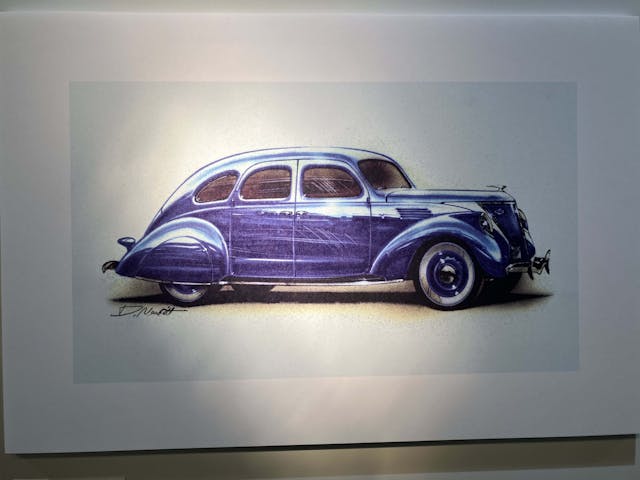






















The Lincoln Archive Experience was loaded with surprise and delight, for just about every decade in the brand’s history. Even better, Lincoln offered up a guided tour from Robert Gelardi, Lincoln’s chief interior designer. His insight into the future of the Lincoln brand, complete with renderings of electrified vehicles we may see in the next few years, was a rare treat. But “rare treat” is an understatement on a personal level, as a kid who got into cars because of one particular example, and never stopped soaking up all things Lincoln ever since.
I literally felt like a kid in a candy store. The Lincoln Archive Experience opened up memories, brought new insight, and delighted my senses to the point where I felt child-like joy. It was something I haven’t felt in decades. That said, if you’ll forgive the unprofessional camera-phone nature of this unedited video below, enjoy part of the tour with Mr. Gelardi’s insight in the background. It truly proves that a video speaks … well, a whole lot more than a thousand words.
The post Unearthing historical delights within the “Lincoln Archive Experience” appeared first on Hagerty Media.
]]>
A few interesting if largely useless statistics for you: 15,007,034 Volkswagen Type 1 Beetles lined bumper-to-bumper would stretch almost 38,036 miles or 61,214 kilometers.
As well as being a hell of a traffic jam, the line would encircle the equator one and a half times, though that distance would still be just 16 percent of the way to the moon. There would be logistical issues with either, so let’s just assume we’re talking in hypotheticals here …
At the top speed of a 1972 Beetle 1200, 71 mph, it would take about 536 hours of continuous driving to cover that distance—ignoring time taken for fuel stops—or a hard-driven 22 days (though with the Beetle’s legendary reliability even flat out, the car would undoubtedly handle it better than the driver would).

That said, you’d need to factor in servicing too, and by the time the Beetle at the back of the line had reached the front, it’d have visited dealerships six times to keep up with its 6000-mile service intervals and be around a third the way to its seventh service.
It would do all of this, though, with greater ease than the vehicle it had overtaken on February 17, 1972, to become the most-produced car of all time: the Ford Model T.
That’s not to take anything away from the Ford. At 34 years, Beetle production had taken quite a while to catch up to the Tin Lizzie’s figure, set in a remarkable 19 years. That alone showed just how astonishingly successful the Model T had been in the first third of the 21st century.
In fairness, Beetle production had only started in earnest in 1946, so the bulk of that 15 million left Wolfsburg, Brazil, Mexico, Australia and South Africa in the span of 26 years. But when that 15,007,034th Beetle left the line in 1972, Volkswagen paid rightful reverence to the car it had surpassed, featuring the T in its celebrations and advertisements.

What few could have anticipated in 1972 was just how many more Beetles would be built. The car’s sales were already in decline by the 1970s as more modern designs out-competed it, and in 1974 Wolfsburg production switched over to the car’s nominal replacement, the water-cooled, front-wheel drive Golf.
German production ticked along until 1978, with Brazil and Mexico taking over the bulk of production from that point. But while the Beetle fizzled out of Europe into the 1980s, it just kept on puttering along in these South American markets, and by the time the final Beetle left the Puebla line in Mexico in July 2003, the final tally was in: 21,529,464.
Toyota has built more than 50 million Corollas, long ago eclipsing Volkswagen’s total. But unlike either Ford or Volkswagen, numerous completely new and different models have worn the Corolla badge since 1966. It’s unlikely the Beetle’s single-model tally will ever be beaten.

The post On This Day: VW Beetle surpasses Model T as the most produced car in history appeared first on Hagerty Media.
]]>
In the period immediately after the second World War, the vast forests and mountains of the Pacific Northwest were ripe for exploring. They are still so today, veined by thousands of miles of forest service roads and backwoods trails, filled with mountains, trees, deer, and the odd quizzical bear. In such an environment, the mighty Dodge Power Wagon proved the ideal tool for many a forester and frontiersman. However, some thought even its capable four-wheel-drive system needed a twist.
This big beast, still wearing the patina of a hard-working life, is that twist. Literally. Just aft of the cab, its frame has been bisected, the cut rejoined with a clever hinge called the Willock Swivel Frame. With Canadian patents dating back to 1944, the Willock was a simple yet ingenious idea that worked well enough to be fitted onto roughly forty Power Wagons (and an unknown number of heavier trucks) over the years. About a dozen survive.
This one, a 1953 model which you can see exhibited at Los Angeles’ Petersen Automotive Museum until late April, belongs to Jonas Smith, who lives in rural Washington. He uses it properly.
“When [The Petersen] called, I told them it was far from perfect and that I still had half a cord of firewood in the bed. They said that’s exactly what they were looking for—I told them, great, but you don’t get the firewood.”

Smith is currently the custodian of two Power Wagons and figures he’s owned about thirty over the years. Originally a fan of early Jeeps, he spotted one of the big Dodges while on an off-road expedition.
“I was just done,” he said, later adding, “They’re like potato chips. You can’t just have one.”
A Power Wagon makes for a thickly sliced, kettle-cooked crisp. Descended from the military-spec trucks that Dodge built to support the Allied armies, the enclosed-cab, 1-ton civilian version was one of the first four-wheel-drive trucks available to the public. It wasn’t exactly quick, but its 94-hp, 230 cubic-inch straight-six was durable. The Power Wagon had earned a reputation for toughness in the field, and ex-servicemen who knew its virtues well helped convince Dodge to bring it to market.
Equipped with a deep-sided, eight-foot box, the Power Wagon could carry pretty much anything to pretty much anywhere. However, these were the days before locking differentials became commonplace, and Power Wagons could find themselves teetering over uneven terrain with a couple of wheels in the air, spinning uselessly.

The Willock solution looks crazy, but it works. There’s little documentation on its original inventor, Harry Edward Willock, but if you wanted the company’s swivel technology installed in your truck in the 1950s, you could head down to West 2nd Avenue in North Vancouver. The Willock Truck Company claimed that its device extended the life of a working truck and “saved operator fatigue.”
The technology was originally applied to heavy two-wheel-drive trucks used in tropical sugar cane fields of the Philippines. Over time, constant flexing combined with the warm, wet climate opened cracks in the frame, sending a truck to the scrapyard prematurely. A Willock swivel made such flexing friction-free and preserved the trucks’ working lives.

Back in the equally damp but more chilly Pacific Northwest, the Willock swivel suited the Power Wagon well, giving it the chance to put down power no matter how broken the terrain. The B.C. Forestry Service used these articulated beasts, and some made way south of the border. Energy companies used the customized Power Wagons as refueling vehicles when cutting paths for power lines, since they were one of the few designs that could keep up with the Caterpillar excavators.
The swiveling design is brutally simple. The truck frame is cut in half, and then two enormous crossmembers are welded in. The bushings for the swivel are bronze, with brass sleeves and clever lubrication to resist corrosion. Because the swivel was designed for trucks larger than the 1-ton segment, it looks like it could hold two halves of a container ship together. In a Power Wagon application, the rebuilt spine was reportedly very reliable. The modification would set you back $350.

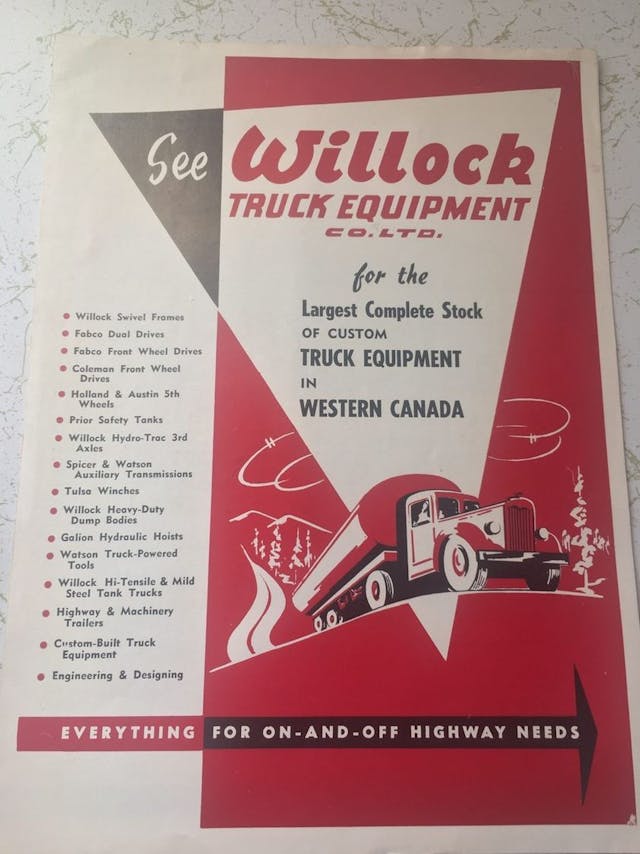

Why can’t you get a Willock Swivel in your 2022 Ford Raptor? The march of technology, for one, and a few pesky safety concerns. Smith reports that the swivel has an unlimited range of motion, and the driver has little seat-of-the-pants feel of where the load sits in the bed. With a heavy enough burden, on uneven ground, the whole thing might flip.
Further, the Willock doesn’t come with any way to lock the center joint in place once you trundle onto more civilized roads. Smith added some limiting chains for safety and has tested out his Power Wagon in Hollister, California. It’s the same venue used to host the Top Truck Challenge, and it’s also where Smith discovered the Willock swivel’s Achilles’ heel.
Smith often tests out various off-roading upgrades. One of his Power Wagons is basically a rolling laboratory for modern solutions on a vintage truck. He had fitted locking differentials to the Willock truck for the test and reports that the two technologies didn’t mesh—the rear end of the truck developed some disturbing behavior.

As locking differentials became more common in four-wheel-drive trucks, customers found that it was far easier to lock their trucks’ axles than make an appointment to have their vehicles cut in half. Even so, there are reports of swivel-equipped Fords being used into the 1970s, and the last filings of the Willock company itself end sometime in the mid-1980s.
Despite his familiarity with the Power Wagon breed, Smith had never seen a Willock-equipped truck before he stumbled across this yellow 1953 model. The swivel had been welded closed at some point in its life, and the current owner was unfamiliar with what its function, assuming the joint was simply a botched repair to an old truck.

Since restoring the swivel’s range of motion, Smith says he’s seen two other Willock-converted trucks in person. The Power Wagon community guesses about a dozen survive. There are also a handful of other swivel-equipped trucks from other manufacturers lurking in the stranger corners of the pickup world, but the Willock company appears to be the earliest producer of the heaviest-duty design, and the percentage of Willock-modified trucks that remain today is testament to its robust build quality. The aftermarket—and manufacturers—have since found better and safer ways to improve off-road performance, but, decades later, they’re tapping into the same creative spirit that birthed the wild, center-hinged Power Wagon.

The post The Willock Swivel put a (literal) twist on Dodge’s Power Wagon appeared first on Hagerty Media.
]]>
This was day one for the Mazda MX-5. Not for Mazda itself, nor the engineers who had spent most of the past decade tirelessly working on Mazda’s new roadster project, nor for journalist Bob Hall, whose meeting with Kenichi Yamamoto, head of Mazda’s R&D department at the time, had taken place all the way back in 1978.
But the Chicago auto show on February 9, 1989, marked day one for a model line that has sold more than a million units in 33 years, making it the world’s most popular roadster. It was day one for the roadster boom of the 1990s, that brought us everything from the MGF to Boxsters, Z3Ms, and the Lotus Elise. And it was day one for a craze that saw waiting lists and people on the street offering to buy the press cars from journalists testing them in the early days.
The MX-5, dubbed Miata in the U.S., could so easily have been overshadowed in Chicago that year. Across the hall was a rather more voluptuous sports car from Chrysler, the Dodge Viper Concept, which finally went into production in 1991. Closer to home, at least for Mazda, was the Honda NS-X, also previewed in prototype form (and prior to ditching the hyphen in its name), which would launch the following year.


But Bob Hall’s assertion in 1978 that there would be a market for a bugs-in-the-teeth, affordable sports car had been spot-on, and the engineers that had insisted upon a traditional front-engined, rear-wheel drive layout—chosen over front-wheel drive and mid-engined proposals—similarly accurate.
The credit for both the styling and the MX-5’s layout goes largely to Mazda’s North American studio. The team had carefully seeded the mothership in Japan with old Elans and Spitfires to convince the suits that a back-to-basics sports car would be worth the effort, particularly as the RX-7 already satiated demand for something more advanced and expensive. It was only right that car would be launched in the United States, particularly as this was likely to be its largest market too.
Mazda presented three production models at the show, appropriately colored red, white, and blue. The latter, named Mariner Blue, has perhaps the most interesting story: Bob Hall wanted the option of a French racing blue, and designer Tom Matano mixed one that replicated exactly California’s rear license plate color at the time.
A shame, really, that U.K. examples would be lumbered with an ugly yellow rear plate—at least until the appropriately-named California special edition arrived, in Sunburst Yellow, in 1995.

Mazda did actually have a yellow MX-5 Miata on its Chicago stand, too, the wide-arched Club Racer concept. Based on a preproduction model, it had a handful of subtle differences to the production cars sitting nearby (aside from the obvious), but previewed a taste for modification that MX-5 enthusiasts have never lost.
Mazda still owns the car in its US. .collection, alongside those three motor show stars—the white example of which, incidentally, later became the world’s first race-prepared MX-5.
The post On This Day: The OG Miata kicks off ’90s roadster craze appeared first on Hagerty Media.
]]>
New Year’s Day is well in our rearview mirrors, but for many parts of the world, winter is far from over. Whether you’re enjoying a balmy California day or sheltering from a Northeastern blizzard, the cooler seasons are a perfect time to discover the many unexpected ways that industrial design shapes our lives. Here are four fireside-worthy tales (each available on Amazon) of men and women whose influence extends far beyond the automotive sector—and far beyond the time period in which they sketched.

Industrial Strength Design: How Brooks Stevens Shaped Your World
In the postwar decades, industrial designer Brooks Stevens’s instincts permeated multiple business sectors with ease and fluidity. If you like your peanut butter out of a wide-mouth jar, thank Stevens for the idea. Ditto for sporty Evinrude outboard boat motors, a clothes dryer with a clever window in front, and the 1958 Oscar Mayer Wienermobile, too. Spanning 300 pages and featuring 267 color and black-and-white images, Industrial Strength Design also covers his original Jeep Wagoneer design, Studebaker’s Gran Turismo Hawk coupe, and even the Skytop Lounge train. Stevens was so into the future, he popularized the term “planned obsolescence.” $28 from amazon.com

Damsels in Design: Women Pioneers in the Automotive Industry, 1939–1959
If you’re a woman who gets cars, industrial art, and boardroom brawn, you might have the tenacity possessed by the “damsels of design” in Detroit in the mid-20th century. For exceptional women like Helene Rother, contributing to the form and function of products built by American automakers was not only essential, but precedential. For instance, Rother—a veteran designer at GM, Miller-Meteor, and Nash—is credited with leading Cadillac’s instrument panel and seat construction during its midcentury heyday. She and many others populate this 192-page reference book, which also includes profiles of female designers at Ford, Packard, Studebaker, and Tucker. $35 from amazon.com
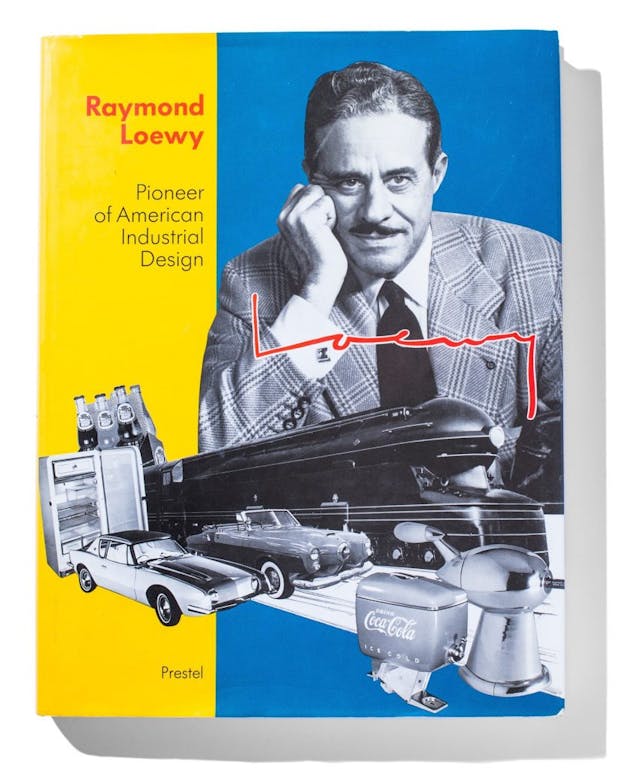
Raymond Loewy: Pioneer of American Industrial Design
Next summer, when you’re enjoying an icy bottle of Coca-Cola while driving a Studebaker Avanti to the bus station for a Greyhound Scenicruiser tour, think of industrial designer Raymond Loewy—mastermind of all three iconic shapes. The French-born Loewy was prolific; during a career lasting until age 87, he designed the Shell Oil Co. logo and the presidential Air Force One graphics. A substantial 262-page hardcover book measuring 9.5 inches by 12.25 inches, Raymond Loewy: Pioneer of American Industrial Design will open your mind to 20th-century American design generally, and Loewy’s genius in particular. $67 from amazon.com

Tom Tjaarda: Master of Proportions
Sized like a burly ream of copy paper, this new book on Detroit-born designer Tom Tjaarda boasts 474 pages, is a bountiful 8.5 inches by 12 inches, and weighs a whopping 5.35 pounds. Master of Proportions chronicles the life of the designer of the Ferrari 330 GT 2+2, the DeTomaso Pantera, the Fiat 124 Sport Spider, the Aston Martin Lagonda Coupe, and the utilitarian Ford Fiesta. Abundantly illustrated, the book traces how Tjaarda, after a Motor City upbringing, moved to Turin—then considered the epicenter of European automotive design—and emphatically made his mark. $150 from amazon.com
The post 4 fireside-worthy books about the men and women who designed our world appeared first on Hagerty Media.
]]>
29 January 1886 – Karl Benz files the patent for his 1886 Motorwagen
The car started here. Well, one of them did. Several vehicles have been unearthed over the years that predated Karl Benz’s Patent-Motorwagen of 1886, but the idea of a self-propelled vehicle powered by an internal combustion engine with electric ignition—a car, by any other name—was exactly what Karl Benz submitted to the Imperial Patent Office in Berlin.
“The present construction is intended mainly for the operation of light carts and small boats, such as are used to transport one to four persons,” reads the text accompanying the patent images. “The driving power is provided by a small gas engine… the engine cylinder is kept at a steady temperature by the evaporation of water.”
Diagrams show the spindly car’s primary elements, free of the embellishments that would decorate the prototype, illustrating the vehicle’s three-wheeled layout, its massive flywheel, and its rear-mounted engine.

Other figures in the patent listing detail the engine itself, the mechanism for starting and stopping the Motorwagen, and the mechanism for cooling the single cylinder—though Benz was clear to point out that he was patenting neither the engine nor the cooler itself.
The wording goes on, noting the tube frame construction of the chassis—described as a carriage frame, the most relevant reference to other transportation of the era—and that the “gas used to supply the motorengine [sic] is generated from naphtha or any similar or suitable light hydrocarbon.”
Benz goes on to describe how the flywheel, such a feature of the Motorwagen, is in the best position for both control of the vehicle, while low enough to ensure decent stability, and how the drive system works—moving the Motorwagen from rest meant pushing on a lever, which engaged a leather belt between the engine and the pulley that drove the rear axle via chains.

That same pulley operates the brake—pulling the lever in the opposite direction creates friction on the drive pulley, slowing the three-quarters of a horsepower Benz from its modest top speed of around 10 mph.
Not that Karl Benz spent much time at that speed himself. A resolute and somewhat obsessive engineer, Benz fretted away at improving his device rather than marketing it to anyone. It was his wife Bertha Benz who, in 1888, famously made the world’s first car journey, taking the couple’s teenage sons from Mannheim to Pforzheim and back, a round trip of more than 120 miles.
Bertha filled up the car at pharmacies along the way, using ligroin—a derivative of the naphtha mentioned in the patent—and cleaned out a blocked fuel line with a hat pin. The journey created enormous publicity for the vehicle, and the Benz family, while the trip also served as a valuable road test, highlighting the strengths and weaknesses of Benz’s design.
It’s estimated around 25 Patent Motorwagens were built in period, the latest in 1893. Mercedes-Benz more recently constructed several replicas, now owned by museums all around the world—and each and every one of them still operates just as Karl Benz’s own Motorwagen was designed to in 1886.
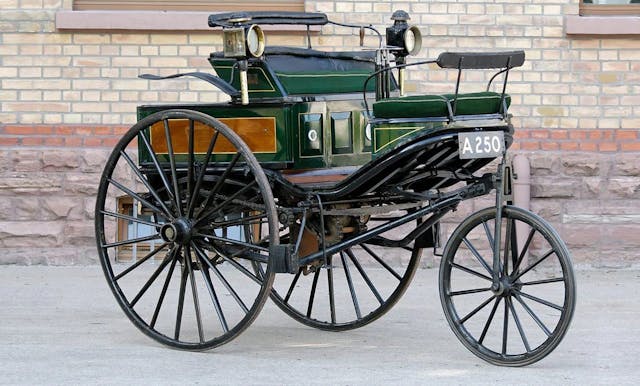
The post On This Day in 1886: The drawings that showed us the world’s first car appeared first on Hagerty Media.
]]>
January 1901 was the month that brought the United States of America into the oil age. On the tenth day of the month, an exploratory well struck a major oil well for the first time and created a Texas oil boom.
Its discovery was what you might call an educated guess rather than pure luck. A businessman by the name of Pattillo Higgins began drilling in the area for a source of natural gas to power his brickyard. While that venture was unsuccessful, he later teamed up with Captain Anthony Lucas, an oil explorer, and the pair sought various locations, with additional funding from investors John Galey, James Guffey, and Andrew Mellon.
It was Galey who selected a location just outside of Beaumont, Texas, and in October of 1900, the group commenced drilling activities. Progress slowed when the drill hit a quicksand formation that had held up earlier efforts in the area, but, once through, the drill eventually hit a limestone vein—and, that December, the first evidence of oil.
On January 10, during replacement of the drill bit, the now 1138-foot hole began to vent mud and gas, finally exploding with a geyser of oil shooting more than 150 feet high. An estimated 100,000 barrels (4.2 million gallons) per day blew from the hole for nine days before the “gusher” was brought under control.

The group’s suspicions about the area had proven correct, and by that June the Spindletop oil field—named for the spindle-like appearance of the trees on the nearby Sour Spring Mound hill—was home to 13 gushers.
By the following year, more than 285 wells were in operation. According to the Texas State Historical Association, local landowners did rather well out of the deal; one man, who had struggled to sell a tract of land for $150 for years, made $20,000 almost immediately (equivalent to more than half a million dollars today), and that buyer then sold the same land for $50,000.
From a peak of 17.5 million barrels of oil in 1902, the output at Spindletop declined rapidly. There was a second boom in 1925 when more was discovered—in 1927, the land yielded 21 million barrels—and the area continues to yield oil today, albeit nothing to touch that 1920s peak.
But Spindletop’s significance lay in creating the U.S.A.’s first oil rush and, by extension, aiding its growth into the world’s most powerful nation. Today we’re all too aware that oil is finite, and that it has impacts greater than those at individual drilling sites, but on January 10, 1901, the future really must have looked exciting.
The post This Week in 1901: America’s oil rush begins appeared first on Hagerty Media.
]]>
The scale of the 2021 Goodwood Revival was more impressive than ever and equally meant even more tired legs at the end of a great day out. Those that made it over to the grass airfield, which intersects the circuit diagonally between Madgwick and Lavant corners, would have found space to stretch out for a picnic and rest those weary feet, amongst the fabulous backdrop of the Freddie March Spirit of Aviation.
This concours d’elegance was for winged wonders built before 1966 and celebrates Freddie March, who went on to become the ninth Duke of Richmond and Gordon, and the role Goodwood played during World War II.
The origins of the Goodwood track lie in its role as a military airfield. RAF Westhampnett, named after the village bordering Goodwood, served as a Battle of Britain base during World War II and was the station from which RAF legend Sir Douglas Bader flew his last sortie. According to Goodwood, RAF Westhampnett was created on land that was donated by the 9th Duke in order to assist with the war effort.

After the war, the celebrated amateur racer Freddie March was approached by his friend, Squadron Leader Tony Gaze, who suggested using the perimeter road that bordered the Aerodrome as a motor racing circuit. The Duke and Duchess of Richmond and Gordon officially opened the track in 1948 by driving around the Circuit in a Bristol 400, then Britain’s state-of-the-art sporting saloon.
So the Freddie March Spirit of Aviation, presented by Bonhams, is a tribute to Goodwood’s place in history, when aero engines rather than motor car engines would be heard roaring around this part of West Sussex. Here are the highlights from 2021’s aircraft concours, complete with 14 aircraft descriptions provided for the concours.
1930 De Havilland DH 80 Puss Moth

By the end of the 1920s, De Havilland was working on creating a plane that could satisfy demand for a private aircraft that could provide a degree of comfort and utility. The DH 80 Puss Moth was the answer, emerging into the light in September, 1929. By fitting it with an inverted Gipsy 2 engine, pilots were afforded a better view over the nose. This example is one of fewer than 260 built, and competed in the 1930 King’s Cup Air Race, before being shipped to Sweden in ’36.
1939 Beech D17S Staggerwing


Beech aircraft was established by Walter Beech in 1932 and was based in Wichita, Kansas. The D17 Staggerwing was introduced in 1932 and a total of approximately 800 were built, with 20 built under license in Japan. The backward stagger of the biplane wing layout, with the upper wing placed aft of the lower, is designed to give the aircraft a good combination of speed and stability. The Beech Staggerwing on display at the 2021 Goodwood Revival was built in 1939 for evaluation by the U.S. Army Air Corps. Sent to the U.K. for the U.S. Air Attache, it was transferred to the RAF as a Traveller Mk I. The aircraft was returned to the U.S.A. in 1947 and purchased in the U.K. in 1950, before being sent to Rhodesia. Subsequently it has had several owners in the U.S. before being obtained and operated by Southern Cross Aviation.
1940 Miles M14A Magister
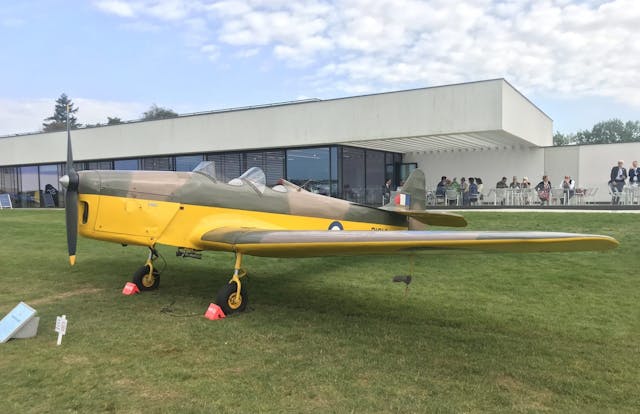

Formed in 1930 as Phillips and Powis Aircraft Ltd, the company later changed its name to The Miles Aircraft Company. The M14 Magister—nicknamed “Maggie”, first flown in 1937—is a two-seater trainer based on the Miles Hawk trainer. Around 1200 were made and mainly used by the RAF as a basic trainer for fighter pilots. The aircraft on display was built in 1940 and allocated RAF registration R1914.
1941 De Havilland 82A Tiger Moth

The DH82 was an evolution of the De Havilland 60 and 60T Moth aircraft, and was first flown in 1931. The RAF took deliveries of the Tiger Moth from late 1931, and this example was built in 1941 and delivered to the Royal Air Force before reaching the civilian market in 1953. A restoration in 2008 saw it adopt RAF camouflage colors as well as its original registration.
1941 Westland Lysander


In 1935, Westland Aviation was spun out of Westland Aircraft works. The Lysander was designed to meet Air Ministry Specification A29/34, and after being awarded a contract the first prototype flew in 1938. Lysander aircraft performed in many clandestine operations during WWII, flying agents in and out of occupied France. This Lysander was issued to 225 Army Co-operation Squadron in April, 1941, before being transferred to Canada in 1942 for use as a training craft until 1946, when it was sold to a local farmer in Saskatchewan.
1942 Boeing Stearman


Looking fabulous in its rich blue and contrasting mustard colors, with Lady Faye on the fuselage, this Boeing Stearman is representative of the standard biplane trainer that was used by the U.S. Army and Navy in the 1930s and ’40s. Many were subsequently purchased for crop dusting or pleasure flying. This one now resides in the U.K.
1944 Beech D17-S Staggerwing

The D175 Staggerwing was introduced in 1932 with either a 225-hp Jacobs L-4 or a 450-hp Pratt & Whitney 985 Wasp Junior radial engine driving an 8-ft 3-in diameter Hamilton Standard controllable pitch propeller. The Staggerwing has five seats and a biplane wing layout that has a backward stagger where the upper wing is placed aft of the lower, this configuration offering a good combination of speed and stability. The Beech Staggerwing on display at the 2021 Goodwood Revival was built at the Wichita factory in 1944. Delivered to the U.S. Navy, the aircraft was shipped to the U.K. under the Lease-Lend Scheme where it became a Royal Navy Traveller Mk1 FT466. Returned to the U.S. in 1946, the Staggerwing has had many owners and been restored several times, most recently in New Zealand. It was provided by Bill Charney.
1944 Lockhead P38 Lightning

The Lockheed P38 Lightning was developed for USAAF specification X-608, issued in 1937. The Lockheed design team took bold steps, using two engines for speed, range and climb, and chose the centre pod twin boom design in order to house four .50 inch machine guns and a 20-mm cannon in the nose. This particular Lightning has been flown in air races, by Marvin Gardner, before being acquired by Red Bull and undergoing restoration in Texas.
1945 North American P51D-30-NX Mustang
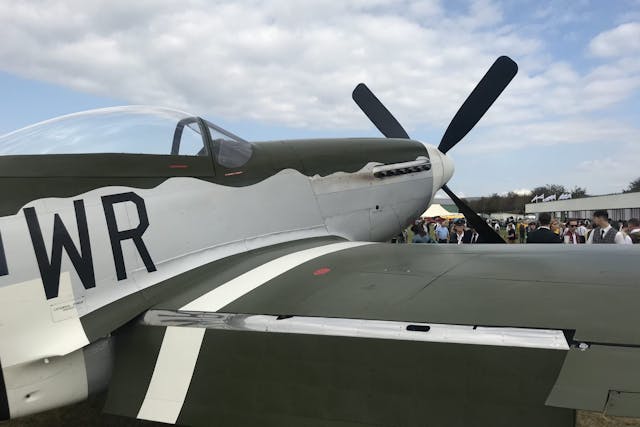

The prototype P51 first flew in October 1940, powered by an Allison engine that gave the aircraft limited high altitude performance. The Allison was replaced with a Merlin by Rolls-Royce that gave the aircraft far superior performance. The definitive version became the North American P51D. This example was built in May, 1945 and delivered to the USAF. After time with USAF and National Guard unit, it was sold to the Guatemalan Air Force in 1958, before finding its way onto the US civil market in 1972. It ended up in the U.K. from 2018, and has been painted to represent the Hun Hunter flown by Captain Brown of Dallas, Texas.
1945 North American B25J Mitchell

The B25 first flew in 1940 and was built in several configurations, with offensive and defensive armament. Intended for short range daylight bombing missions, its transparent nose was often replaced with heavy armament for ground strafing. The Mitchell could carry an internal bomb load of 3000 lb (1360 kg) plus additional bombs on racks beneath the wings. Each of its Wright twin Cyclone engines mustered 170 hp, giving the aircraft a maximum flying speed of 300 mph.
1945 Chance Vought F4U Corsair

Designed as a fighter aircraft, the prototype F4U Corsair first flew in August, 1940. It was the first aircraft with a hydraulically powered mechanism to fold the wings. After development, the Royal Navy perfected a technique that made it safe to land on a carrier, which led to the aircraft seeing extensive use in the Pacific during WWII. Although supplied new to the U.S. Navy, this particular Corsair was too late for service in the war, and later landed in Honduras, before being purchased by Sigi Angerer. It now boasts modern touches such as navigation equipment and a second seat.
1946 Aeronca Chief


The Aeronca Aircraft Corporation was founded in Cincinnati, Ohio, in 1928, but later moved to Middleton, Ohio. The Aeronca Type II Chief entered production in early 1946, and production ended in 1950, a year before Aeronca ended production of light aircraft. The Chief is constructed with with a fabric-covered steel and wooden frame and features side-by-side seating. After being purchased by its current, U.K.-based owner, in 2017, it was restored to its original condition—no mean feat given the parts are difficult to source.
1947 Miles M38 Messenger 2A

The Miles Messenger was designed to meet a British Army requirement for an Air Observation and Liaison aircraft. The prototype was converted from a Mile M28 Mercury and first flew at Woodley in September, 1942. Powered by a de Havilland Gipsy Major ID engine, the Messenger was typical of Miles construction having a wooden airframe with a mixture of plywood and fabric covering.
1956 Piper Pacer

The Piper Aircraft Corporation’s Pacer was one of the last of the fabric covered, steel framed fuselage with an aluminium frame wing to be based on the Cub design. The aircraft displayed was built in 1956 as a PA22 Piper Caribbean with a tricycle undercarriage. It has since been retro-fitted with a tail-wheel undercarriage, resembling the pre-1954 PA20 Piper Pacer.
The post 14 reasons to keep your head in the clouds at Goodwood Revival appeared first on Hagerty Media.
]]>
Since the dawn of the automobile, automakers have sought to make driving easier and more approachable. Oftentimes that has meant engineering ways around our beloved clutch pedal and gear lever. Early motorized vehicles were a jumble of confusing sliders, levers, buttons, and dials that would confuse any modern driver. The quest to simplify these controls took several twists and turns, achieving varying degrees of success.
The first commercial version of what we would today recognize as a true automatic transmission didn’t appear on the market until 1939, when Oldsmobile debuted the fluid-driven Hydra-Matic. In doing so, General Motors made driving much more accessible to legions of newcomers. Both before, during, and after that period, however, car companies continued to chase down the quixotic dream of shifting a manual gearbox without having to use the clutch.
These sometimes roundabout solutions were born from various origins. Some designs devised a path around the pre-torque-converter reality of daily driving, while others attempted to further sharpen the sports car experience without taking any control away from the driver. Then, naturally, came efforts that were simply a boon to anyone too lazy to engage their left foot while out and about.
Pre-select for driving pleasure

Manual transmissions got infinitely easier to use following the invention of synchronizers, or synchros, which operate much like an internal clutch to match the speed of the input and output shaft of a transmission and perfectly align gear teeth before they are selected. This obviates the tedious double-clutch footwork required to put the transmission in neutral in between moving from one ratio to the next in a fully-meshed gearbox, while also cutting down on gear grind.
Before synchromesh became commonplace, transmission designers tried all manner of methods to avoid putting drivers through the footwell two-step. Of these, one of the most fascinating and successful was the preselector, which appeared first in the 1930s and lasted well into the 1960s (with military vehicles being the last to eschew them). A preselector system allows a driver to choose which gear they think they will need far in advance of it actually being grabbed by the transmission itself. The gear was usually preselected using a button or lever mounted on the dashboard, with the gear change itself only occurring once the driver pushed a floor-mounted pedal.

How did this innovation work, exactly? Although there were various preselector designs in use, the most common models used permanently meshed epicyclic gears that relied on an internal braking system to distribute torque from one forward ratio to the next. The popular Wilson model, for example, strung together each successive gear to modulate the amount of reduction they provided, with the top gear (usually fourth) locking all previous cogs together and operating as a single continuous unit at a 1:1 ratio. The kick pedal on the floor was used to lower a bus bar that engaged the gear.

Although there were similarities between later automatic and early preselector transmissions, the latter was still firmly manual in terms of its operation. Drivers had to choose their next gear each and every time and could even select a gear and never use it by simply not engaging the change pedal. There was no need row gears sequentially; all gears were available at all times, which meant one had to be cognizant of the lack of reverse-gear lockout.

Not all examples of the preselector, however, did entirely without a clutch pedal. While some cars, such as those built by Daimler or BAS, used a fluid-type flywheel to handle engine output with the handbrake or footbrake holding the car at a stop, other cars relied on a centrifugal clutch (similar to what’s found on a riding lawnmower) or even a manual clutch that added yet another pedal to the floor. Race cars, which quickly adopted preselector technology, used no clutch at all, as an abrupt start made no difference to open-wheel drivers who appreciated the ability to choose their next post-corner gear from the relative serenity of the preceding straightaway.
Almost automatic, except where it counted
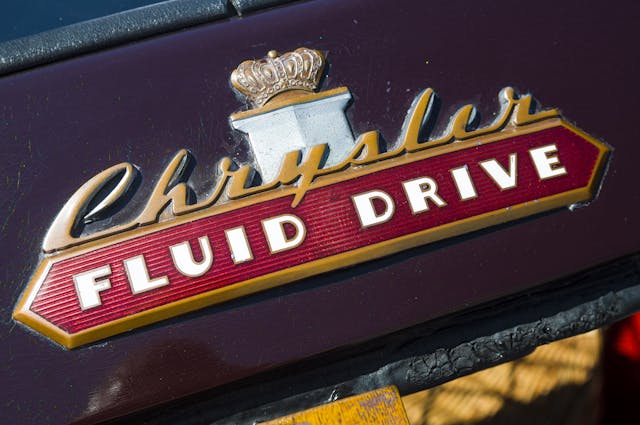
Chrysler took a swing at a clutchless manual gearbox starting in the late 1930s, with production continuing well into the ’50s. Labeled “Fluid Drive,” or “HyDrive,” depending on which sub-brand in which it was installed, the system employed a conventional three-speed manual gearbox but swapped out the flywheel for a fluid coupling similar to that of a modern torque converter, only without torque-multiplication capability.

This precursor to the modern automatic still required a clutch pedal to move from one gear to the next, but outside of that it was seldom, if ever needed. It was possible to hold a Fluid Drive car stationary while in gear without using the clutch at all, and hill starts could be accomplished by simply transitioning from the brake to the accelerator. Chrysler recommended leaving the car in second gear at lower speeds, but it could pull away from a stop in any of its three gears thanks to the fluid coupling’s power transfer.

An even less involved version of the transmission, the M6 Presto-Matic, was also available from Chrysler. While it required the use of a clutch to initially select offering the choice between High and Low settings, once away in normal driving the clutch never again entered the picture. The transmission was then capable of shifting itself in and out of two gear sets within the scope of the original selection (High/High Overdrive, Low/Low Overdrive), after lifting the throttle at speeds roughly above 15 mph (upshift) or below 11 mph (downshift), with slight variations depending on whether you started out in Low or High.
If that sounds clunky, you’re not wrong. Sometimes called Gyro-Matic, or Tip-Toe Shift, the setup was far from a true automatic in terms of smoothness or power delivery, and it didn’t deliver the same degree of control as a traditional manual. Still, it was reliable, and it served Mopar fans from 1946–53 before true autoboxes became commonplace.
Sensonic, but not sensible

Our final entry into the clutch-free manual pantheon hails from Sweden. In the early 1990s, Saab decided that there existed a customer who was engaged enough to want a manual transmission in their car, but not quite willing to go through the effort of actually using a clutch pedal to make the magic happen. Enter “Sensonic,” perhaps the most unusual attempt in modern memory to remove a clutch from the manual-transmission equation.
What’s important to understand about Sensonic is that it had nothing in common with existing sequential manuals or the automated single and dual-clutch transmissions that followed. It was, for all intents and purposes, a traditional manual gearbox just like any other five-speed you could buy in the Swedish brand’s portfolio. The only difference was that instead of relying on the driver’s left foot, Sensonic activated the clutch completely electronically, with no intervention from the pilot whatsoever.
Designed by automotive supplier Fichtel & Sachs (later absorbed by what is today ZF), the system composed sensors that detected the movement of the shift lever as well as the amount of pressure being applied to the accelerator. It was programmed to electronically activate the clutch within very specific parameters, based on the motion of the shifter. Flooring the gas locked out gear selection, but if you backed off the go-pedal the vehicle’s clutch electronically activated to facilitate the change.
Sensonic was inexpensive for Saab to implement but weird to use in practice and not exactly reliable over an extended period of time. Available exclusively in turbocharged versions of the 900, very few buyers ticked the Sensonic box between 1993 and 1998. In hindsight that’s not surprising; who exactly was the target market for a laissez-fair manual that wouldn’t simply prefer a full-service automatic? Fichtel & Sachs partnered with a few boutique automakers, such as RUF, while developing the technology, but outside of a handful of sports cars it was an outlier.
Tech takes over

Today, the dual-clutch automated manual is the dominant player in the alternative automatic-transmission game, as demonstrated most successfully by Volkswagen Group in everything from the Porsche 911’s PDK to the GTI’s DSG. Such gearboxes are capable of lightning-quick shifts and are designed for less power slip than with a torque converter, thereby increasing fuel efficiency.
The dual-clutch is an elegant solution to what was once, many years ago, a pressing problem for marketers seeking to get everyday folks off the sidewalk and into the driver’s seat. The complex machinery and engineering advancements that go into each of these gearboxes would have been unimaginable a century ago. If anything, the path from pre-select to dual-clutch demonstrates all of the wild avenues that needed to be explored in the search for a better-shifting transmission.
With all that said, modern traditional torque-converter automatics are more efficient, more refined, and more reliable than ever before. Even in high-performance applications, traditional automatics with eight and ten speeds are becoming more and more prevalent. Anyone who’s driven the quick-shifting 10-speed from the Camaro ZL1 and Shelby GT500 would be hard-pressed to find any slush in that so-called slushbox.






The post A brief history of missing clutch pedals and almost-automatics appeared first on Hagerty Media.
]]>
When Bob Lutz drove his Pontiac Solstice concept sports car onto the stage at the 2002 Detroit North American Auto Show, there was a clearly audible gasp from the astonished media scrum. Then came a round of applause, soon after topped by another bout of cheers for the sexy Solstice concept coupe that followed. “The North American market is ripe for an affordable, pure roadster,” Lutz proclaimed. “The Solstice is striking in its purity and simplicity.”
It took nearly four years to wrangle corporate approval, source, develop, certify, and validate that enticing little roadster for production. The Solstice’s realization fulfilled a dream that Lutz had nourished throughout his career, but the timing proved unfortunate. When Pontiac’s second-ever two-seater (following the 1984–’88 mid-engine Fiero) launched in 2005 as a 2006 model, GM was three years away from declaring bankruptcy amid a U.S. economic collapse.
Less than a year prior to the 2002 Detroit auto show, GM CEO Rick Wagoner had met with Lutz at Exide Technologies, where the latter was CEO after departing Chrysler. Wagoner offered Lutz a lucrative consultancy to help fix GM’s lackluster products. Lutz declined, but Wagoner countered with a full-time job opportunity. Lutz agreed, albeit on the condition that he would have the title and the power necessary to get the job done. On September 1, 2001 (with Lutz four years past GM’s mandatory retirement age of 65), the veteran executive joined the auto giant’s board as Vice Chairman, Product Development.

Wagoner directed Design VP Wayne Cherry to show Lutz every future GM product, even before his official start date. When the two met that August at the Pebble Beach Concours, Lutz zeroed in on the inexpensive two-seater that he had long wanted to create—first at GM Europe, then at BMW, Ford, and finally Chrysler. He strongly believed that an inexpensive Mazda Miata-fighter, done right, would bolster GM’s product image and could turn a profit.
“Bob wanted to know if we could do a concept roadster in time for the Detroit show,” Cherry said in an interview for your author’s 2006 Pontiac Solstice Book. “The show was barely four months away. But any time someone asks us to do a concept sports car … we’ll say YES … We were so excited to be able to do that kind of a car.”
Fast-tracked design
Cherry launched a competition among GM designers for the roadster concept. Ed Welburn—who bore primary responsibility for concepts at the time—showed the best sketches to Lutz on a big screen, and one of a series by Franz von Holzhausen from GM’s California studio jumped out.
“That’s it!” Lutz exclaimed. “Exactly the character we’re talking about! They showed how we could do a contemporary vehicle based on quintessential sports car shapes of the 1950s and ‘60s … those voluptuous, flowing-fendered, Italianesque sports cars—Ferraris, Maseratis, Aston Martins—of that period … classical style done in a very contemporary way.”

GM’s Ecotec four-cylinder was designed and developed by an international team to be compact, lightweight, low-maintenance, and capable of accommodating such added technologies as turbocharging, supercharging, piston oil cooling, dual cam phasing, and direct fuel injection. Rotating it 90 degrees to power the rear-wheel-drive roadster required new mounts and minor modifications for improved dipstick access. Meanwhile, its head got better breathing, its crankshaft got an adapter and reinforcement at its transmission interface, and its power steering pump became engine-driven (vs. electric in other applications). Redline rose to 7000 rpm. One thing that did not change was the engine’s 10-degree tilt—rearward in front-wheel-drive cars, to the passenger side in the Solstice—since its lubrication system was designed for that angle.

The Solstice GXP’s turbo-four pumped out 260 ponies and an identically impressive 260 lb-ft of torque from just 2.0-liters of displacement—a remarkable 130 hp per liter. The 2007 GXP could sprint from zero to 60 mph in less than 5.5 seconds vs. the standard 177-hp 2.4-liter car’s respectable 7.0 seconds, and its cornering and braking capabilities were similarly higher.
The Saturn Sky
The year after the Solstice concepts stole the Detroit show, GM British subsidiary Vauxhall showed a hot-looking concept roadster called VX Lightning to help celebrate its 100th birthday. Built on the bones of the original Solstice concept, it debuted in May 2003, just as the Solstice production program was coming together. The VX Lightning provided styling inspiration for the Saturn Sky, as well as a near-identical Opel GT roadster for Opel in Germany and a Daewoo G2X for Korea.
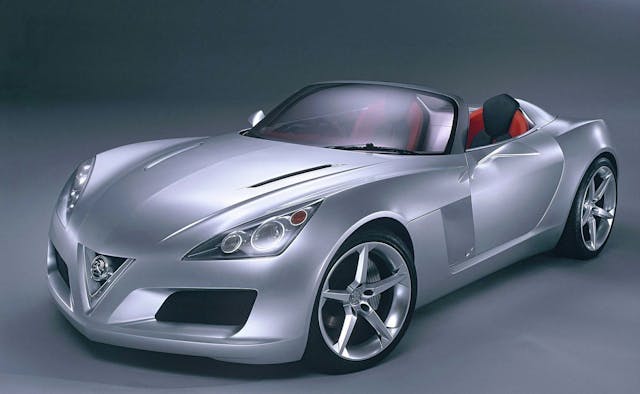

“When the decision arrived to make a Saturn roadster,” Welburn said, “it came … when we were looking at building this relationship between Saturn and Opel. Simon Cox’s VX Lightning design was very aggressive, inside and out, and we handed Ken Parkinson the challenge of taking this wild-looking roadster and creating a production Saturn from it. Liz Wetzel was director of small- and mid-sized car interiors, so her team did the cockpit. But it wasn’t until after the Sky production design was coming together that the decision was made to also market this roadster in Europe as the Opel GT.”
And in Korea as the Daewoo G2X. The exterior design landed in the hands of Clay Dean when Parkinson moved to a new assignment, and Solstice designers Franz von Holzhausen and Vicki Vlachakis helped finish the production Sky. (The two would later marry.)

Production
The Solstice reached production (with its body manually MIG-welded) at just seven cars per hour in mid-2005 at GM’s then-59-year-old Wilmington, Delaware plant, which had been slated for closure the previous year. Nominated for 2006 North American Car of the Year and Canadian Design of the Year awards, it got off to a strong start with 7000 orders in its first 10 days and 6000 more before winter. Media reviews were generally good, aside from criticism of its low-function interior and tiny trunk that offered little room when its oddly designed top was down. The other three Kappa cars (Saturn Sky, Opel GT, and Daewoo G2X) debuted as 2007 models.


The turbocharged Solstice GXP and Sky Red Line also arrived for 2007, then the Targa-top Solstice Coupe in early 2009. Just 1266 Coupes (102 pre-production 2009 models, 1152 production 2009s and 12 pre-production 2010s) were built before the plant closed in July 2009, after GM killed its Pontiac brand as part of a government-mandated bankruptcy recovery plan.
Thus ended Lutz’s career-long dream of a youthful, affordable two-seat sports car. GM’s short-lived Kappas were not, ultimately, great cars but they were stylish and fun at their prices. If you believe, as we do, that sports cars are mostly about style and dynamics, they were both genuine winners.


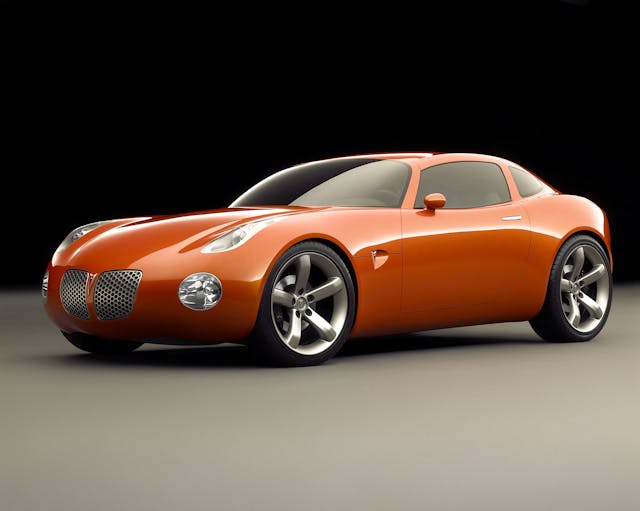




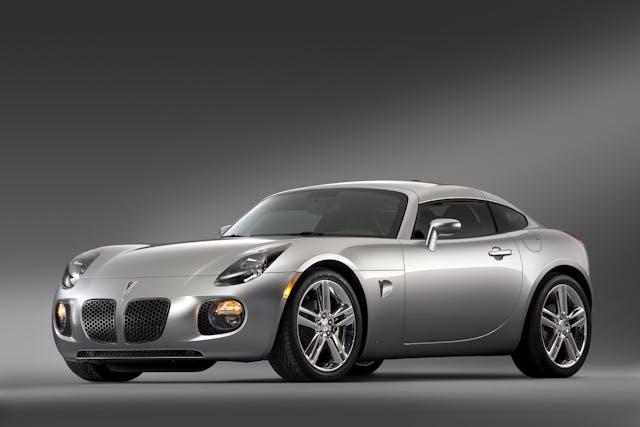







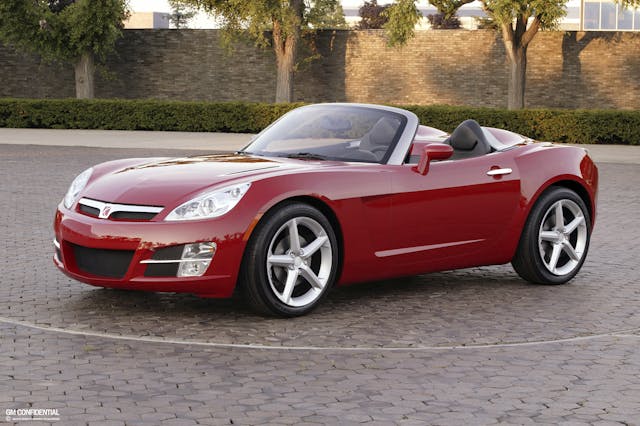





The post How Bob Lutz ushered in the Solstice and Sky, even as GM faltered appeared first on Hagerty Media.
]]>
As the Greatest Spectacle in Racing, the Indianapolis 500 has lived up to its name during its 111-year history and provided fans with some of the most amazing moments in all of racing. Herewith is one writer’s list; they are not listed in any order, whether from good to best or chronologically. These are one fan’s subjectively memorable moments. What are yours? Let us know in the comments section below.
The 1911 500-mile race

The first 500-mile race was not actually called the Indianapolis 500; it was known as the International Sweepstakes. The race was held on May 30, 1911, with 40 cars on the grid and 56 participating drivers (back then, it was legal for a team to change the driver of a car); a crowd estimated as high as 85,000 was in attendance. The race lasted six hours and 42 minutes and was won by Ray Harroun piloting a Marmon Wasp and averaging 74.602 mph. Not only was Harroun the winning driver, but he also had helped design the Wasp, since he worked in the engineering department of Marmon, an Indianapolis-based automaker. When other teams objected during practice that Harroun’s single-seat racer did not allow for the riding mechanic that cars of the era normally carried, Harroun installed a rearview mirror on the cowling of his car. It is commonly accepted as the very first rearview mirror ever used on an automobile.
The 1911 race saw another first, when one of the Speedway’s founders, Carl G. Fisher, led the field on an unscored lap in his Stoddard-Dayton (the era’s equivalent of a sports car). Fisher then released the field to the starter at a speed of approximately 40 mph. This is believed to be the first-ever example of a rolling start for any automobile race in the world, and likely the first use of a pace car at such a major event.
Louis Meyer drinks some (butter) milk

After Meyer won his third Indy 500 in 1936, he needed something refreshing to quench his thirst in Victory Lane. Buttermilk was Meyer’s preferred drink of choice, so he downed a celebratory bottle. After a photograph of the event appeared in newspapers, an executive at the Milk Foundation lobbied to make the practice become a tradition. It happened sporadically until 1956, when it became an official part of the post-race celebrations.
Emerson Fittipaldi won’t drink the milk

When Brazilian racer Emerson Fittipaldi won the 500 in 1993, he pulled his car into Victory Lane for his interview. When it came time to drink the celebratory milk, Fittipaldi refused. Instead, he drank orange juice, which he had provided himself (he was an orange-juice producer in his hometown of São Paulo) in order to promote the Brazilian citrus industry. Fittipaldi refused to even hold the bottle of milk and pushed it away at least three times. At the end of the interview and after the cameras were gone, Fittipaldi finally did sip from the bottle at the behest of his team owner, Roger Penske, but it was too late. The reaction by the media and fans was highly critical, leveling charges that Fittipaldi had snubbed the time-honored tradition for his own personal gain. The following week at the Milwaukee Mile, fans heckled and booed Fittipaldi during the driver introductions. It seemed to have worked: A few days after the race, he issued an apology and donated to charity the $5000 prize he had won from the American Dairy Association of Indiana for winning the 500.
George Bailey is the first to race a rear-engined car at Indy

Commissioned by the Gulf Oil Company and designed by the legendary Harry Miller, the Gulf-Miller Special was incredibly advanced—and expensive—for its time. Not only was it the first rear-engined car to take the grid at Indy, it also featured four-wheel drive, four-wheel disc brakes, side-mounted pontoon fuel tanks, and a supercharged six-cylinder Miller engine. Of the three cars that showed up at Indy in 1939, only the car piloted by former Hudson Motor Company test driver George Bailey qualified. Starting in sixth place, the car threw a valve on lap 18 and was out of the race.
George Bailey is the first driver of a rear-engined car to die at Indy
Sadly, the Gulf-Miller Special also went on to become the first rear-engined car to crash at Indy and kill its driver. George Bailey brought the car back in 1940, and during practice he either got up into the marbles or possibly the car’s crankshaft broke and locked up all four wheels, sending the car into a slide. As Bailey struggled to regain control, the car skidded sideways into a concrete wall. It spun back across the track, hit the inside guard rail and punctured the left-side exterior fuel tank, drenching Bailey with fuel. The car exploded and as it came to a stop, Bailey jumped out, on fire, and ran. He fell at least three times before Eddie Hoff, a Speedway photographer, caught up to Bailey and attempted to beat out the flames. Bailey died 45 minutes later.
The Lotus 38 is first rear-engined car to win at Indy
Having competed in 1963 with the Lotus 29 and in 1964 with the Lotus 34, the third time in 1965 would prove the charm for Colin Chapman, Jim Clark, and Team Lotus. An evolution of the cars that preceded it but now with a full aluminum monocoque, the Lotus 38 also featured a naturally aspirated DOHC 4.2-liter Ford V-8 fitted with a Hilborn fuel-injection setup good for around 500 horsepower. Clark qualified second with a four-lap average of 160.729 mph, becoming the first driver to officially top 160. A.J. Foyt, however, was right behind Clark and took the pole with an average of 161.233 mph in a slightly modified Lotus 34. Foyt also set a new one-lap record at Indy of 161.958 mph. But when the green flag dropped, the race was all Clark’s. The Flying Scot led all but 10 laps and won with only four cars on the lead lap; the rest of the field was at least two laps behind. The days of the front-engined dinosaurs were all but over; in fact, only four of the 1964 field’s 33 cars were front-engined roadsters. By 1967 there would be none.
Janet Guthrie becomes the first woman to race at the Indy 500
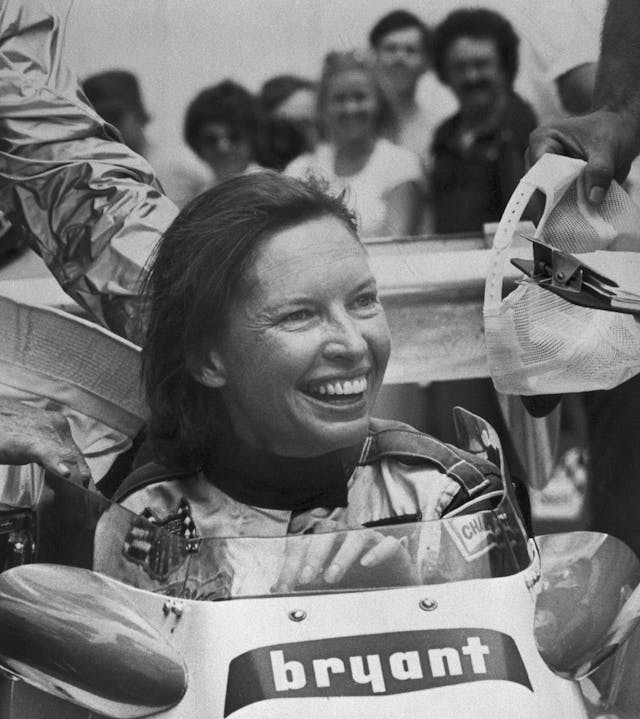
Before there was Lyn St. James or Sarah Fisher or Danica Patrick—and the many other women who followed—there was Janet Guthrie. After graduating with a degree in aerospace engineering from the University of Michigan, Janet Guthrie began racing in 1963 on the SCCA circuit campaigning a Jaguar XK140. By 1972, she was racing full time; her sports-car career included two class wins in the 12 Hours of Sebring. Competing in the 1976 World 600 (the predecessor to the Coca-Cola 600 at Charlotte Motor Speedway), Guthrie finished 15th and became the first woman to compete in a NASCAR Winston Cup superspeedway race. The following season, she became the first woman to compete in the Daytona 500, where she placed 12th overall and took the Rookie of the Year honor. She would go on to compete in 33 NASCAR races over four seasons. Indy called and Guthrie answered in 1977, where she competed and finished 29th after going out with engine troubles. She would compete in two more Indy 500s, placing ninth in 1978 while driving with a broken wrist.
Al Unser, Jr., wins closest Indy 500 in history
The 1992 Indianapolis 500 was one of the coldest on record, with temperatures in the 40s. The polesitter, Roberto Guerrero, didn’t even make it to the green flag; he had crashed while zig-zagging to put heat in his tires. A similar fate would befall other racing royalty such as Mario Andretti, Rick Mears, and Emerson Fittipaldi. The cold temperatures weren’t slowing down Michael Andretti, however, who roared around the track with top speeds at greater than 229 mph. Then what some have called the “Andretti Curse” struck: After leading for 160 laps and enjoying a lead of 28 seconds with just 11 laps left, Andretti’s Lola-Ford rolled to a stop between Turns 3 and 4, and his day came to an end. With Andretti out, the stage was set for one of the most exciting finishes in Indy history.
Al Unser, Jr., found himself in first place despite having endured blown engines throughout the month of May. Right behind Little Al (Al Unser, Sr., or “Big Al,” was also in the race) was Scott Goodyear. Goodyear, despite having started 33rd, had managed to charge through the field, avoiding spinouts and crashes, to find himself hard on Little Al’s tail. Goodyear bobbed and weaved across the track, trying desperately to get past Unser. Unser, in turn, feinted and parried furiously, trying to break any draft Goodyear might find. The crowd roared its approval, rising to its feet to cheer on the epic battle they were witnessing. When Al Jr. took the checkered flag, his margin of victory was 0.043 second, making it the closest finish in the history of the Indianapolis 500. As Al Jr. managed to say in Victory Lane as tears welled in his eyes, “You just don’t know what Indy means.”
Dave MacDonald and Eddie Sachs killed in 1964 race

There have been dark days throughout Indy’s history, but perhaps none as dark as the crash at the beginning of the 1964 race. It started with rookie Dave MacDonald’s car, which was owned and designed by hot-rodding legend Mickey Thompson. The car had raced in 1963 but had been updated with streamlined bodywork for 1964. The changes only made the car difficult to drive. As MacDonald passed Johnny Rutherford and Eddie Sachs on the first lap, Rutherford could see that MacDonald’s car was handling poorly. Rutherford would later recall thinking, “He’s either gonna win this thing or crash.” On the second lap, MacDonald’s car spun as it exited Turn 4. The car slid across the track and hit the inside wall, setting off a massive fireball. MacDonald’s car then slid back up the track. Sachs aimed for an opening along the outside wall, but MacDonald’s burning car slid into his path. Sachs broadsided it, causing a second explosion that killed Sachs instantly. With seven cars out and two drivers dead, miraculously no one in the crowd was seriously injured. The race was red-flagged (another cruel first) for an hour and 40 minutes. A.J. Foyt would eventually win. There was tremendous outcry over the horrific events, with newspapers and TV stations calling to end the race. In response, the race’s governing body mandated cars to carry less fuel and eliminated the use of gasoline, switching first to less-volatile methanol, and then later ethanol in 2006. Gasoline would return in 2012 with the use of E85 and its formula of 85 percent ethanol and 15 percent gas. Another change was the introduction, in 1965, of the use of fuel cells that utilized technology from military helicopters.
Patrick Bedard is the first (and last) automotive journalist to race at Indy
Longtime Car and Driver columnist (and today, Hagerty contributor) Patrick Bedard became the first automotive journalist to take the grid at Indy. In 1983, he started in the sixth row and went out in a crash after 25 laps. He would return in 1984 with a March powered by a turbocharged Buick V-6—the first use of such a Buick powerplant at Indy. He qualified 19th at 201.915 mph, and his teammate, Scott Brayton, saw 203.367 mph, making this the first time that cars with passenger-car-derived engines had qualified at more than 200 mph. On lap 58 of the race, Bedard suffered a monstrous crash in Turn 4. The car spun to the inside of the north short chute, slammed into the inside wall, flipped, and then barrel-rolled through the grass. The car broke into two major pieces—the tub with the cockpit and the engine/transmission unit. The track was strewn with debris, requiring an extended caution to clean up the incident. Bedard suffered a broken jaw and a major concussion, and mercifully recalls nothing of the accident. Bedard understandably did not return to racing but continued on at Car and Driver until he retired in 2009.
An Andretti is on the pole again for the first time in 33 years

The family’s patriarch, Mario, started his first Indy 500 in 1965; he placed third, took Rookie of the Year honors, and went on to win the series championship. He repeated the honor in 1966 and found himself on the pole in 1967. In 1969, he qualified second behind Foyt, dominated the second half of the race, and took the checkered flag. It would be his first and only victory there, despite 29 more attempts. Son Michael was unsuccessful in his 16 attempts, although he has completed the most laps and led the most laps of any driver who has never won. His team, Andretti Autosport, however, has won six times at Indy. Mario’s other son, Jeff, has qualified for Indy three times. Mario’s nephew, John (son of Mario’s twin brother, Aldo), has 12 starts at Indy, placing as high as fifth. Grandson Marco has qualified 15 times and has taken the pole for this year’s 500, rescheduled for August 23. Seeing how Marco is 33 years old, it is the first time an Andretti has been on the pole since he was born. Will the Andretti Curse be lifted after all these years? Tune in Sunday to find out.
The post Memorable moments from the Indianapolis 500 appeared first on Hagerty Media.
]]>

Somewhere in a distant and parallel universe, the conveniences and amenities of the modern automobile don’t exist. Things like technology, safety, and connectivity simply don’t register with buyers; they’re only interested in the least amount of “thing” possible to allow them to execute their vehicular needs and goals. Most of them drive a Volkswagen Golf Country.

In the world that we live in, the Golf Country started life as the Volkswagen Montana concept, which debuted at the 1989 Geneva Motor Show. Actually, it was just an Mk II Golf with a lifted suspension and an all-wheel-drive system beneath it. VW wasn’t actually going to build it. At least, not until 1990, when dealers started calling about the hordes of people at their doors looking to buy this exact product.
Thus, one of the world’s first crossover SUVs was born, four years before segment stalwarts like the Toyota RAV4 broke cover.

What looks like every second car on the road today was, at the time, a slightly unconventional shape. Then, so was the manufacturing process: All-wheel-drive Golf Synchros were shipped pre-assembled to the Steyr-Daimler-Puch factory in Graz Austria—the same folks responsible for the original Mercedes-Benz G-Wagen. There, the Synchros were transformed into Golf Country models, using a total of 438 unique parts. Among the exclusive parts: a revised suspension to accommodate the 4.72-inch lift that the Golf received, front and rear bumper bars, a rear-mounted tire carrier, four more auxiliary lights, killer stickers, and a smattering of underbody armor—including some badass sleeves to protect each of the CV joints.



Left untouched, the drivetrain of the Synchro—a 1.8-liter, 97-horsepower engine would have had a tough time handling all that extra weight. Thankfully, VW had the foresight to lower the gearing in the five-speed manual to allow these lifted hatches to maintain their peppy driving demeanor. Predictably, the elevated center of gravity added some body-roll to the cornering behavior.


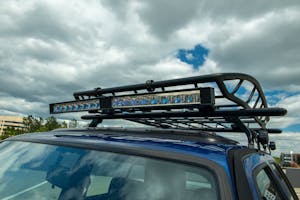

In that parallel universe, there would hundreds of thousands of Golf Country VWs out there; in ours, the number doesn’t even break five figures. From 1990–91, just 7735 vehicles were produced, making a Golf Country sighting a rare occurrence. Even so, Volkswagen also opted to make a few special editions.
The first, creatively dubbed the “Chrome,” swapped the black bumpers and wheels for—you guessed it—chrome ones and also received a nicer interior. Just 588 Golf Country Chrome editions saw the light of day, each commanding a heftier price tag over their normie (but not really that normal) black-bumpered siblings. The ultimate rarity within the Golf Country family was the Wolfsburg Edition. If the standard 1.8-liter engine just wasn’t cutting the mustard for you, the Wolfsburg Edition came with the 16-valve GTI engine beneath the hood.


While the Gold Country was technically legal for import into the U.S., very few made their way stateside. Accordingly, it’s rare to see one up for sale. However, one did sell earlier this year on Bring a Trailer—the 1991 example with aftermarket wheels netted $13,320, including dealer premium.
While Volkswagen has moved on to real, bonafide crossovers like the Atlas Cross Sport and the Tiguan, it’s always fun to imagine the parallel universe where those seeing an adventurous version of The People’s Car got to choose something like the Golf Country instead.
Would you drive a Golf Country? Let us know on the Hagerty Community.






The post The Volkswagen Golf Country was an all-terrain hatchback before crossovers ruled the roads appeared first on Hagerty Media.
]]>

Earlier this year I stopped by the Brumos Collection, before catching a flight from Orlando back to Britain. It houses one of the most impressive collections of landmark cars from Porsche’s motorsport history.
Set in a bespoke building that harks back to the former Ford plant in Jacksonville, there’s almost as much to admire about the architecture as there is about the cars housed within. That includes a boardwalk entrance which nods to the board tracks that were wooden wonders of the 1920s.
Knowing relatively little of the wooden ovals that gave rise to America’s oval racing scene, the information displayed about them was a small but significant distraction from all the Porsches on the other side of the museum, and enough to draw me away from 908s, 917s and a charming little 914/6 GT, one of the earliest cars that Brumos Racing campaigned.
So when the folks at On Yer Bike produced a film taking viewers through the history of board tracks, with a focus on the early bike racers, I found myself compelled to watch, and not just because of the title—”Welcome to the Murderdrome.”
As the title suggests, after drawing pioneering racers and huge crowds, the wooden ovals would go on to face a backlash from the media after a series of high-profile accidents that killed riders and spectators alike. The papers of the day labeled them Murderdromes. Even Alastair Campbell couldn’t spin his way out of that sort of bad press.
The practical limitations of the tracks are brought into focus in this film. They were built using Oregon Fir or Southern White Pine, depending on the location, and held together with 50 tons of steel nails. The wood would splinter or rot, meaning the ovals lasted a handful of years before major repairs were required—or the whole lot had to be abandoned.
So grab a cup of tea, put up your feet and take a moment to find out more about America’s lost wooden ovals.
Via Hagerty UK
The post Murderdromes: The sobering history of board track racing appeared first on Hagerty Media.
]]>
Don Schumacher’s team of NHRA drivers want you to know it’s Hemi Day.
Mopar and Dodge compiled a video of Don Schumacher Racing drivers Tommy Johnson Jr., Ron Caps, Leah Pruett, Matt Hagan, and “Fast Jack” Beckman to celebrate April 26 (4/26). Dodge has enthusiastically referred to as “Hemi Day.” Mr. Schumacher himself shows up at the end of the quick video to remind us that the whole Schumacher team is eagerly awaiting their return to racing.
Schumacher Racing’s drivers naturally love Hemis, it’s the engine that powers Top Fuel dragsters and Funny Cars to the fastest speeds of any vehicle in the quarter-mile and has earned Schumacher its share of Wally trophies.
We got to look inside at Top Fuel Hemi as part of our Redline Rebuild series.
Watch that video and you’ll see just what makes a Hemi V-8 special. Its hemispherical combustion chambers allow for its valves to be arranged in two lines, rather than the typical wedge cylinder head that places all the valves in a single line. That arrangement allows for larger valves and better cylinder head flow. An engine is nothing more than an air pump after all.

That race engine shares the basic layout of a production 426 Hemi, but features a billet aluminum block, billet heads with ginormous ports, and a monster supercharger. Of course, it also burns nitromethane. In truth, there’s not a lot in common with the ’60s street Hemi that powered some of the coolest and quickest Mopars of the muscle car era, but the DNA is still there.
Mopar’s Hemi heritage goes back to 1951 when the first Chrysler Hemi was installed in New Yorker, Saratoga, and Imperial models. The 331-cubic-inch V-8 packed a 180-hp wallop. That was quite a statement when lots of the American competition had OHV sixes and flathead-eights.
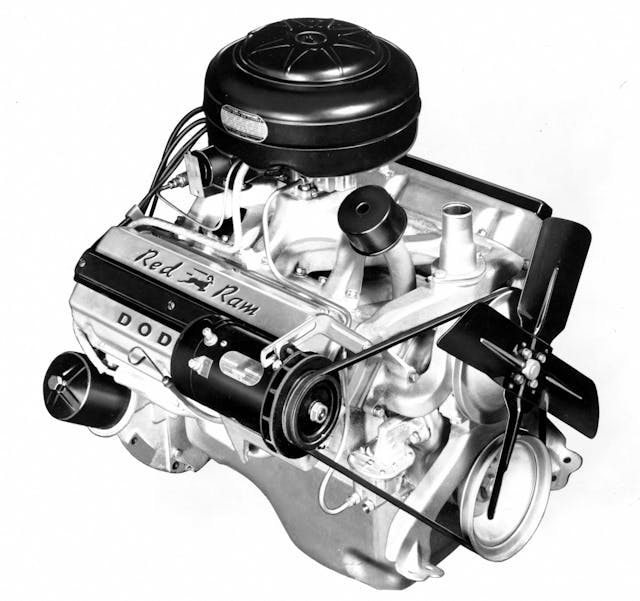
Dodge, DeSoto, and Chrysler all had their own version of the Gen I Hemi with different bore spacings. However, it was Chrysler’s, the largest of the three, that really associated the Hemi V-8 with drag racing. Chrysler’s 392 Hemi was the powerplant in drag racing until the big-block 426 took over the reins. It became such an icon that it is the de facto displacement that comes to mind when the word “hemi” is uttered. Mopar has embraced the 426 and its legacy by releasing a 1000-horsepower, 426-cu-in Gen III crate engine called the Hellephant.
If you’ve got a favorite Hemi, let us know. It’s 4/26, but we want to hear about all Hemis. It’s not like there’s a 3/54 or 3/92 on the calendar.



The post NHRA drag racers help celebrate Hemi day appeared first on Hagerty Media.
]]>